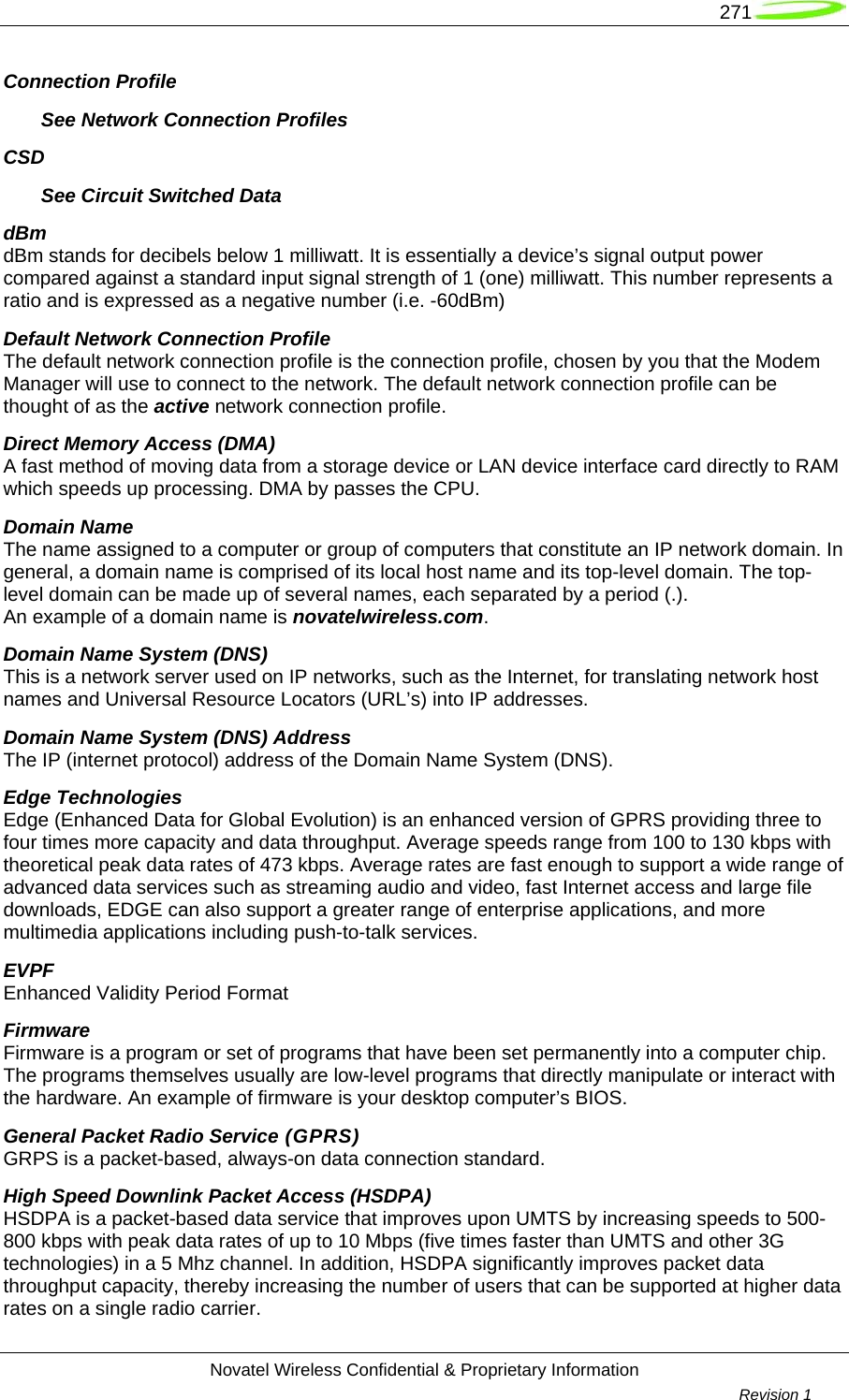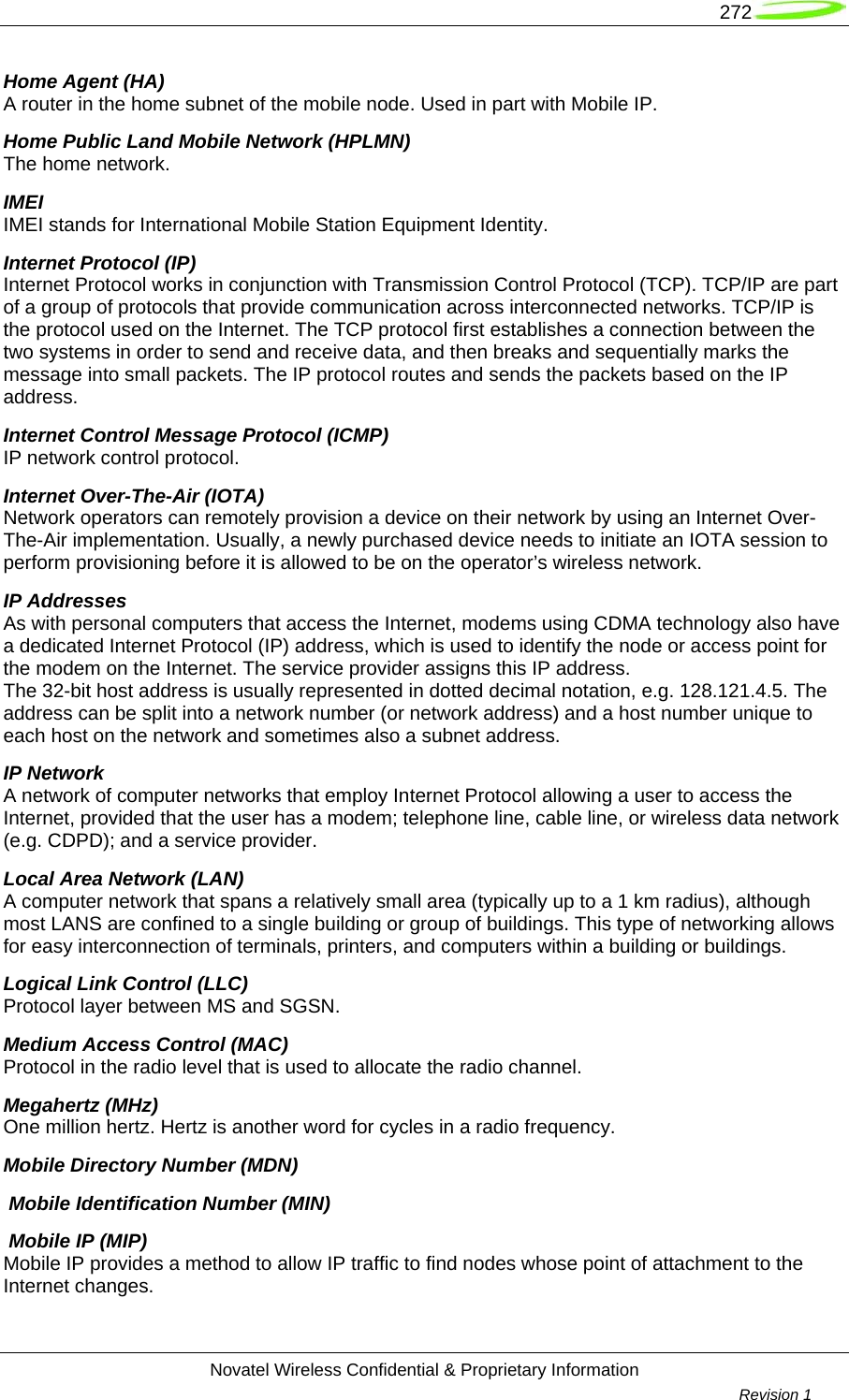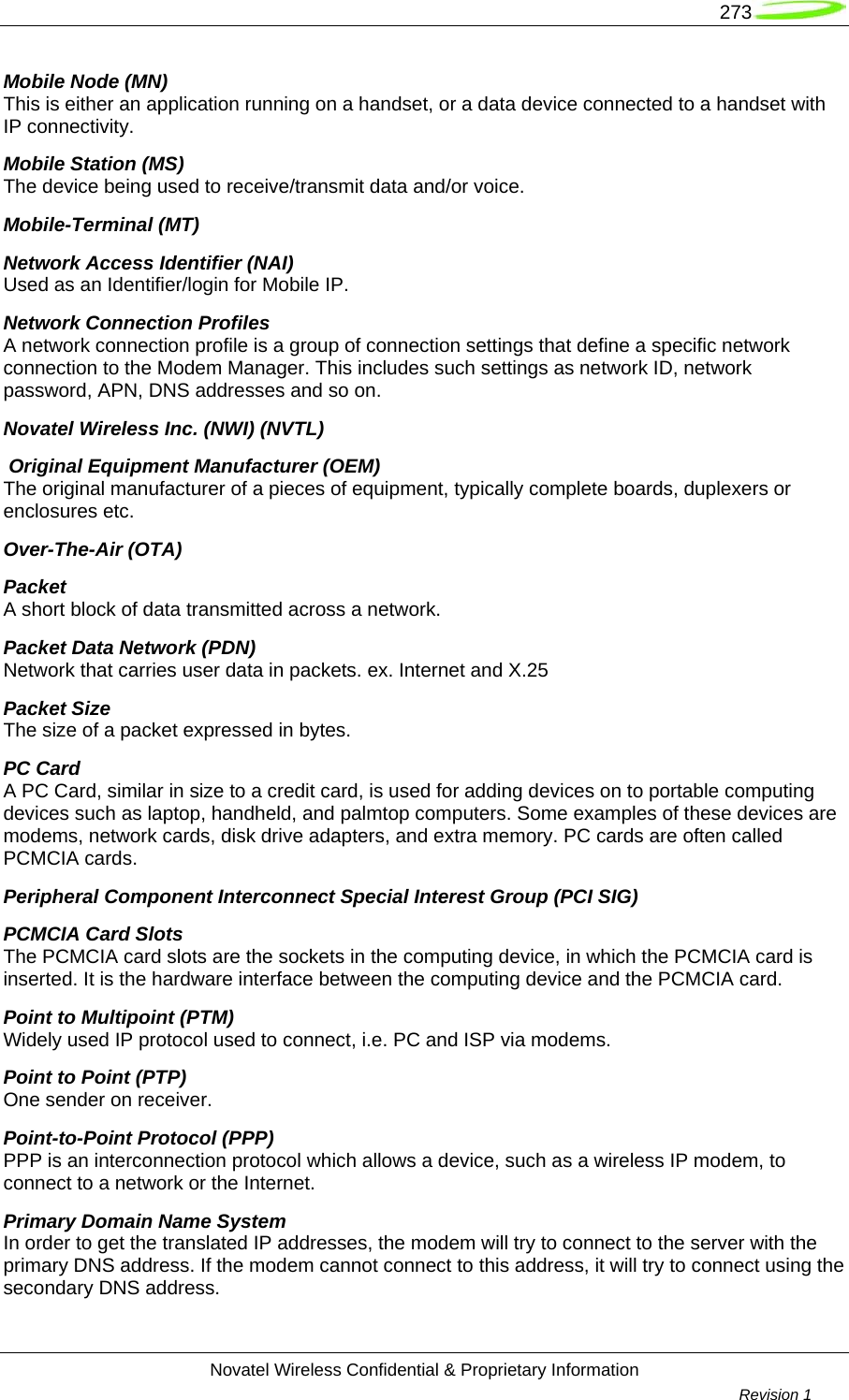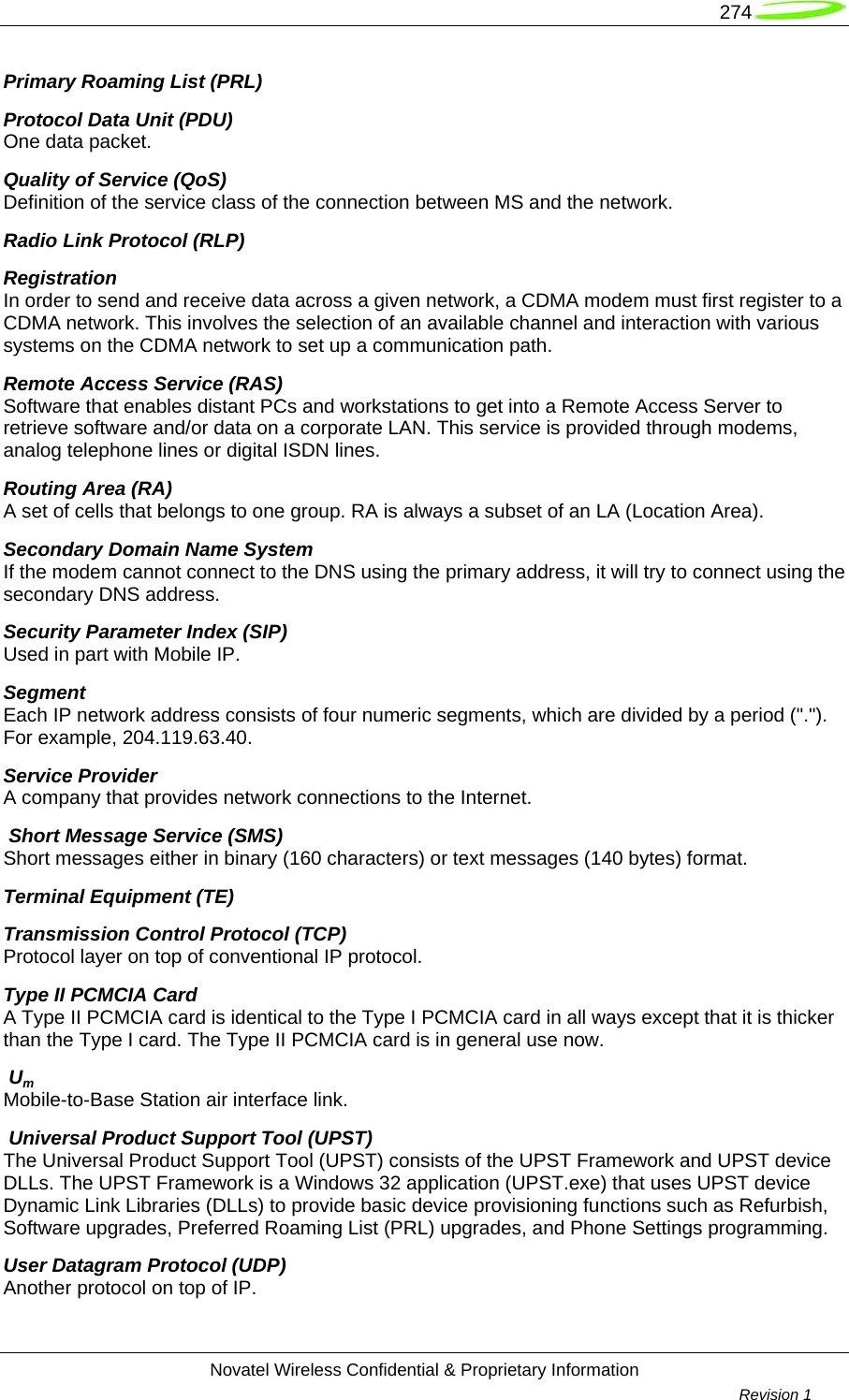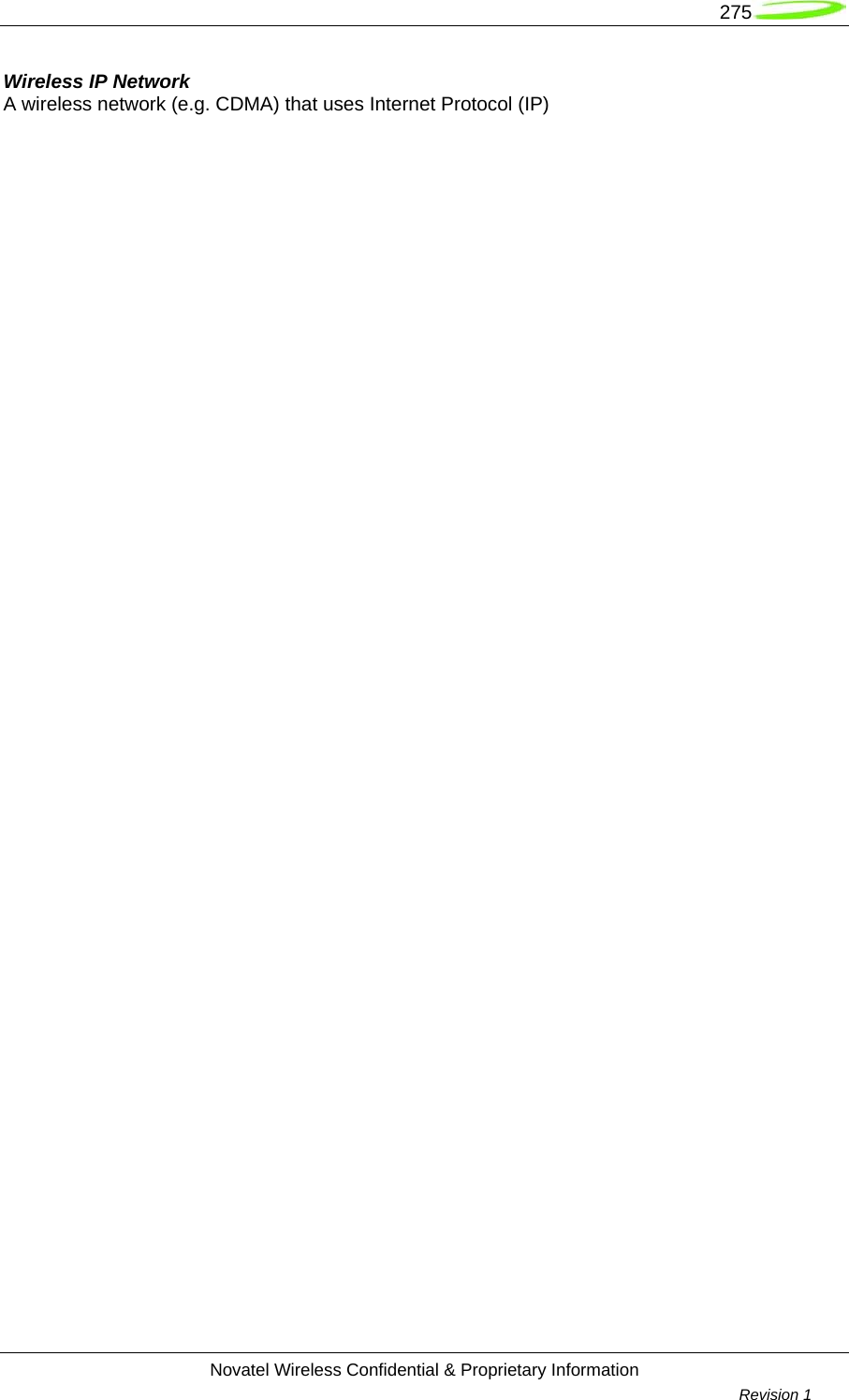Novatel Wireless NRM-EU860D Dual Band Licensed Modular Transmitter User Manual Part 2
Novatel Wireless, Inc. Dual Band Licensed Modular Transmitter Part 2
Contents
- 1. Part 1
- 2. Part 2
- 3. Manual 1
- 4. Manual 2
- 5. Manual 3
- 6. Manual 4
- 7. User Manual 1
- 8. User Manual 2
- 9. User Manual M1210
- 10. User Manual D430
- 11. User Manual D420
- 12. User Manual Corsica
- 13. User Manual Sapporo
- 14. User Manual Vostro 1
- 15. User Manual Vostro 2
- 16. Users Manual Vostro 3
- 17. Users Manual Vostro 4
- 18. User Manual 3
- 19. User Manual 4
- 20. User Manual Gilligan
Part 2
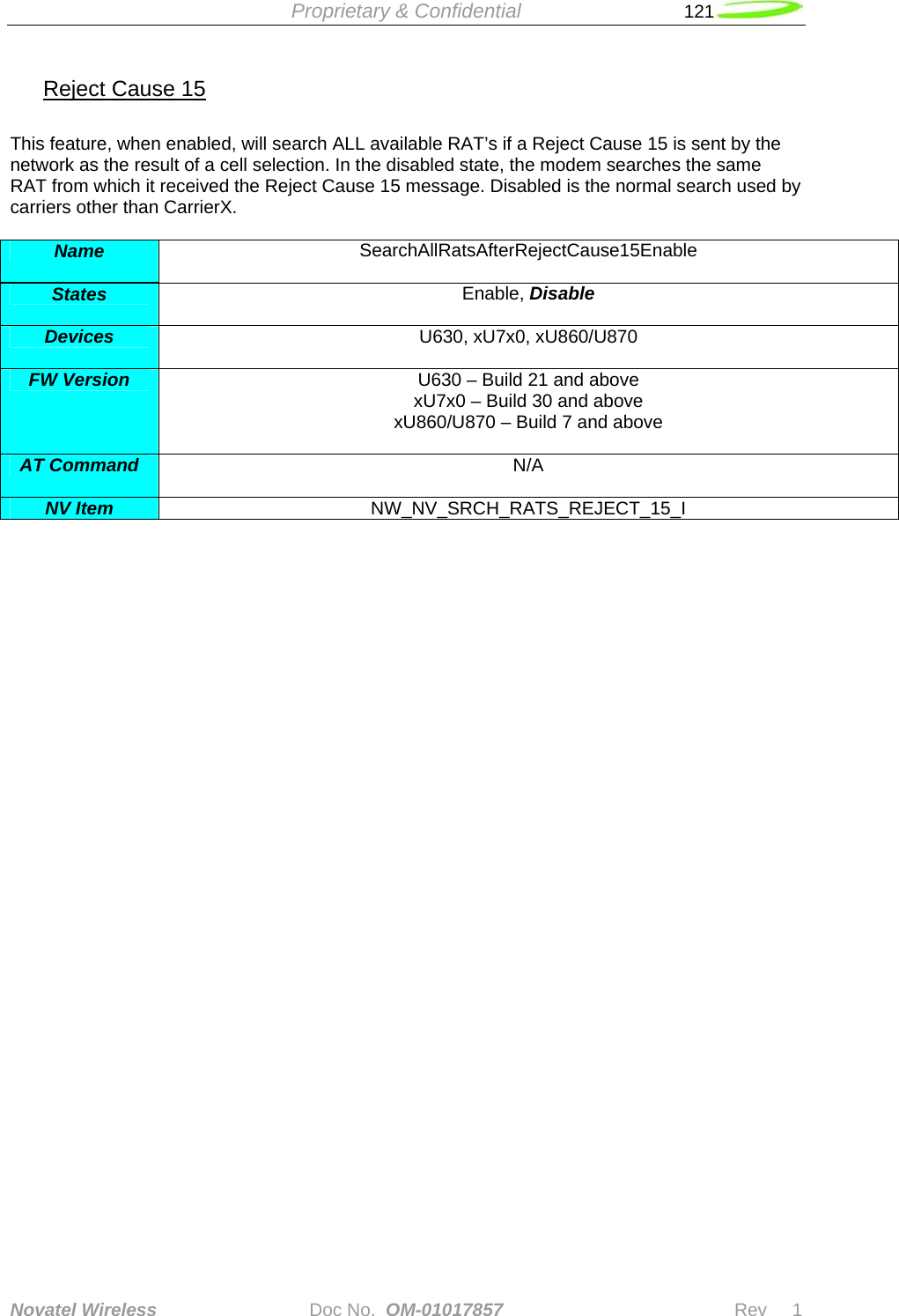
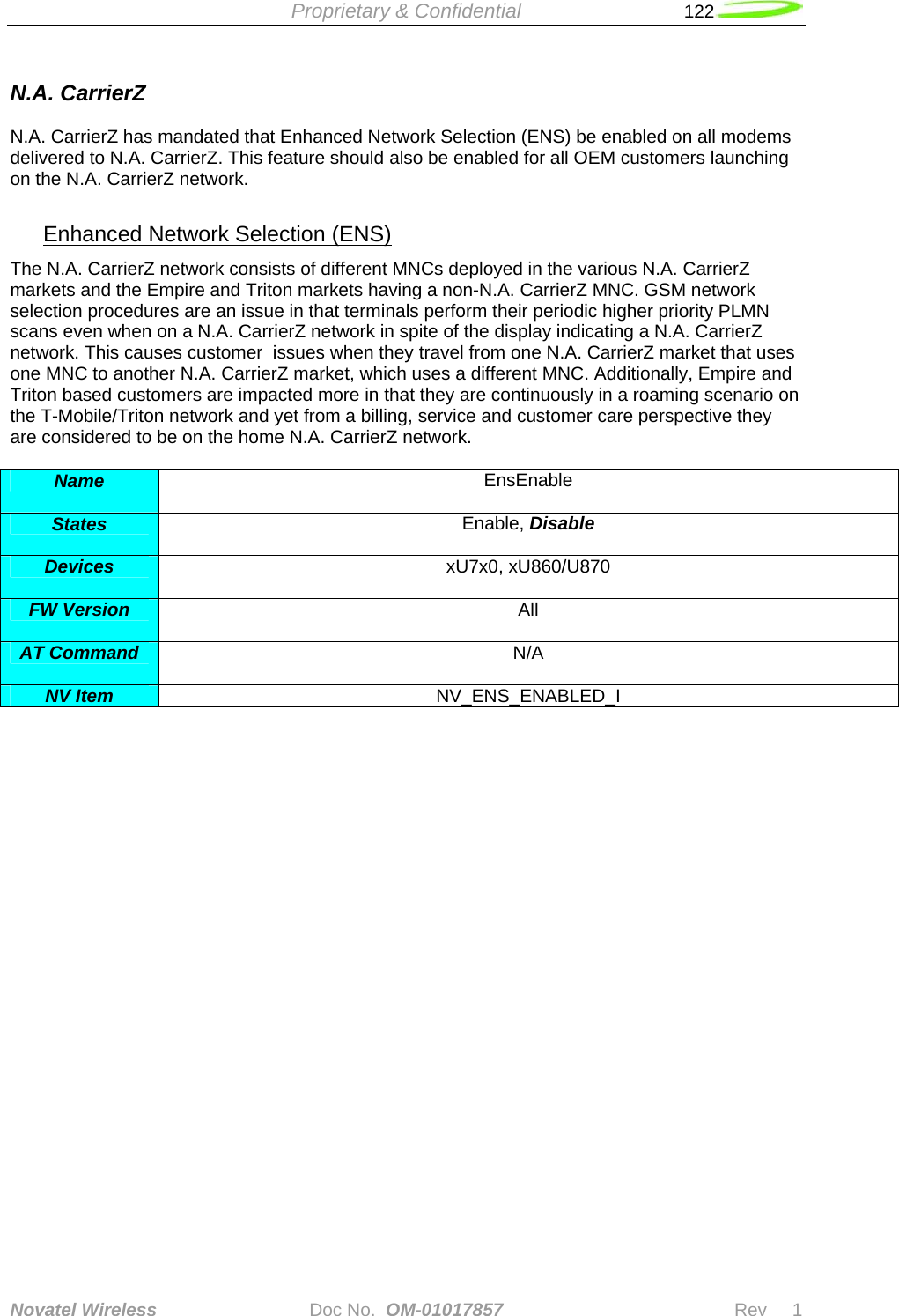
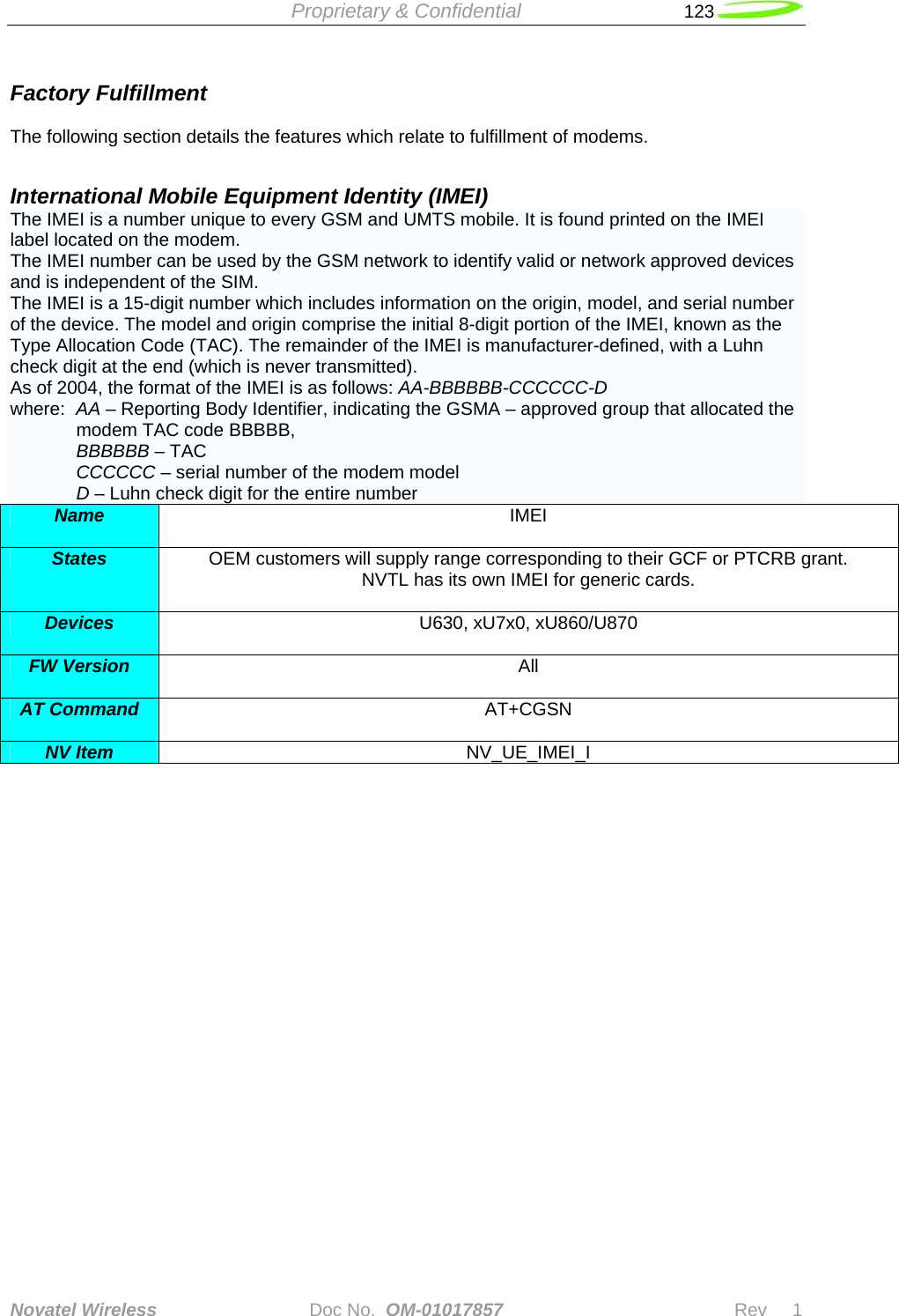
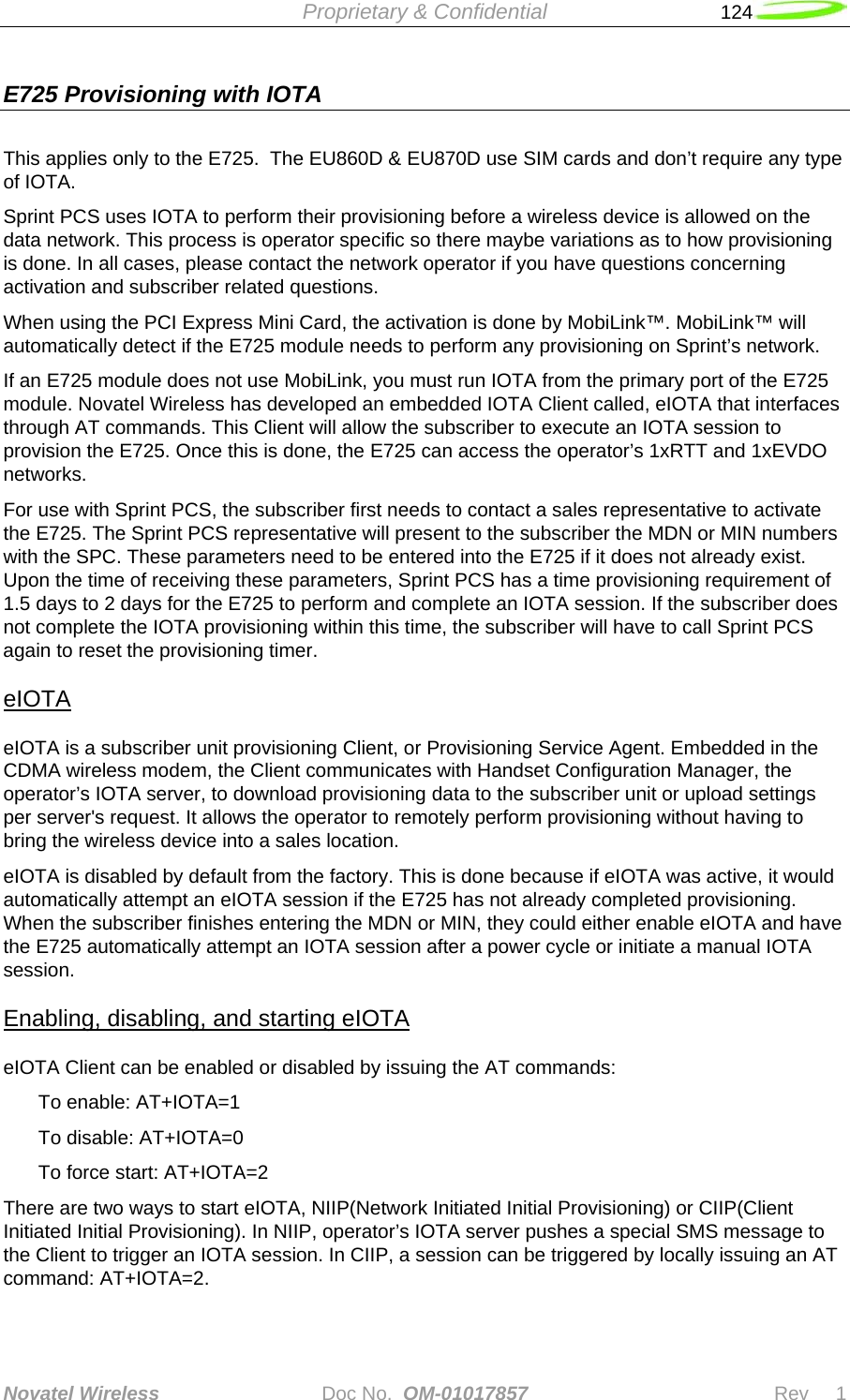
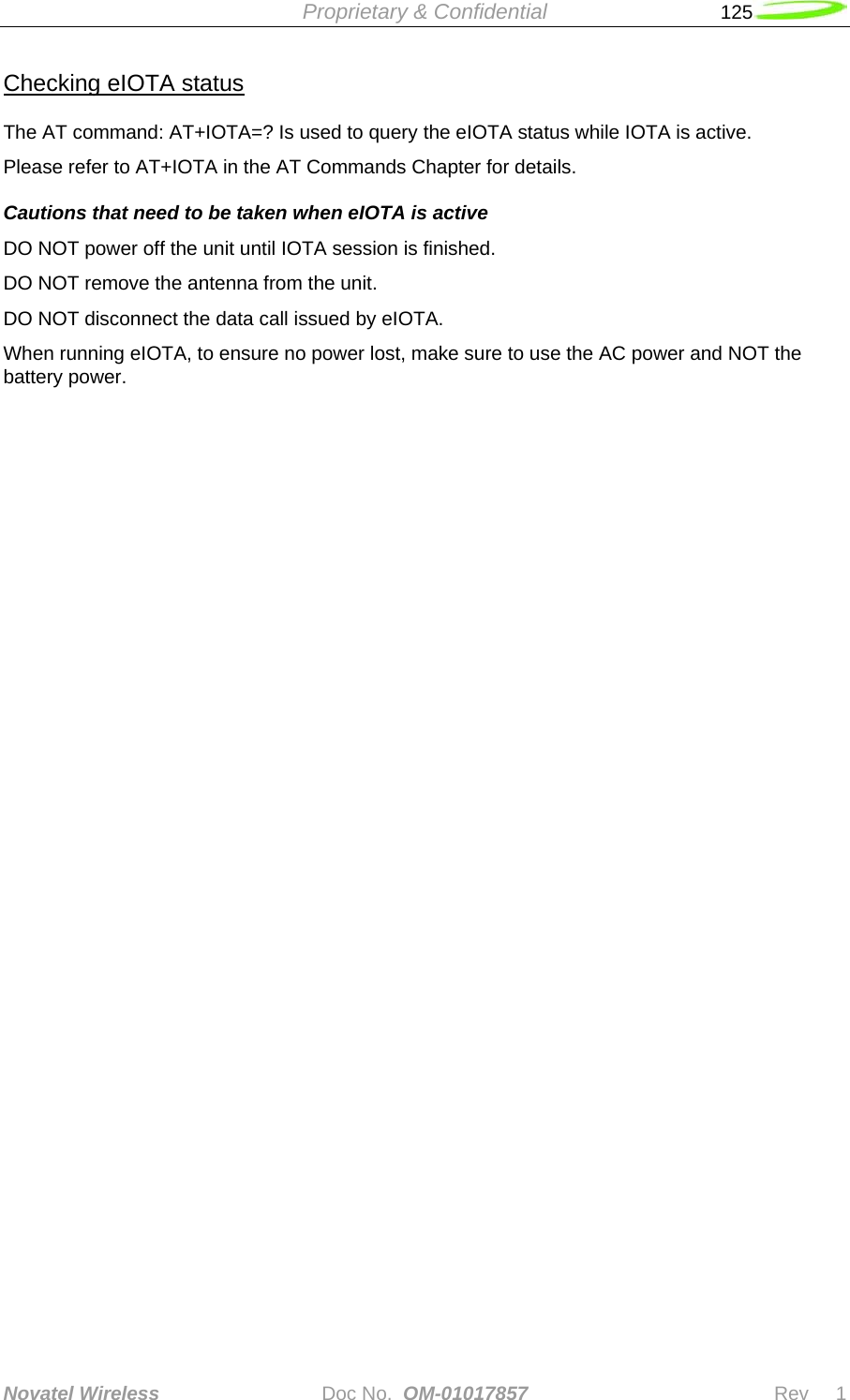
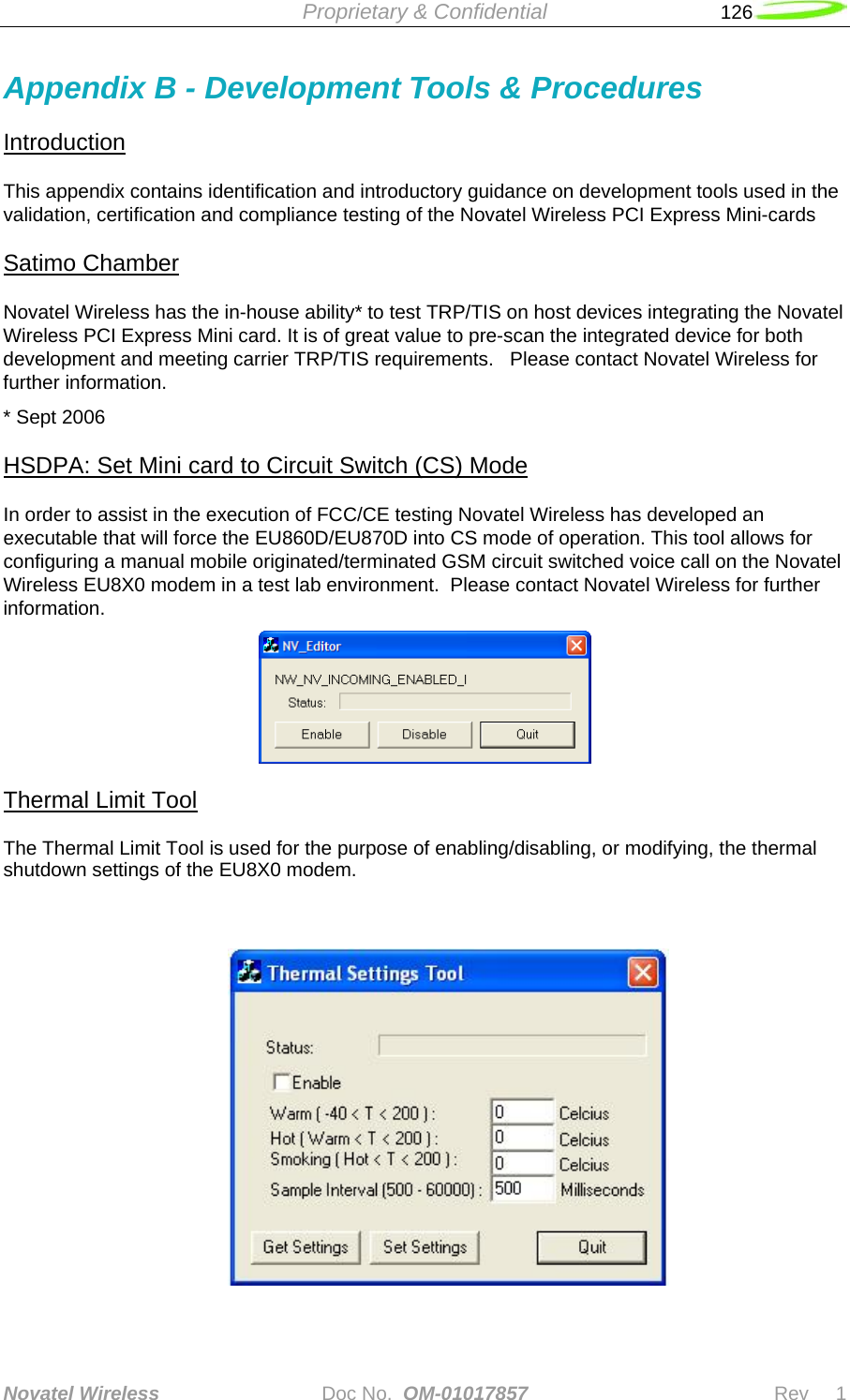
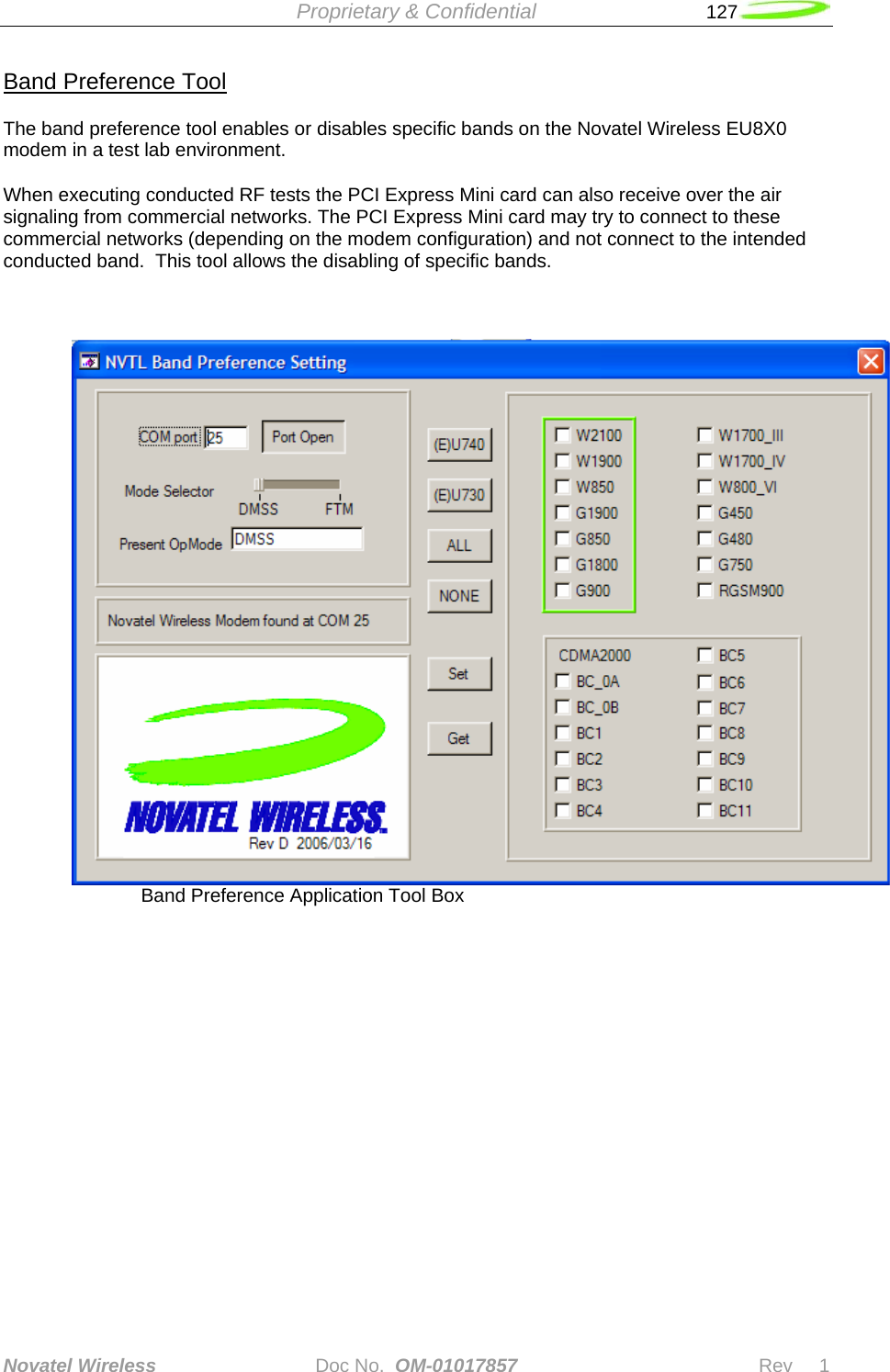
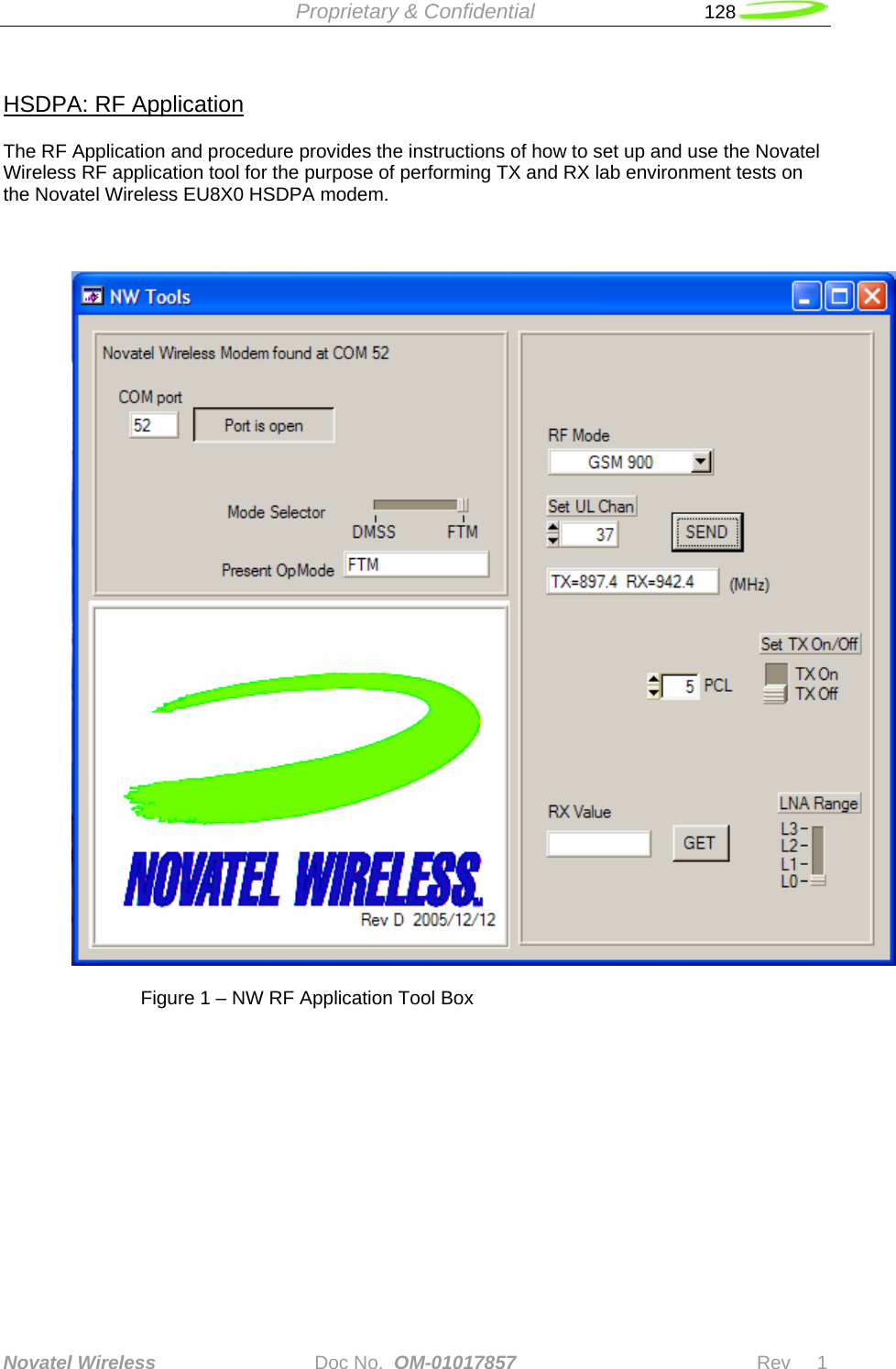
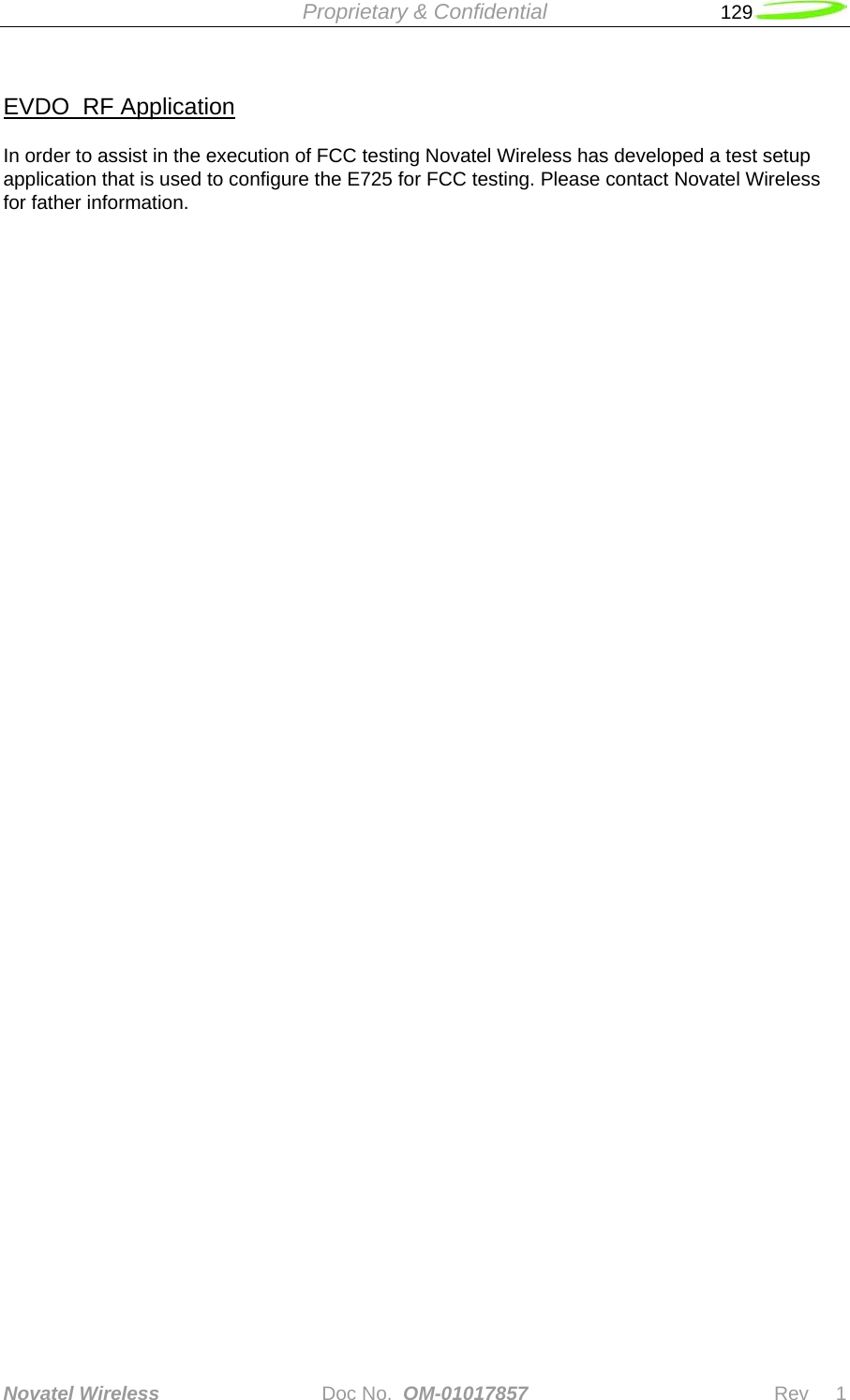
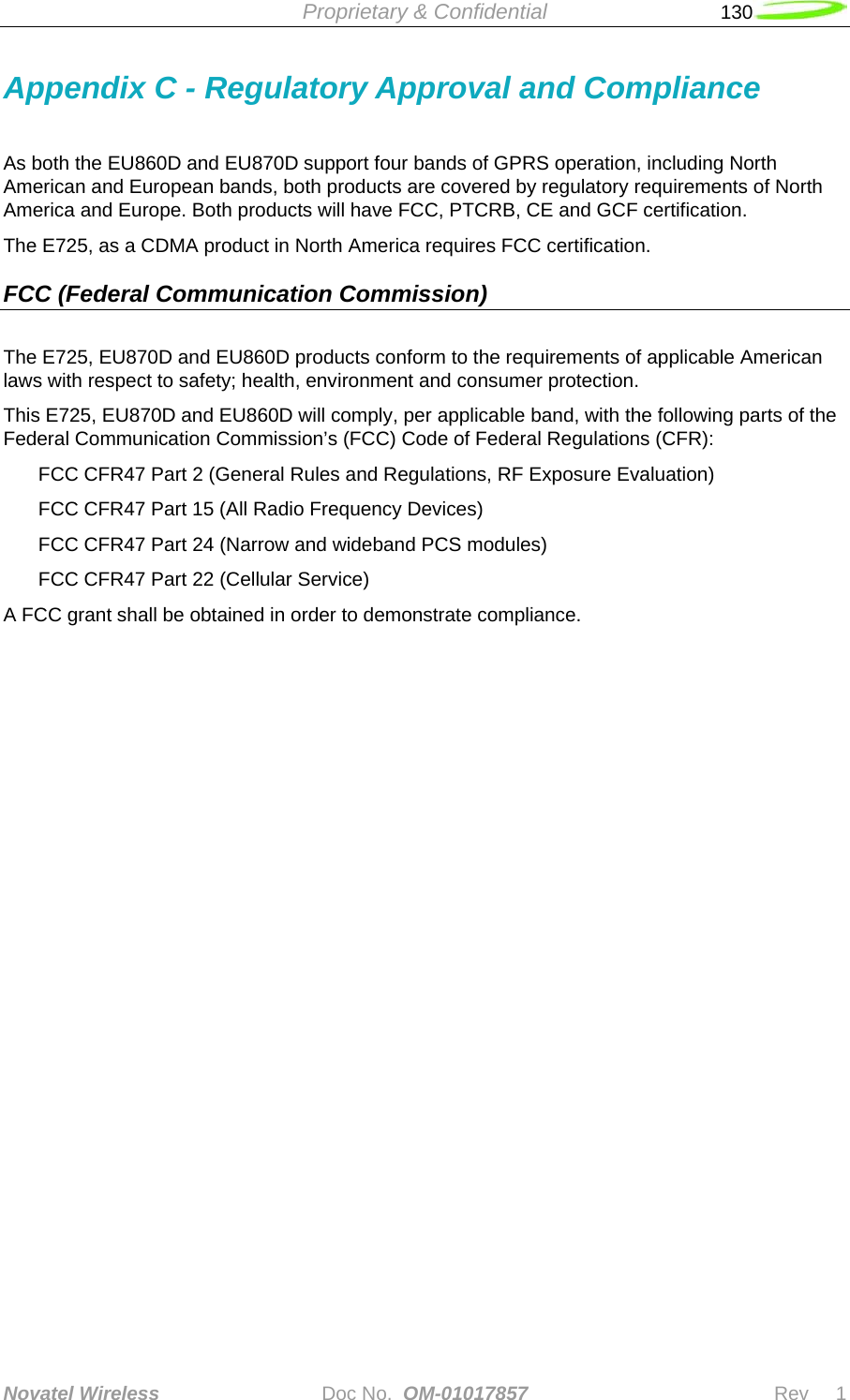
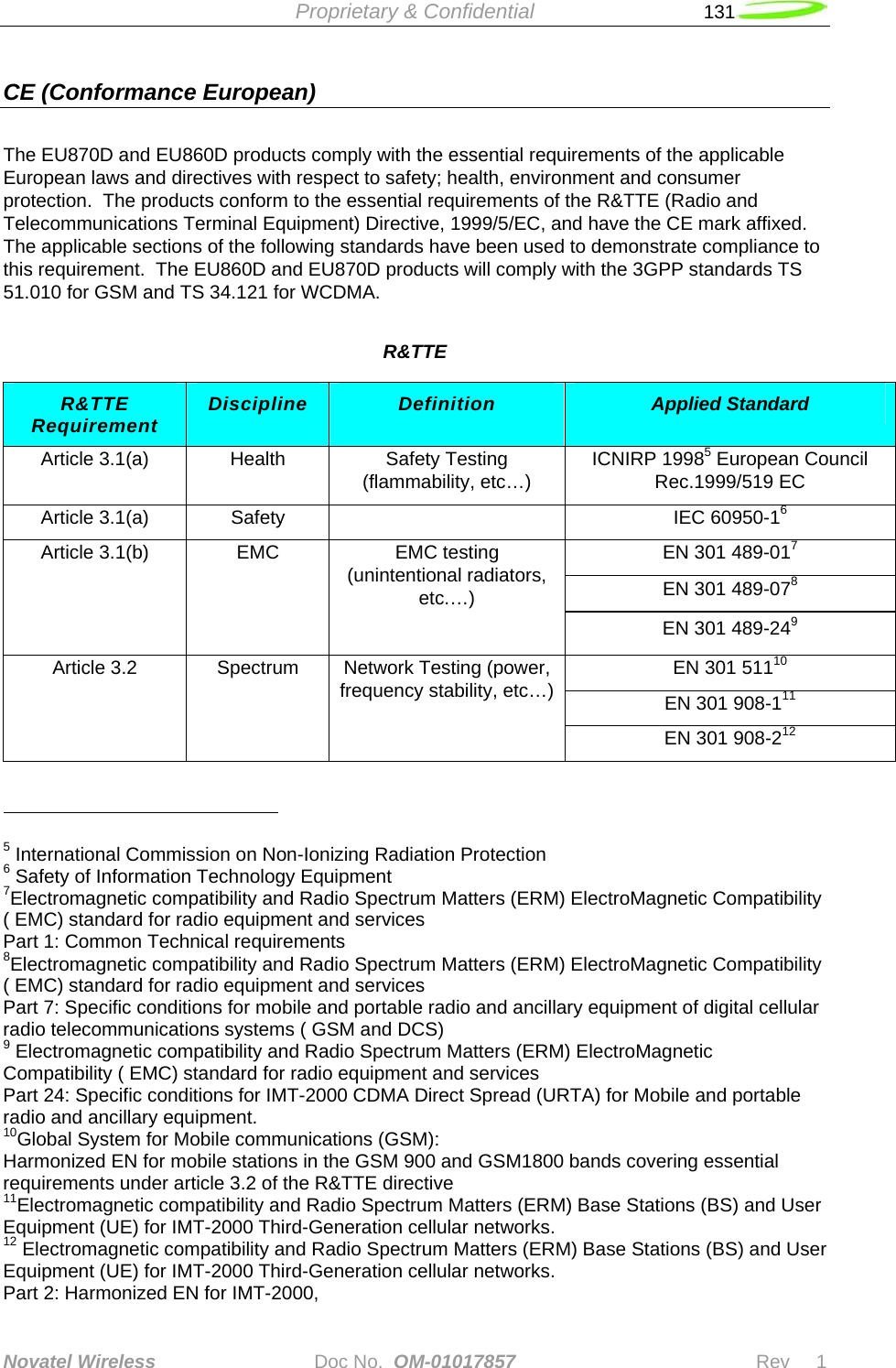
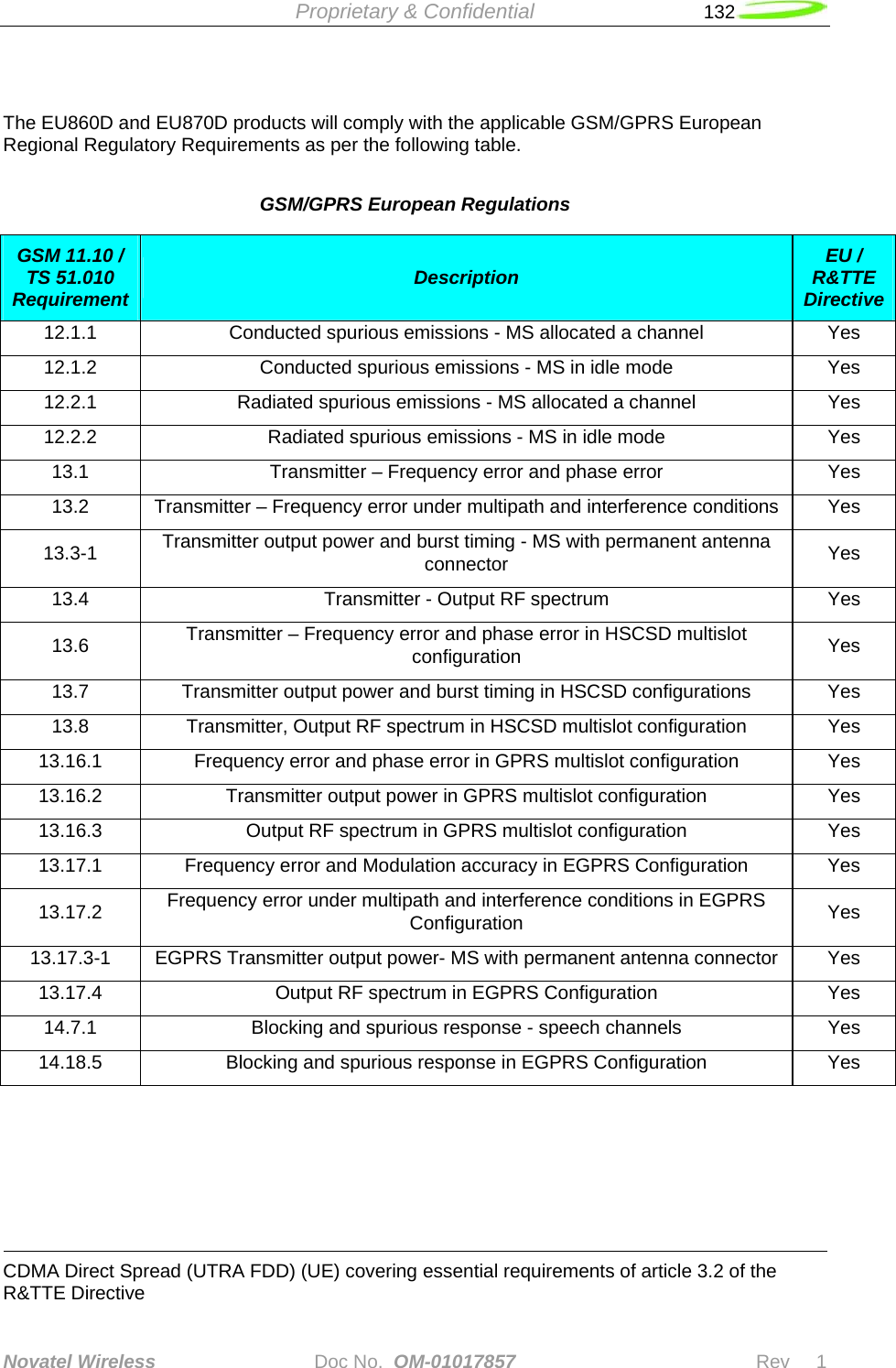
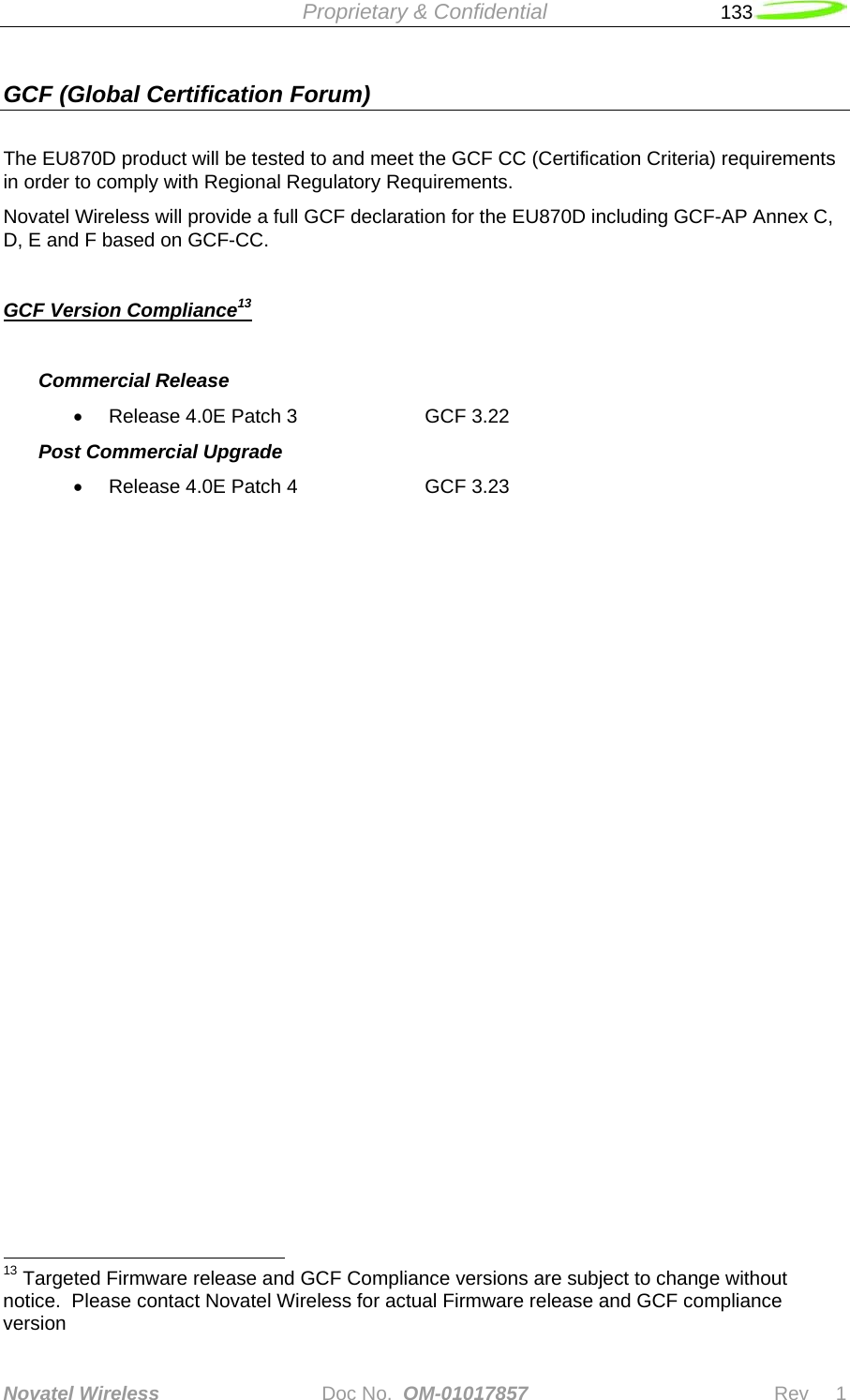
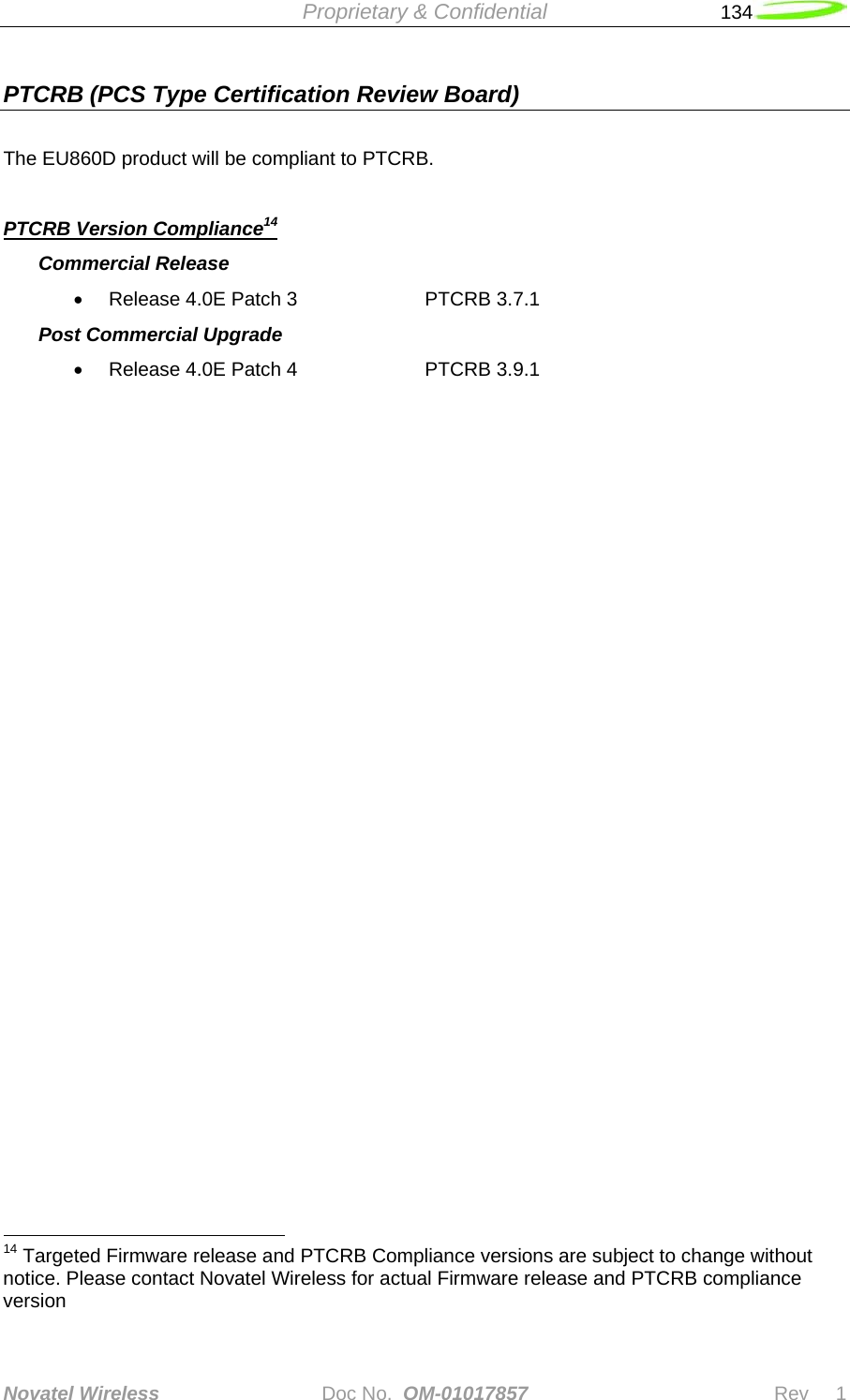
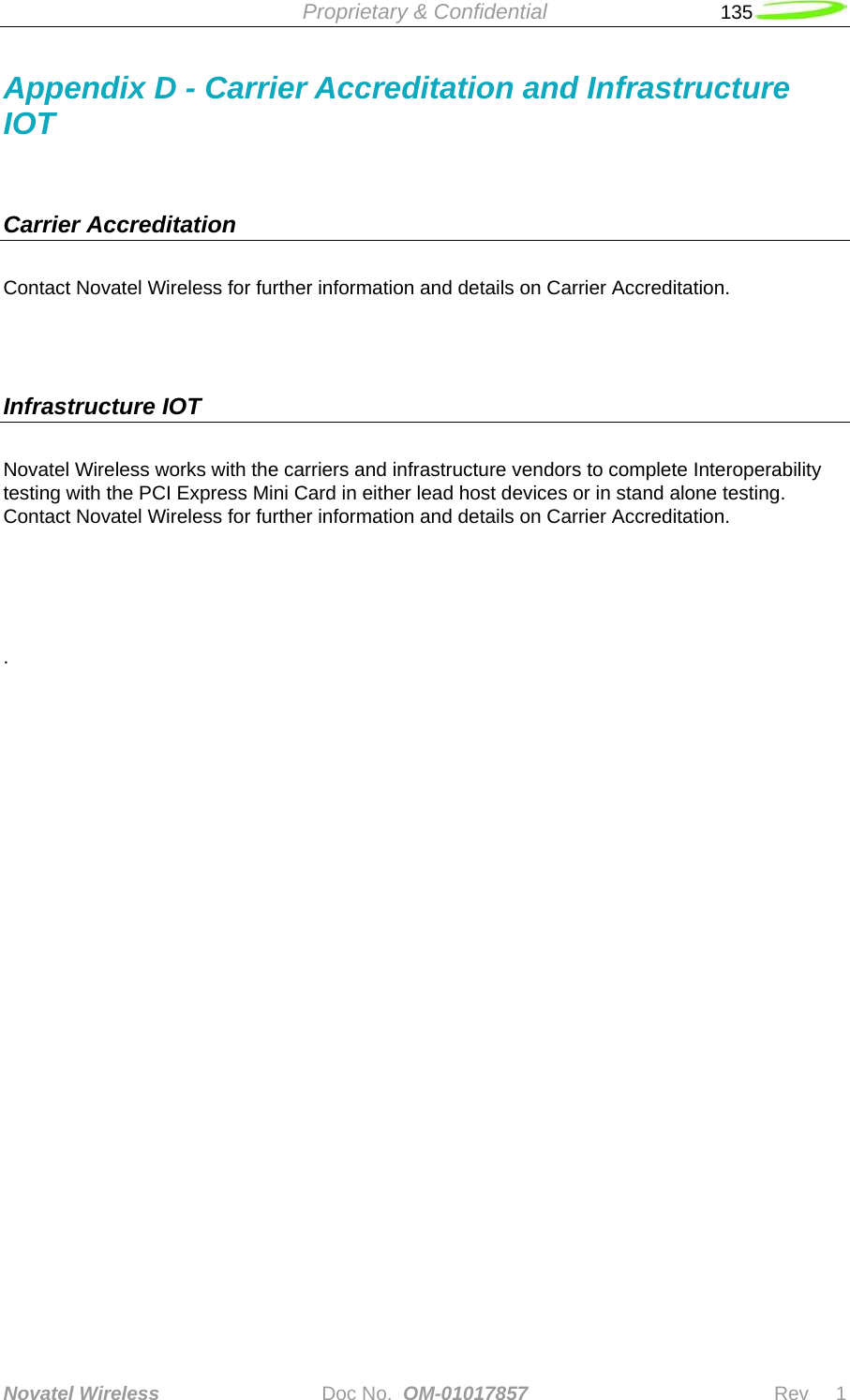
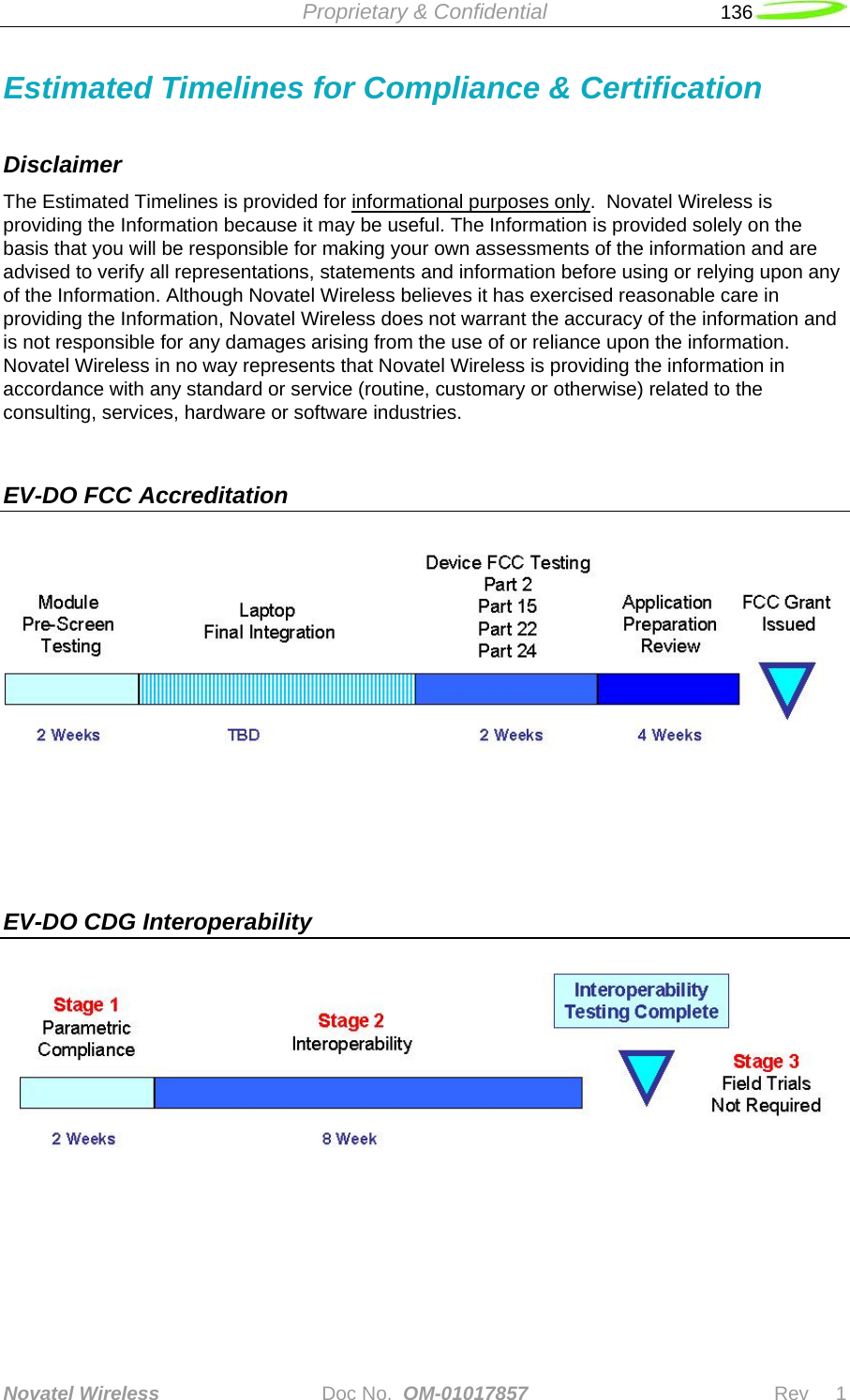
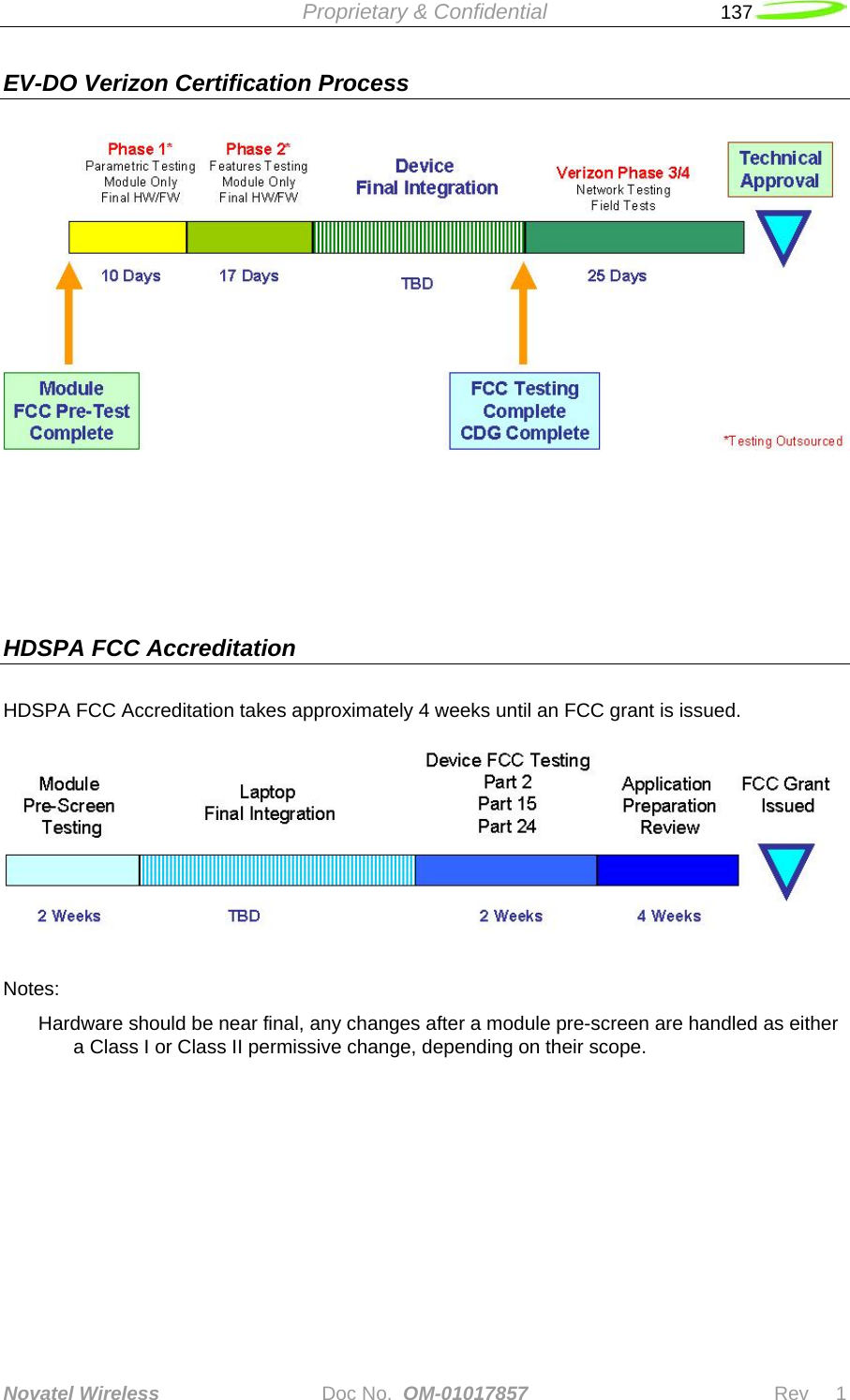
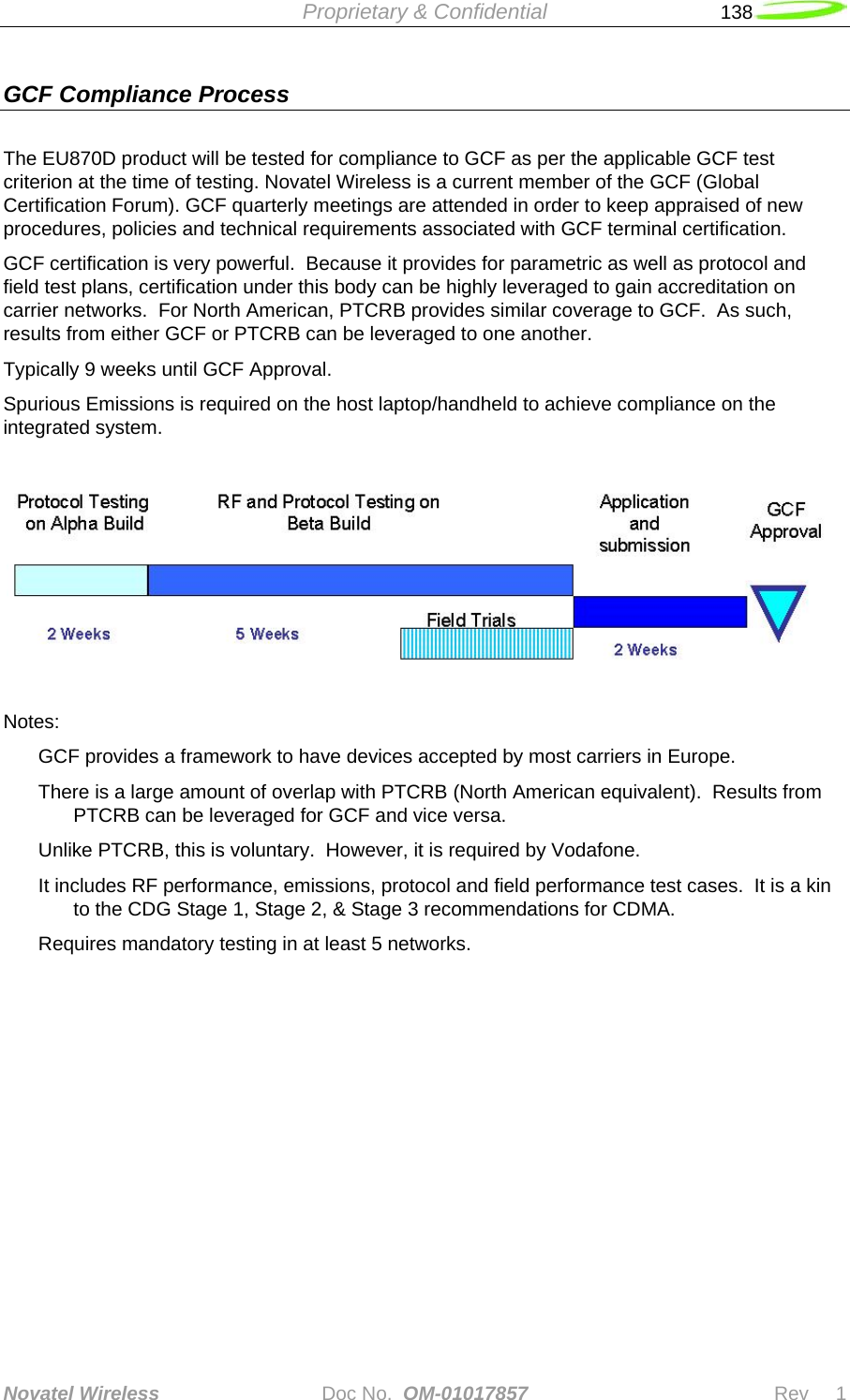
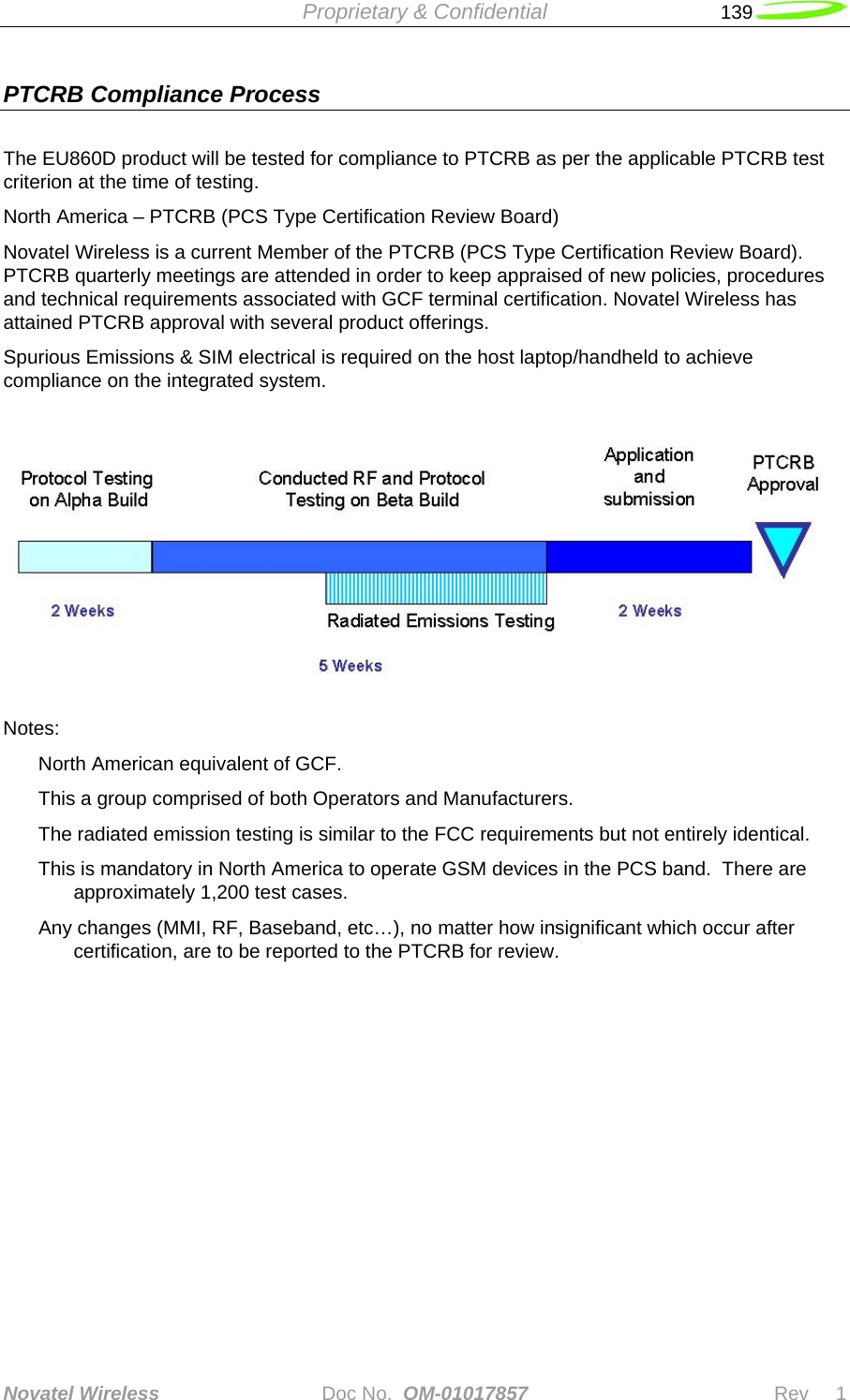
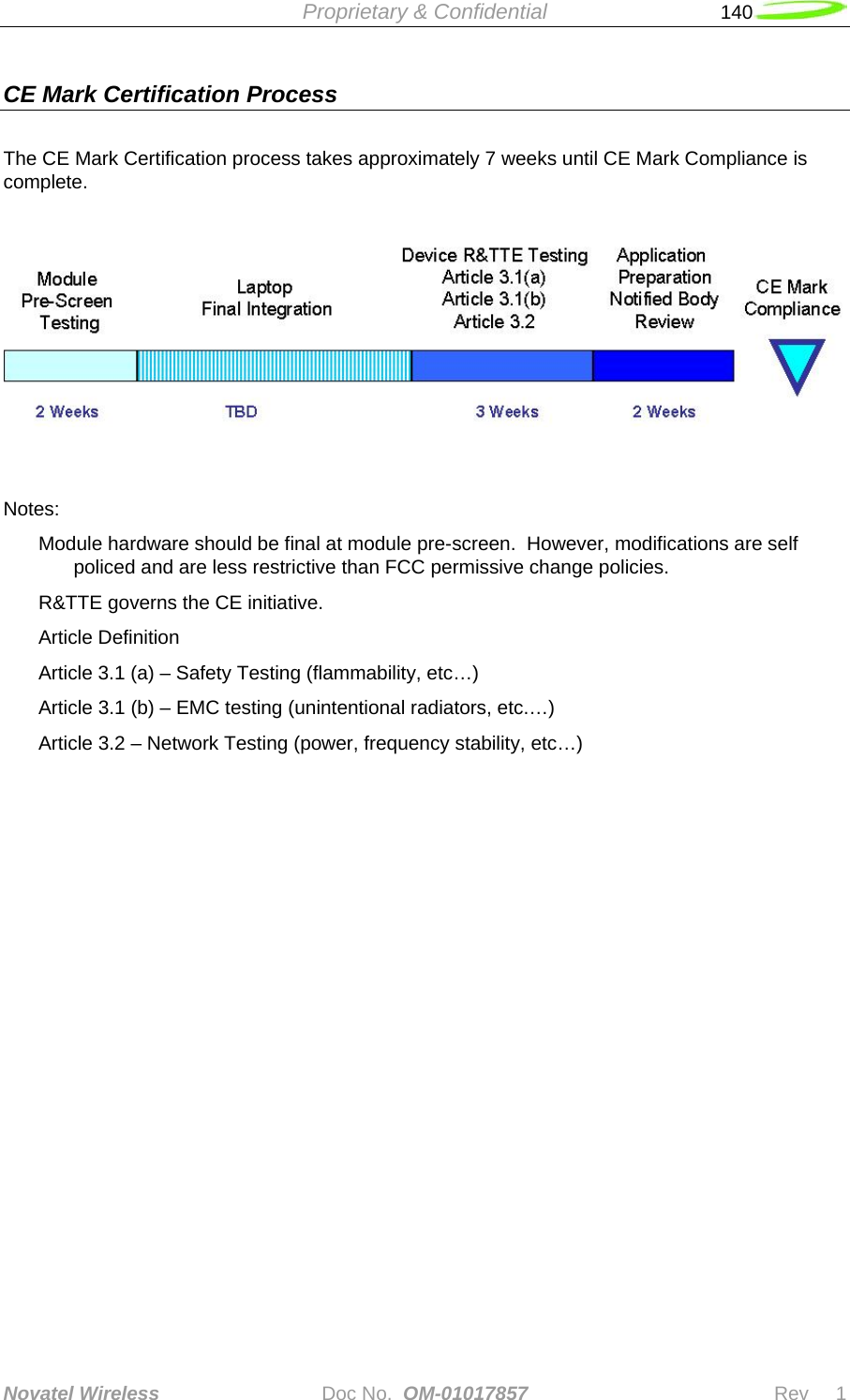
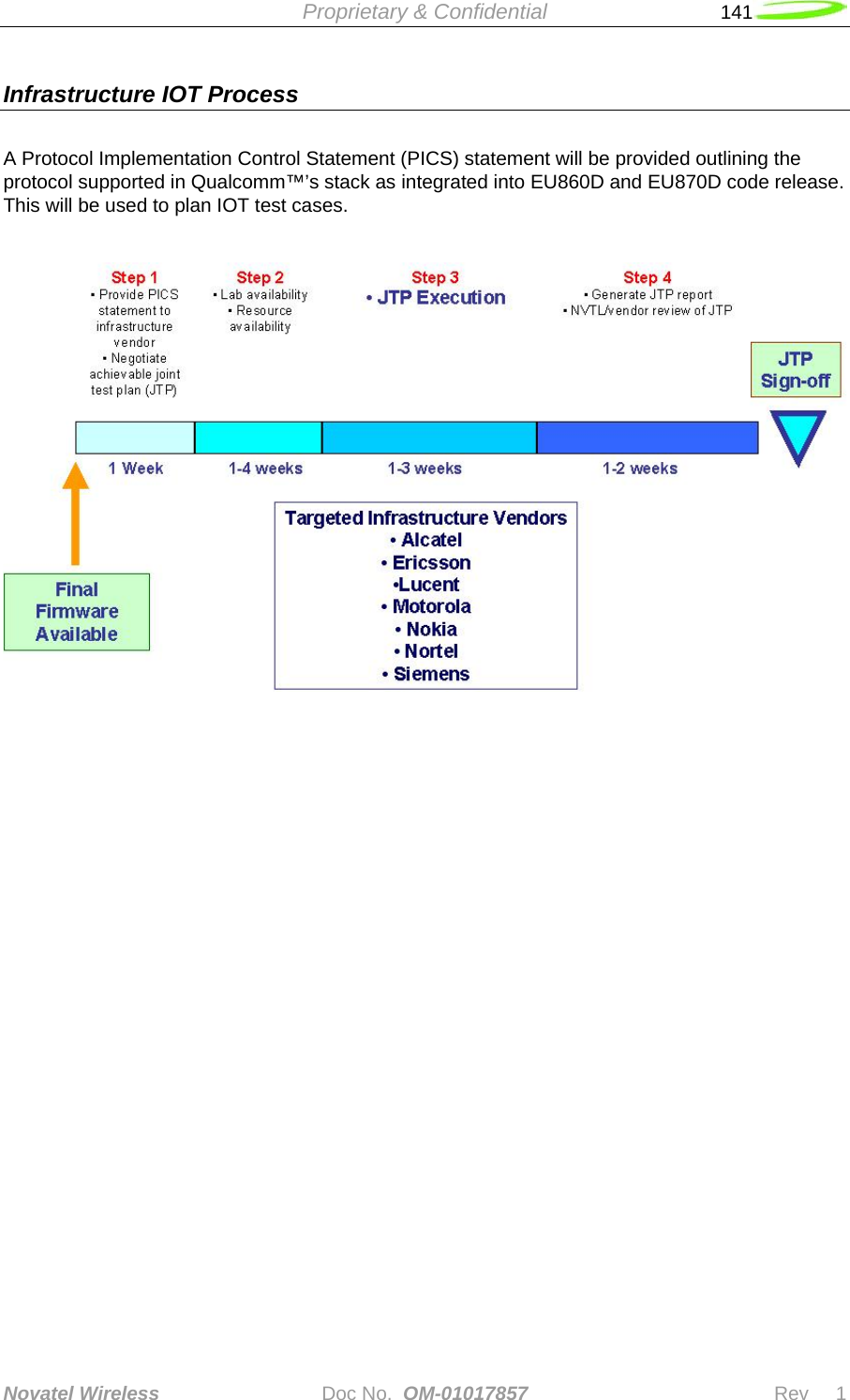
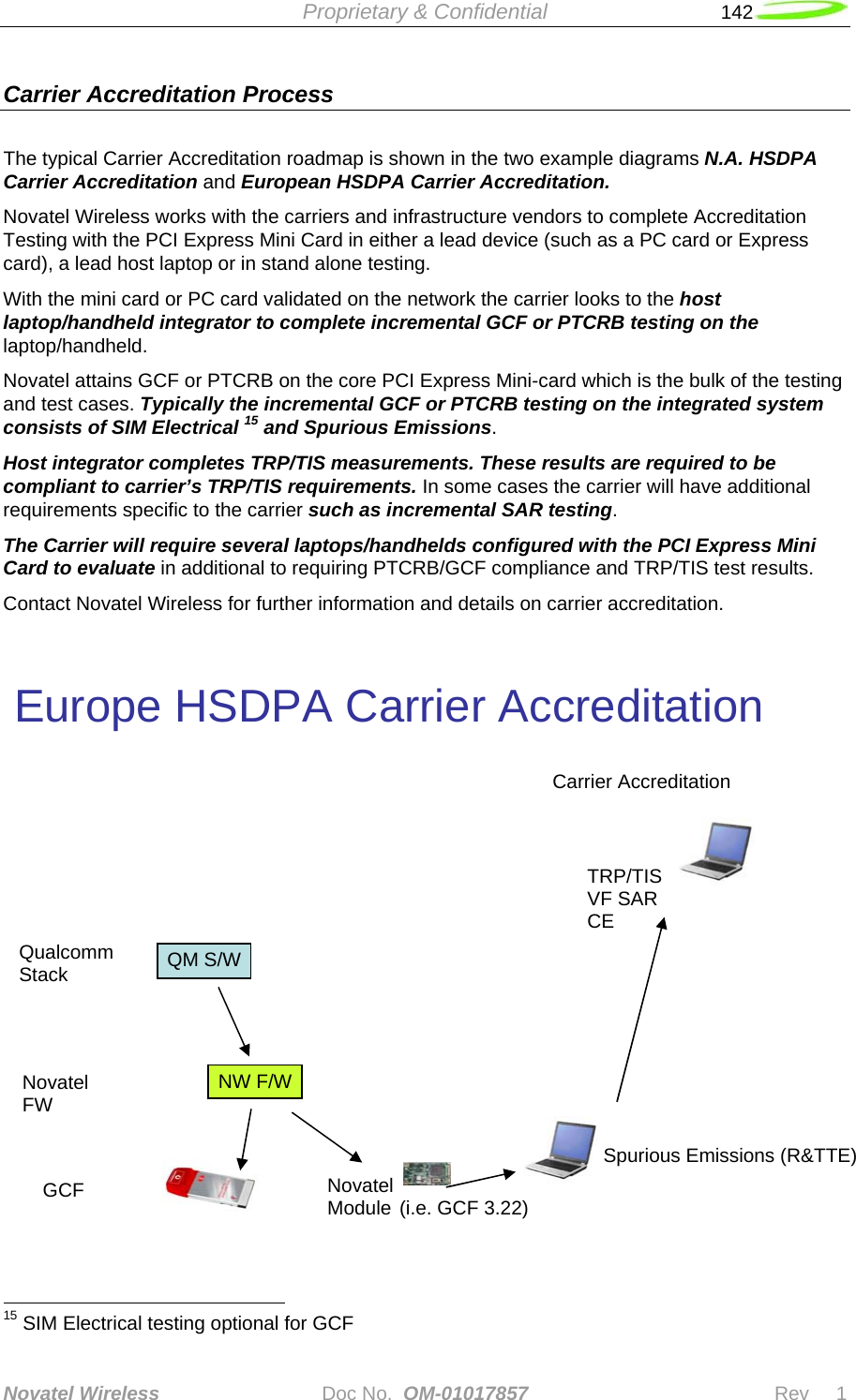
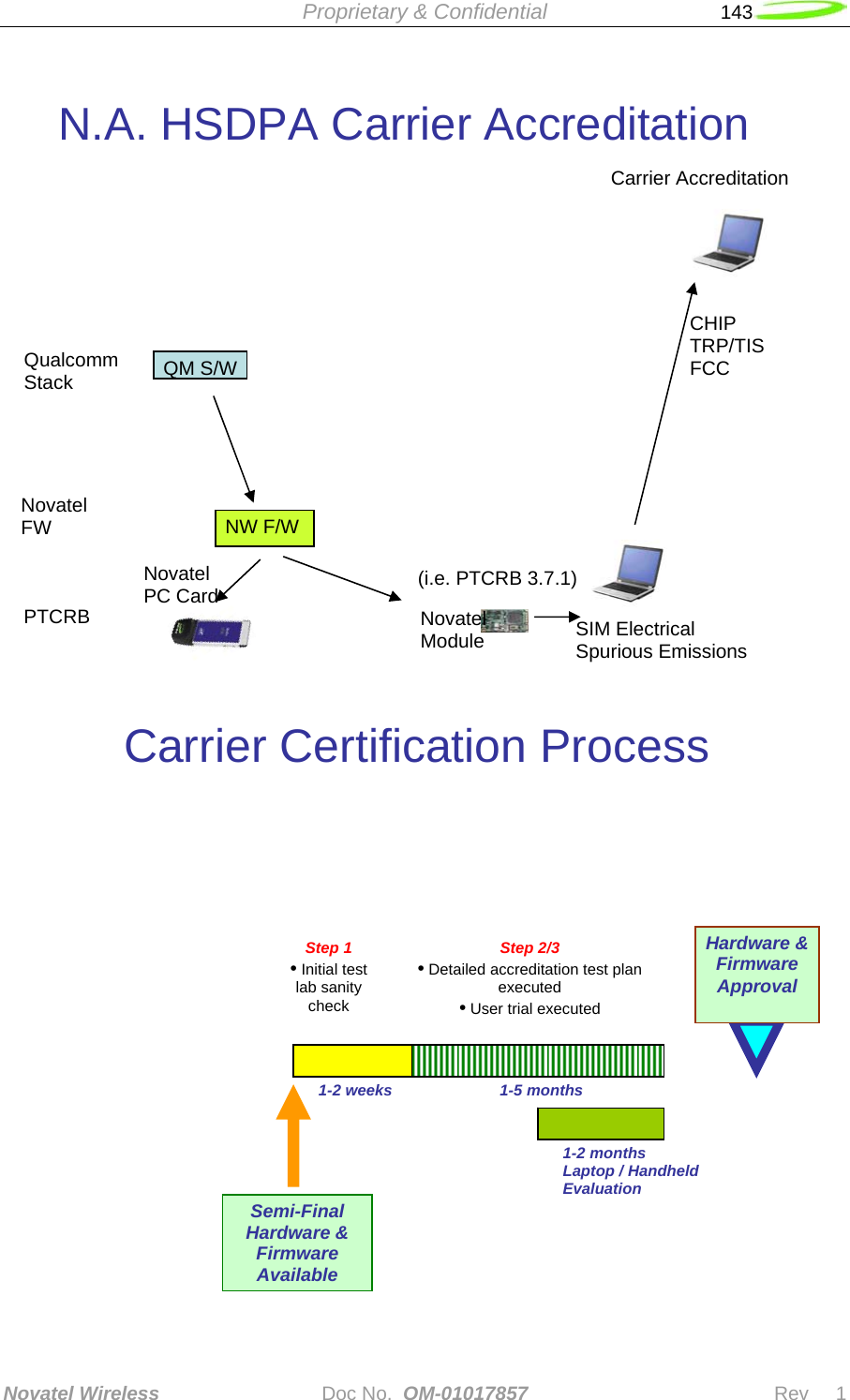
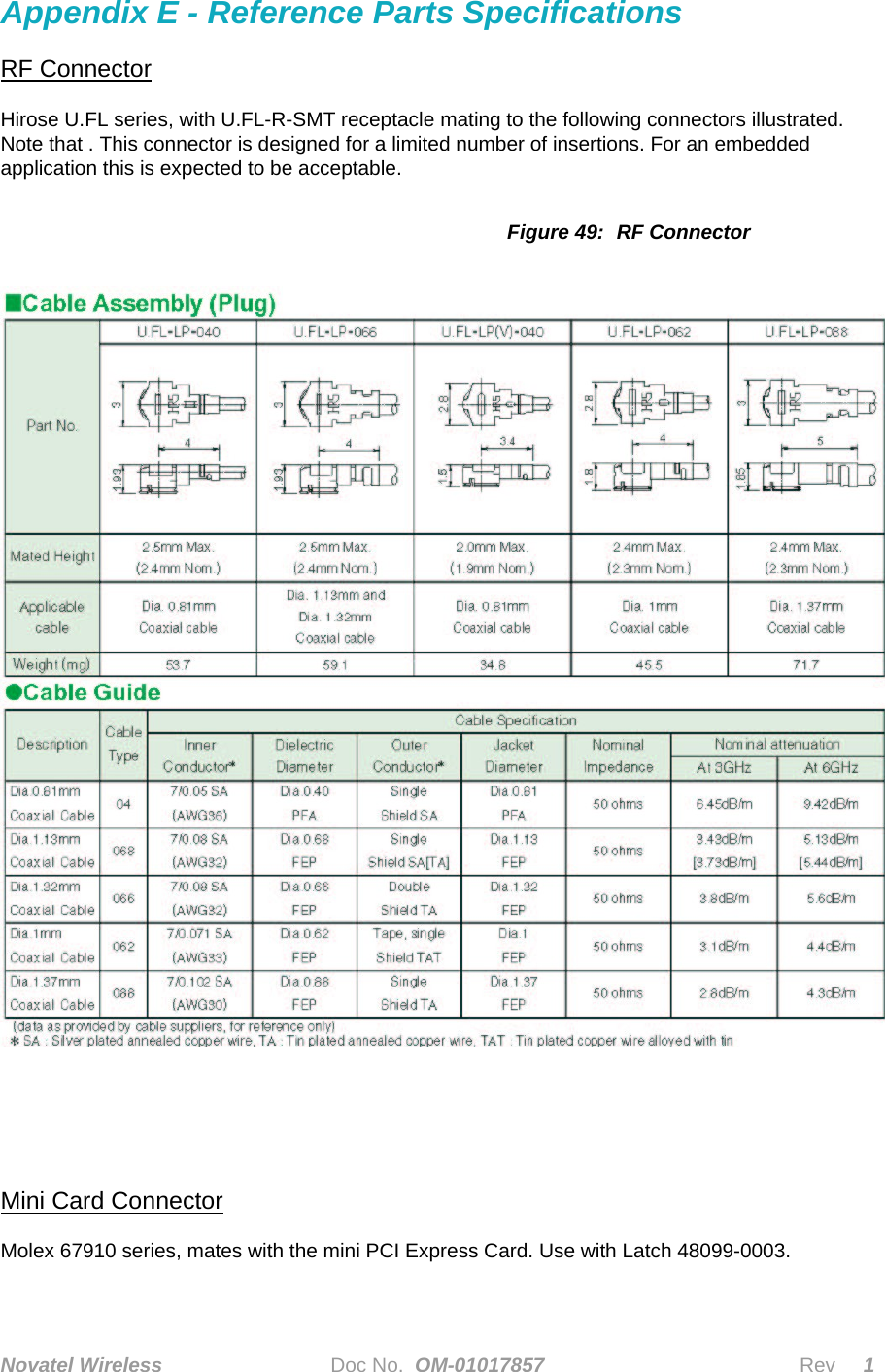
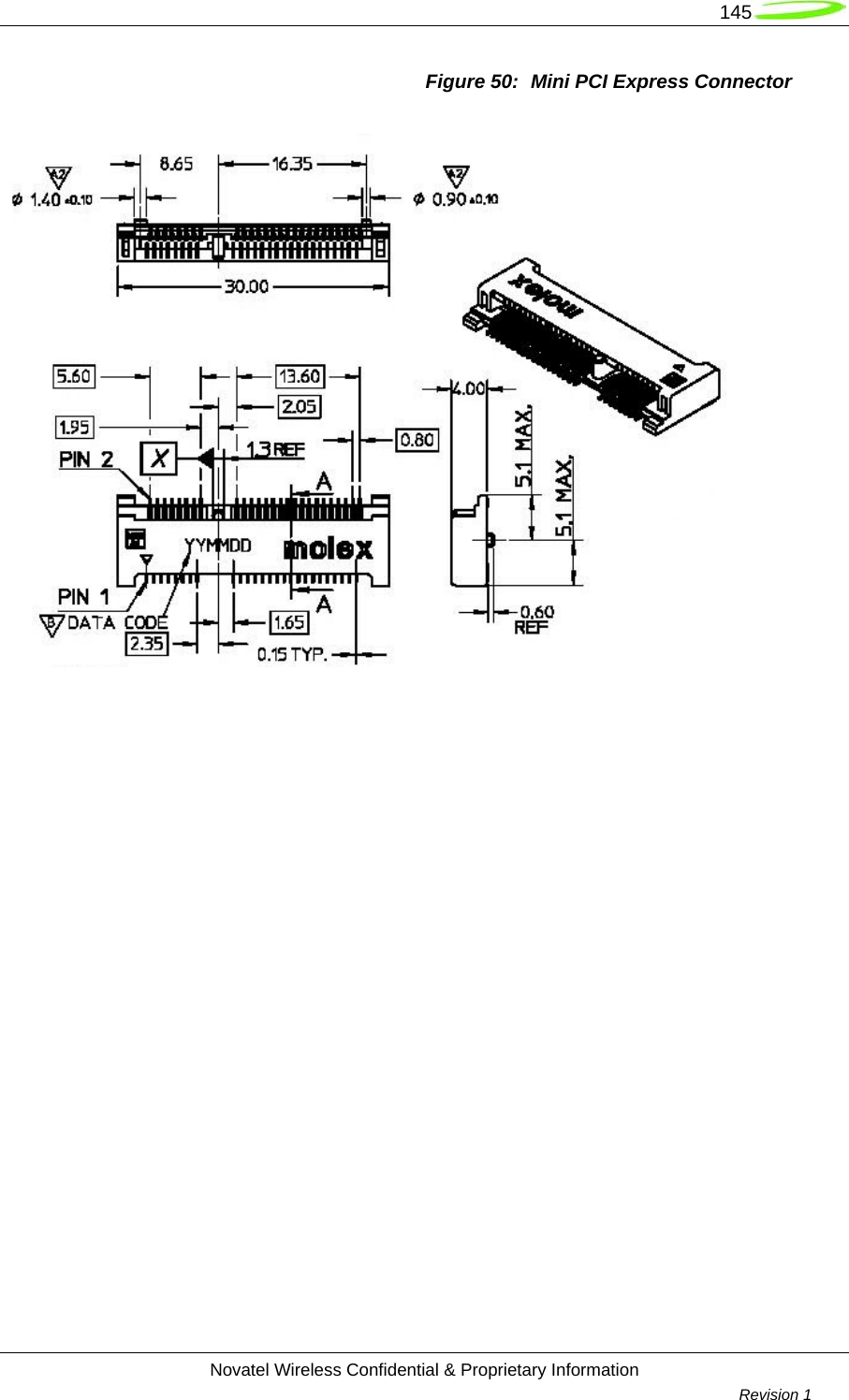
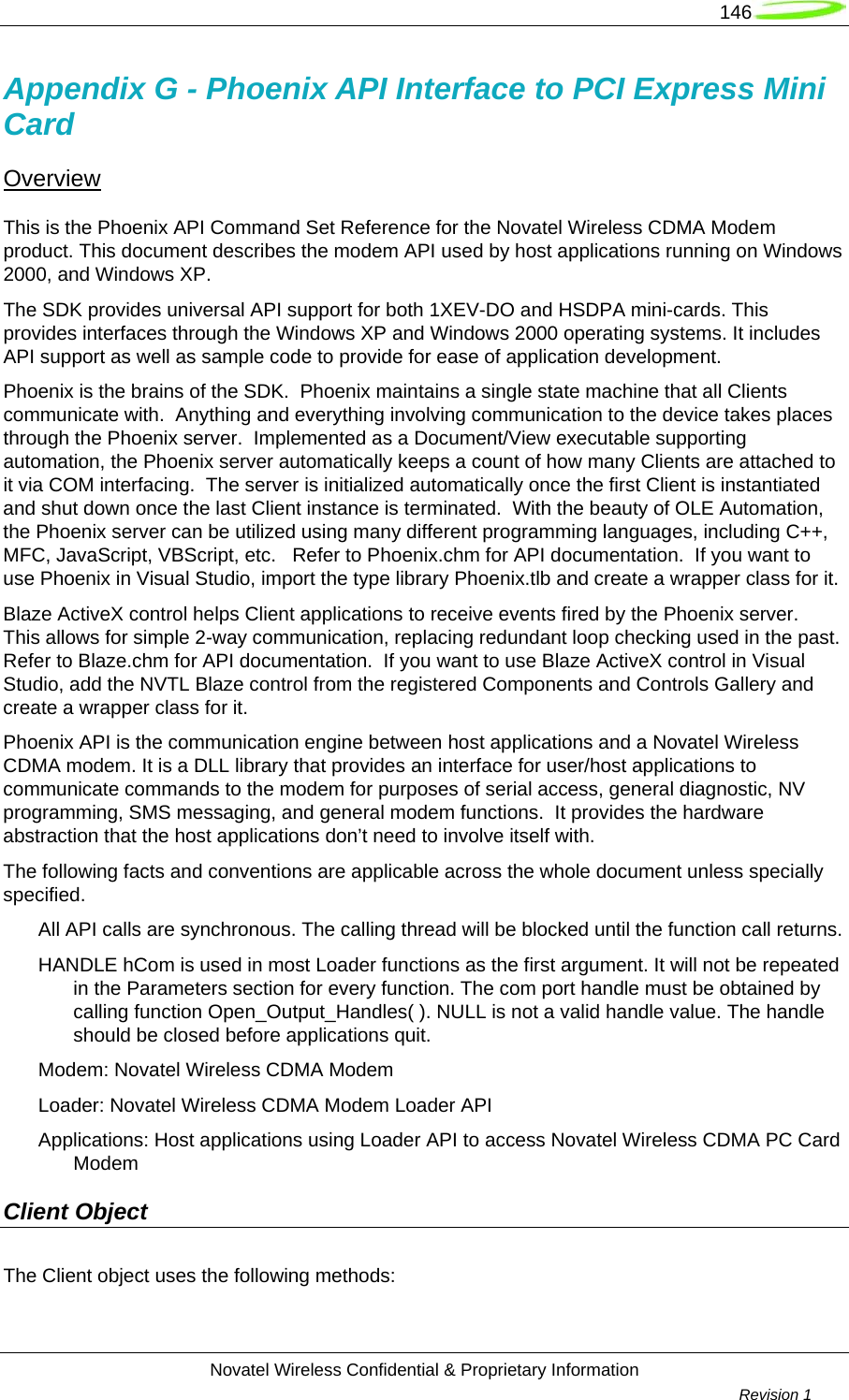
![147 Novatel Wireless Confidential & Proprietary Information Revision 1 ChangeLockCode method Description: Used to change the lock code of the device. Return Type: A Long value. Syntax: object.ChangeLockCode(lpszLockCode As String, lpszNewLockCode As String) The ChangeLockCode method syntax has these parts: Part Description object An expression evaluating to an object of type Client. lpszLockCode String lpszNewLockCode String Sample Code using ChangeLockCode Method: long IPhoenixWrapper::ChangeLockCode(LPCTSTR lpszLockCode, LPCTSTR lpszNewLockCode) { long result; static BYTE parms[] = VTS_BSTR VTS_BSTR; InvokeHelper(0x18, DISPATCH_METHOD, VT_I4, (void*)&result, parms, lpszLockCode, lpszNewLockCode); return result; } Connect method Description: To initiate a PS or CS (if supported by device) call. Return Type: A Long value. Syntax: object.Connect(lpszUsername As String, lpszPassword As String, lpszNumber As String, varErrorMsg As Variant, nIPAddress As Long, nPrimaryDNS As Long, nSecondaryDNS As Long, nPrimaryWINS As Long, nSecondaryWINS As Long, nPapChap As Long, lpszVPN As String) The Connect method syntax has these parts: Part Description object An expression evaluating to an object of type Client. lpszUsername String lpszPassword String lpszNumber String varErrorMsg Variant nIPAddress Long nPrimaryDNS Long nSecondaryDNS Long nPrimaryWINS Long nSecondaryWINS Long nPapChap Long](https://usermanual.wiki/Novatel-Wireless/NRM-EU860D.Part-2/User-Guide-754579-Page-27.png)
![148 Novatel Wireless Confidential & Proprietary Information Revision 1 lpszVPN String Sample Code using Connect Method: long IPhoenixWrapper::Connect(LPCTSTR lpszUsername, LPCTSTR lpszPassword, LPCTSTR lpszNumber, VARIANT* varErrorMsg, long nIPAddress, long nPrimaryDNS, long nSecondaryDNS, long nPrimaryWINS, long nSecondaryWINS, long nPapChap, LPCTSTR lpszVPN) { long result; static BYTE parms[] = VTS_BSTR VTS_BSTR VTS_BSTR VTS_PVARIANT VTS_I4 VTS_I4 VTS_I4 VTS_I4 VTS_I4 VTS_I4 VTS_BSTR; InvokeHelper(0x5, DISPATCH_METHOD, VT_I4, (void*)&result, parms, lpszUsername, lpszPassword, lpszNumber, varErrorMsg, nIPAddress, nPrimaryDNS, nSecondaryDNS, nPrimaryWINS, nSecondaryWINS, nPapChap, lpszVPN); return result; } DebugPrint method Description: Used to write out to the log file. Syntax: object.DebugPrint(nModule As Long, nLevel As Long, lpszDebug As String) The DebugPrint method syntax has these parts: Part Description object An expression evaluating to an object of type Client. nModule Long nLevel Long lpszDebug String Sample Code using DebugPrint Method: void IPhoenixWrapper::DebugPrint(long nModule, long nLevel, LPCTSTR lpszDebug) { static BYTE parms[] = VTS_I4 VTS_I4 VTS_BSTR; InvokeHelper(0x1e, DISPATCH_METHOD, VT_EMPTY, NULL, parms, nModule, nLevel, lpszDebug); } DeleteMessage method Description: Delete a message. Return Type: A Long value. Syntax: object.DeleteMessage(nMsgBoxEnum As Long, nIndex As Long) The DeleteMessage method syntax has these parts: Part Description Object An expression evaluating to an object of type Client. nMsgBoxEnum Long nIndex Long](https://usermanual.wiki/Novatel-Wireless/NRM-EU860D.Part-2/User-Guide-754579-Page-28.png)
![149 Novatel Wireless Confidential & Proprietary Information Revision 1 Sample Code using DeleteMessage Method: long IphoenixWrapper::DeleteMessage(long nMsgBoxEnum, long nIndex) { long result; static BYTE parms[] = VTS_I4 VTS_I4; InvokeHelper(0x21, DISPATCH_METHOD, VT_I4, (void*)&result, parms, nMsgBoxEnum, nIndex); return result; } Disconnect method Description: To terminate call. Return Type: A Long value. Syntax: object.Disconnect The Disconnect method syntax has these parts: Part Description Object An expression evaluating to an object of type Client. Sample Code using Disconnect Method: long IphoenixWrapper::Disconnect() { long result; InvokeHelper(0x6, DISPATCH_METHOD, VT_I4, (void*)&result, NULL); return result; } GetAdapter method Description: Get the name of the currently selected/active device. Return Type: A String value. Syntax: object.GetAdapter The GetAdapter method syntax has these parts: Part Description Object An expression evaluating to an object of type Client. Sample Code using GetAdapter Method: Cstring IphoenixWrapper::GetAdapter() { Cstring result; InvokeHelper(0x1b, DISPATCH_METHOD, VT_BSTR, (void*)&result, NULL); return result; } GetAdapterList method Description: Get a list of currently available devices.](https://usermanual.wiki/Novatel-Wireless/NRM-EU860D.Part-2/User-Guide-754579-Page-29.png)
![150 Novatel Wireless Confidential & Proprietary Information Revision 1 Return Type: A Long value. Syntax: object.GetAdapterList(varAdapterList As Variant) The GetAdapterList method syntax has these parts: Part Description Object An expression evaluating to an object of type Client. varAdapterList Variant Sample Code using GetAdapterList Method: long IphoenixWrapper::GetAdapterList(VARIANT* varAdapterList) { long result; static BYTE parms[] = VTS_PVARIANT; InvokeHelper(0x1d, DISPATCH_METHOD, VT_I4, (void*)&result, parms, varAdapterList); return result; } GetConnectStatus method Description: Once connected, get RAS status info of the current connection. Return Type: A Long value. Syntax: object.GetConnectStatus(varState As Variant, varError As Variant, varBytesIn As Variant, varBytesOut As Variant, varDuration As Variant) The GetConnectStatus method syntax has these parts: Part Description Object An expression evaluating to an object of type Client. varState Variant varError Variant varBytesIn Variant varBytesOut Variant varDuration Variant Sample Code using ConnectStatus Method: long IphoenixWrapper::GetConnectStatus(VARIANT* varState, VARIANT* varError, VARIANT* varBytesIn, VARIANT* varBytesOut, VARIANT* varDuration) { long result; static BYTE parms[] = VTS_PVARIANT VTS_PVARIANT VTS_PVARIANT VTS_PVARIANT VTS_PVARIANT; InvokeHelper(0x8, DISPATCH_METHOD, VT_I4, (void*)&result, parms, varState, varError, varBytesIn, varBytesOut, varDuration); return result; }](https://usermanual.wiki/Novatel-Wireless/NRM-EU860D.Part-2/User-Guide-754579-Page-30.png)
![151 Novatel Wireless Confidential & Proprietary Information Revision 1 GetContact method Description: Get the contact’s name and details by index. Return Type: A Long value. Syntax: object.GetContact(nIndex As Long, varContactName As Variant, varContactDetails As Variant) The GetContact method syntax has these parts: Part Description object An expression evaluating to an object of type Client. nIndex Long varContactName Variant varContactDetails Variant Sample Code using GetContact Method: long IphoenixWrapper::GetContact(long nIndex, VARIANT* varContactName, VARIANT* varContactDetails) { long result; static BYTE parms[] = VTS_I4 VTS_PVARIANT VTS_PVARIANT; InvokeHelper(0x28, DISPATCH_METHOD, VT_I4, (void*)&result, parms, nIndex, varContactName, varContactDetails); return result; } GetContactInfo method Description: Get phonebook’s max size, contact name’s max length, and contact detail’s max length. Return Type: A Long value. Syntax: object.GetContactInfo(varPhonebookMax As Variant, varContactNameMax As Variant, varContactDetailsMax As Variant) The GetContactInfo method syntax has these parts: Part Description object An expression evaluating to an object of type Client. varPhonebookMax Variant varContactNameMax Variant varContactDetailsMax Variant Sample Code using GetContactInfo Method: long IphoenixWrapper::GetContactInfo(VARIANT* varPhonebookMax, VARIANT* varContactNameMax, VARIANT* varContactDetailsMax) { long result; static BYTE parms[] = VTS_PVARIANT VTS_PVARIANT VTS_PVARIANT;](https://usermanual.wiki/Novatel-Wireless/NRM-EU860D.Part-2/User-Guide-754579-Page-31.png)
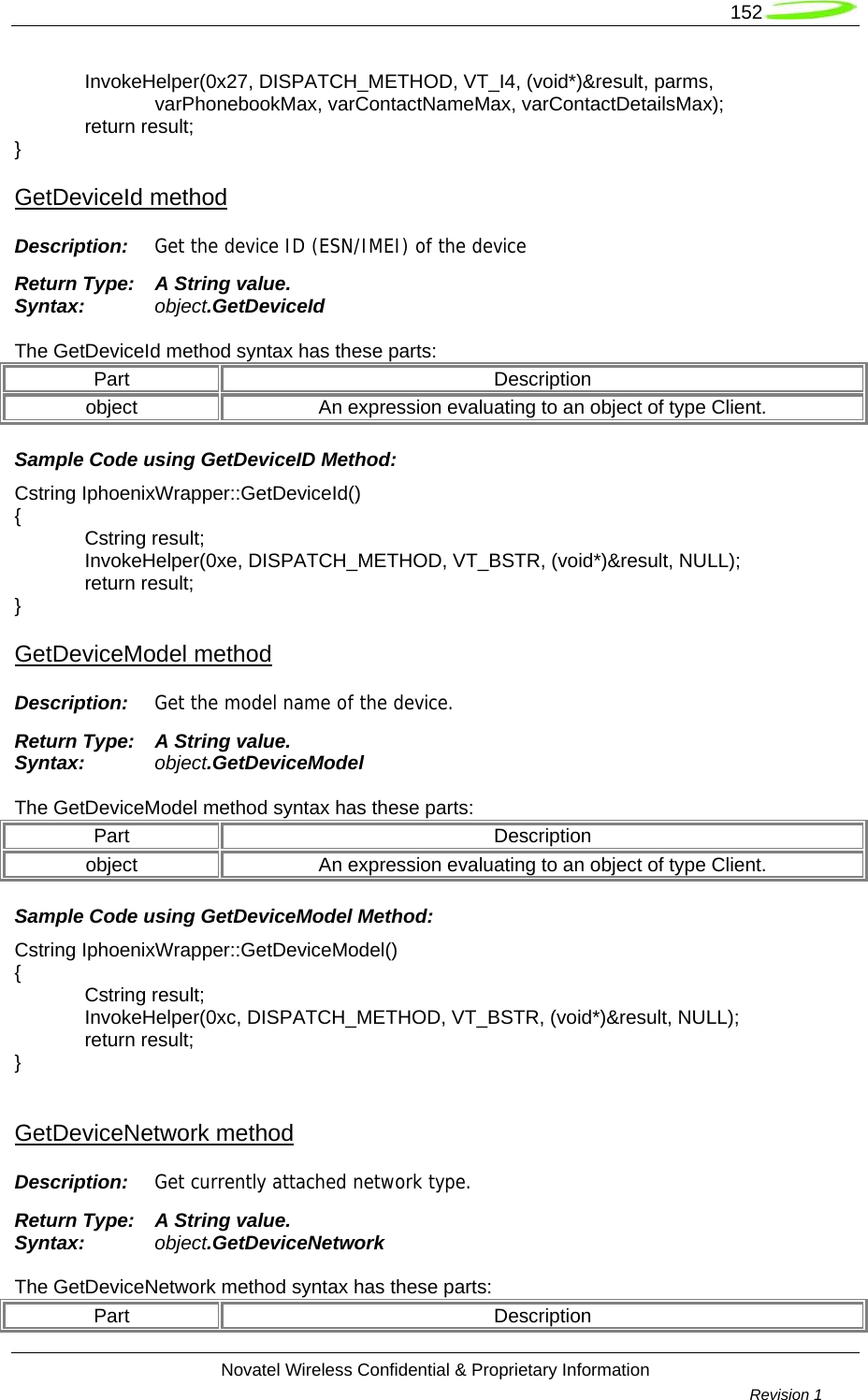
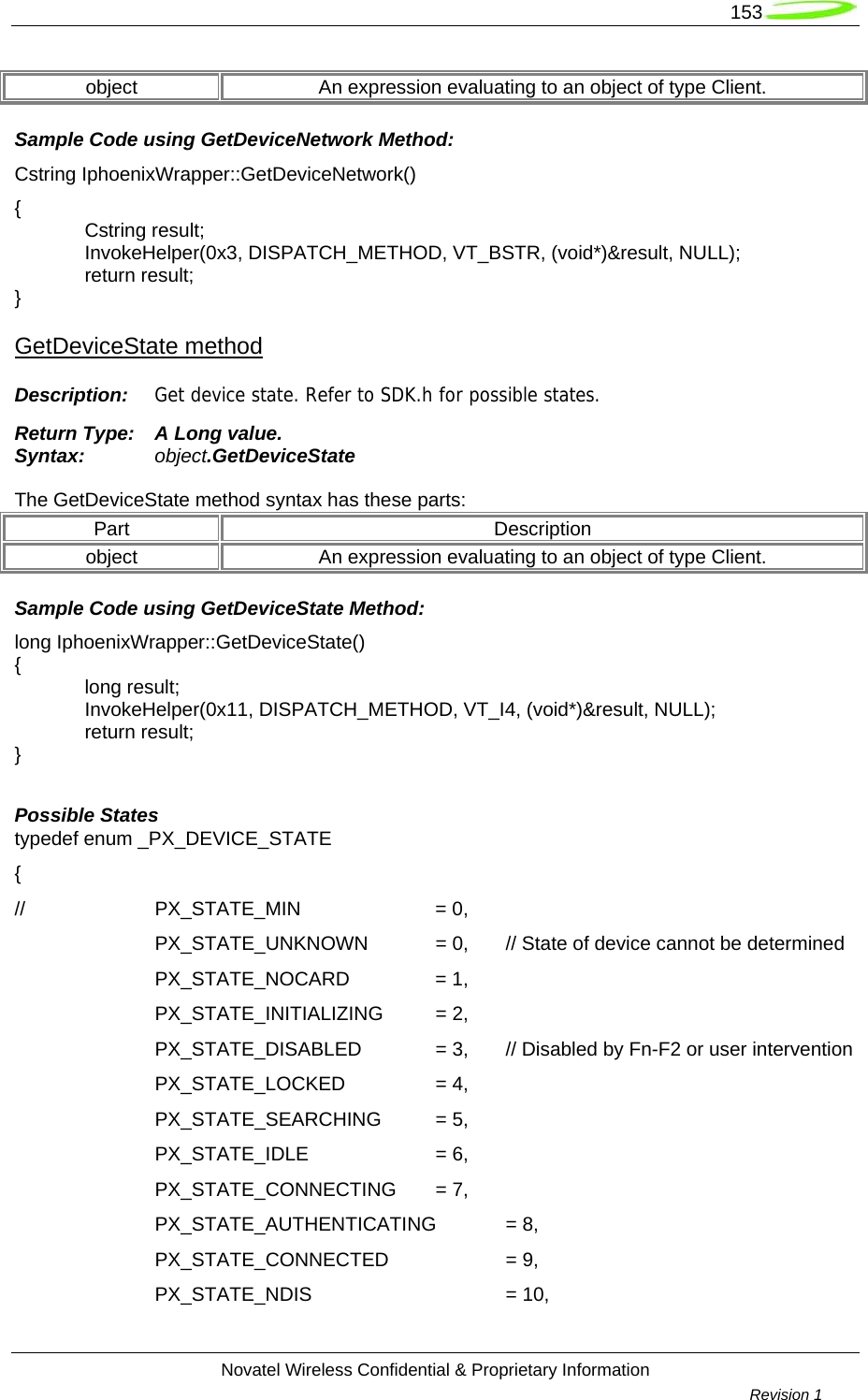
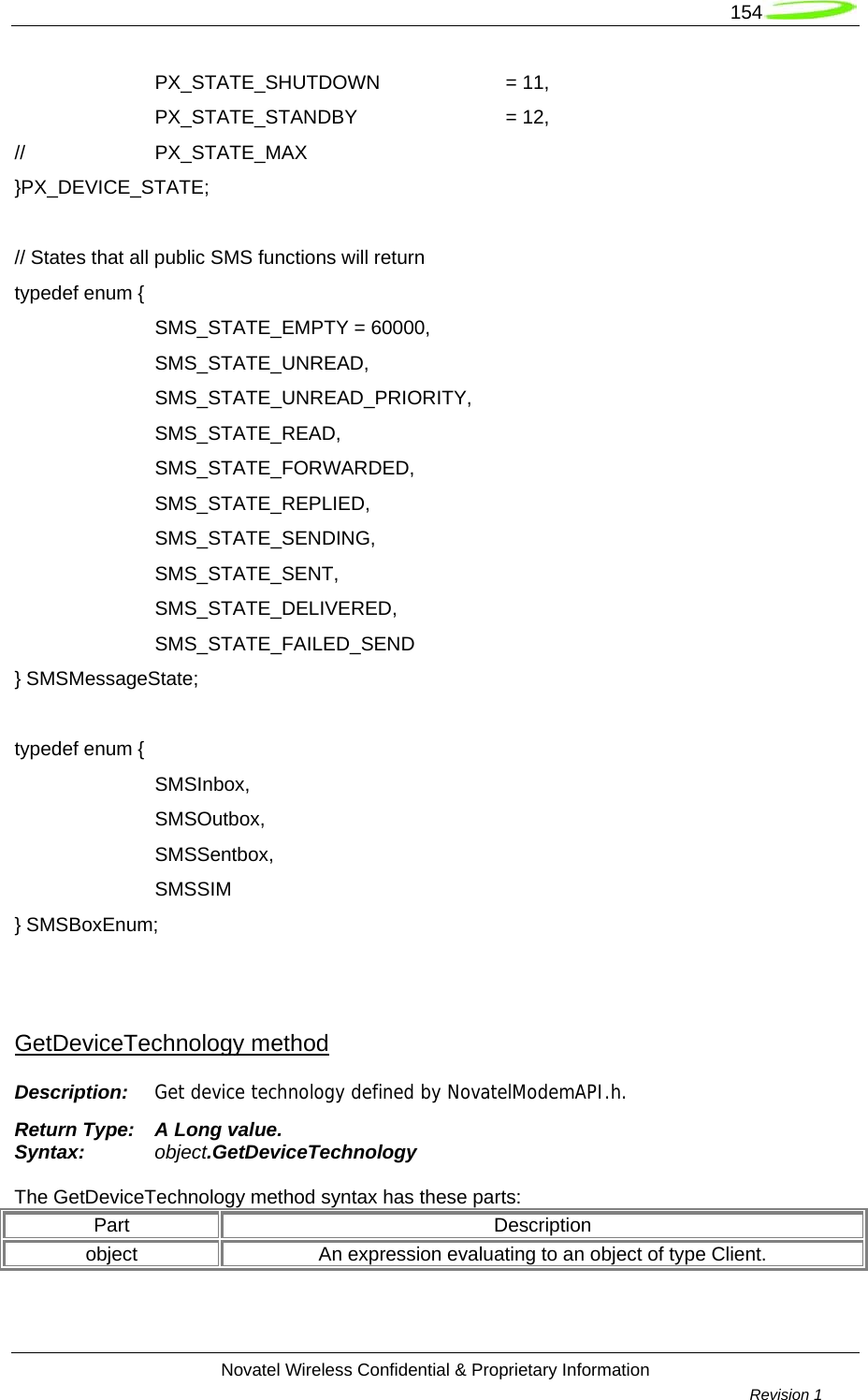
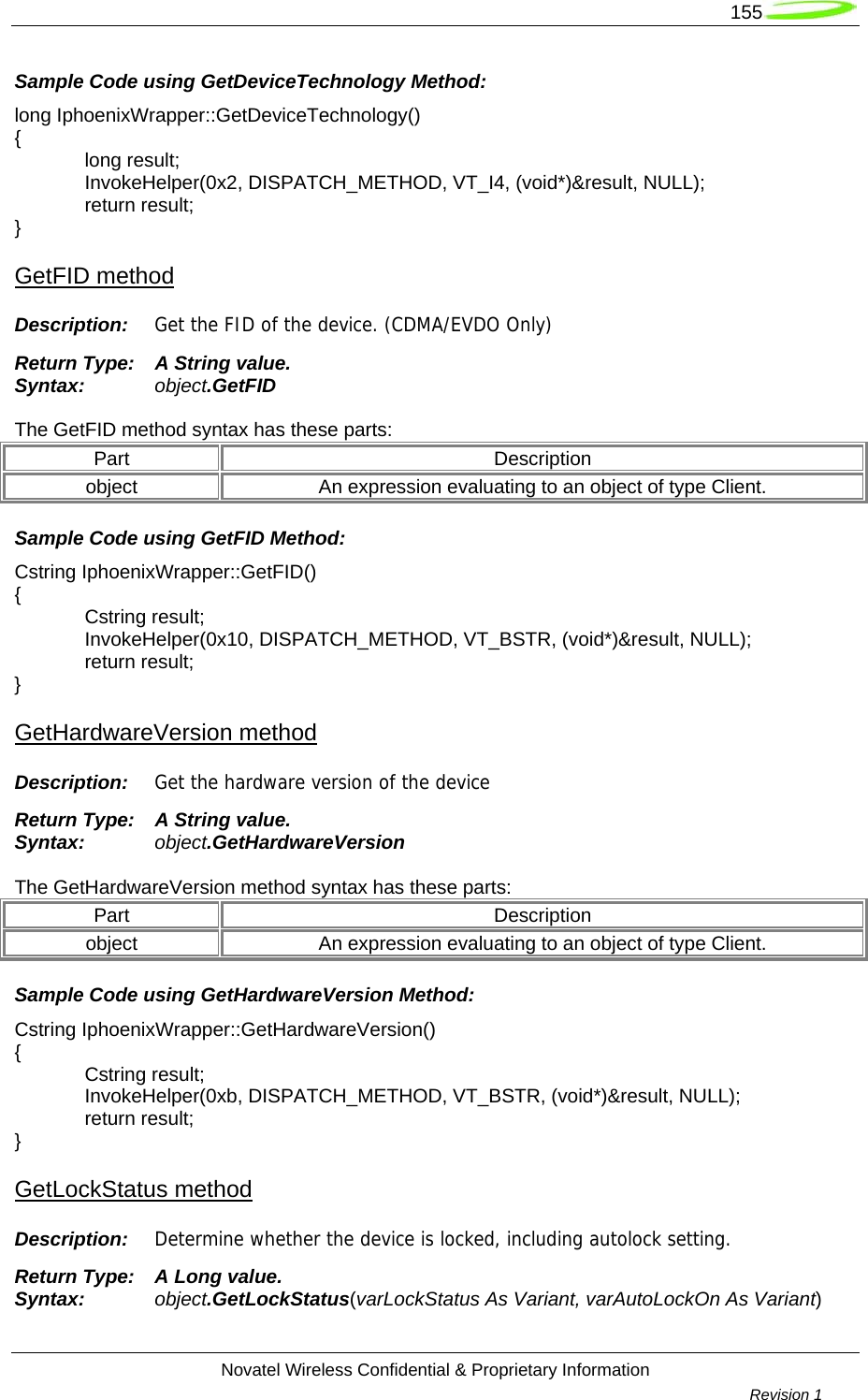
![156 Novatel Wireless Confidential & Proprietary Information Revision 1 The GetLockStatus method syntax has these parts: Part Description object An expression evaluating to an object of type Client. varLockStatus Variant varAutoLockOn Variant Sample Code using GetLockStatus Method: long IphoenixWrapper::GetLockStatus(VARIANT* varLockStatus, VARIANT* varAutoLockOn) { long result; static BYTE parms[] = VTS_PVARIANT VTS_PVARIANT; InvokeHelper(0x17, DISPATCH_METHOD, VT_I4, (void*)&result, parms, varLockStatus, varAutoLockOn); return result; } GetMessage method Description: Retrieve message given which message box and an index. Return Type: A Long value. Syntax: object.GetMessage(nMsgBoxEnum As Long, nIndex As Long, varState As Variant, varMsg As Variant, nMsgSize As Long) The GetMessage method syntax has these parts: Part Description object An expression evaluating to an object of type Client. nMsgBoxEnum Long nIndex Long varState Variant varMsg Variant nMsgSize Long Sample Code using GetMessage Method: long IphoenixWrapper::GetMessage(long nMsgBoxEnum, long nIndex, VARIANT* varState, VARIANT* varMsg, long nMsgSize) { long result; static BYTE parms[] = VTS_I4 VTS_I4 VTS_PVARIANT VTS_PVARIANT VTS_I4; InvokeHelper(0x20, DISPATCH_METHOD, VT_I4, (void*)&result, parms, nMsgBoxEnum, nIndex, varState, varMsg, nMsgSize); return result; } GetMessageCount method Description: Get current count given which message box.](https://usermanual.wiki/Novatel-Wireless/NRM-EU860D.Part-2/User-Guide-754579-Page-36.png)
![157 Novatel Wireless Confidential & Proprietary Information Revision 1 Return Type: A Long value. Syntax: object.GetMessageCount(nMsgBoxEnum As Long) The GetMessageCount method syntax has these parts: Part Description object An expression evaluating to an object of type Client. nMsgBoxEnum Long Sample Code using GetMessageCount Method: long IphoenixWrapper::GetMessageCount(long nMsgBoxEnum) { long result; static BYTE parms[] = VTS_I4; InvokeHelper(0x24, DISPATCH_METHOD, VT_I4, (void*)&result, parms, nMsgBoxEnum); return result; } GetMessageStatus method Description: Get a message status. Refer to SDK.h for possible states. Return Type: A Long value. Syntax: object.GetMessageStatus(nMsgBoxEnum As Long, nIndex As Long, varState As Variant) The GetMessageStatus method syntax has these parts: Part Description object An expression evaluating to an object of type Client. nMsgBoxEnum Long nIndex Long varState Variant Sample Code using GetMessageStatus Method: long IphoenixWrapper::GetMessageStatus(long nMsgBoxEnum, long nIndex, VARIANT* varState) { long result; static BYTE parms[] = VTS_I4 VTS_I4 VTS_PVARIANT; InvokeHelper(0x22, DISPATCH_METHOD, VT_I4, (void*)&result, parms, nMsgBoxEnum, nIndex, varState); return result; } GetMobileNumber method Description: Get the mobile number (MDN) of the device. Return Type: A String value. Syntax: object.GetMobileNumber](https://usermanual.wiki/Novatel-Wireless/NRM-EU860D.Part-2/User-Guide-754579-Page-37.png)
![158 Novatel Wireless Confidential & Proprietary Information Revision 1 The GetMobileNumber method syntax has these parts: Part Description object An expression evaluating to an object of type Client. Sample Code using GeMobileNumber Method: Cstring IphoenixWrapper::GetMobileNumber() { Cstring result; InvokeHelper(0xd, DISPATCH_METHOD, VT_BSTR, (void*)&result, NULL); return result; } GetNetworkOperatorList method Description: Get a list of operators. (UMTS/HSDPA Only) Return Type: A Long value. Syntax: object.GetNetworkOperatorList(varOperatorList As Variant) The GetNetworkOperatorList method syntax has these parts: Part Description object An expression evaluating to an object of type Client. varOperatorList Variant Sample Code using GetNetworkOperatorList Method: long IPhoenixWrapper::GetNetworkOperatorList(VARIANT* varOperatorList) { long result; static BYTE parms[] = VTS_PVARIANT; InvokeHelper(0x1a, DISPATCH_METHOD, VT_I4, (void*)&result, parms, varOperatorList); return result; } GetNetworkPreference method Description: Get network mode: RAT_MODE_AUTO (0), RAT_MODE_GSM (1), RAT_MODE_WCDMA (2) (UMTS/HSDPA Only) Return Type: A Long value. Syntax: object.GetNetworkPreference(varMode As Variant) The GetNetworkPreference method syntax has these parts: Part Description object An expression evaluating to an object of type Client.](https://usermanual.wiki/Novatel-Wireless/NRM-EU860D.Part-2/User-Guide-754579-Page-38.png)
![159 Novatel Wireless Confidential & Proprietary Information Revision 1 varMode Variant Sample Code using GetNetworkPreference Method: long IPhoenixWrapper::GetNetworkPreference(VARIANT* varMode) { long result; static BYTE parms[] = VTS_PVARIANT; InvokeHelper(0x2d, DISPATCH_METHOD, VT_I4, (void*)&result, parms, varMode); return result; } GetNewMessageCount method Description: Get new message count. Return Type: A Long value. Syntax: object.GetNewMessageCount The GetNewMessageCount method syntax has these parts: Part Description object An expression evaluating to an object of type Client. Sample Code using GetNewMessageCount Method: long IPhoenixWrapper::GetNewMessageCount() { long result; InvokeHelper(0x1f, DISPATCH_METHOD, VT_I4, (void*)&result, NULL); return result; } GetOSVersionInfo method Description: Get the OS versioning info. Return Type: A Long value. Syntax: object.GetOSVersionInfo(varMajorVersion As Variant, varMinorVersion As Variant, varCSDVersion As Variant) The GetOSVersionInfo method syntax has these parts: Part Description object An expression evaluating to an object of type Client. varMajorVersion Variant varMinorVersion Variant varCSDVersion Variant](https://usermanual.wiki/Novatel-Wireless/NRM-EU860D.Part-2/User-Guide-754579-Page-39.png)
![160 Novatel Wireless Confidential & Proprietary Information Revision 1 Sample Code using GetOSVersionInfo Method: long IPhoenixWrapper::GetOSVersionInfo(VARIANT* varMajorVersion, VARIANT* varMinorVersion, VARIANT* varCSDVersion) { long result; static BYTE parms[] = VTS_PVARIANT VTS_PVARIANT VTS_PVARIANT; InvokeHelper(0x9, DISPATCH_METHOD, VT_I4, (void*)&result, parms, varMajorVersion, varMinorVersion, varCSDVersion); return result; } CString IPhoenixWrapper::GetSoftwareVersion() { CString result; InvokeHelper(0xa, DISPATCH_METHOD, VT_BSTR, (void*)&result, NULL); return result; } GetPRLVersion method Description: Get the PRL version of the device. (CDMA/EVDO Only) Return Type: A String value. Syntax: object.GetPRLVersion The GetPRLVersion method syntax has these parts: Part Description object An expression evaluating to an object of type Client. Sample Code: CString IphoenixWrapper::GetPRLVersion() { Cstring result; InvokeHelper(0xf, DISPATCH_METHOD, VT_BSTR, (void*)&result, NULL); return result; GetRasErrorString method Description: Pass a RAS error code and get a RAS error string. Return Type: A String value. Syntax: object.GetRasErrorString(nErrorCode As Long) The GetRasErrorString method syntax has these parts: Part Description object An expression evaluating to an object of type Client. nErrorCode Long Sample Code using GetRasErrorString Method: CString IPhoenixWrapper::GetRasErrorString(long nErrorCode)](https://usermanual.wiki/Novatel-Wireless/NRM-EU860D.Part-2/User-Guide-754579-Page-40.png)
![161 Novatel Wireless Confidential & Proprietary Information Revision 1 { CString result; static BYTE parms[] = VTS_I4; InvokeHelper(0x1, DISPATCH_METHOD, VT_BSTR, (void*)&result, parms, nErrorCode); return result; } GetSigStr method Description: Get Signal Strength. Values: 0 – 5 Return Type: A Long value. Syntax: object.GetSigStr The GetSigStr method syntax has these parts: Part Description object An expression evaluating to an object of type Client. Sample Code using GetSigStr Method: long IPhoenixWrapper::GetSigStr() { long result; InvokeHelper(0x4, DISPATCH_METHOD, VT_I4, (void*)&result, NULL); return result; } GetSoftwareVersion method Description: Get the software (firmware) version of the device. Return Type: A String value. Syntax: object.GetSoftwareVersion The GetSoftwareVersion method syntax has these parts: Part Description object An expression evaluating to an object of type Client. Sample Code using GetSoftwareVersion Method: CString IPhoenixWrapper::GetSoftwareVersion() { CString result; InvokeHelper(0xa, DISPATCH_METHOD, VT_BSTR, (void*)&result, NULL); return result; }](https://usermanual.wiki/Novatel-Wireless/NRM-EU860D.Part-2/User-Guide-754579-Page-41.png)
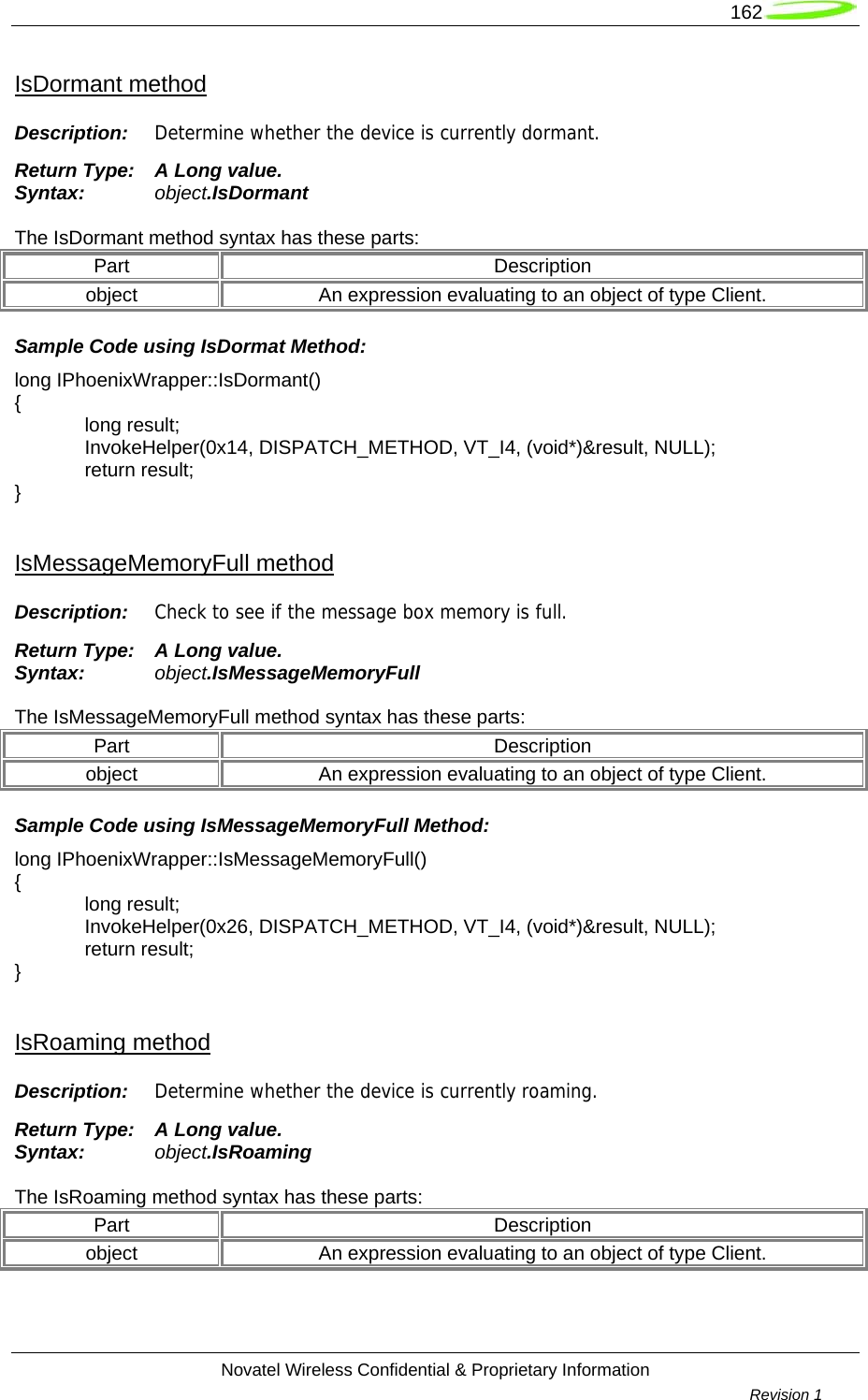
![163 Novatel Wireless Confidential & Proprietary Information Revision 1 Sample Code using IsRoaming Method: long IPhoenixWrapper::IsRoaming() { long result; InvokeHelper(0x13, DISPATCH_METHOD, VT_I4, (void*)&result, NULL); return result; } SendMessage method Description: To send a message. Return Type: A Long value. Syntax: object.SendMessage(varMsg As Variant, nMsgSize As Long, varMsgIndex As Variant) The SendMessage method syntax has these parts: Part Description object An expression evaluating to an object of type Client. varMsg Variant nMsgSize Long varMsgIndex Variant Sample Code using SendMessage Method: long IPhoenixWrapper::SendMessage(VARIANT* varMsg, long nMsgSize, VARIANT* varMsgIndex) { long result; static BYTE parms[] = VTS_PVARIANT VTS_I4 VTS_PVARIANT; InvokeHelper(0x25, DISPATCH_METHOD, VT_I4, (void*)&result, parms, varMsg, nMsgSize, varMsgIndex); return result; } SetAdapter method Description: To select a new active device. Syntax: object.SetAdapter(lpszAdapter As String) The SetAdapter method syntax has these parts: Part Description object An expression evaluating to an object of type Client. lpszAdapter String Sample Code using SetAdapter Method: void IPhoenixWrapper::SetAdapter(LPCTSTR lpszAdapter) { static BYTE parms[] = VTS_BSTR;](https://usermanual.wiki/Novatel-Wireless/NRM-EU860D.Part-2/User-Guide-754579-Page-43.png)
![164 Novatel Wireless Confidential & Proprietary Information Revision 1 InvokeHelper(0x1c, DISPATCH_METHOD, VT_EMPTY, NULL, parms, lpszAdapter); } SetAutoLock method Description: To turn ON or OFF the autolock setting. Return Type: A Long value. Syntax: object.SetAutoLock(nAutoOn As Long, lpszLockCode As String) The SetAutoLock method syntax has these parts: Part Description object An expression evaluating to an object of type Client. nAutoOn Long lpszLockCode String Sample Code using SetAutoLock Method: long IPhoenixWrapper::SetAutoLock(long nAutoOn, LPCTSTR lpszLockCode) { long result; static BYTE parms[] = VTS_I4 VTS_BSTR; InvokeHelper(0x16, DISPATCH_METHOD, VT_I4, (void*)&result, parms, nAutoOn, lpszLockCode); return result; } SetCallSettings method Description: Set the call settings, including quality of service settings. (UMTS/HSDPA Only) Return Type: A Long value. Syntax: object.SetCallSettings(nPDPType As Long, lpszAPN As String, nPDPAddress As Long, lpdQoS As Object) The SetCallSettings method syntax has these parts: Part Description object An expression evaluating to an object of type Client. nPDPType Long lpszAPN String nPDPAddress Long lpdQoS Object Sample Code using SetCallSettings Method: long IPhoenixWrapper::SetCallSettings(long nPDPType, LPCTSTR lpszAPN, long nPDPAddress, LPDISPATCH lpdQoS) { long result; static BYTE parms[] =](https://usermanual.wiki/Novatel-Wireless/NRM-EU860D.Part-2/User-Guide-754579-Page-44.png)
![165 Novatel Wireless Confidential & Proprietary Information Revision 1 VTS_I4 VTS_BSTR VTS_I4 VTS_DISPATCH; InvokeHelper(0x12, DISPATCH_METHOD, VT_I4, (void*)&result, parms, nPDPType, lpszAPN, nPDPAddress, lpdQoS); return result; } SetContact method Description: Set the contact’s name and details by index. Return Type: A Long value. Syntax: object.SetContact(nIndex As Long, lpszContactName As String, lpszContactDetails As String) The SetContact method syntax has these parts: Part Description object An expression evaluating to an object of type Client. nIndex Long lpszContactName String lpszContactDetails String Sample Code using SetContact Method: long IPhoenixWrapper::SetContact(long nIndex, LPCTSTR lpszContactName, LPCTSTR lpszContactDetails) { long result; static BYTE parms[] = VTS_I4 VTS_BSTR VTS_BSTR; InvokeHelper(0x29, DISPATCH_METHOD, VT_I4, (void*)&result, parms, nIndex, lpszContactName, lpszContactDetails); return result; } SetMessageStatus method Description: Set the state of a message. Return Type: A Long value. Syntax: object.SetMessageStatus(nMsgBoxEnum As Long, nIndex As Long, nState As Long) The SetMessageStatus method syntax has these parts: Part Description object An expression evaluating to an object of type Client. nMsgBoxEnum Long nIndex Long nState Long](https://usermanual.wiki/Novatel-Wireless/NRM-EU860D.Part-2/User-Guide-754579-Page-45.png)
![166 Novatel Wireless Confidential & Proprietary Information Revision 1 Sample Code using SetMessageStatus Method: long IPhoenixWrapper::SetMessageStatus(long nMsgBoxEnum, long nIndex, long nState) { long result; static BYTE parms[] = VTS_I4 VTS_I4 VTS_I4; InvokeHelper(0x23, DISPATCH_METHOD, VT_I4, (void*)&result, parms, nMsgBoxEnum, nIndex, nState); return result; } SetNetworkOperator method Description: To set the network operator provided by GetNetworkOperatorList. (UMTS/HSDPA Only) Return Type: A Long value. Syntax: object.SetNetworkOperator(nMode As Long, nFormat As Long, lpszOperator As String) The SetNetworkOperator method syntax has these parts: Part Description object An expression evaluating to an object of type Client. nMode Long nFormat Long lpszOperator String Sample Code using SetNeworkOperator Method: long IPhoenixWrapper::SetNetworkOperator(long nMode, long nFormat, LPCTSTR lpszOperator) { long result; static BYTE parms[] = VTS_I4 VTS_I4 VTS_BSTR; InvokeHelper(0x19, DISPATCH_METHOD, VT_I4, (void*)&result, parms, nMode, nFormat, lpszOperator); return result; } SetNetworkPreference method Description: Set network mode: RAT_MODE_AUTO (0), RAT_MODE_GSM (1), RAT_MODE_WCDMA (2) (UMTS/HSDPA Only) Return Type: A Long value. Syntax: object.SetNetworkPreference(nMode As Long) The SetNetworkPreference method syntax has these parts: Part Description object An expression evaluating to an object of type Client.](https://usermanual.wiki/Novatel-Wireless/NRM-EU860D.Part-2/User-Guide-754579-Page-46.png)
![167 Novatel Wireless Confidential & Proprietary Information Revision 1 nMode Long Sample Code using SetNetworkPreference Method: long IPhoenixWrapper::SetNetworkPreference(long nMode) { long result; static BYTE parms[] = VTS_I4; InvokeHelper(0x2c, DISPATCH_METHOD, VT_I4, (void*)&result, parms, nMode); return result; } SetProxy method Description: Set proxy settings given a proxy IP address and port. Return Type: A Long value. Syntax: object.SetProxy(nProxy As Long, nPort As Long) The SetProxy method syntax has these parts: Part Description object An expression evaluating to an object of type Client. nProxy Long nPort Long Sample Code using SetProxy Method: long IPhoenixWrapper::SetProxy(long nProxy, long nPort) { long result; static BYTE parms[] = VTS_I4 VTS_I4; InvokeHelper(0x7, DISPATCH_METHOD, VT_I4, (void*)&result, parms, nProxy, nPort); return result; } SetSMSC method Description: Setting the SMSC is required for proper SMS functionality Return Type: A Long value. Syntax: object.SetSMSC(lpszSMSC As String) The SetSMSC method syntax has these parts: Part Description object An expression evaluating to an object of type Client. lpszSMSC String](https://usermanual.wiki/Novatel-Wireless/NRM-EU860D.Part-2/User-Guide-754579-Page-47.png)
![168 Novatel Wireless Confidential & Proprietary Information Revision 1 Sample Code using SetSMSC Method: long IPhoenixWrapper::SetSMSC(LPCTSTR lpszSMSC) { long result; static BYTE parms[] = VTS_BSTR; InvokeHelper(0x2a, DISPATCH_METHOD, VT_I4, (void*)&result, parms, lpszSMSC); return result; } Shutdown method Description: A means of synchronously shutting down the device. Return Type: A Long value. Syntax: object.Shutdown The Shutdown method syntax has these parts: Part Description object An expression evaluating to an object of type Client. Sample Code using Shutdown Method: long IPhoenixWrapper::Shutdown() { long result; InvokeHelper(0x2b, DISPATCH_METHOD, VT_I4, (void*)&result, NULL); return result; } Unlock method Description: To unlock the device. Refer to NovatelModemAPI.h for possible lock types. Return Type: A Long value. Syntax: object.Unlock(nLockType As Long, lpszLockCode As String) The Unlock method syntax has these parts: Part Description object An expression evaluating to an object of type Client. nLockType Long lpszLockCode String Sample Code using Unlock Method: long IPhoenixWrapper::Unlock(long nLockType, LPCTSTR lpszLockCode) { long result; static BYTE parms[] = VTS_I4 VTS_BSTR; InvokeHelper(0x15, DISPATCH_METHOD, VT_I4, (void*)&result, parms,](https://usermanual.wiki/Novatel-Wireless/NRM-EU860D.Part-2/User-Guide-754579-Page-48.png)
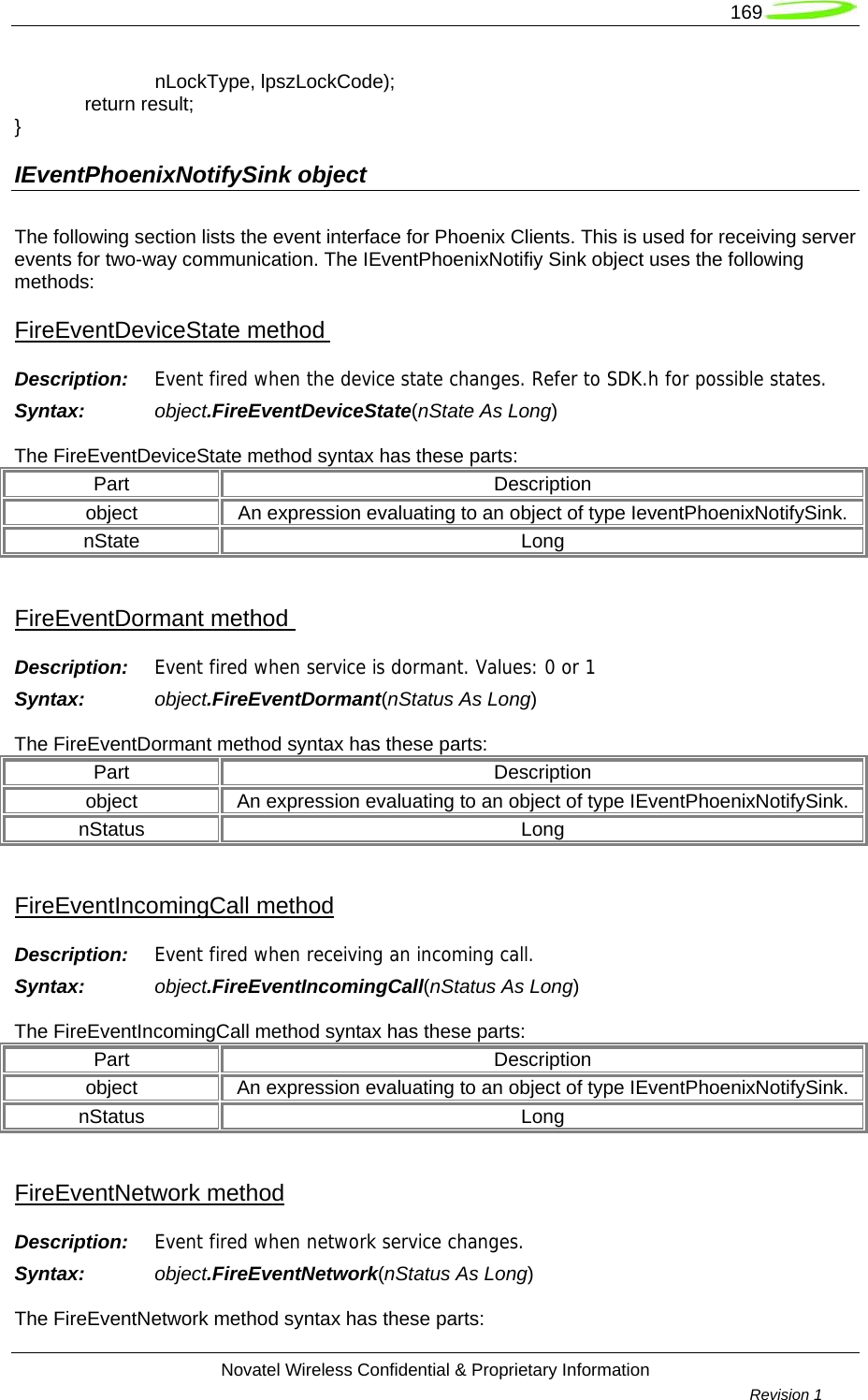
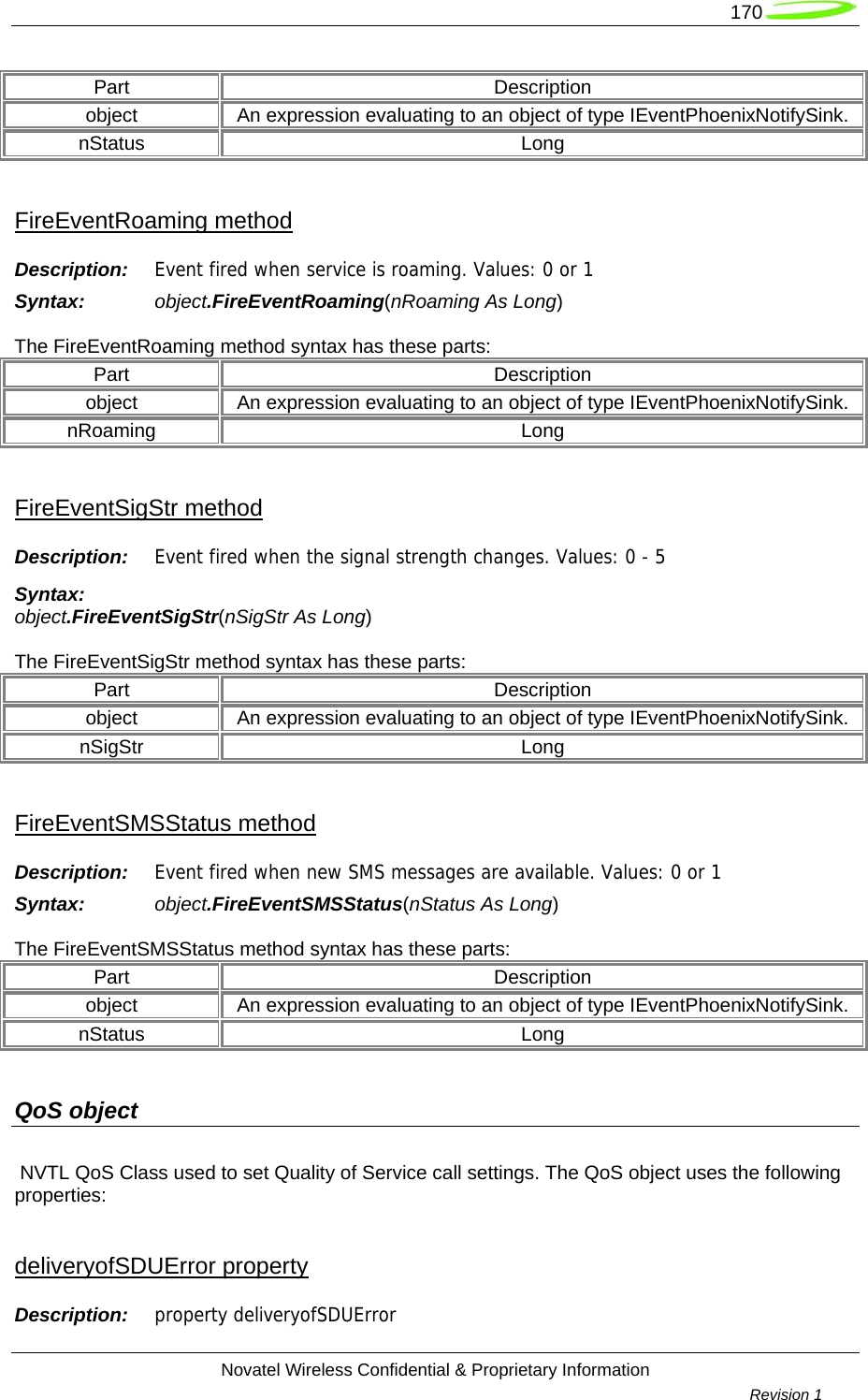
![171 Novatel Wireless Confidential & Proprietary Information Revision 1 Property type: A Long value. Syntax: object.deliveryofSDUError [= value] The deliveryofSDUError property syntax has these parts: Part Description object An expression evaluating to an object of type Qos. value A Long value. deliveryOrder property Description: property deliveryOrder Property type: A Long value. Syntax: object.deliveryOrder [= value] The deliveryOrder property syntax has these parts: Part Description Object An expression evaluating to an object of type Qos. Value A Long value. guarBitDL property Description: property guarBitDL Property type: A Long value. Syntax: object.guarBitDL [= value] The guarBitDL property syntax has these parts: Part Description Object An expression evaluating to an object of type Qos. Value A Long value. guarBitUL property Description: property guarBitUL Property type: A Long value. Syntax: object.guarBitUL [= value] The guarBitUL property syntax has these parts: Part Description Object An expression evaluating to an object of type Qos. Value A Long value. maxBitDL property Description: property maxBitDL](https://usermanual.wiki/Novatel-Wireless/NRM-EU860D.Part-2/User-Guide-754579-Page-51.png)
![172 Novatel Wireless Confidential & Proprietary Information Revision 1 Property type: A Long value. Syntax: object.maxBitDL [= value] The maxBitDL property syntax has these parts: Part Description Object An expression evaluating to an object of type Qos. Value A Long value. maxBitUL property Description: property maxBitUL Property type: A Long value. Syntax: object.maxBitUL [= value] The maxBitUL property syntax has these parts: Part Description Object An expression evaluating to an object of type Qos. Value A Long value. maxSDUSize property Description: property maxSDUSize Property type: A Long value. Syntax: object.maxSDUSize [= value] The maxSDUSize property syntax has these parts: Part Description Object An expression evaluating to an object of type Qos. Value A Long value. ResBitErrorRatio property Description: property ResBitErrorRatio Property type: A String value. Syntax: object.ResBitErrorRatio [= value] The ResBitErrorRatio property syntax has these parts: Part Description Object An expression evaluating to an object of type Qos. Value A String value.](https://usermanual.wiki/Novatel-Wireless/NRM-EU860D.Part-2/User-Guide-754579-Page-52.png)
![173 Novatel Wireless Confidential & Proprietary Information Revision 1 SDUErrorRatio property Description: property SDUErrorRatio Property type: A String value. Syntax: object.SDUErrorRatio [= value] The SDUErrorRatio property syntax has these parts: Part Description Object An expression evaluating to an object of type Qos. Value A String value. trafficClass property Description: property trafficClass Property type: A Long value. Syntax: object.trafficClass [= value] The trafficClass property syntax has these parts: Part Description Object An expression evaluating to an object of type Qos. Value A Long value. trafficHandling property Description: property trafficHandling Property type: A Long value. Syntax: object.trafficHandling [= value] The trafficHandling property syntax has these parts: Part Description Object An expression evaluating to an object of type Qos. Value A Long value. transferDelay property Description: property transferDelay Property type: A Long value. Syntax: object.transferDelay [= value] The transferDelay property syntax has these parts: Part Description Object An expression evaluating to an object of type Qos. Value A Long value.](https://usermanual.wiki/Novatel-Wireless/NRM-EU860D.Part-2/User-Guide-754579-Page-53.png)
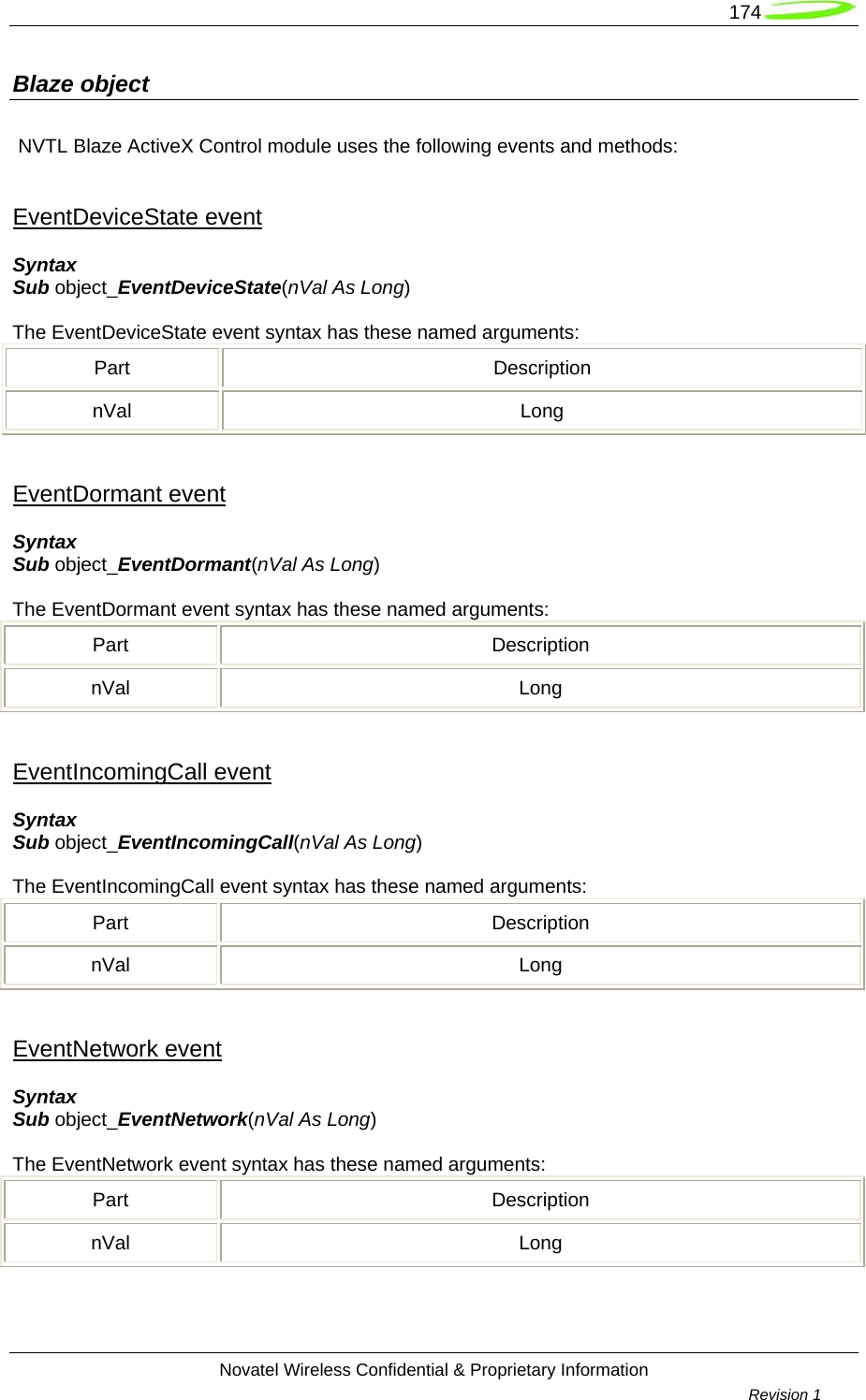
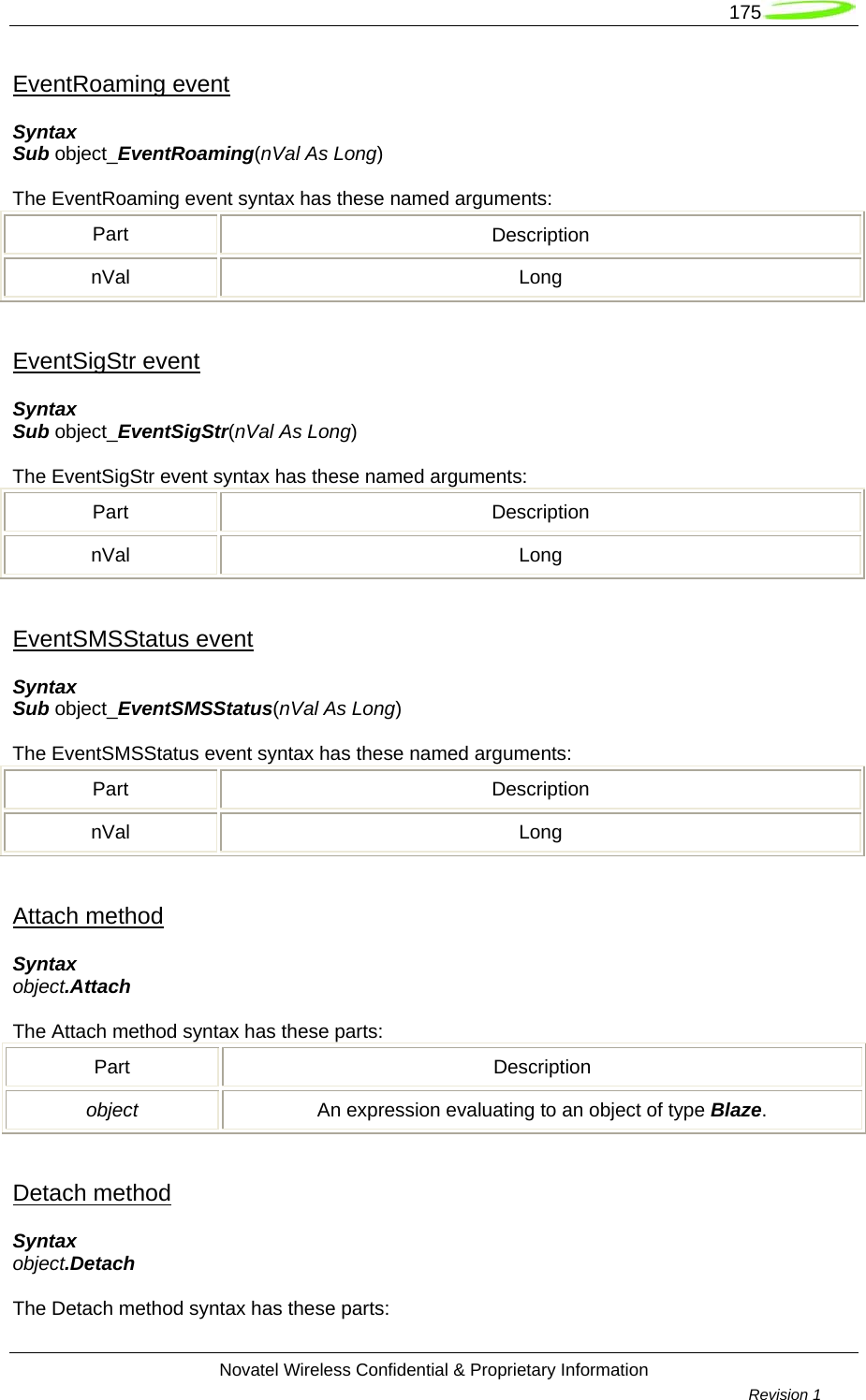
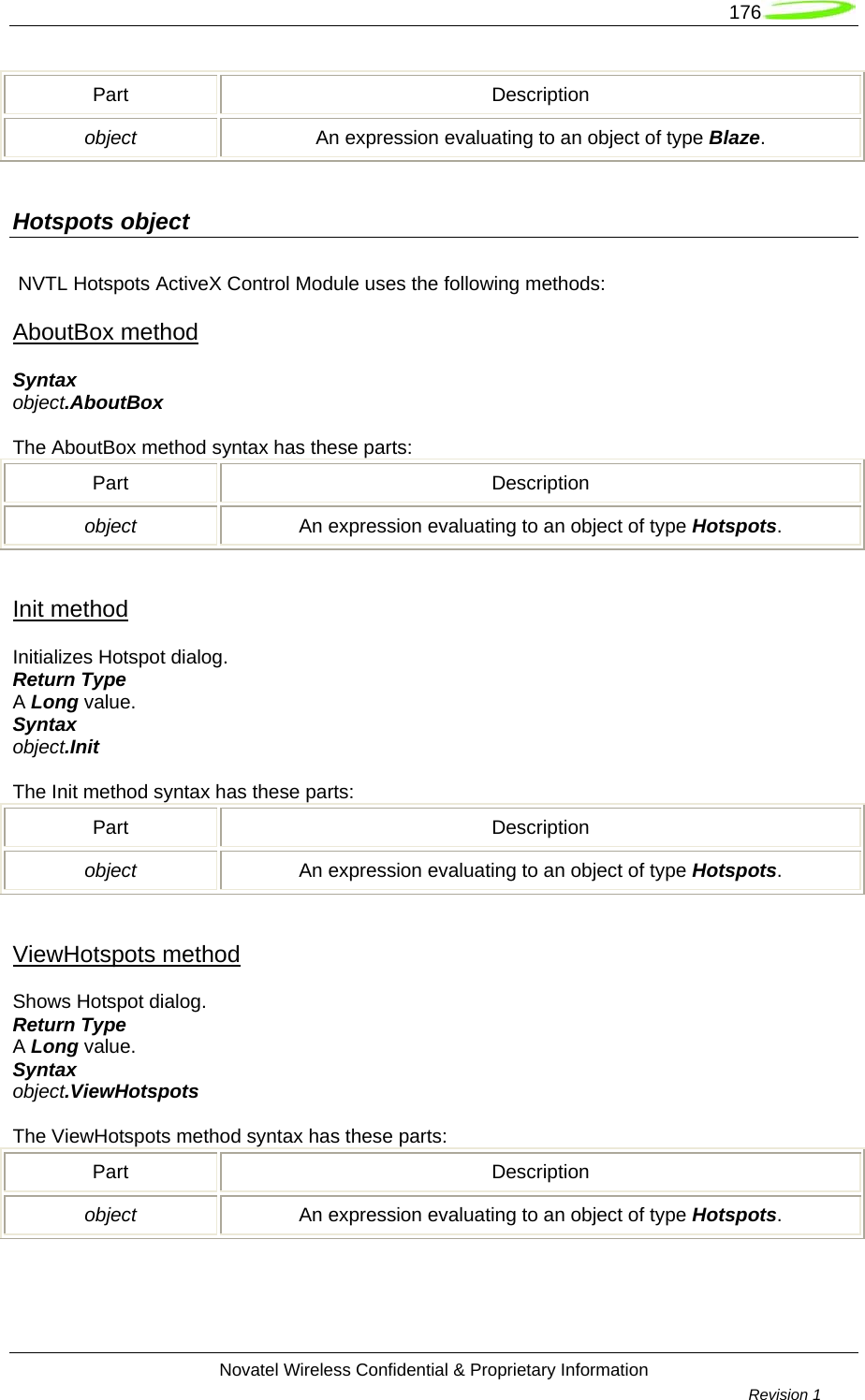
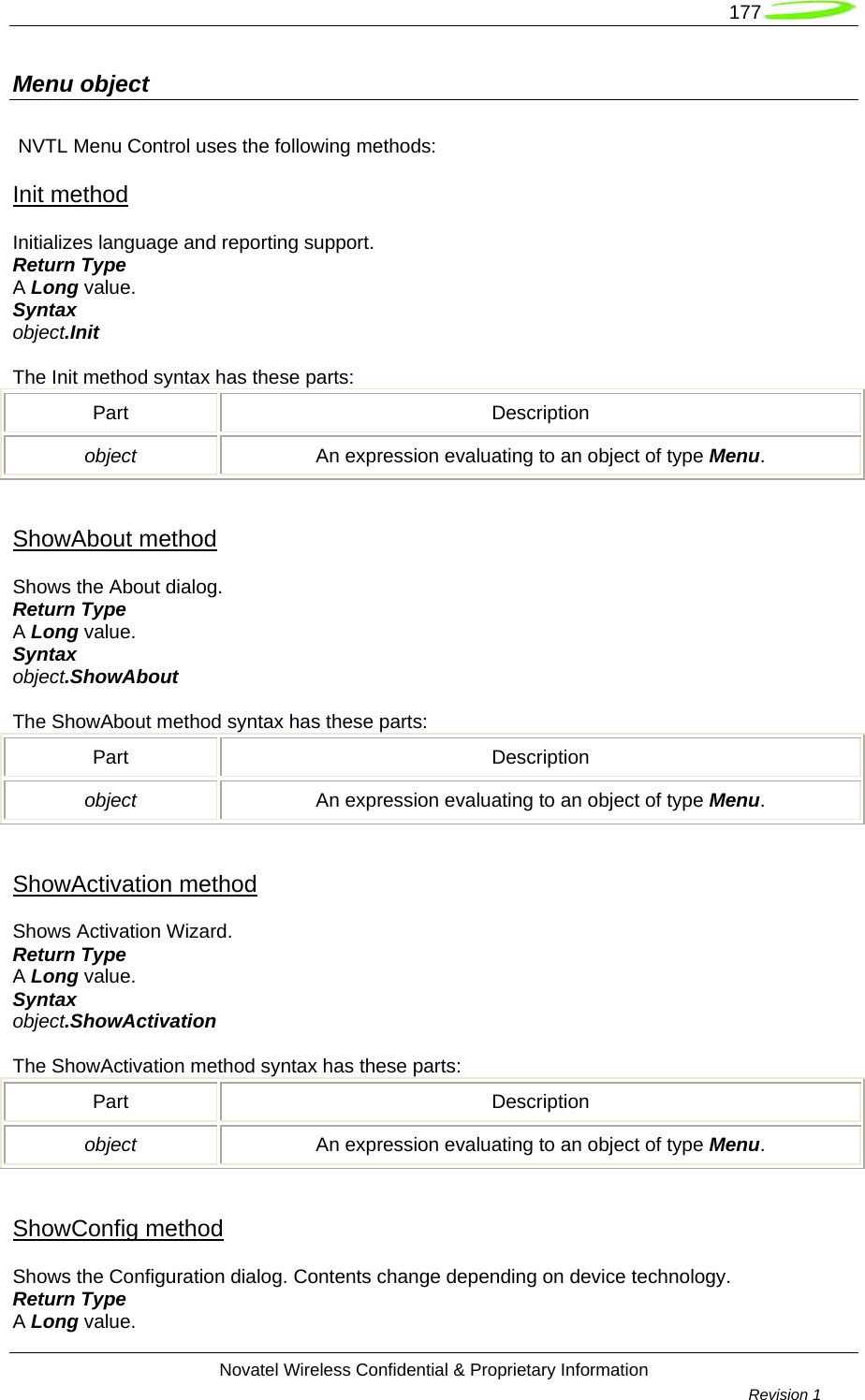
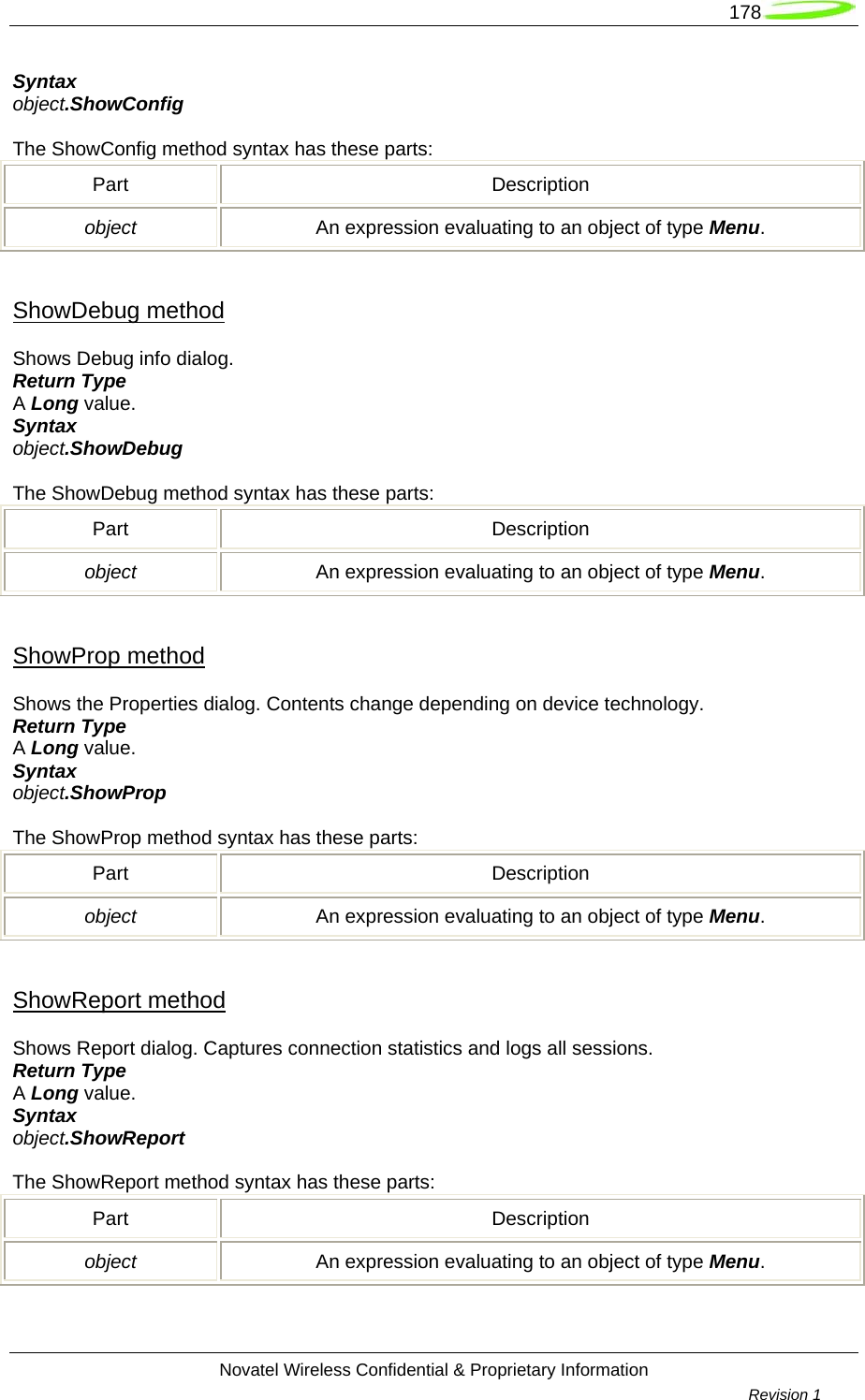
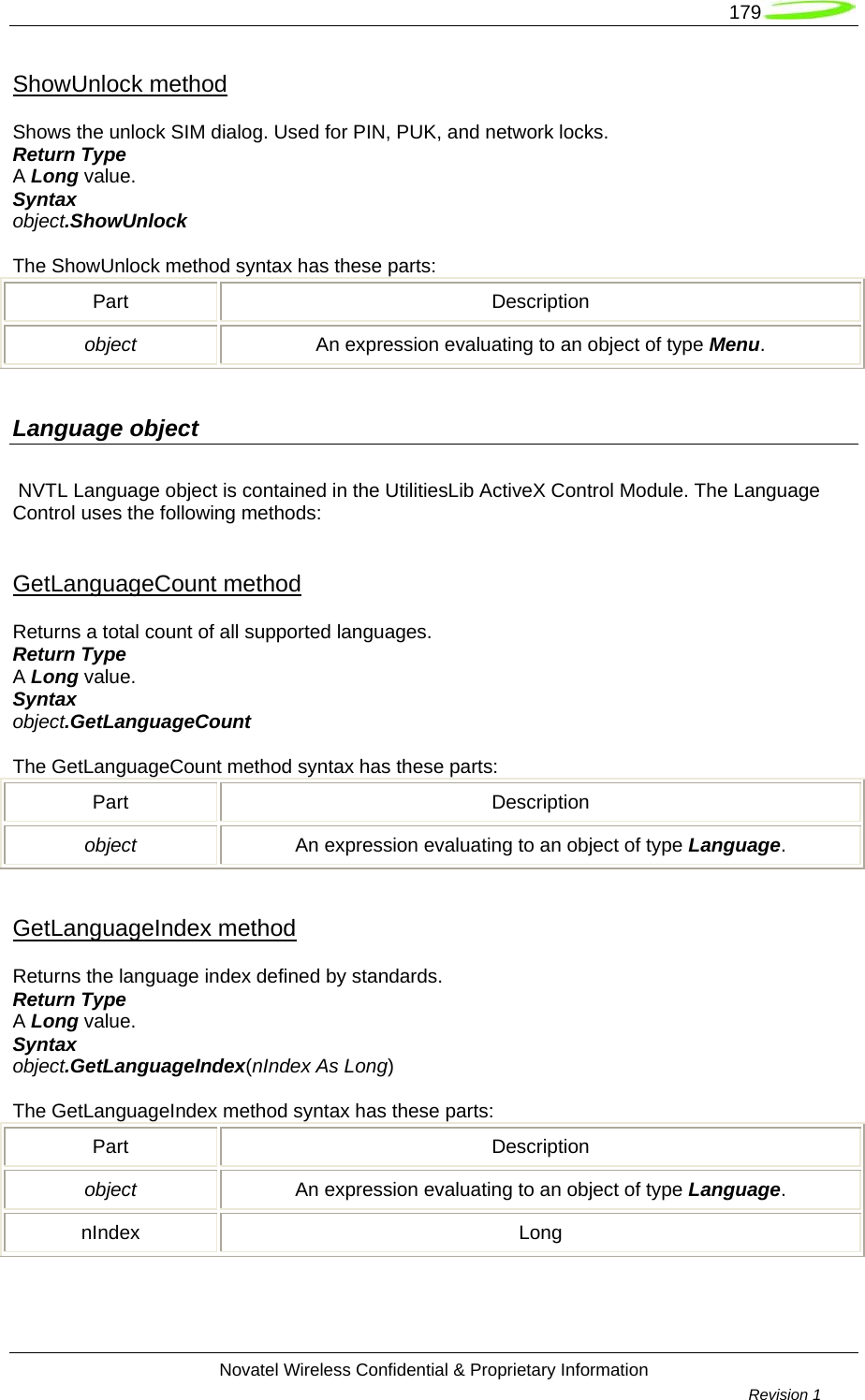
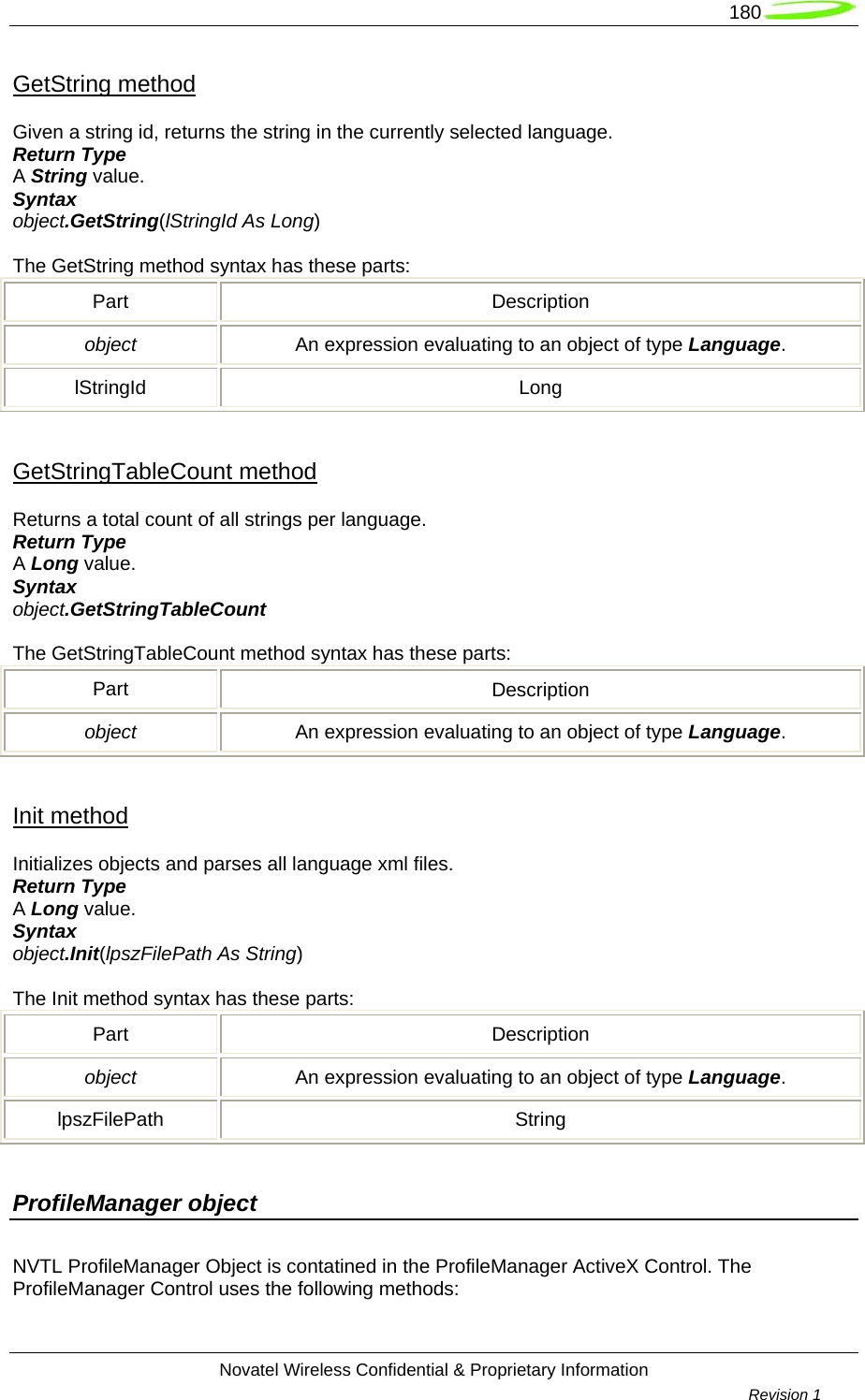
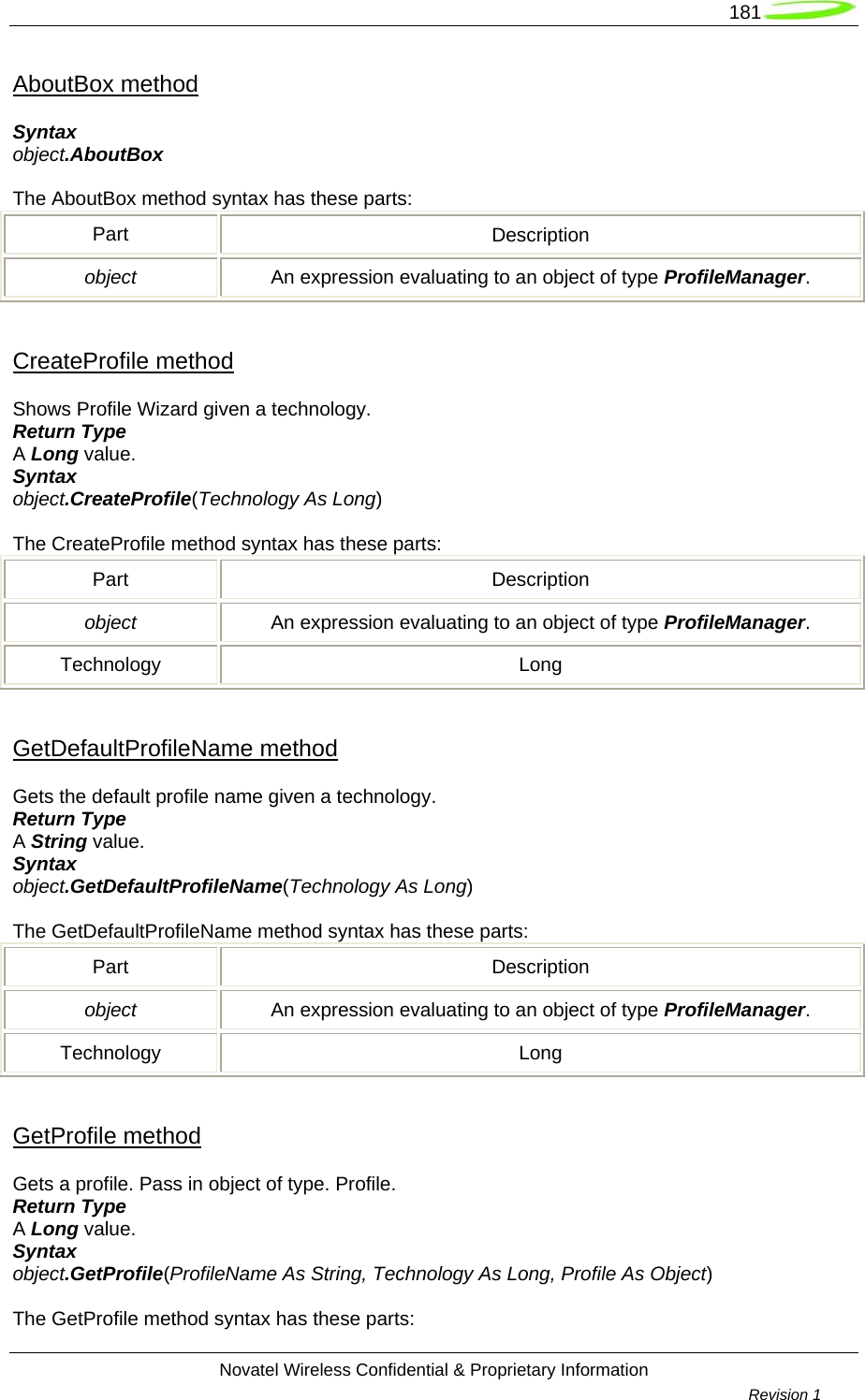
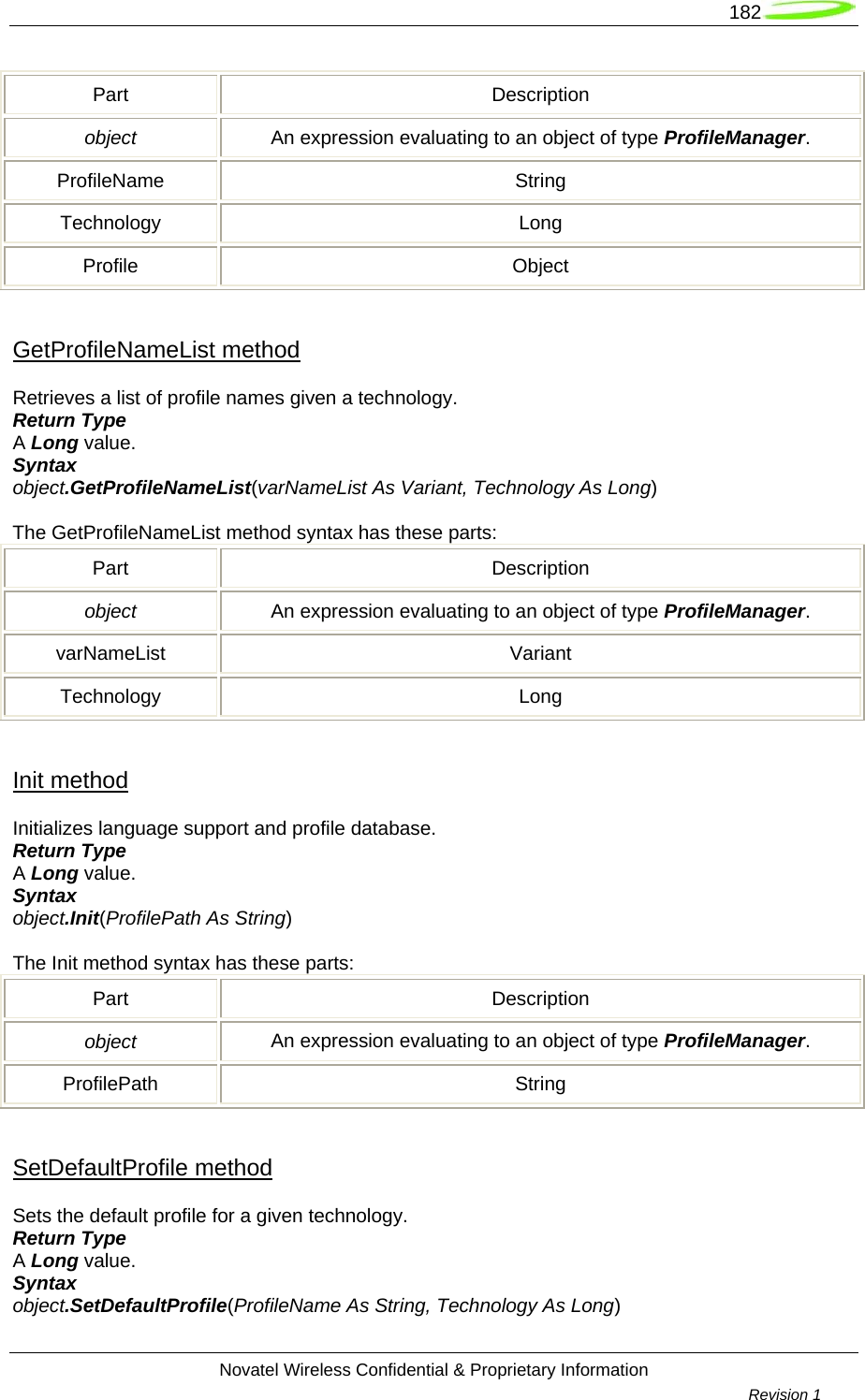
![183 Novatel Wireless Confidential & Proprietary Information Revision 1 The SetDefaultProfile method syntax has these parts: Part Description object An expression evaluating to an object of type ProfileManager. ProfileName String Technology Long ShowProfileList method Shows the Profile list dialog which includes Mobile, WiFi, and Ethernet. Return Type A Long value. Syntax object.ShowProfileList(Technology As Long) The ShowProfileList method syntax has these parts: Part Description object An expression evaluating to an object of type ProfileManager. Technology Long Profile object NVTL Profile Object is contatined in the ProfileManager ActiveX Control. The Profile Class has the following properties: APN property property APN Property type A String value. Syntax object.APN [= value] The APN property syntax has these parts: Part Description object An expression evaluating to an object of type Profile. value A String value. AuthenticationType property property AuthenticationType](https://usermanual.wiki/Novatel-Wireless/NRM-EU860D.Part-2/User-Guide-754579-Page-63.png)
![184 Novatel Wireless Confidential & Proprietary Information Revision 1 Property type A Long value. Syntax object.AuthenticationType [= value] The AuthenticationType property syntax has these parts: Part Description object An expression evaluating to an object of type Profile. value A Long value. CarrierName property property CarrierName Property type A String value. Syntax object.CarrierName [= value] The CarrierName property syntax has these parts: Part Description object An expression evaluating to an object of type Profile. value A String value. ConnectType property property ConnectType Property type A Long value. Syntax object.ConnectType [= value] The ConnectType property syntax has these parts: Part Description object An expression evaluating to an object of type Profile. value A Long value. DataSpeed property property DataSpeed Property type A Long value. Syntax object.DataSpeed [= value]](https://usermanual.wiki/Novatel-Wireless/NRM-EU860D.Part-2/User-Guide-754579-Page-64.png)
![185 Novatel Wireless Confidential & Proprietary Information Revision 1 The DataSpeed property syntax has these parts: Part Description object An expression evaluating to an object of type Profile. value A Long value. DefaultGateway property property DefaultGateway Property type A Long value. Syntax object.DefaultGateway [= value] The DefaultGateway property syntax has these parts: Part Description object An expression evaluating to an object of type Profile. value A Long value. DeliveryofSDUError property property DeliveryofSDUError Property type A Long value. Syntax object.DeliveryofSDUError [= value] The DeliveryofSDUError property syntax has these parts: Part Description object An expression evaluating to an object of type Profile. value A Long value. DeliveryOrder property property DeliveryOrder Property type A Long value. Syntax object.DeliveryOrder [= value] The DeliveryOrder property syntax has these parts: Part Description](https://usermanual.wiki/Novatel-Wireless/NRM-EU860D.Part-2/User-Guide-754579-Page-65.png)
![186 Novatel Wireless Confidential & Proprietary Information Revision 1 object An expression evaluating to an object of type Profile. value A Long value. DialString property property DialString Property type A String value. Syntax object.DialString [= value] The DialString property syntax has these parts: Part Description object An expression evaluating to an object of type Profile. value A String value. Fallback2GProfile property property Fallback2GProfile Property type A String value. Syntax object.Fallback2GProfile [= value] The Fallback2GProfile property syntax has these parts: Part Description object An expression evaluating to an object of type Profile. value A String value. IPAddress property property IPAddress Property type A Long value. Syntax object.IPAddress [= value] The IPAddress property syntax has these parts: Part Description object An expression evaluating to an object of type Profile.](https://usermanual.wiki/Novatel-Wireless/NRM-EU860D.Part-2/User-Guide-754579-Page-66.png)
![187 Novatel Wireless Confidential & Proprietary Information Revision 1 value A Long value. MaxSDUSize property property MaxSDUSize Property type A Long value. Syntax object.MaxSDUSize [= value] The MaxSDUSize property syntax has these parts: Part Description object An expression evaluating to an object of type Profile. value A Long value. Password property property Password Property type A String value. Syntax object.Password [= value] The Password property syntax has these parts: Part Description object An expression evaluating to an object of type Profile. value A String value. PDPAddress property property PDPAddress Property type A Long value. Syntax object.PDPAddress [= value] The PDPAddress property syntax has these parts: Part Description object An expression evaluating to an object of type Profile. value A Long value.](https://usermanual.wiki/Novatel-Wireless/NRM-EU860D.Part-2/User-Guide-754579-Page-67.png)
![188 Novatel Wireless Confidential & Proprietary Information Revision 1 PDPType property property PDPType Property type A Long value. Syntax object.PDPType [= value] The PDPType property syntax has these parts: Part Description object An expression evaluating to an object of type Profile. value A Long value. PrimaryDNS property property PrimaryDNS Property type A Long value. Syntax object.PrimaryDNS [= value] The PrimaryDNS property syntax has these parts: Part Description object An expression evaluating to an object of type Profile. value A Long value. PrimaryWINS property property PrimaryWINS Property type A Long value. Syntax object.PrimaryWINS [= value] The PrimaryWINS property syntax has these parts: Part Description object An expression evaluating to an object of type Profile. value A Long value. ProfileName property property ProfileName Property type](https://usermanual.wiki/Novatel-Wireless/NRM-EU860D.Part-2/User-Guide-754579-Page-68.png)
![189 Novatel Wireless Confidential & Proprietary Information Revision 1 A String value. Syntax object.ProfileName [= value] The ProfileName property syntax has these parts: Part Description object An expression evaluating to an object of type Profile. value A String value. ProxyAddress property property ProxyAddress Property type A Long value. Syntax object.ProxyAddress [= value] The ProxyAddress property syntax has these parts: Part Description object An expression evaluating to an object of type Profile. value A Long value. ProxyPort property property ProxyPort Property type A Long value. Syntax object.ProxyPort [= value] The ProxyPort property syntax has these parts: Part Description object An expression evaluating to an object of type Profile. value A Long value. ResErrorRatio property property ResErrorRatio Property type A String value. Syntax object.ResErrorRatio [= value]](https://usermanual.wiki/Novatel-Wireless/NRM-EU860D.Part-2/User-Guide-754579-Page-69.png)
![190 Novatel Wireless Confidential & Proprietary Information Revision 1 The ResErrorRatio property syntax has these parts: Part Description object An expression evaluating to an object of type Profile. value A String value. SDUErrorRatio property property SDUErrorRatio Property type A String value. Syntax object.SDUErrorRatio [= value] The SDUErrorRatio property syntax has these parts: Part Description object An expression evaluating to an object of type Profile. value A String value. SecondaryDNS property property SecondaryDNS Property type A Long value. Syntax object.SecondaryDNS [= value] The SecondaryDNS property syntax has these parts: Part Description object An expression evaluating to an object of type Profile. value A Long value. SecondaryWINS property property SecondaryWINS Property type A Long value. Syntax object.SecondaryWINS [= value] The SecondaryWINS property syntax has these parts: Part Description](https://usermanual.wiki/Novatel-Wireless/NRM-EU860D.Part-2/User-Guide-754579-Page-70.png)
![191 Novatel Wireless Confidential & Proprietary Information Revision 1 object An expression evaluating to an object of type Profile. value A Long value. SetProxy property property SetProxy Property type A Long value. Syntax object.SetProxy [= value] The SetProxy property syntax has these parts: Part Description object An expression evaluating to an object of type Profile. value A Long value. SMSC property property SMSC Property type A String value. Syntax object.SMSC [= value] The SMSC property syntax has these parts: Part Description object An expression evaluating to an object of type Profile. value A String value. SMSEmailNumber property property SMSEmailNumber Property type A String value. Syntax object.SMSEmailNumber [= value] The SMSEmailNumber property syntax has these parts: Part Description object An expression evaluating to an object of type Profile. value A String value.](https://usermanual.wiki/Novatel-Wireless/NRM-EU860D.Part-2/User-Guide-754579-Page-71.png)
![192 Novatel Wireless Confidential & Proprietary Information Revision 1 StaticIP property property StaticIP Property type A Long value. Syntax object.StaticIP [= value] The StaticIP property syntax has these parts: Part Description object An expression evaluating to an object of type Profile. value A Long value. SubnetMask property property SubnetMask Property type A Long value. Syntax object.SubnetMask [= value] The SubnetMask property syntax has these parts: Part Description object An expression evaluating to an object of type Profile. value A Long value. Technology property property Technology Property type A Long value. Syntax object.Technology [= value] The Technology property syntax has these parts: Part Description object An expression evaluating to an object of type Profile. value A Long value.](https://usermanual.wiki/Novatel-Wireless/NRM-EU860D.Part-2/User-Guide-754579-Page-72.png)
![193 Novatel Wireless Confidential & Proprietary Information Revision 1 TrafficClass property property TrafficClass Property type A Long value. Syntax object.TrafficClass [= value] The TrafficClass property syntax has these parts: Part Description object An expression evaluating to an object of type Profile. value A Long value. TrafficHandling property property TrafficHandling Property type A Long value. Syntax object.TrafficHandling [= value] The TrafficHandling property syntax has these parts: Part Description object An expression evaluating to an object of type Profile. value A Long value. TransferDelay property property TransferDelay Property type A Long value. Syntax object.TransferDelay [= value] The TransferDelay property syntax has these parts: Part Description object An expression evaluating to an object of type Profile. value A Long value. UseDNS property property UseDNS Property type](https://usermanual.wiki/Novatel-Wireless/NRM-EU860D.Part-2/User-Guide-754579-Page-73.png)
![194 Novatel Wireless Confidential & Proprietary Information Revision 1 A Long value. Syntax object.UseDNS [= value] The UseDNS property syntax has these parts: Part Description object An expression evaluating to an object of type Profile. value A Long value. Username property property Username Property type A String value. Syntax object.Username [= value] The Username property syntax has these parts: Part Description object An expression evaluating to an object of type Profile. value A String value. UseVPN property property UseVPN Property type A Long value. Syntax object.UseVPN [= value] The UseVPN property syntax has these parts: Part Description object An expression evaluating to an object of type Profile. value A Long value. UseWINS property property UseWINS Property type A Long value. Syntax object.UseWINS [= value]](https://usermanual.wiki/Novatel-Wireless/NRM-EU860D.Part-2/User-Guide-754579-Page-74.png)
![195 Novatel Wireless Confidential & Proprietary Information Revision 1 The UseWINS property syntax has these parts: Part Description object An expression evaluating to an object of type Profile. value A Long value. VPNEntryName property property VPNEntryName Property type A String value. Syntax object.VPNEntryName [= value] The VPNEntryName property syntax has these parts: Part Description object An expression evaluating to an object of type Profile. value A String value. NetMonkey Lib objects NVTL NetMonkey ActiveX Control Module Objects use the following events: EventAdapterFound event Event fired when interface detection state changes. Syntax Sub object_EventAdapterFound EventAdapterUpdate event Event fired when interface updated values are available. Syntax Sub object_EventAdapterUpdate LAN object NVTL LAN Object is contained in the NetMonkey ActiveX Control Module. The LAN Control uses the following methods: GetAdapter method Gets the currently selected interface from registry. Return Type](https://usermanual.wiki/Novatel-Wireless/NRM-EU860D.Part-2/User-Guide-754579-Page-75.png)
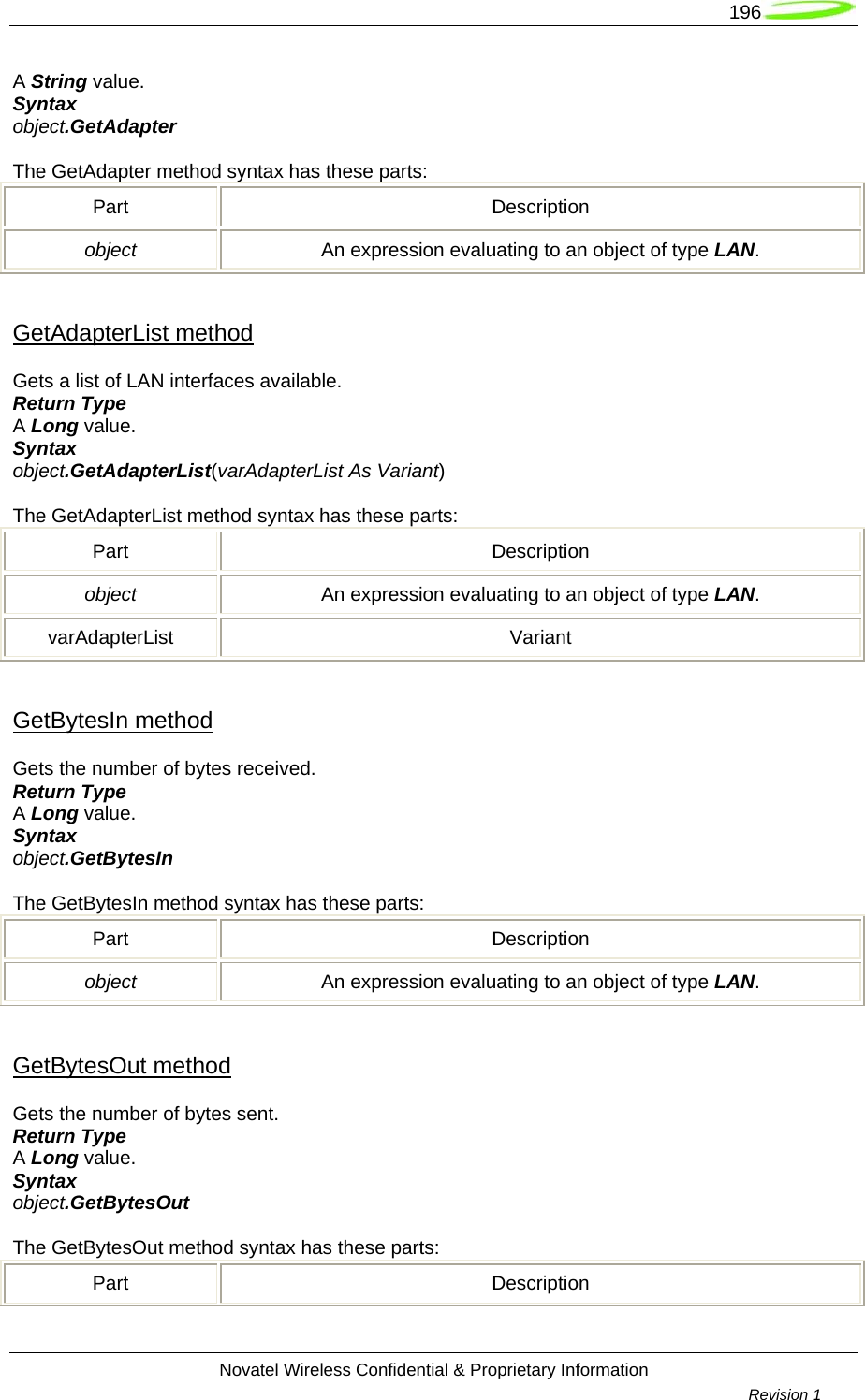
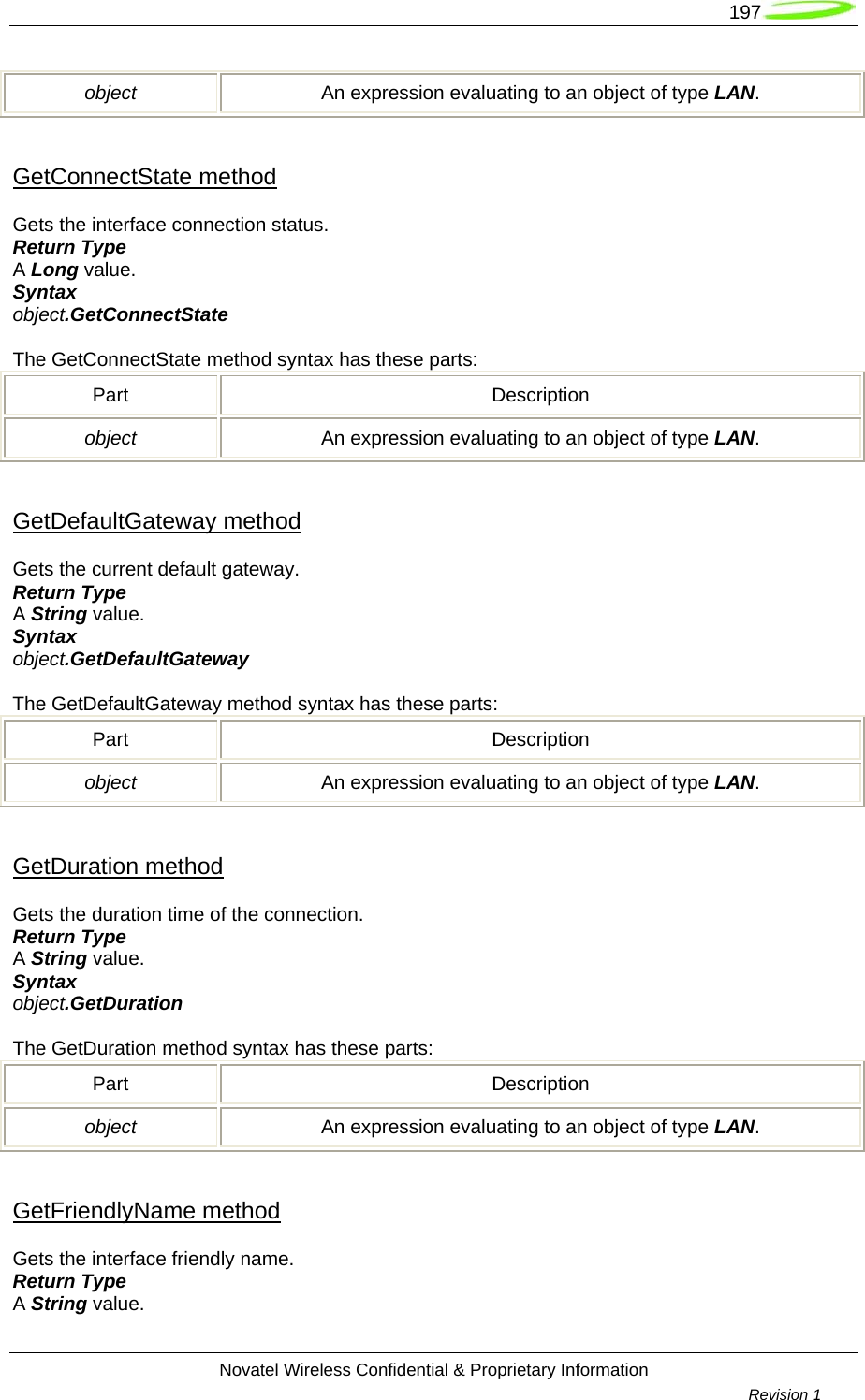
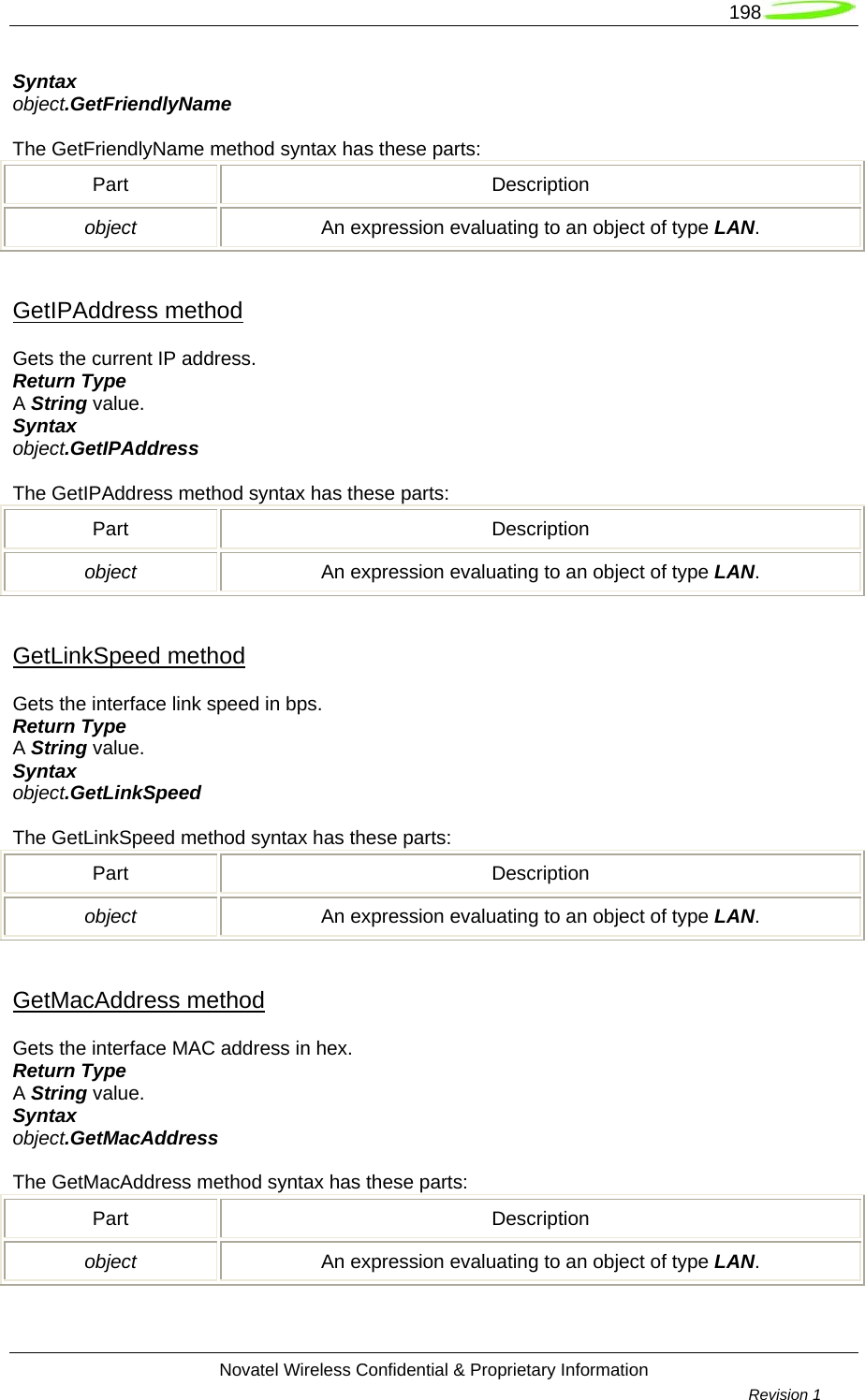
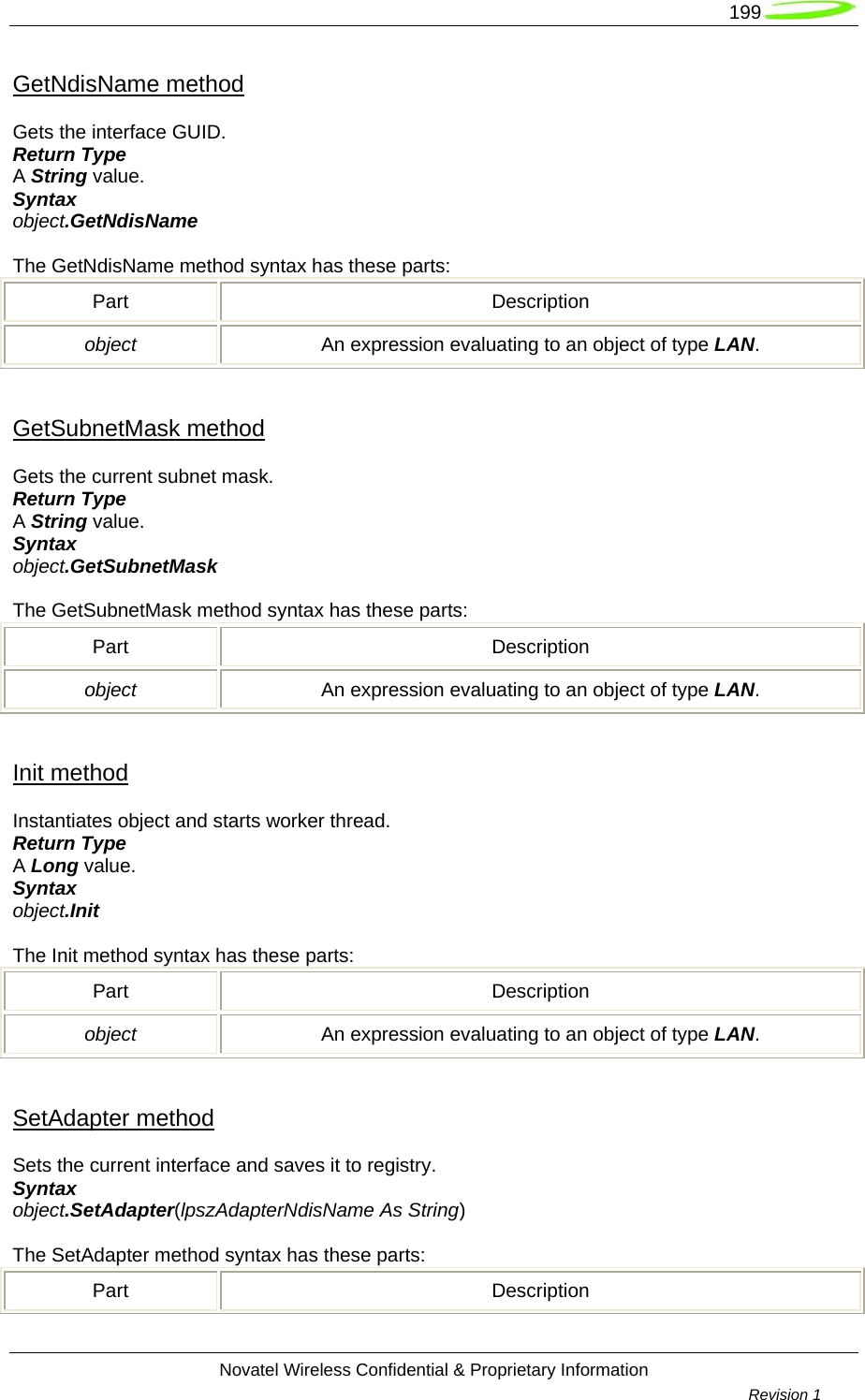
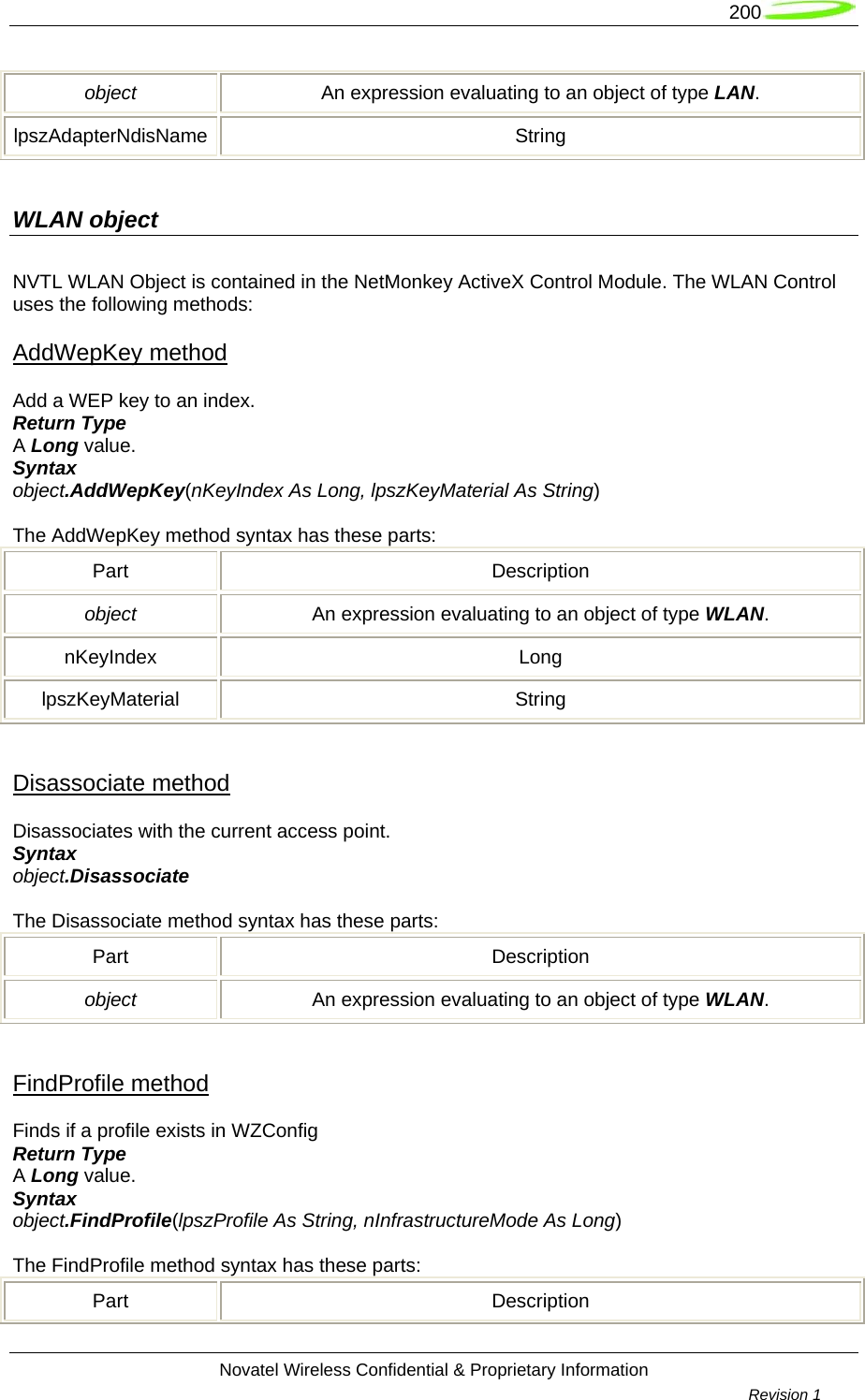
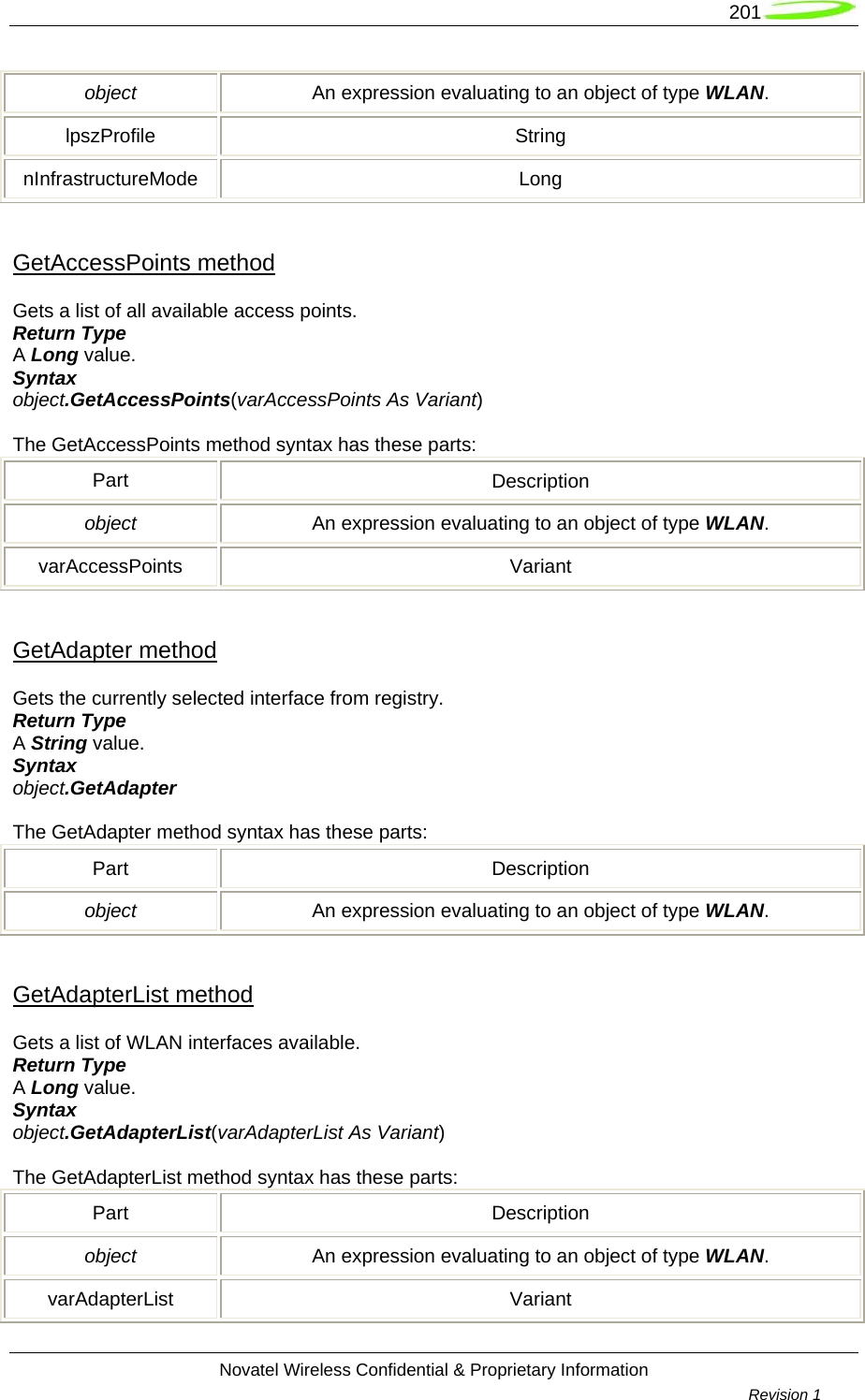
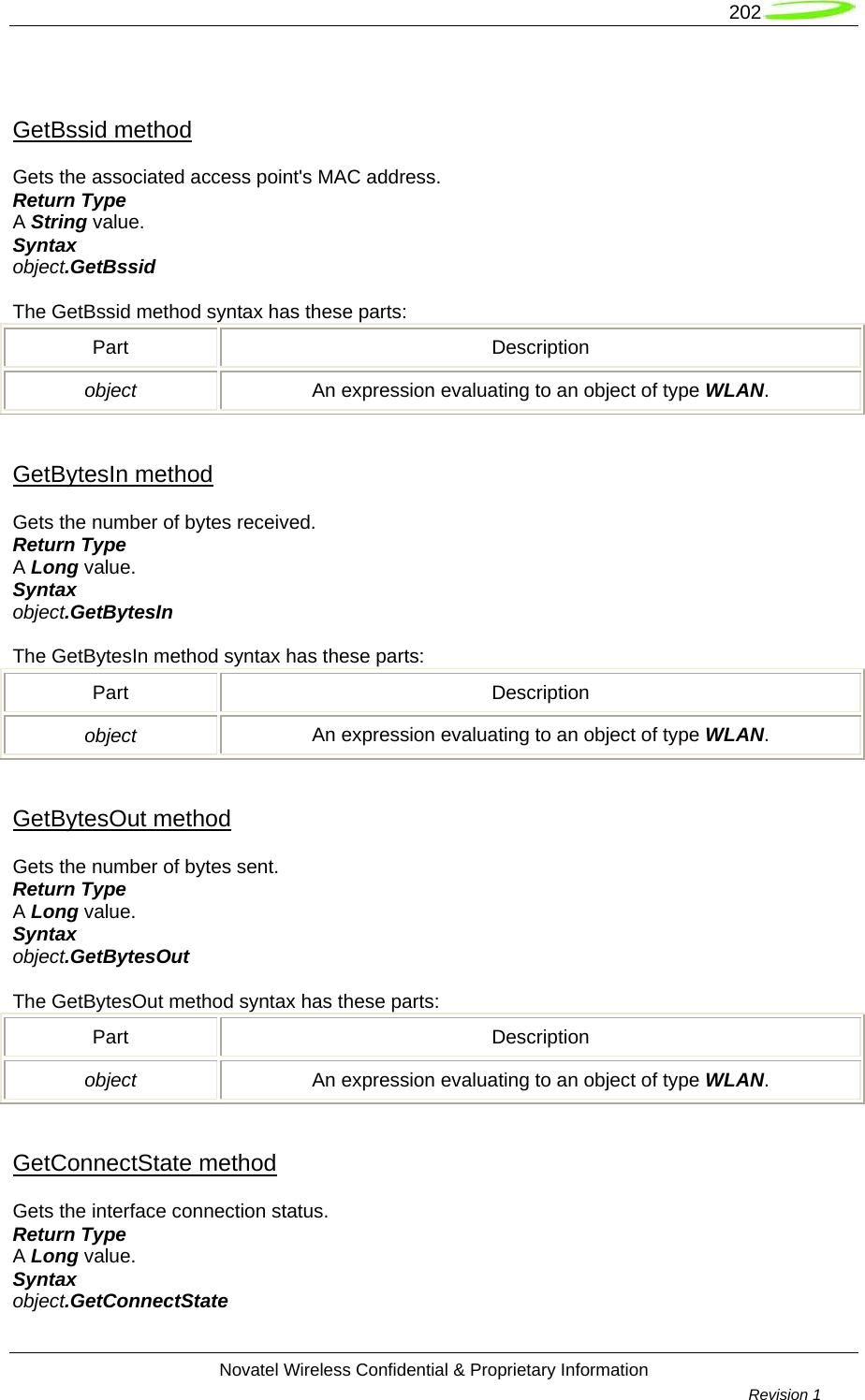
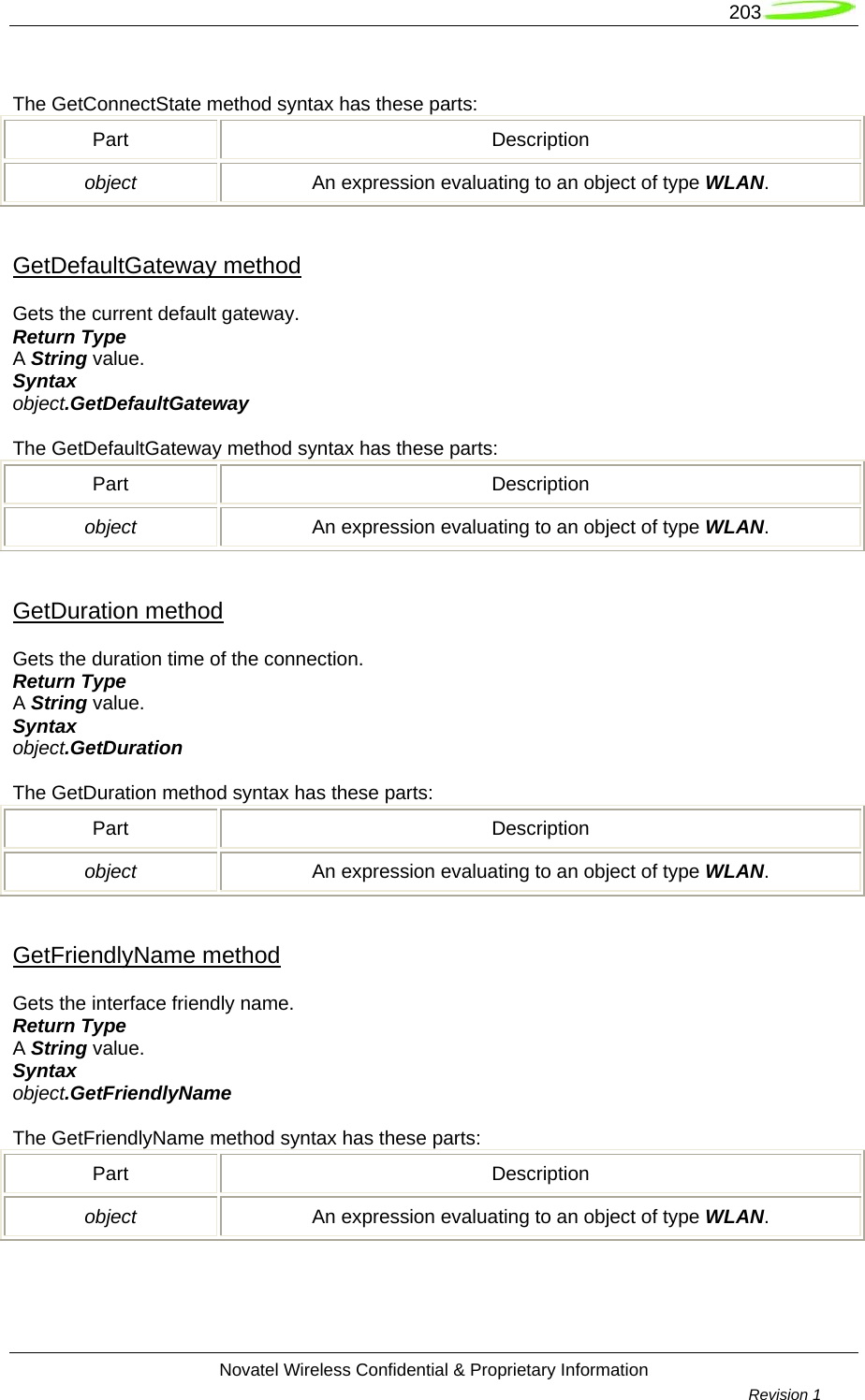
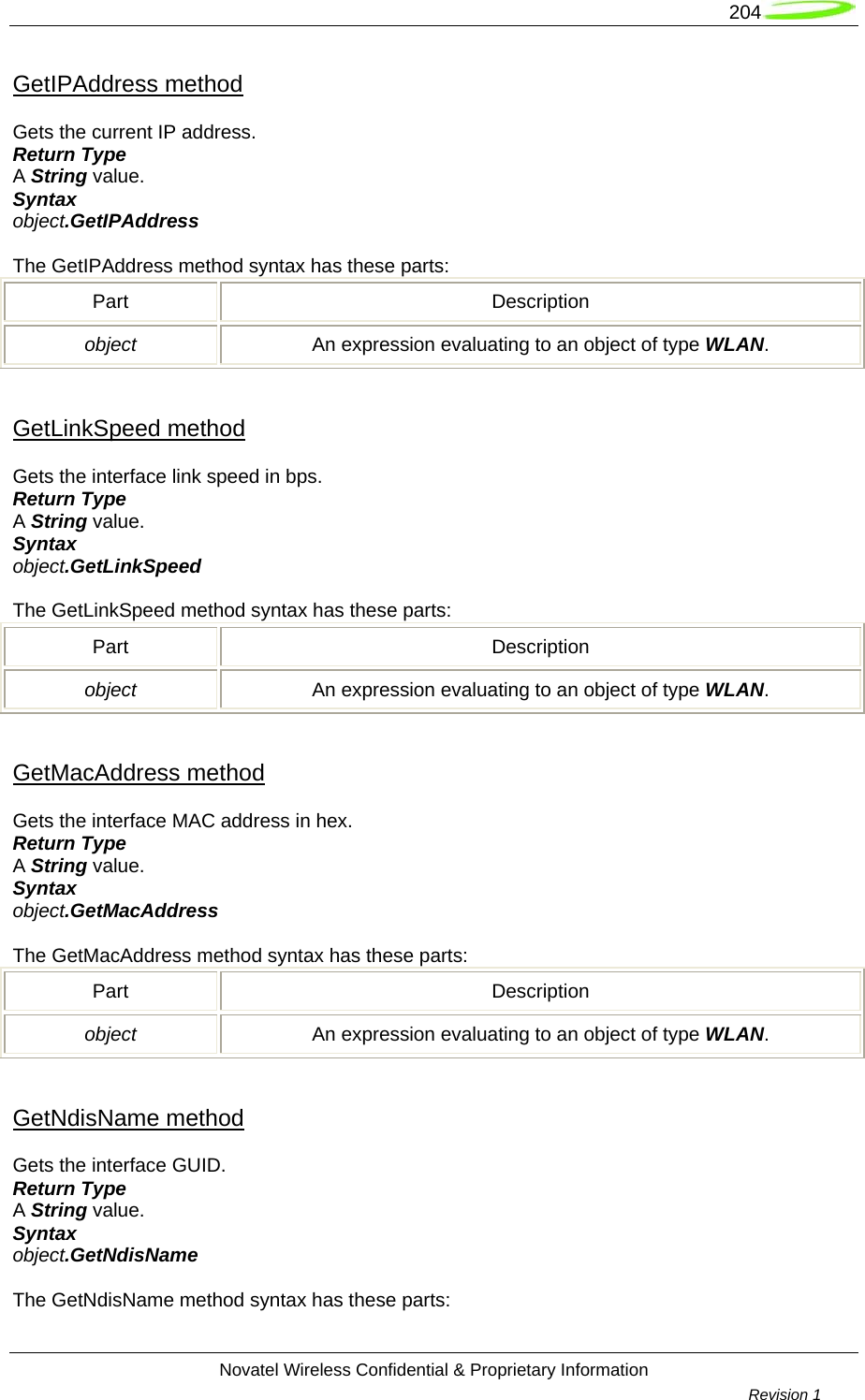
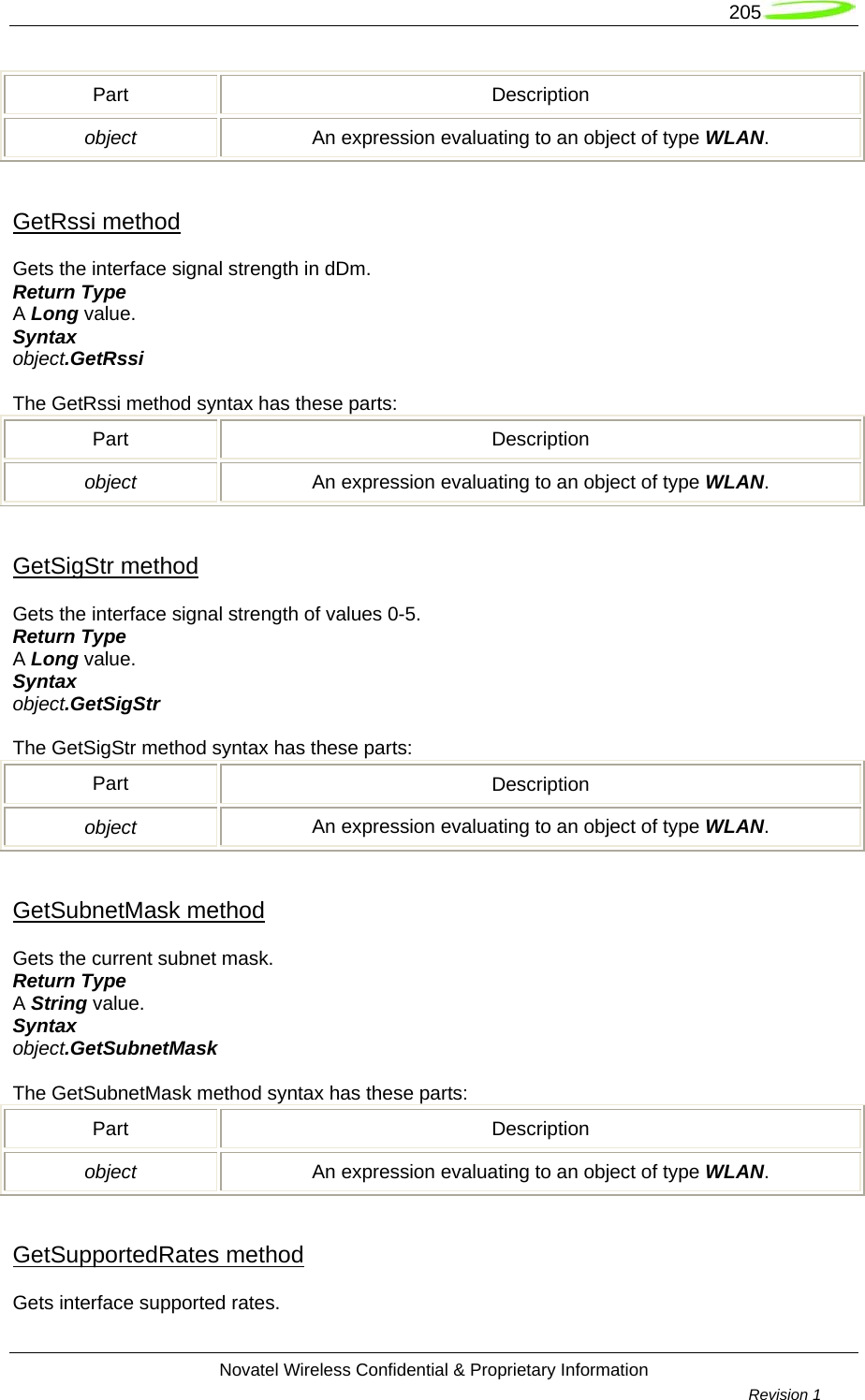
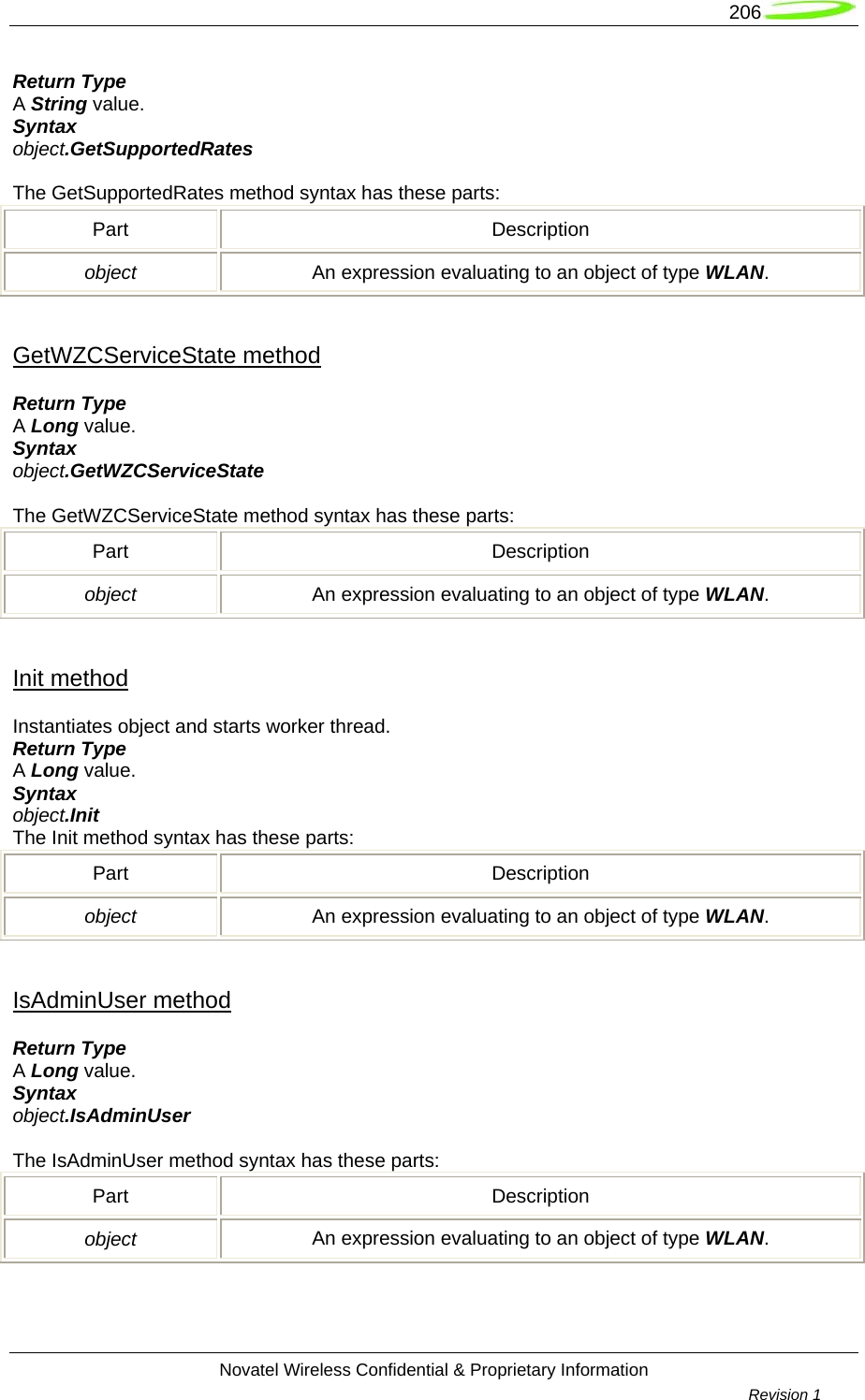
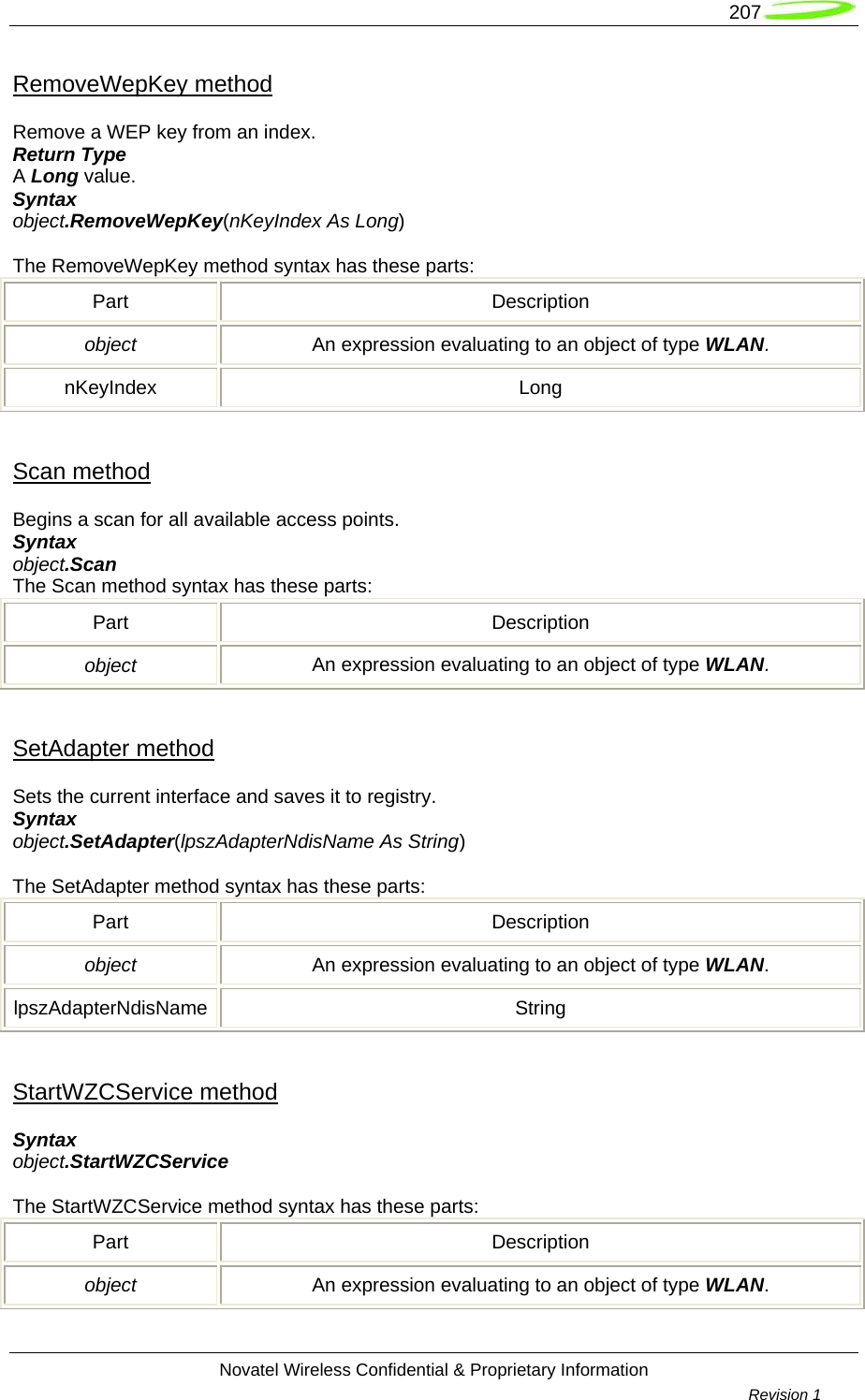
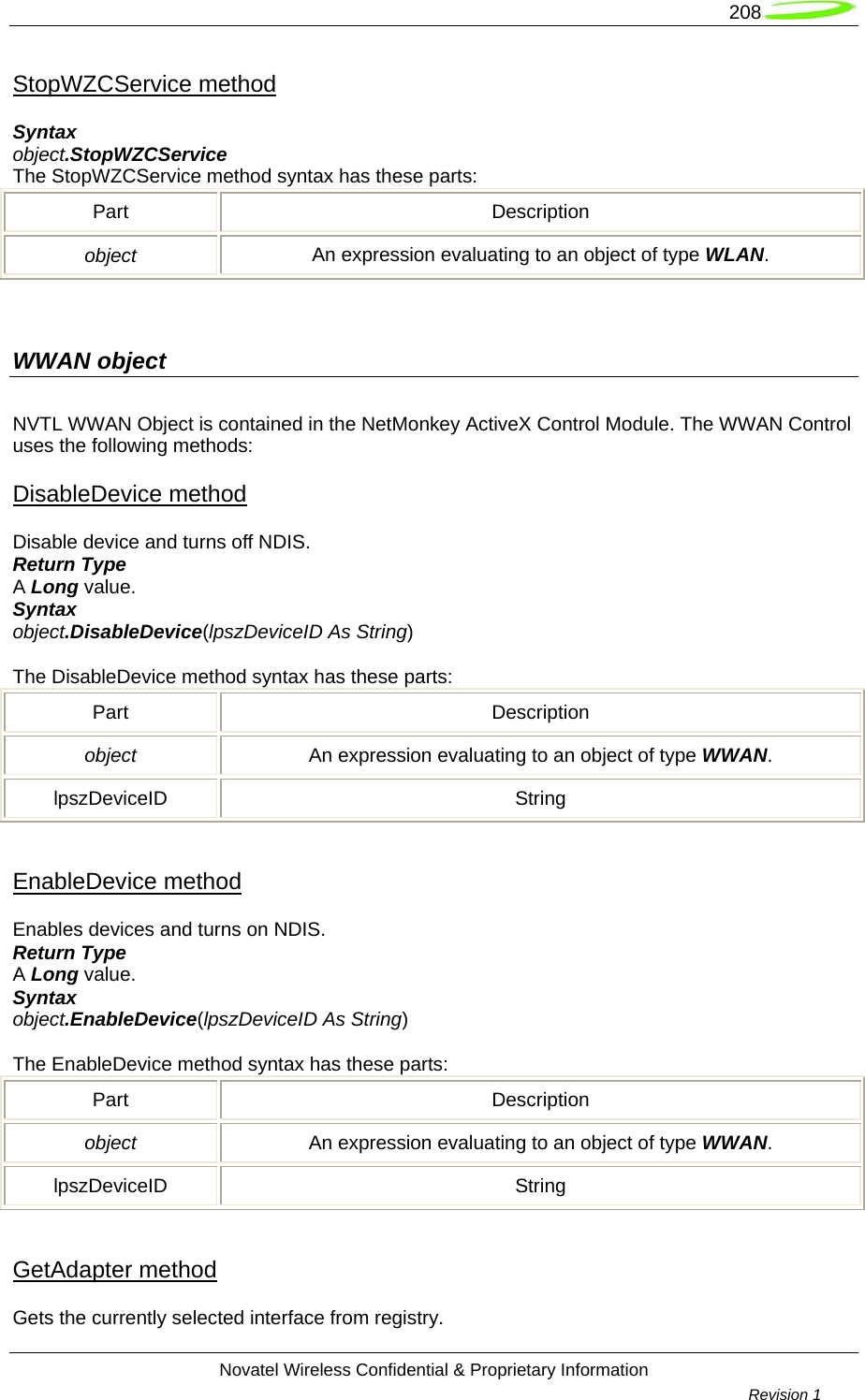
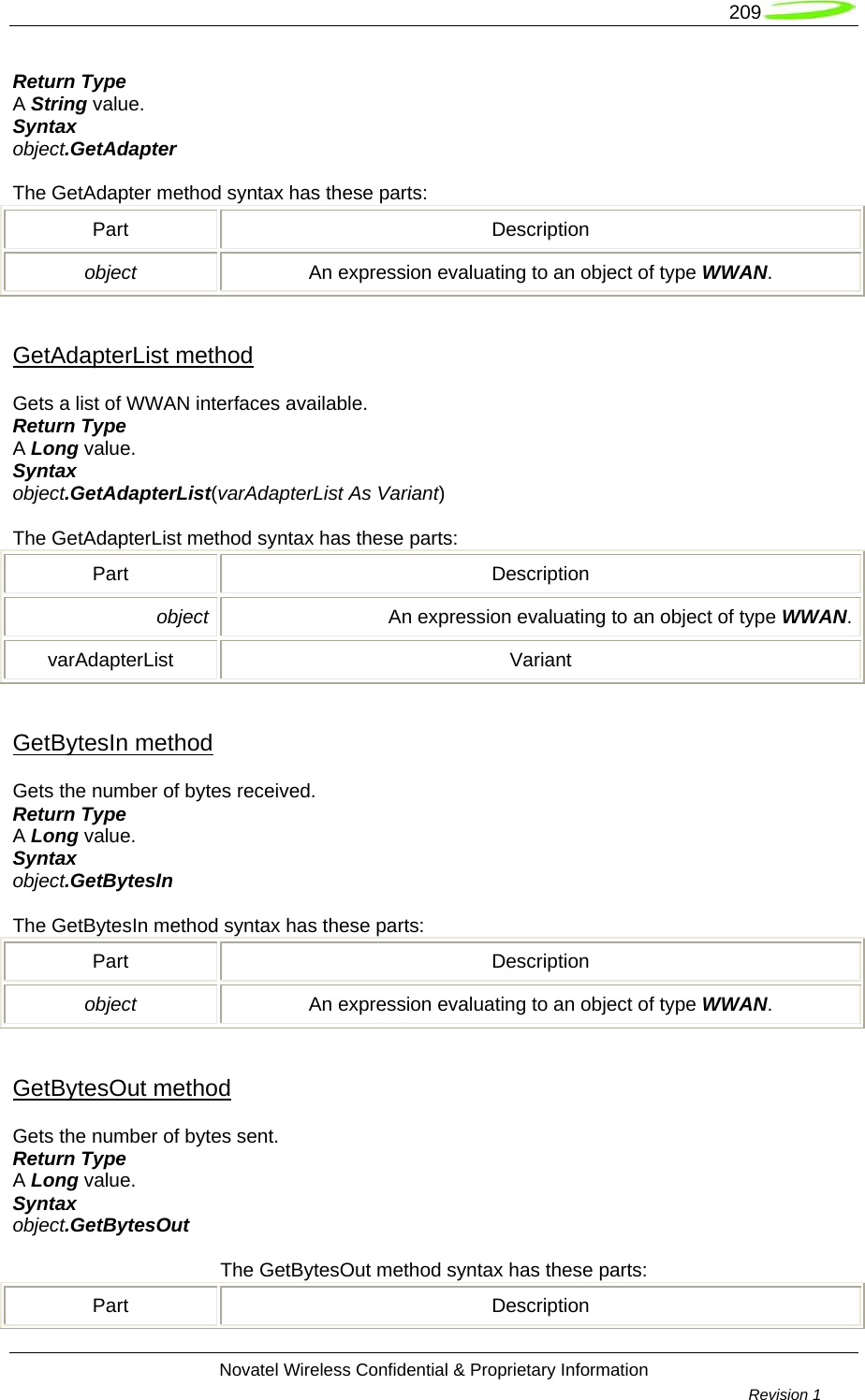
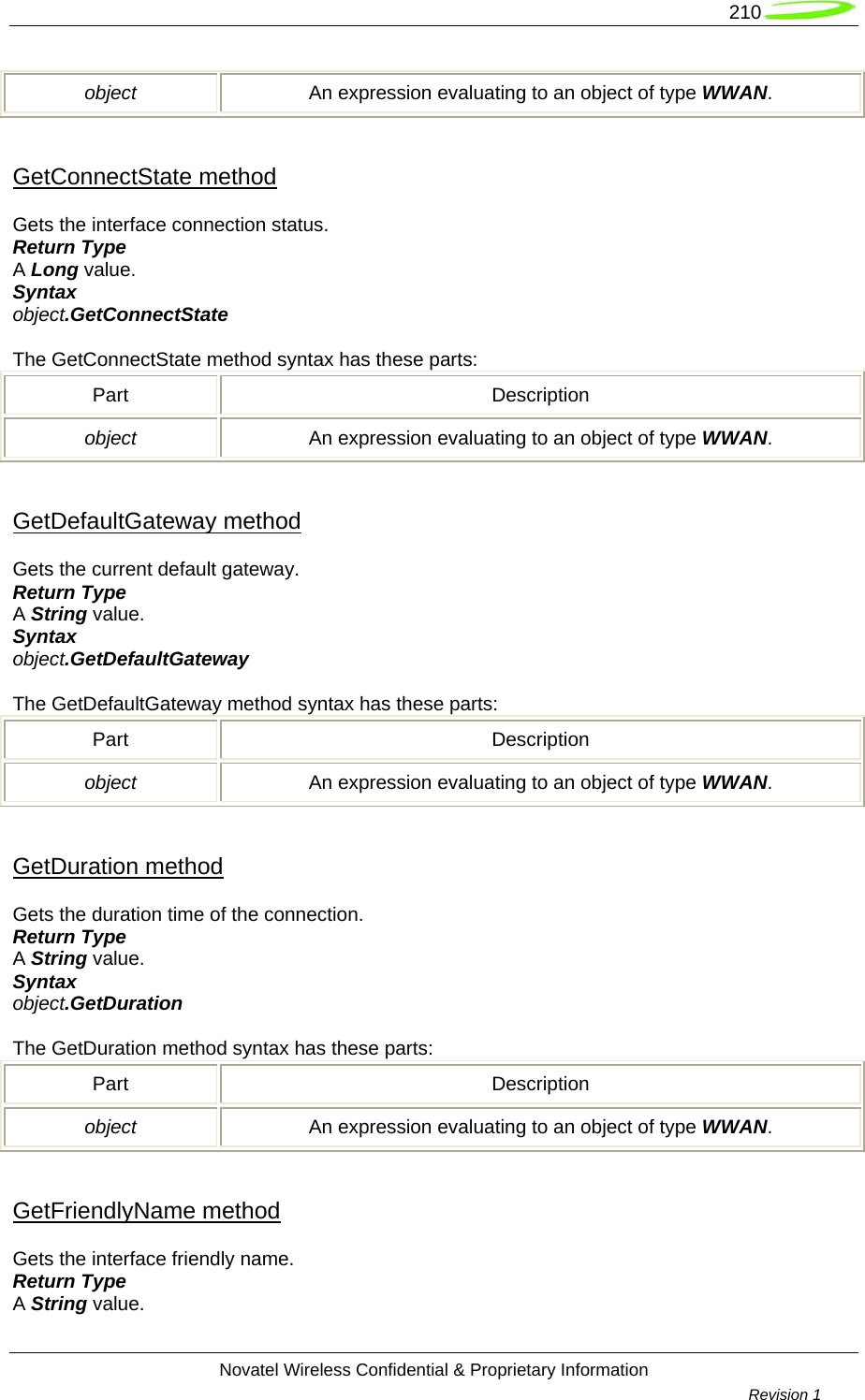
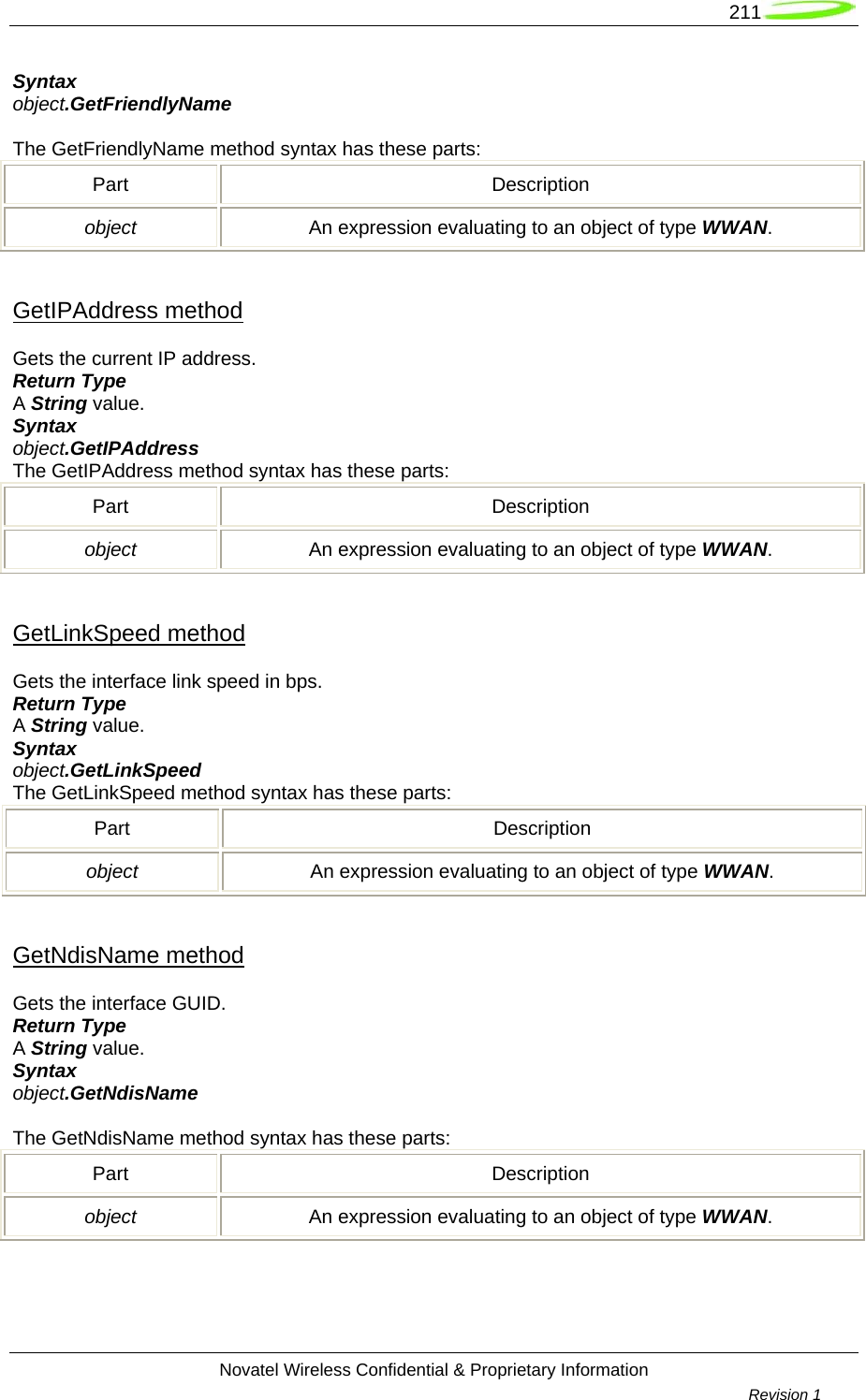
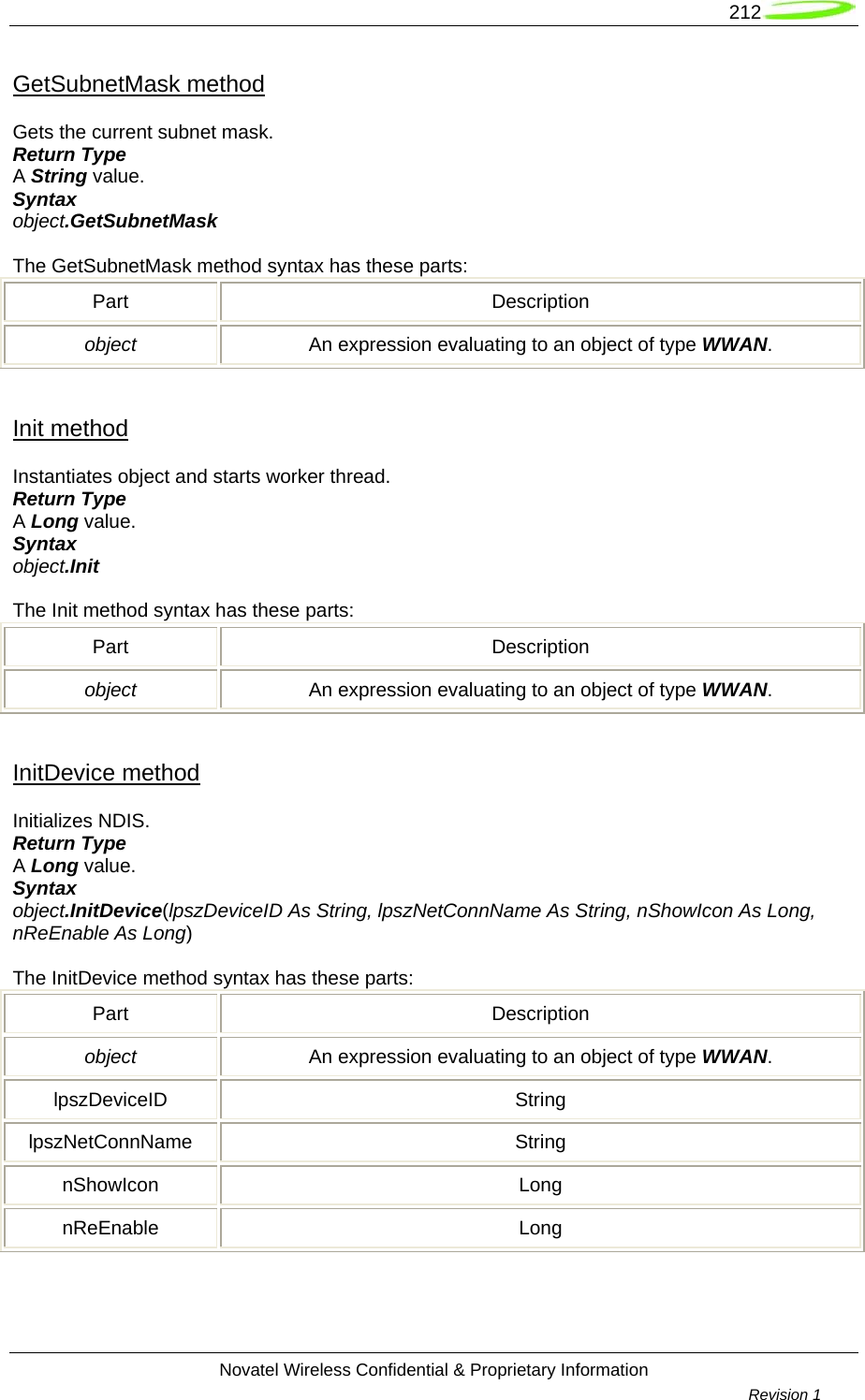
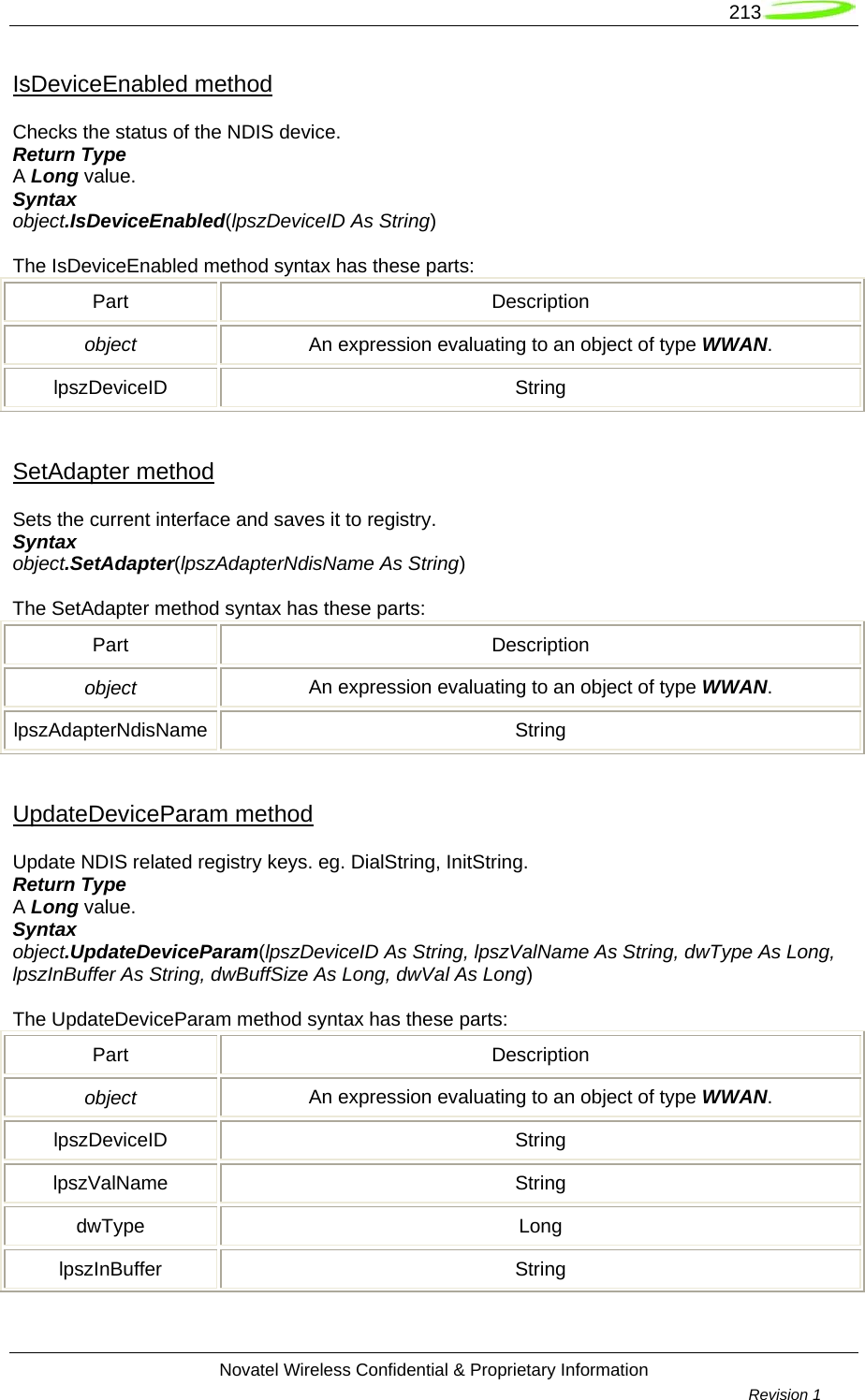
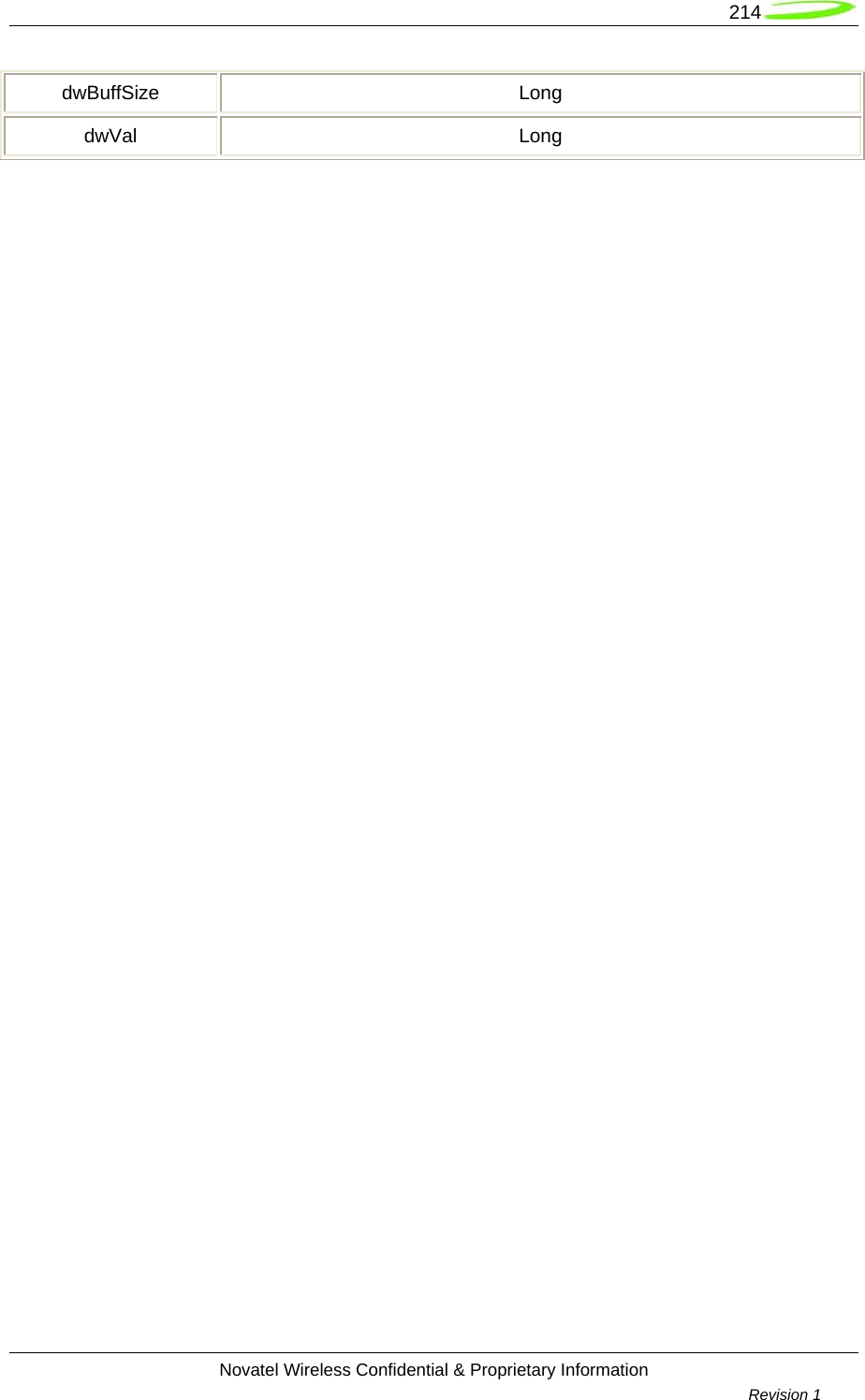
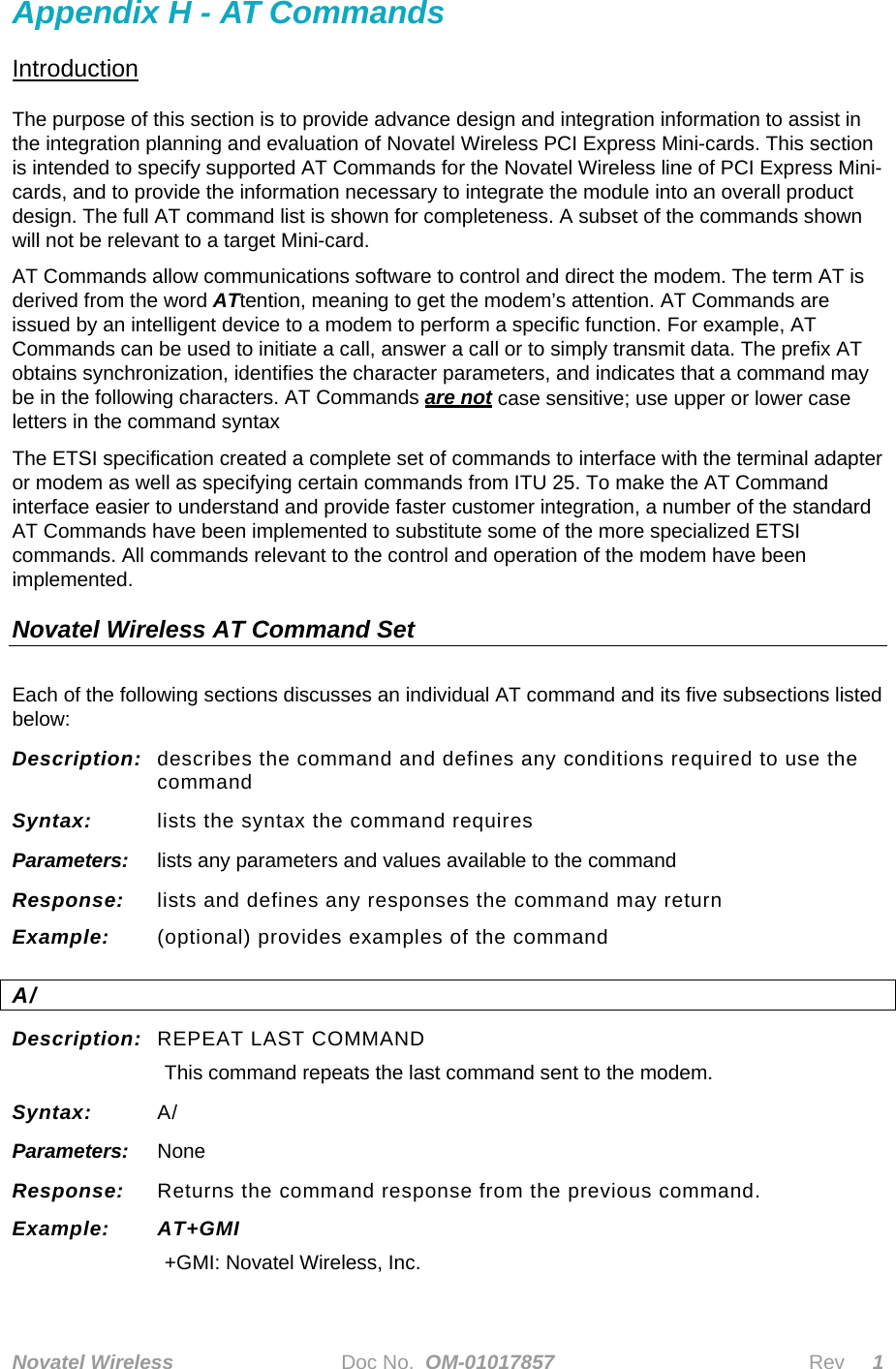
![216 Novatel Wireless Confidential & Proprietary Information Revision 1 OK A/ +GMI: Novatel Wireless, Inc. OK ATA Description: ANSWER This command sets the modem to answer the next call. The modem sends an off-hook signal to the remote station. Any additional commands on the same command line are ignored. The modem switches to data mode and after call is released, returns to command mode. This command can be stopped by receiving a character during execution, except during some states of connection establishment such as handshaking. Syntax: ATA Parameters: None Response: If the connection is successful the modem will return the string: CONNECT<text> then switches to data mode. The <text> is only displayed if the command ATX has been set to a value greater than 0. When the modem releases the call and returns to command mode, it returns the string: OK If no connection is made, the modem will return the string: NO CARRIER Example: ATA ATD Description: DIAL NUMBER This command will instruct the modem to originate a call to a disabled number. The modem attempts to set up an outgoing call. This command can be stopped by receiving a character during execution, except during some states of connection establishment such as handshaking. Syntax: ATD[<value>] Parameters: <value> The string of dialing digits and the optional V.25ter modifiers. The valid dialing digits are:](https://usermanual.wiki/Novatel-Wireless/NRM-EU860D.Part-2/User-Guide-754579-Page-96.png)
![217 Novatel Wireless Confidential & Proprietary Information Revision 1 0-9, * , #, +, A, B, C and the V.25ter modifiers which are ignored: Response: If there is no dial tone, the modem will return the string: NO DIALTONE where the command ATX has been set to 2 or 4. If there is an error and it is related to the mobile equipment’s (ME) functionality, the modem will return the string: +CME ERROR: <error> If the connection is busy, the modem will return the string: BUSY where the command ATX has been set to 3 or 4. If the connection cannot be established, the modem will return the string: NO CARRIER If the connection is successful and is non-voice call, the modem switches to data state and the modem will return the string: CONNECT<text> where <text> is only displayed if the command ATX has been set to a value greater than 0. If connection successful and is a voice call, the modem will return the string: OK When the modem releases the call and returns to command mode, it returns the string: OK Example: ATD9,555-1212 DIAL 9, PAUSE, DIAL 5551212 ATD555-1234; DIAL 5551234 ATD#777 Packet data call ATE Description: ECHO MODE This command sets the echo mode of the modem, that is, whether or not the modem echoes characters received from terminal while the modem is in command mode. Syntax: ATE[<value>] Parameters: <value> 0 turns echo mode off](https://usermanual.wiki/Novatel-Wireless/NRM-EU860D.Part-2/User-Guide-754579-Page-97.png)
![218 Novatel Wireless Confidential & Proprietary Information Revision 1 1 turns echo mode on Response: This command will return the string OK. Example: ATE1 All further data entered is echoed ATE0 All further data entered is not echoed ATH Description: HANG-UP (DISCONNECT) This command instructs the modem to disconnect from the current connection and terminate the call. Syntax: ATH[0] Parameters: 0 – This parameter is the default, as well as the only parameter, and does not necessarily have to be typed with the command. Response: This command will return the string OK, after the Data Carrier Detect (DCD) is turned off, if it was previously on. Example: ATH ATV Description: VERBOSE This command displays the modem’s result codes in terse or verbose form. In terse form, all result codes are represented by an error code number and all text messages have only a carriage return (<cr>) character appended to them. In verbose form, all result codes are returned as words or sentences and all text messages have a carriage return-line feed (<cr><lf>) character pair before and after the text message. Syntax: ATV[<value>] Parameters: <value> 0 will set the response format to terse 1will set the response format to verbose Response: If the command has been set to 0, it will return the response: 0 If the command has been set to 1, it will return the response: OK Example: ATV1 ATZ Description: RESET PARAMETERS TO SAVED SETTINGS](https://usermanual.wiki/Novatel-Wireless/NRM-EU860D.Part-2/User-Guide-754579-Page-98.png)
![219 Novatel Wireless Confidential & Proprietary Information Revision 1 This command uses the user-defined modem settings profile stored in the non-volatile memory as the active profile. If the user-defined profile is invalid, the modem will use the factory default settings. Any additional commands on the same command line are ignored. This command uses the profile created by the AT&W command. Syntax: ATZ[0] Parameters: 0 – This parameter is the default, as well as the only parameter, and does not necessarily have to be typed with the command. Response: This command will return the string OK. AT&C Description: DATA CARRIER DETECT (DCD) MODE This command sets the data carrier detect mode. Syntax: AT&C[<value>] Parameters: <value> 0 – sets the data carrier detect so it is always on 1 – sets the data carrier detect so it is only on in the presence of a data carrier 2 – sets data carrier detect to always on but wink when connection disconnect (Qualcomm™ implemented) Response: This command will return the string OK. Example: AT&C1 AT&D Description: DATA TERMINAL READY (DTR) CONTROL This command defines how the modem responds, while in data mode, to the data terminal ready (DTR) circuit changing state from ON to OFF. Syntax: AT&D[<value>] Parameters: <value> 0 – instructs the modem to ignore the data terminal ready state 1 – instructs the modem to change to command mode, while remaining connected to the call 2 – instructs the modem to disconnect from the call and then change to command mode. While the data terminal ready state is set to off, the modem’s auto-answer function is also off. Response: This command will return the string OK. Example: AT&D2](https://usermanual.wiki/Novatel-Wireless/NRM-EU860D.Part-2/User-Guide-754579-Page-99.png)
![220 Novatel Wireless Confidential & Proprietary Information Revision 1 AT&V Description: VIEW ACTIVE PROFILE This command will display the active profile settings on the terminating equipment. Syntax: AT&V[0] Parameters: 0 – This parameter is the default, as well as the only parameter, and does not necessarily have to be typed with the command. Response: The response will be a listing of the current configuration followed by the string OK. For example ACTIVE PROFILE : E1 L1 M1 Q0 V1 X4 &C1 &D2 S0:0 S2:43 S3:13 S4:10 S5:8 S6:2 S7:60 S8:2 S10:15 S12: +CBST: 7,0,1 +CSMS: 0 +CRLP: 61,61,48,6,0,3 +CRC: 0 +CR: 0 +FCLASS: 0 +IFC: 2,2 +IMODE: 0 +ICF: 3,3 +DR: 0 +CMGF: 0 +CSDH: 0 +CNMI: 2,1,0,0,0 +ILRR: 0 +IPR: 115200 +DS: 3,0,512,20 +CMEE: 0 +CREG: 0 +CCUG: 0,0,0 +CLIP: 0 +COLP: 0 +CCWA: 0 +CAOC: 1 +CLIR: 0 +CSCA: "+44385016005",145 +CSMP: 17,167 OK Example: AT&V AT+CFC Description: Um INTERFACE FAX COMPRESSION Syntax: AT+CFC=<value> Parameters: <value>](https://usermanual.wiki/Novatel-Wireless/NRM-EU860D.Part-2/User-Guide-754579-Page-100.png)
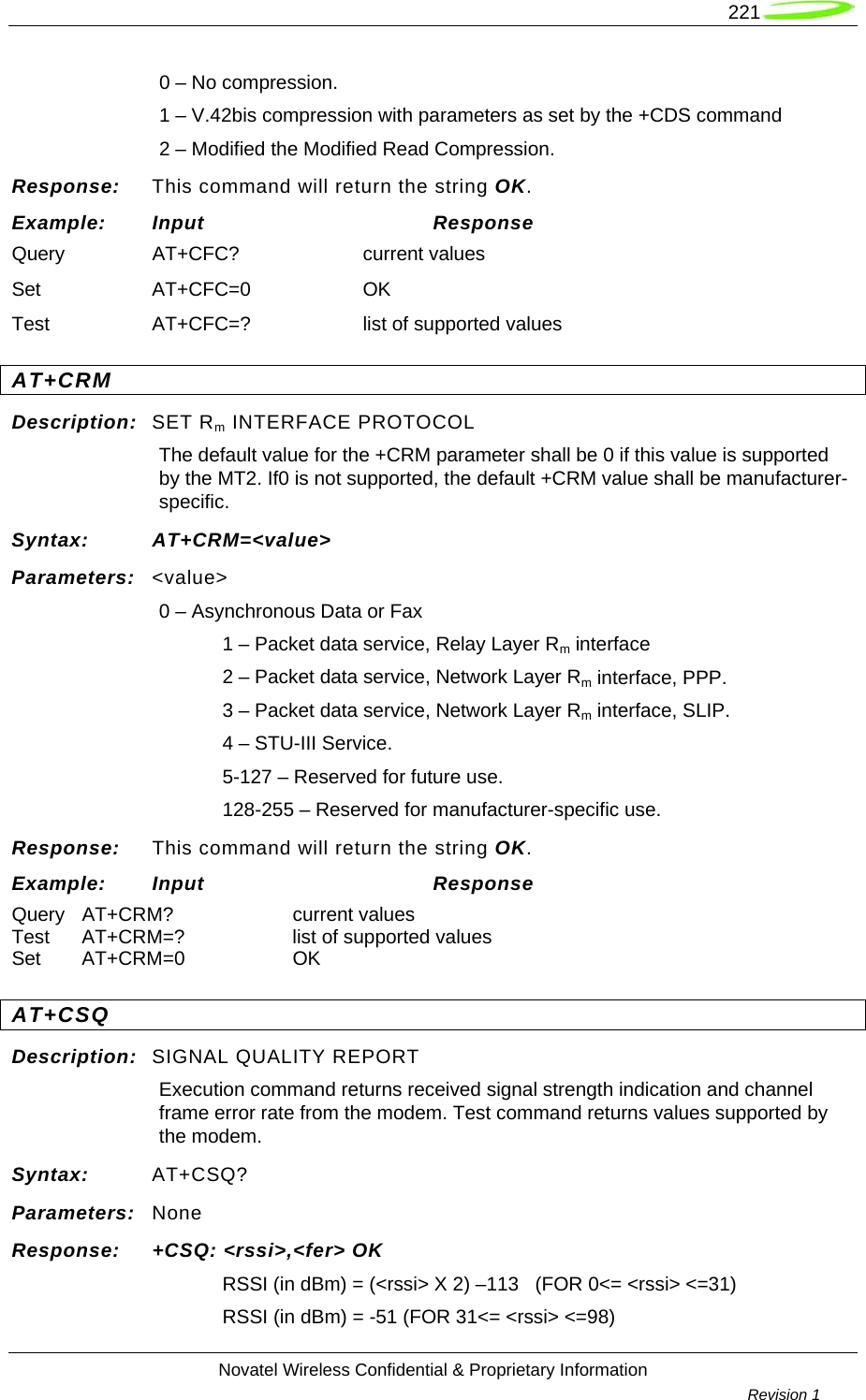
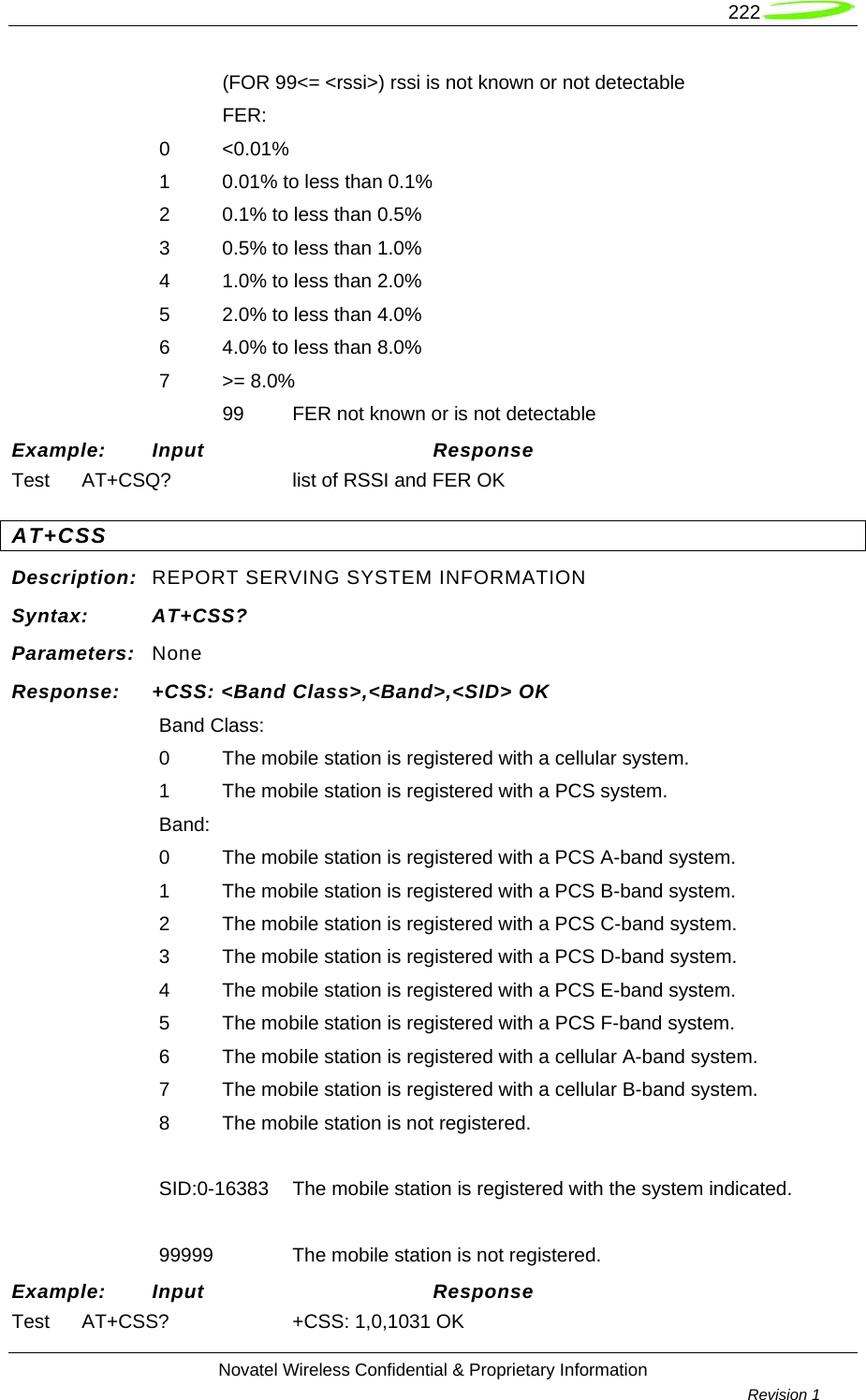
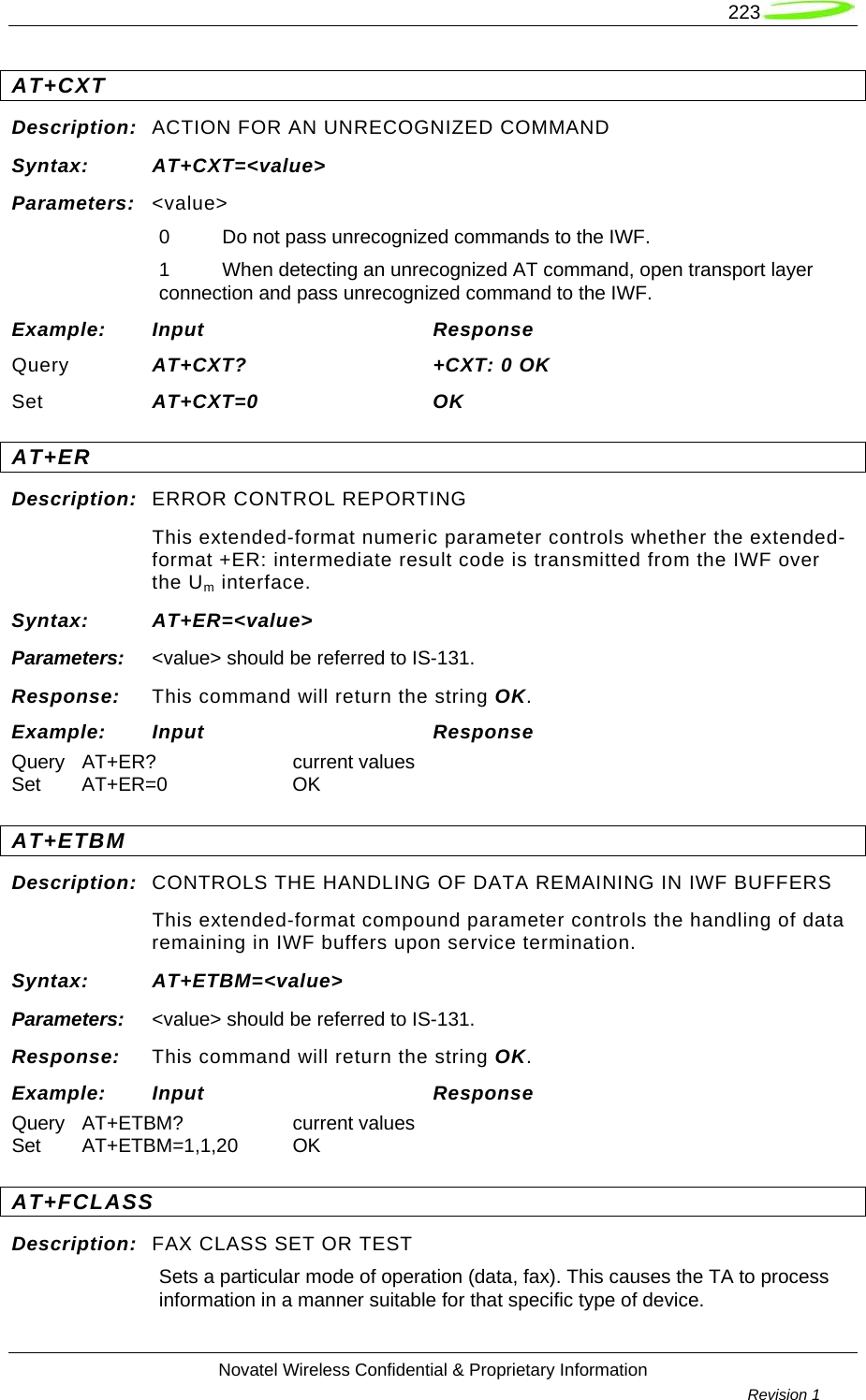
![224 Novatel Wireless Confidential & Proprietary Information Revision 1 Syntax: AT+FCLASS[=<value> or ?][?] Parameters: <value>, [?] 0 data 2.0 fax class 2 (TIA-578-A) ? queries the command and returns its current setting or displays the valid values for the commands parameters Response: This command will return the string OK. Example: Input Response Query AT+FCLASS? current values Test AT+FCLASS=? list of supported values Set AT+FCLASS=0 OK AT+GCAP Description: REPORT ADDITIONAL CAPABILITIES Modem reports a list of additional capabilities. Syntax: AT+GCAP Parameters: None Response: This command will return the string OK. Example: Input Response Query AT+GCAP +GCAP: +CIS707-A, +MS, +ES, +DS, +FCLASS OK AT+GMI Description: MANUFACTURER IDENTITY Request for manufacturer identification Syntax: AT+GMI Parameters: None Response: +GMI: <MANUFACTURERS NAME/ID> OK Example: Input Response Query AT+GMI +GMI: Novatel Wireless Inc. OK AT+GMM Description: MODEM IDENTITY Request TA model identification. Unit reports one or more lines of information text which permits you to identify the specific model of device. Typically, the text will consist of a single line containing the name of the product, but manufacturers may choose to provide any information desired. Syntax: AT+GMM Parameters: None](https://usermanual.wiki/Novatel-Wireless/NRM-EU860D.Part-2/User-Guide-754579-Page-104.png)
![225 Novatel Wireless Confidential & Proprietary Information Revision 1 Response: +GMM: <MODEL ID> OK Example: Input Response Query AT+GMM EXPDV620 AT+GMR Description: REVISION NUMBER / IDENTITY This command reports the version, revision and date of the software or firmware used in the device. It is also used to identify the software version to facilitate easier tracking and code updates. Syntax: AT+GMR Parameters: None Response: +GMR: <REVISION ID> OK Example: Input Response Query AT+GMR M6500C-NIRVANA_VZW-Q40305.136 [Mar 22 2005 14:00:00] AT+GSN Description: ESN NUMBER IDENTITY This command causes the MT2 to transmit one or more lines of information text, determined by the manufacturer, which is intended to permit you of the MT2 to identify the individual device. Typically, the text will consist of a single line containing a manufacturer-determined alphanumeric string, but manufacturers may choose to provide any information desired. Syntax: AT+GSN Parameters: None Response: +GSN: <ESN(hex)> OK Example: Input Response Query AT+GSN +GSN: <ESN(hex)> OK AT$NW Description: This command returns Novatel Wireless company description Syntax: AT$NW Parameters: None Example: Input Response Query AT$NW Novatel Wireless Inc. www.novatelwireless.com Developed in the USA.](https://usermanual.wiki/Novatel-Wireless/NRM-EU860D.Part-2/User-Guide-754579-Page-105.png)
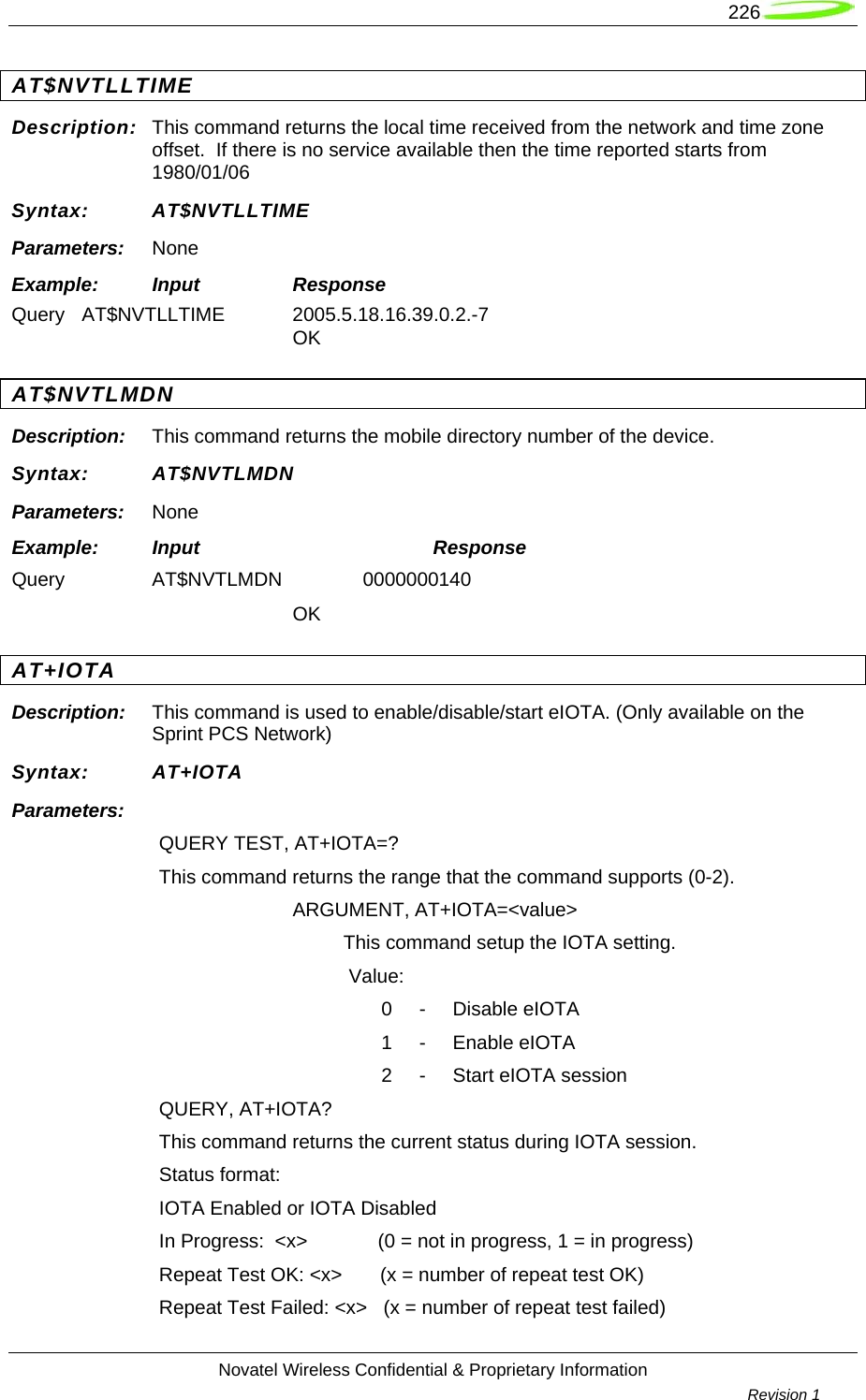
![227 Novatel Wireless Confidential & Proprietary Information Revision 1 Retry Command: <x> (x = retry command in numeric) Current State: <x> (x = current IOTA state in numeric) Network Up or Network Down Server Connected or Server Disconnected Retry: <x> (x = the number of retry IOTA session) Global State: <x> Number Get: <x> Number Post: <x> Proxy Trusted or Proxy Not Trusted AT$NWACTIVATION Description: This command is used to manually provision the Novatel PCMCIA card (program the MDN and MIN). Syntax: AT$NWACTIVATION Parameters: QUERY TEST, AT$NWACTIVATION =? This command returns the range that the following string: $NWACTIVATION: (ACTIVATION CODE:[xxxxxx] MDN:[XXXXXXXXXX] MIN:[XXXXXXXXXX]) ARGUMENT, AT$NWACTIVATION = <SPC>, <MDN>, <MIN> This command programs the MDN and MIN into the PCMCIA card using the correct SPC. Value: SPC - Service Programming Code (6 digits) MDN - Mobile Directory Number (10 digits) MIN - Mobile Identification Number (10 digits) QUERY, AT$NWACTIVATION? This command returns the MDN, Min1, and MIN2. AT+PZID Description: This command is used to retrieve the PZID of the current network. Values are only 1 and 0 being non zero or else zero. (Only available on the Sprint PCS Network) Syntax: AT+PZID Parameters: QUERY, AT+PZID? This command returns the current PZID of serving network. Status format: PZID - 1 for non zero value of PZID](https://usermanual.wiki/Novatel-Wireless/NRM-EU860D.Part-2/User-Guide-754579-Page-107.png)
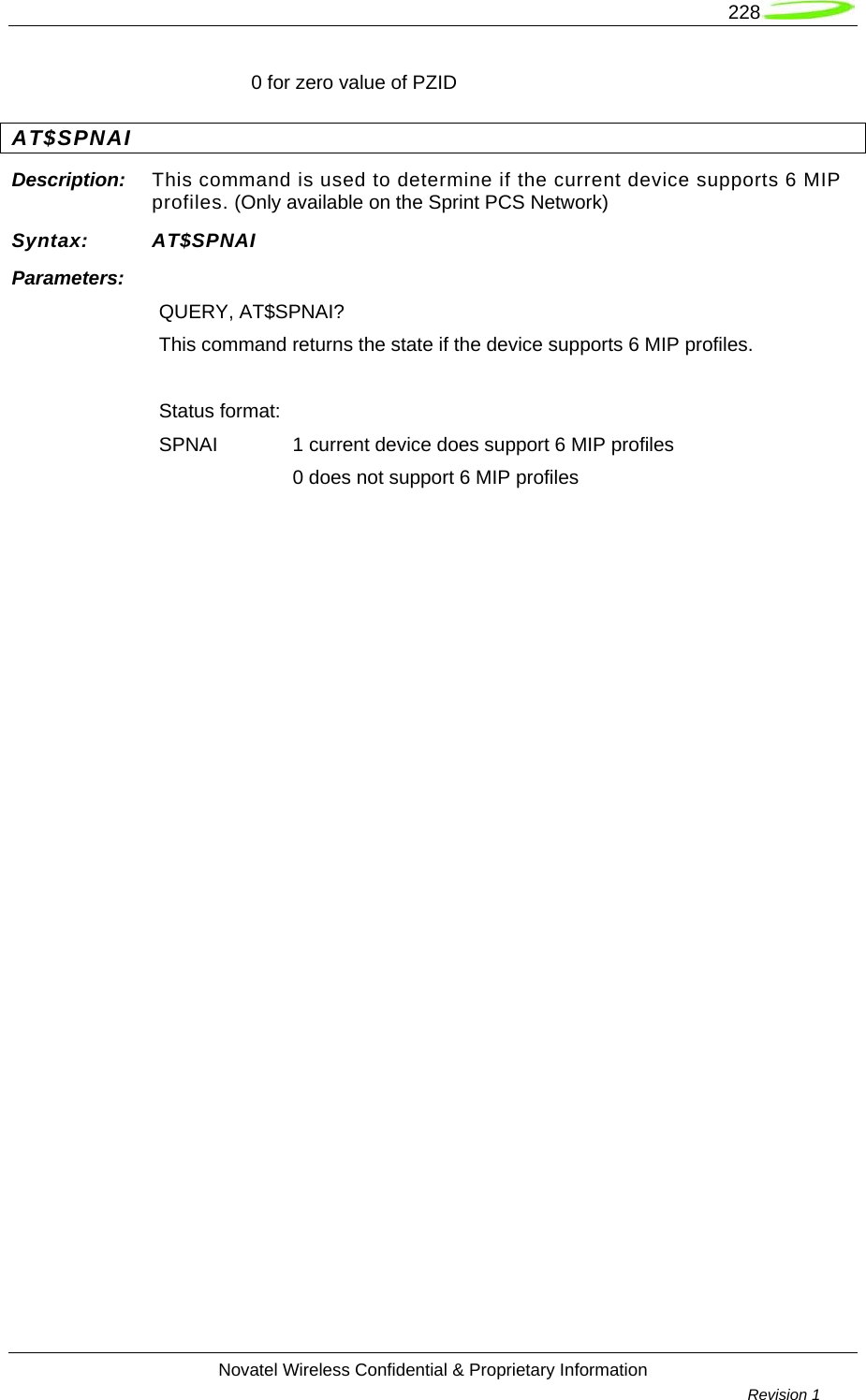
![Novatel Wireless Doc No. OM-01017857 Rev 1 Appendix I - Novatel Wireless Developer Network Library The NWDN Library is a comprehensive reference for developers writing applications for Novatel Wireless modems. It contains software API references, modem AT command set references, and any other documentation you might need to develop solutions that use Novatel Wireless modems. AT+COPS Description: Set command forces an attempt to select and register the GSM network operator. <mode> is used to select whether the selection is done automatically by the ME or is forced by this command to operator <oper> (it shall be given in format <format>). If the selected operator is not available, no other operator shall be selected (except <mode>=4). The selected operator name format shall apply to further read commands (+COPS?) also. <mode>=2 forces an attempt to deregister from the network. The selected mode affects to all further network registration (e.g. after <mode>=2, ME shall be unregistered until <mode>=0 or 1 is selected). Refer subclause 9.2 for possible <err> values. This command should be abortable when registration/deregistration attempt is made. Read command returns the current mode and the currently selected operator. If no operator is selected, <format> and <oper> are omitted. Test command returns a list of quadruplets, each representing an operator present in the network. Quadruplet consists of an integer indicating the availability of the operator <stat>, long and short alphanumeric format of the name of the operator, and numeric format representation of the operator. Any of the formats may be unavailable and should then be an empty field. The list of operators shall be in order: home network, networks referenced in SIM, and other networks. It is recommended (although optional) that after the operator list TA returns lists of supported <mode>s and <format>s. These lists shall be delimited from the operator list by two commas. Syntax: Command Response +COPS=[<mode>[,<format>[,<oper>]]] +CME ERROR: <err> +COPS? +COPS: <mode>[,<format>,<oper>[,<AcT]] +CME ERROR: <err> +COPS=? +COPS: [list of supported (<stat>,long alphanumeric <oper>,short alphanumeric <oper>,numeric <oper>[,<AcT>])s] [,,(list of supported <mode>s),(list of supported <format>s)]+CME ERROR: <err> Values: <mode> Value Description 0 automatic (<oper> field is ignored) 1 manual (<oper> field shall be present) 2 deregister from network 3 set only <format> (for read command +COPS?), do not attempt registration/deregistration (<oper> field is ignored); this value is not applicable in read command response 4 manual/automatic (<oper> field shall be present); if manual selection fails, automatic mode (<mode>=0) is entered (NOT SUPPORTED)](https://usermanual.wiki/Novatel-Wireless/NRM-EU860D.Part-2/User-Guide-754579-Page-109.png)
![230 Novatel Wireless Confidential & Proprietary Information Revision 1 <format> Value Description 0 long format alphanumeric <oper> 1 short format alphanumeric <oper> 2 numeric <oper> <oper>: string type; <format> indicates if the format is alphanumeric or numeric; long alphanumeric format can be up to 16 characters long and short format up to 8 characters (refer GSM MoU SE.13 [9]); numeric format is the GSM Location Area Identification number (refer GSM 04.08 [8] subclause 10.5.1.3) which consists of a three BCD digit country code coded as in ITU-T E.212 Annex A [10], plus a two BCD digit network code, which is administration specific; returned <oper> shall not be in BCD format, but in IRA characters converted from BCD; hence the number has structure: (country code digit 3)(country code digit 2)(country code digit 1)(network code digit 2)(network code digit 1) <stat> Value Description 0 Unknown 1 Available 2 Current 3 Forbidden <AcT> Value Description 0 GSM 1 GSM Compact (Not Supported)2 UTRAN 3 Automatic Note: <AcT> value of 3 (automatic) is an added feature not supported by 3GPP. Example: AT+COPS? AT+COPS=1,1,”T-Mobile” AT+CSPN Description: Returns the current service provider name. Syntax: Command Response +CSPN? +CSPN: <oper> +CSPN=? ERROR, +CME ERROR: <err>+CSPN ERROR, +CME ERROR: <err>Values: <oper> String type; long alphanumeric format can be up to 16 characters long](https://usermanual.wiki/Novatel-Wireless/NRM-EU860D.Part-2/User-Guide-754579-Page-110.png)
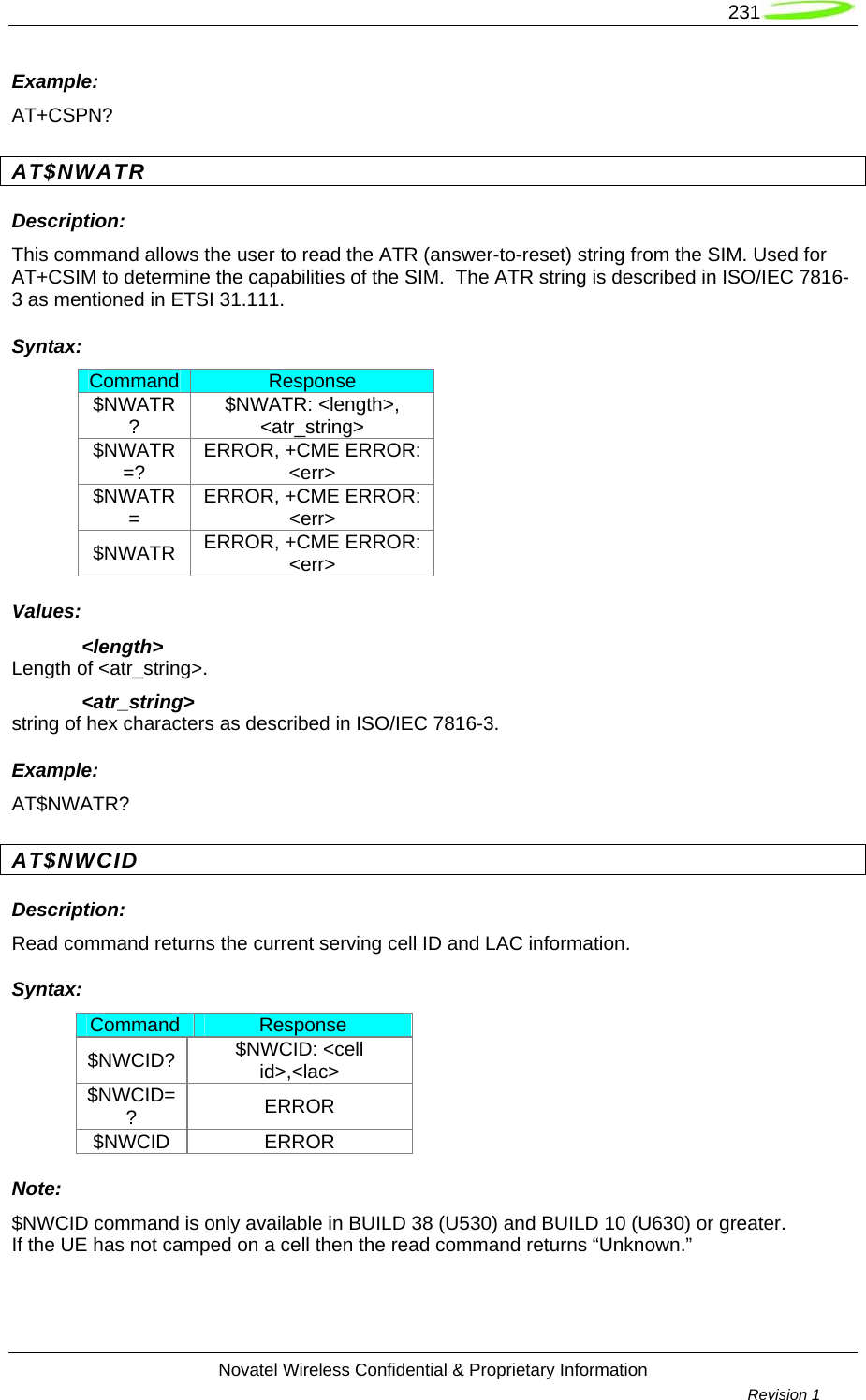
![232 Novatel Wireless Confidential & Proprietary Information Revision 1 Example: AT$NWCID AT$NWFLASH Description: Read command returns the memory device that is populated on the PCB. Syntax: Command Response $NWFLASH? $NWFLASH: <id 0> <id 1> <id 2> <id 3> $NWFLASH=? ERROR $NWFLASH ERROR Note: $NWFLASH command is only available on U630 devices. Example: AT$NWFLASH? AT$NWHLR Description: The HLR Lock feature, when enabled, allows service providers to limit a UE’s roaming area (country and network specific) as well as prohibit unauthorized or stolen SIMs from operating within their network. The HLR Lock feature utilizes a portion of the SIM International Mobile Subscriber Identity (IMSI) number to carry out the algorithm. The makeup of the IMSI number is composed of a 3 digit MCC value, a 2 (or 3) digit MNC value and a 9 digit MSIN value. The first three leading digits of the MSIN form the HLR-value (2 digits) and a NDC identity (1 digit). The MCC/MNC pair, NDC identity and HLR range(s) that are programmed within the UE are secured by a service provider specified password. Syntax: Command Response $NWHLR=(0,<mcc>,<mnc>)|(1,<mode>,<parm>,[hlr rangelow>,<hlr rangehigh>,…]|(2)|(3,1,<passwd>)|(4,<type>) $NWHLR: <mcc>,<mnc> $NWHLR: <index> <ndc> <list of hlr ranges> OK, ERROR, +CME ERROR: <err> $NWHLR=? ERROR $NWHLR? ERROR](https://usermanual.wiki/Novatel-Wireless/NRM-EU860D.Part-2/User-Guide-754579-Page-112.png)
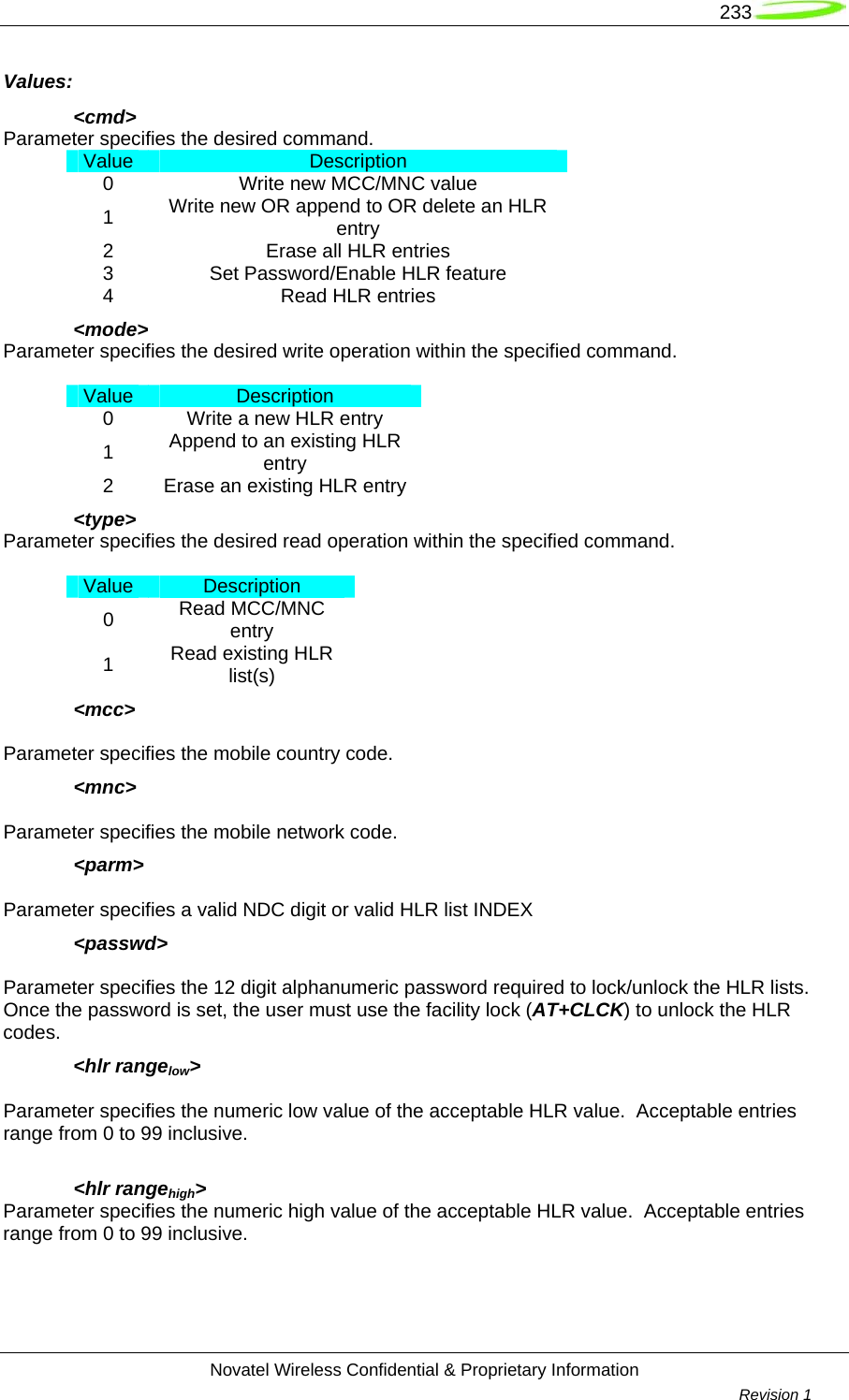
![234 Novatel Wireless Confidential & Proprietary Information Revision 1 Note: A maximum of 4 NDC values with 15 corresponding HLR range specifications may be entered. Only one MCC/MNC pair is supported. Example: The HLR Lock codes can be read, set, erased and locked using the following custom AT command: AT$NWHLR=<cmd>,[<item1>,<item2>,…] Where <cmd> is one of the following: 0 : for entry of MCC/MNC pair 1 : for entry/appending/deleting of NDC/HLR values 2 : for deletion of entire HLR entries (including MCC/MNC pair) 3 : for password entry and activation of HLR Lock 4 : for displaying HLR entries Where <item1>,<item2>,… represents action items corresponding to the requested <cmd> (see below for further details) If < cmd > = 0, <mcc>,<mnc> is comma-delimitated MCC/MNC network identifier. (only one entry supported with this command) If < cmd > = 1, <mode>,<parm>,[<hlr rangelow>,<hlr rangehigh>…] is comma-delimitated for entry, appending or deleting HLR parameters. If < mode > = 0, <parm> = NDC digit (IMSI 8th digit if MNC is 2 digits in length or IMSI 9th digit if MNC is 3 digits in length) <hlr rangelow>,<hlr rangehigh> is comma-delimitated service provider specified ranges (valid entries are from 0 to 99). Up to 5 HLR range pairs (low/high) may be entered per <mode>=0 command. If < mode > = 1, <parm> = index (0,1,2,3 to an existing HLR list) <hlr rangelow>,<hlr rangehigh> is comma-delimitated service provider specified ranges (valid entries are from 0 to 99). Up to 5 HLR range pairs (low/high) may be entered for appending to an existing list (per command). If < mode > = 2, <parm> = index (0,1,2,3 to delete a single HLR list entry) If < cmd > = 2 entire HLR entries deleted (Index 0-3 and MCC/MNC pair) If < cmd > = 3,1, To enable & lock the HLR feature. <passwd> = “xxxxxxxxxxx” up to 12 digits in length. If < cmd > = 4, <type> = 0 to display the single MCC/MNC entry. <type> = 1 to display NDC and HLR range values. To populate the network personalization code for the HLR Lock feature (lock to network 123 02): AT$NWHLR=0,123,02](https://usermanual.wiki/Novatel-Wireless/NRM-EU860D.Part-2/User-Guide-754579-Page-114.png)
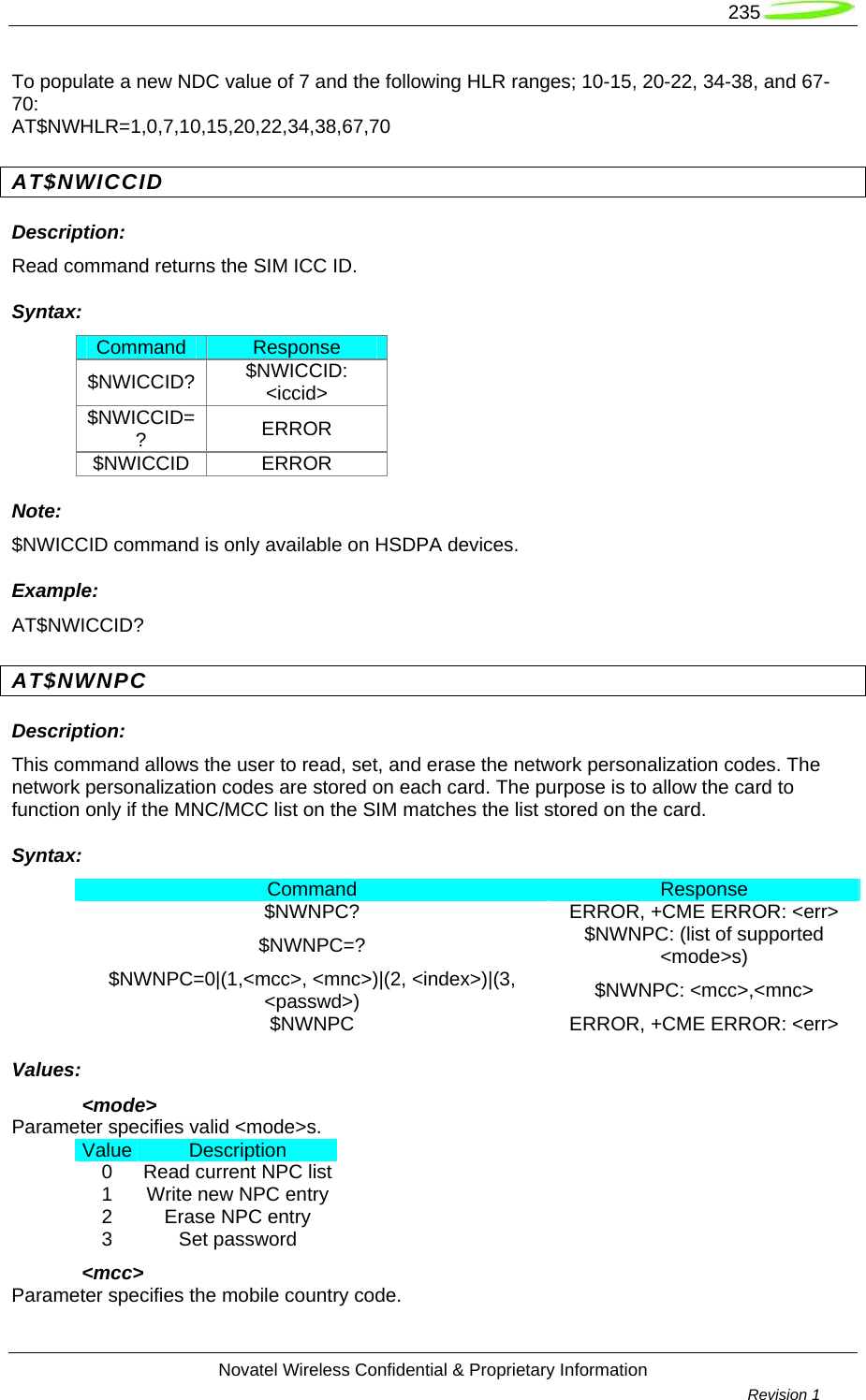
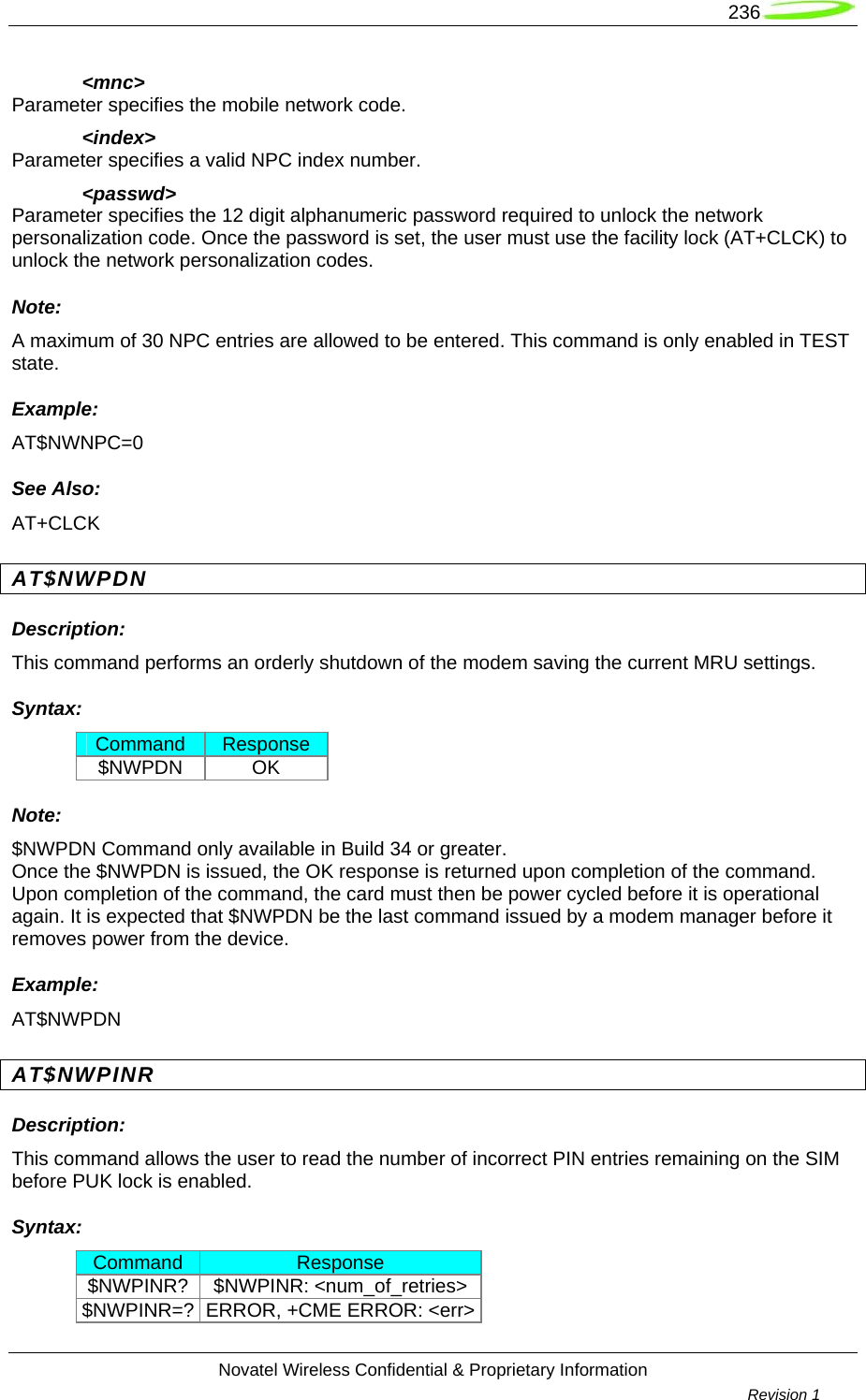
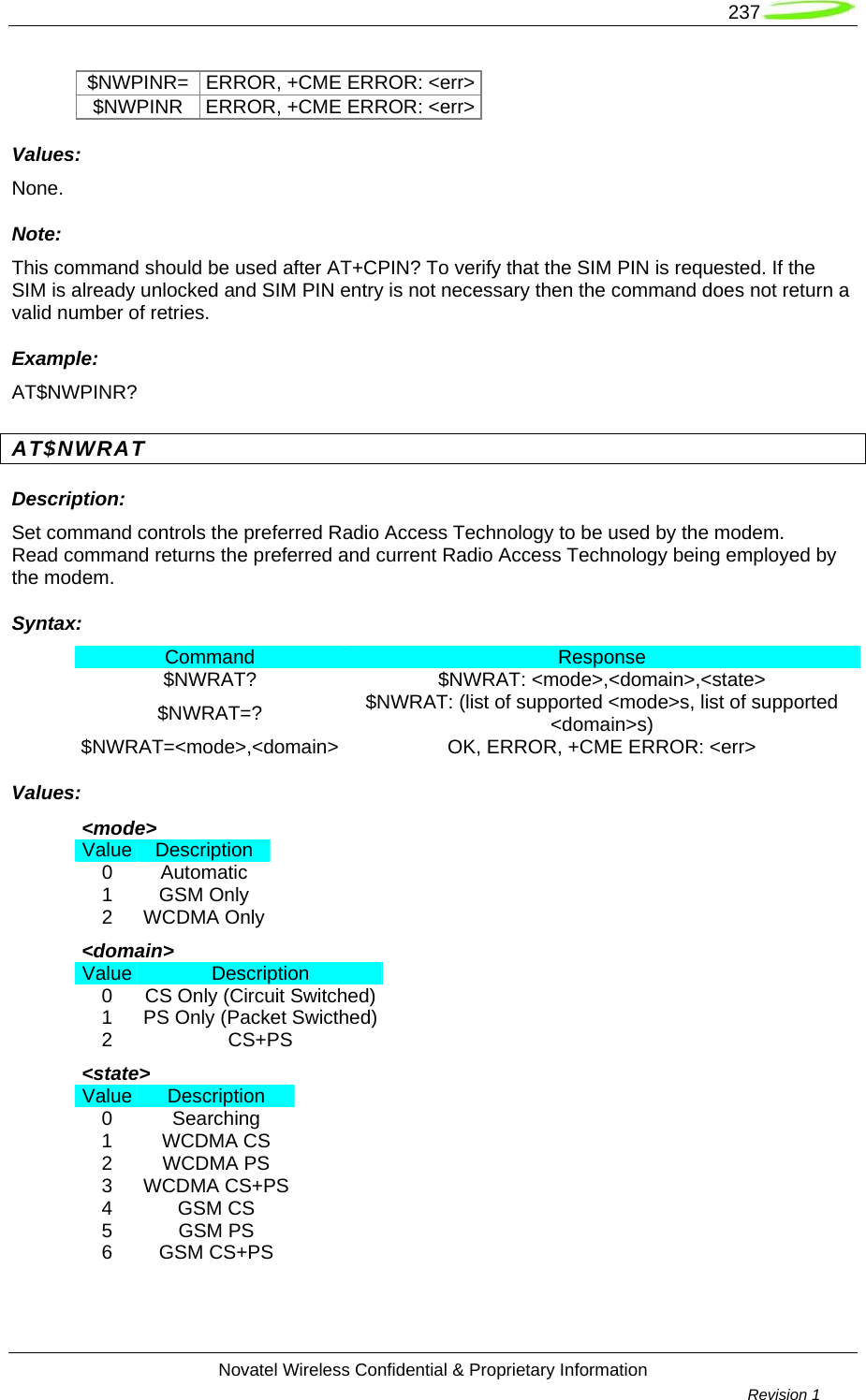
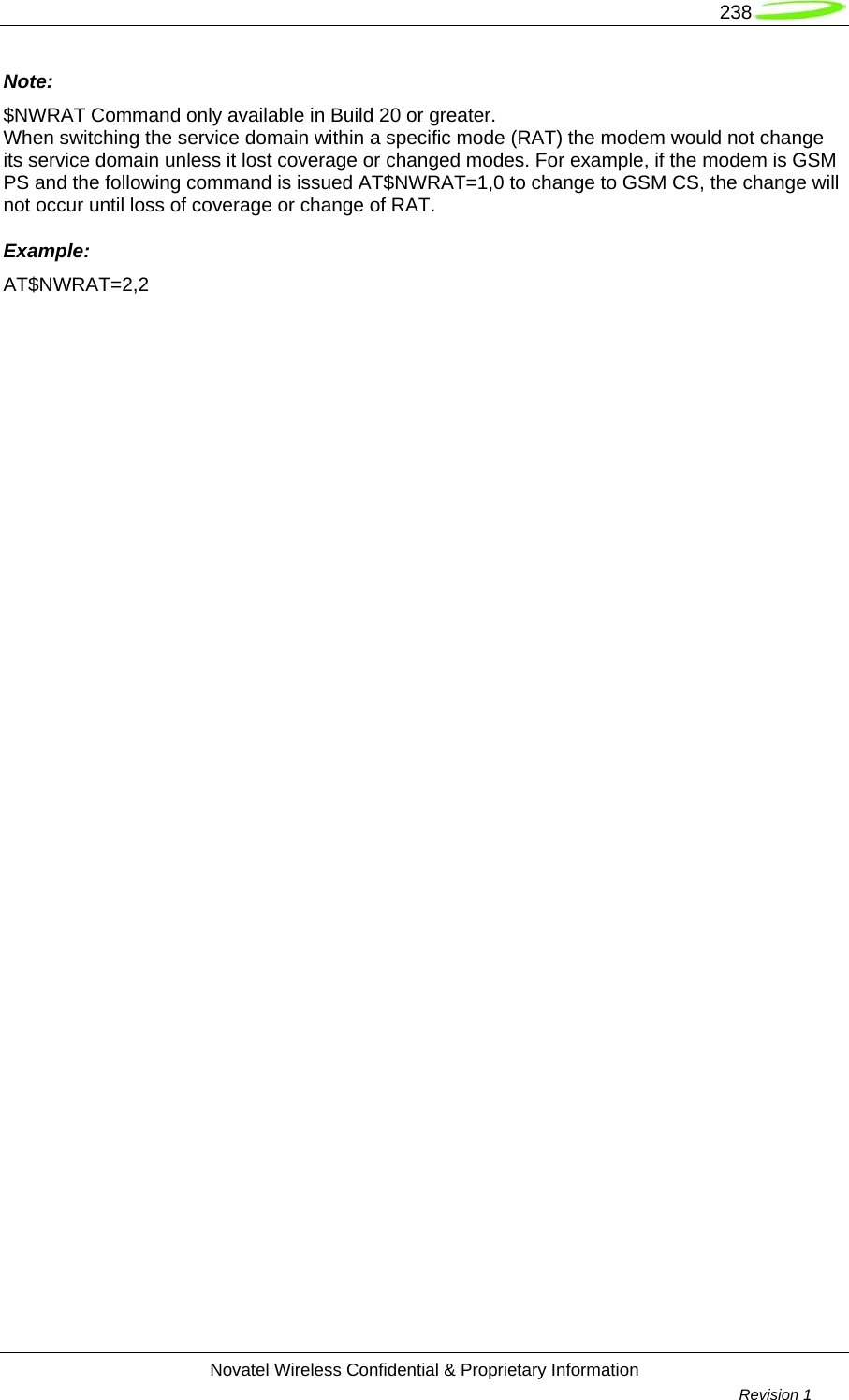
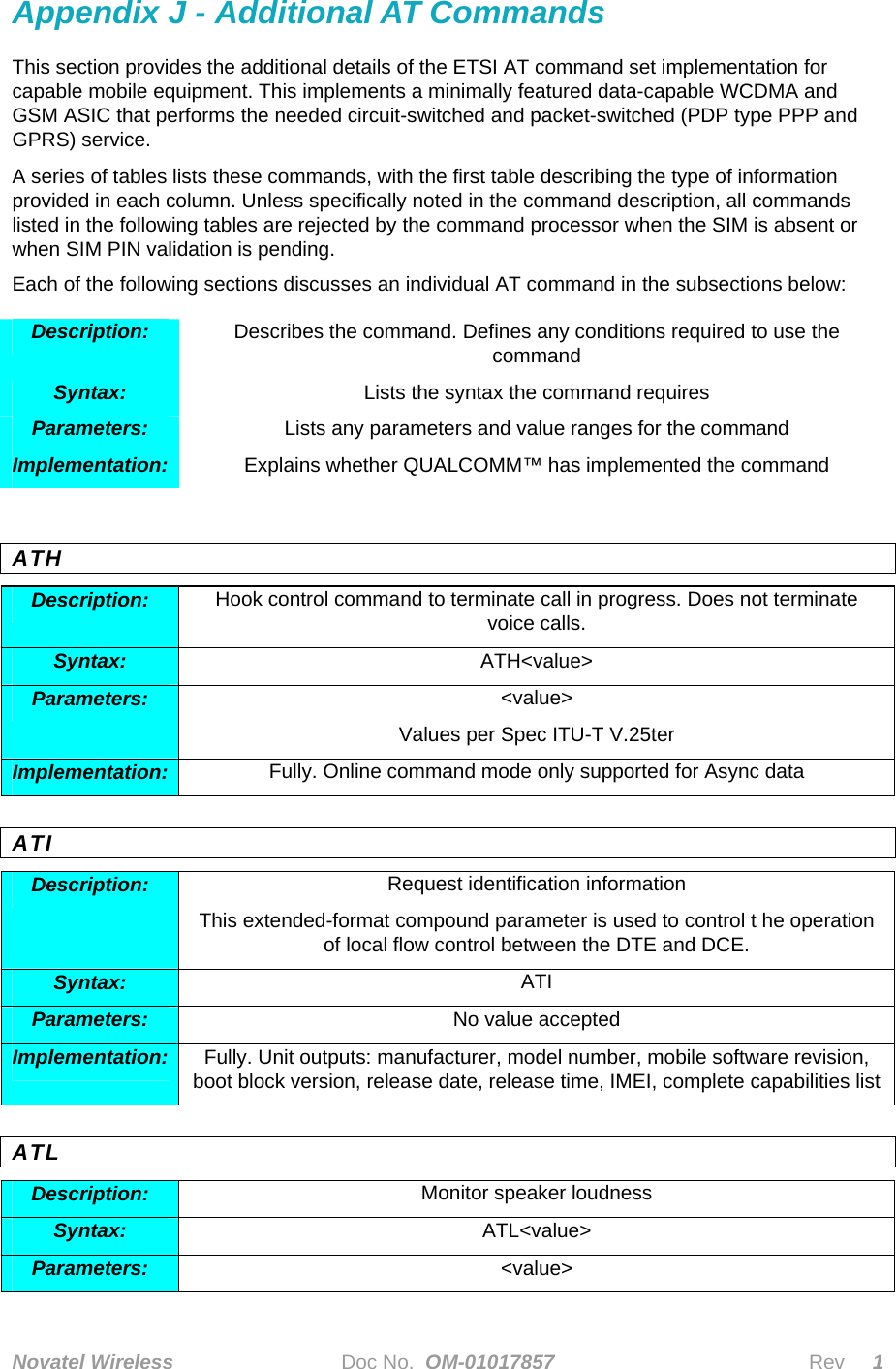
![240 Novatel Wireless Confidential & Proprietary Information Revision 1 Values per Spec ITU-T V.25ter Implementation: Command accepted, no action taken. Mobile audio stream not used for Async data ATO Description: Return to online data state from online command state Syntax: ATO<value> Parameters: <value> Values per Spec ITU-T V.25ter Implementation: Fully. Online command mode only supported for Async data ATP Description: Select pulse dialing Syntax: ATP Parameters: Implementation: Command accepted, performs normal dial. Pulse dialing not relevant to ETSI data services. ‘P’ not sent in dial string. ATQ Description: Result code suppression Syntax: ATQ[<value>] Parameters: <value> Values per Spec ITU-T V.25ter Implementation: Fully ATS0 Description: Enable/disable automatic answering Syntax: ATS0=<value> Parameters: <value> Values per Spec ITU-T V.25ter Implementation: Fully. ATS3 Description: Command line termination character Syntax: ATS3](https://usermanual.wiki/Novatel-Wireless/NRM-EU860D.Part-2/User-Guide-754579-Page-120.png)
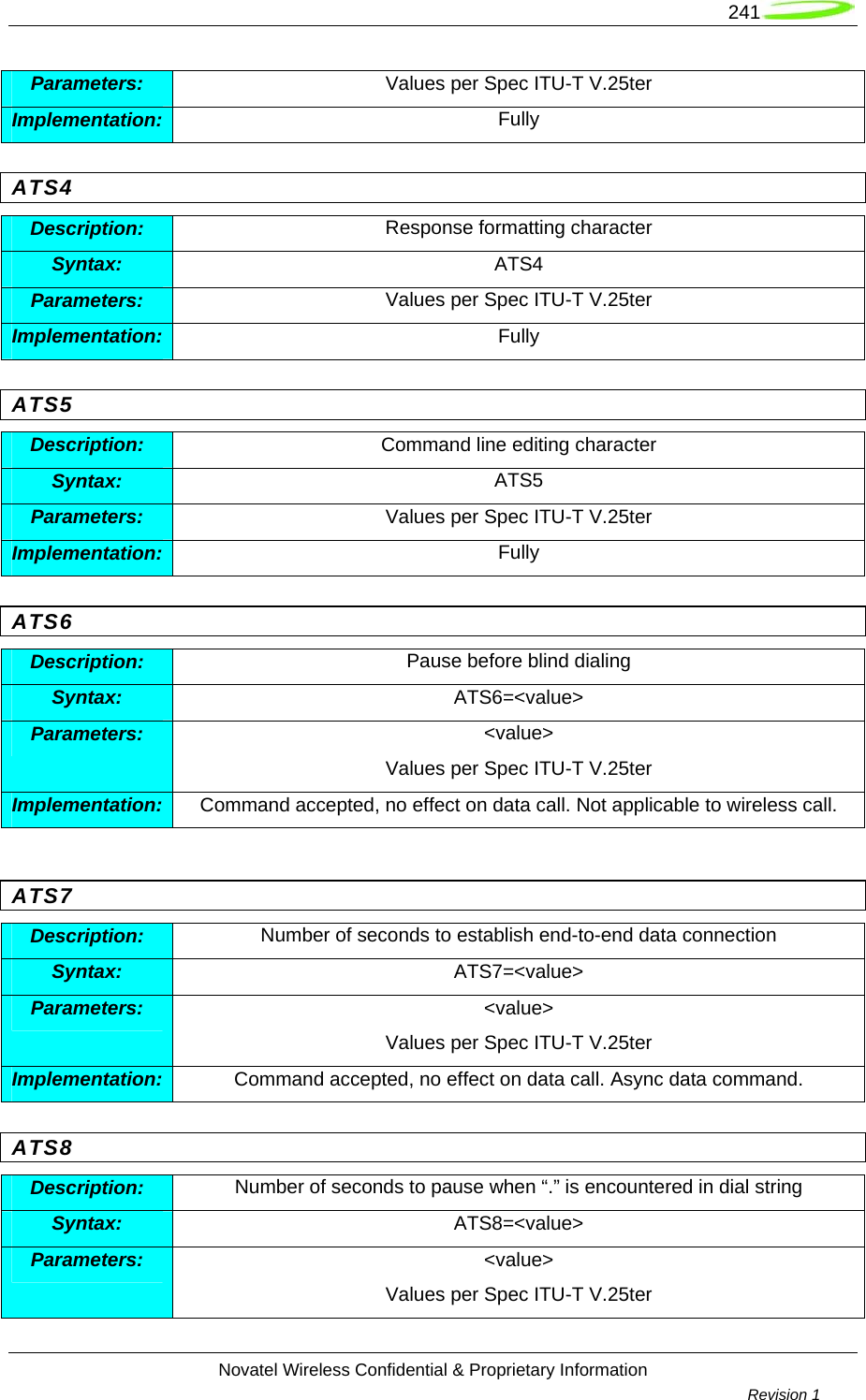
![242 Novatel Wireless Confidential & Proprietary Information Revision 1 Implementation: Command accepted, no effect on data call. Async data command. ATS10 Description: Number of tenths of a second from carrier loss to disconnect Syntax: ATS10=<value> Parameters: <value> Values per Spec ITU-T V.25ter Implementation: Command accepted, no effect on data call. Async data command. ATT Description: Select tone dialing Syntax: ATT Parameters: Implementation: Command accepted, performs normal dial. Tone dialing not relevant to ETSI data services. ‘T’ not sent in data string. ATX Description: Result code selection and call progress monitoring control Syntax: ATX[<value>] Parameters: <value> Values per Spec ITU-T V.25ter Implementation: Command accepted, no action taken AT&F Description: Set to Factory defined configuration (effect is implementation-dependent) Syntax: AT&F<value> Parameters: <value> Values per Spec ITU-T V.25ter Implementation: Fully. Same behaviour as ATZ except it changes baud rate to default value. AT+CBC Description: Report battery charge Syntax: AT+CBC Parameters:](https://usermanual.wiki/Novatel-Wireless/NRM-EU860D.Part-2/User-Guide-754579-Page-122.png)
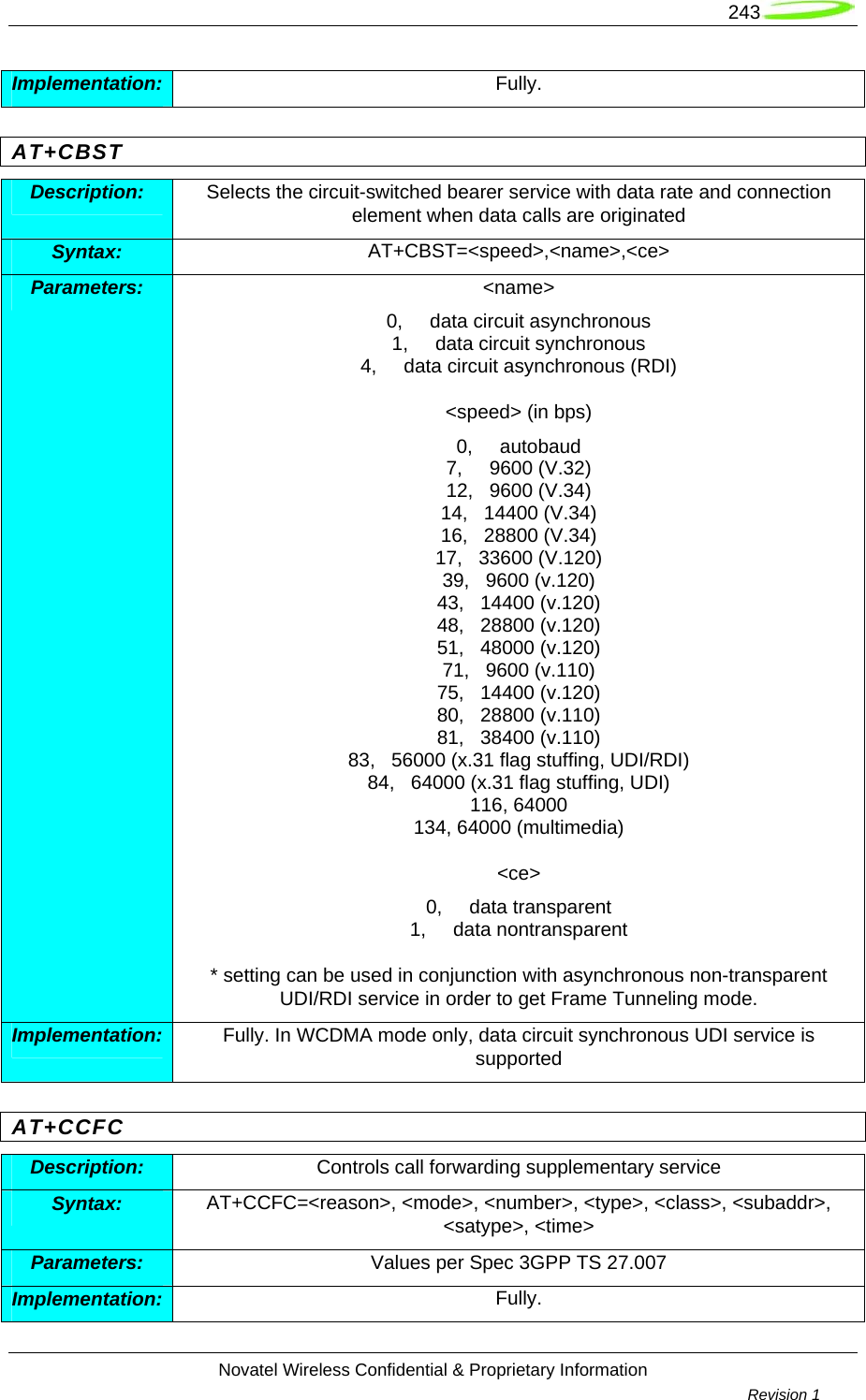
![244 Novatel Wireless Confidential & Proprietary Information Revision 1 AT+CCUG Description: Controls closed user group supplementary service Syntax: AT+CCUG=<n>, <index>, <info> Parameters: Values per Spec 3GPP TS 27.007 Implementation: Fully. AT+CCWA Description: Control of Call Waiting Supplementary Services Syntax: AT+CCWA=[<n>[,<mod>[,<class>]]] Parameters: Command input. Unsolicited result code <class>: only 1 or 2 reported. Unsolicited result code optional <alpha> and <CLI validity> not supported Values per Spec 3GPP TS 27.007 Implementation: Fully. AT+CFUN Description: Sets the level of functionality in the ME Syntax: AT+CFUN=[<fun>[,<rst>]] Parameters: <fun>: 0, 1 Values per Spec 3GPP TS 27.007 Implementation: Fully. AT+CGACT Description: Activate or deactivate the specified PDP context(s) Syntax: AT+CGACT Parameters: <cid>: 1 to 16 Values per Spec 3GPP TS 27.007 Implementation: Fully AT+CGATT Description: Attach or detach from the Packet Domain Service Syntax: AT+CGATT Parameters: Values per Spec 3GPP TS 27.007 Implementation: Fully](https://usermanual.wiki/Novatel-Wireless/NRM-EU860D.Part-2/User-Guide-754579-Page-124.png)
![245 Novatel Wireless Confidential & Proprietary Information Revision 1 AT+CGCLASS Description: Set the GPRS mobile class Syntax: AT+CGCLASS Parameters: Values per Spec 3GPP TS 27.007 Implementation: Command accepted, no actions taken AT+CGDCONT Description: Set PDP context parameter values for a PDP context identified by connection identifier Syntax: AT+CGTDCONT=<cid>,<PDP_Type>,<APN>,<PDP_addr>,<d_comp>, <h_comp> Parameters: <cid>: 1 to 16 <PDP_type>: IP, PDP-IP, PPP, PDP-PPP <d_comp>: 0, 1 <h_comp>: 0, 1 Values per Spec 3GPP TS 27.007 Implementation: Fully. AT+CGDSCO Description: Define Secondary PDP Context Syntax: AT+CGDSCO=[<cid>,<p_cid>[,<d_comp>[,<h_comp>]]] Parameters: <cid>: 1 to 16 <p_cid>: 1 to 16 <d_comp>: 0, 1 <h_comp>: 0, 1 Values per Spec 3GPP TS 27.007 Implementation: Fully. AT+CGEQMIN Description: Set the minimum acceptable UMTS QoS Profile against the negotiated profile in Activate PDP Context Request message Syntax: AT+CGEQMIN=<cid>, <Traffic_class>, <maximum_bitrate_UL>, <maximum_bitrate_DL>, <Guranteed_bitrate_UL>, <Guaranteed_bitrate_DL>, <Delivery_order>, <Maximum_SDU_size>, <SDU_error_ratio>, <Residual_bit_error_ratio>, <Delivery_of_erroneous_SDUs>, <Transfer_delay>, <Traffic_handling_priority>](https://usermanual.wiki/Novatel-Wireless/NRM-EU860D.Part-2/User-Guide-754579-Page-125.png)
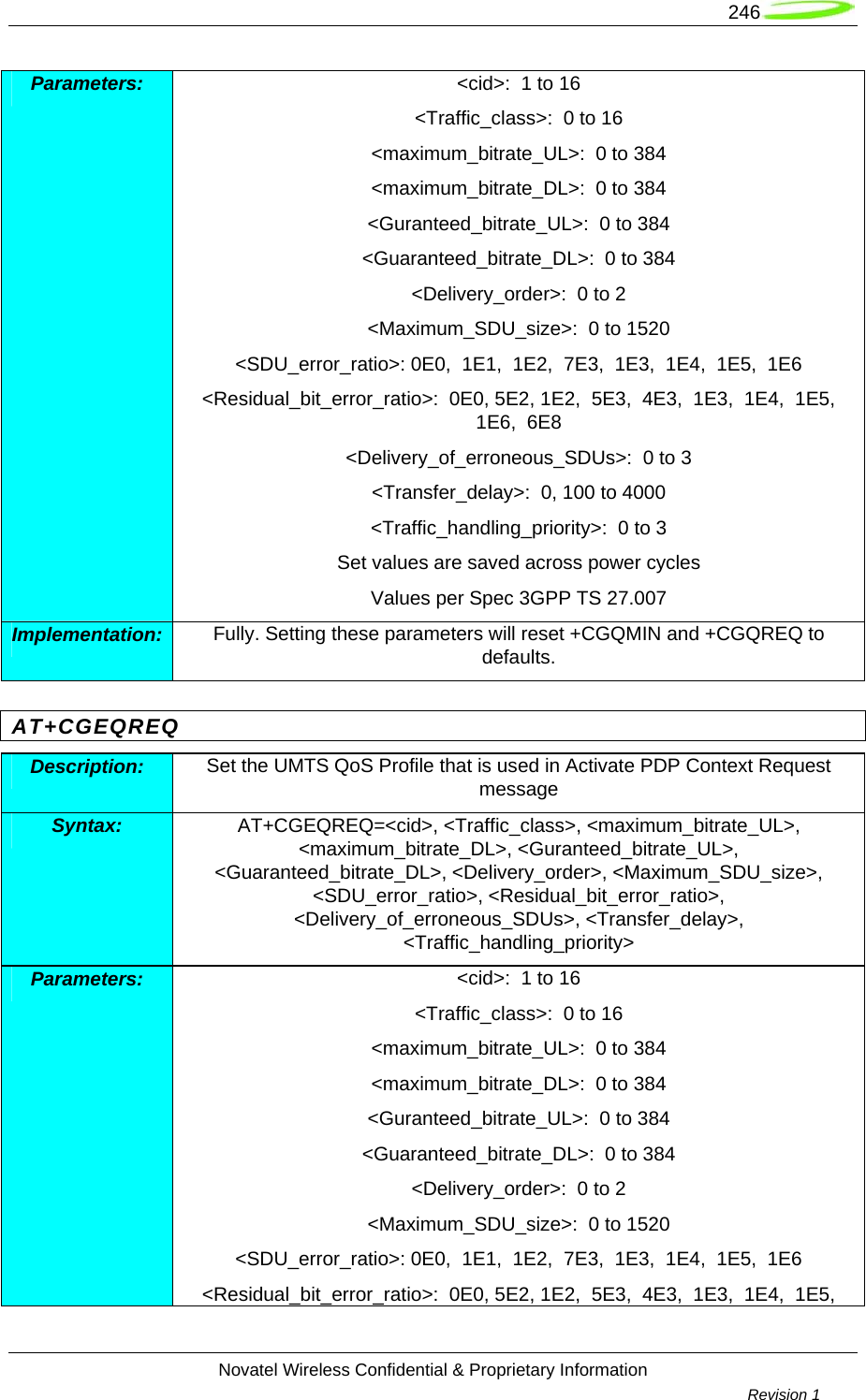
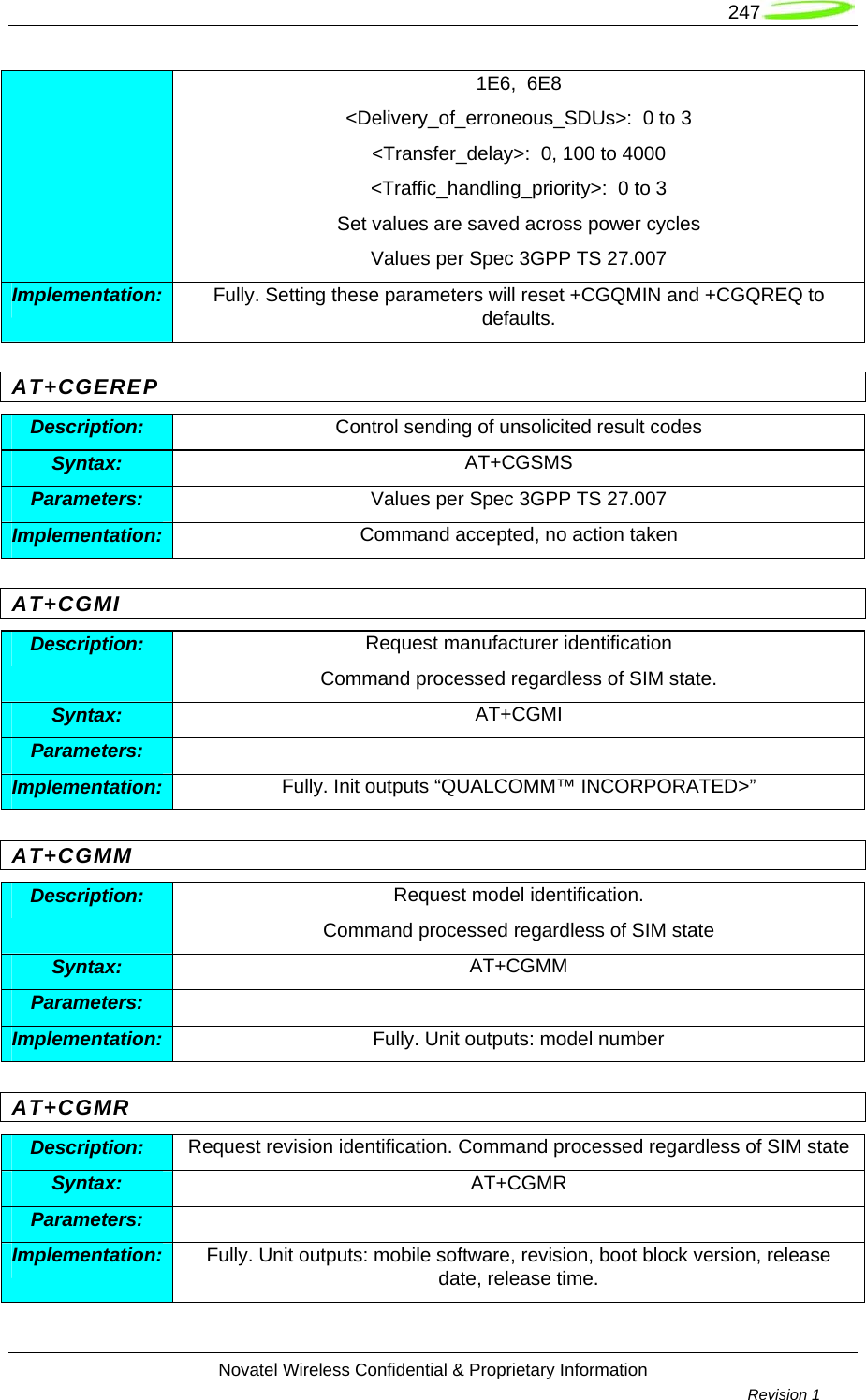
![248 Novatel Wireless Confidential & Proprietary Information Revision 1 AT+CGQMIN Description: Set minimum acceptable profile against the negotiated profile in Activate PDP Context Accept message Syntax: AT+CGQMIN=<cid>,<precedence>,<delay>,<reliability>,<peak>,<mean> Parameters: <cid>: 1 to 16 <precedence>: 1 to 3 <delay>: 1 to 4 <reliability>: 1 to 5 <peak>: 1 to 4 <mean>: 1 to 18, 31 Set values are saved across power cycles Values per Spec 3GPP TS 27.007 Implementation: Fully. Setting these parameters will reset +CGEQREQ and +CGEQMIN to defaults. AT+CGQREQ Description: Set the QoS Profile that is used in Activate PDP Context Request Message Syntax: AT+CGQREQ=<cid>,<precedence>,<delay>,<reliability>,<peak>,<mean> Parameters: <cid>: 1 to 16 <precedence>: 1 to 3 <delay>: 1 to 4 <reliability>: 1 to 5 <peak>: 1 to 4 <mean>: 1 to 18, 31 Set values are saved across power cycles Values per Spec 3GPP TS 27.007 Implementation: Fully. Setting these parameters will reset +CGEQREQ and +CGEQMIN to defaults. AT+CGREG Description: Presentation of unsolicited GPRS network registration status Syntax: AT+CGREG=[<n>] Parameters: <n>: 0, 1 <stat>: 0 to 5 Values per Spec 3GPP TS 27.007 Implementation: Fully.](https://usermanual.wiki/Novatel-Wireless/NRM-EU860D.Part-2/User-Guide-754579-Page-128.png)
![249 Novatel Wireless Confidential & Proprietary Information Revision 1 AT+CGSMS Description: Service Preference that will be used to send mobile-originated SMS messages. Syntax: AT+CGSMS Parameters: Parameter values supported: 2 – packet domain preferred 3 – circuit-switched preferred Implementation: Fully AT+CGSN Description: Request product serial number identification. Command processed regardless of SIM Syntax: AT+CGSN Parameters: Implementation: Fully. Unit outputs: IMEI AT+CGTFT Description: Traffic Flow Template Syntax: AT+CGTFT=[<cid>’[<packet filter identifier>,<evaluation precedence index> [,<source address and subnet mask> [,<protocol number(ipv4)/next header(ipv6)> [,<destination port range> [,<source port range> [,<ipsec security parameter index(spi)> [,<type of service(tos)(ipv4) and mask / traffic class(ipv6) and mask> [,<flow label(ipv6)>]]]]]]]]] Parameters: <cid>: 1 to 16 <packet filter identifier>: 1, 2 <evaluation precedence index>: 0 to 255 <source address and subnet mask>: “0.0.0.0.0.0.0.0” – “255.255.255.255.255.255.255.255” <protocol number(ipv4)/next header(ipv6)>: 0 to 255 <destination port range>: “0.0” – 65535.65535” <source port range>: “0.0” – 65535.65535” <ipsec security parameter index(spi)>: “0” – “FFFFFFFF” <type of service(tos)(ipv4) and mask / traffic class(ipv6) and mask>: “0.0” – “255.255” <flow label(ipv6)>: “0” – “FFFFF” Values per Spec 3GPP TS 27.007 Implementation: Fully.](https://usermanual.wiki/Novatel-Wireless/NRM-EU860D.Part-2/User-Guide-754579-Page-129.png)
![250 Novatel Wireless Confidential & Proprietary Information Revision 1 AT+CHLD Description: Call related supplementary services Syntax: AT+CHLD=[<n>] Parameters: <n>: (0, 1, 1x, 2, 2x, 3, 4) Implementation: Fully. AT+CHSN Description: HSCSD nontransparent call configuration Syntax: AT+CHSN Parameters: <wAiur> (in bps) 0 – TA shall calculate a proper value from currently selected network user rate (,speed> subparameter from +CBST command) 2 – 14400 4 – 28800 7 -- 57600 <wRx> 0 – TA shall calculate a proper value from currently selected <wAiur> and <codings> <topRx> 0 – TA shall calculate a proper value from currently selected <wAiru> and <codings> <codings> 0 – all supported codings are accepted Implementation: Fully. AT+CHUP Description: Hang up voice call Syntax: AT+CHUP Parameters: Implementation: Fully. AT+CIMI Description: Request International Mobile Subscriber Identity Syntax: AT+CIMI Parameters: Implementation: Fully. Unit outputs International Mobile Subscriber Identity.](https://usermanual.wiki/Novatel-Wireless/NRM-EU860D.Part-2/User-Guide-754579-Page-130.png)
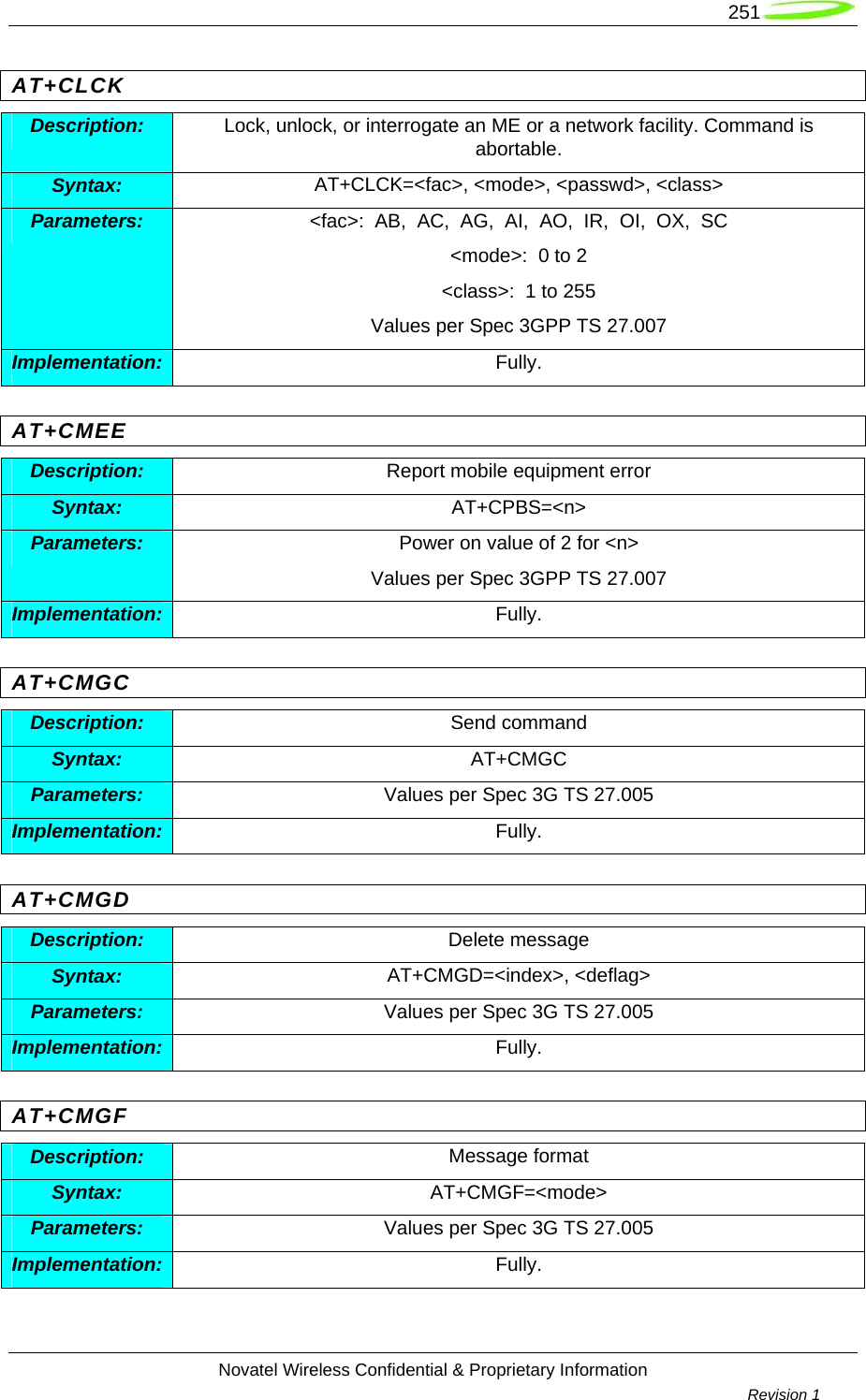
![252 Novatel Wireless Confidential & Proprietary Information Revision 1 AT+CMGL Description: List message Syntax: AT+CMGL=<stat> Parameters: Values per Spec 3G TS 27.005 Implementation: Fully. AT+CMGR Description: Read message Syntax: AT+CMGR=<index> Parameters: Values per Spec 3G TS 27.005 Implementation: Fully. AT+CMGS Description: Send message Syntax: AT+CMGS=<da>, <toda> Parameters: Values per Spec 3G TS 27.005 Implementation: Fully. AT+CMGW Description: Write message to memory Syntax: AT+CMGW=<oa/da>, <tooa/toda>, <stat> Parameters: Values per Spec 3G TS 27.005 Implementation: Fully. AT+CMMS Description: More Messages to Send Syntax: AT+CMMS=[<n>] Parameters: <n>: 0 -- disable 1 – enable until inter-message time expires 2 -- enable Implementation: Fully.](https://usermanual.wiki/Novatel-Wireless/NRM-EU860D.Part-2/User-Guide-754579-Page-132.png)
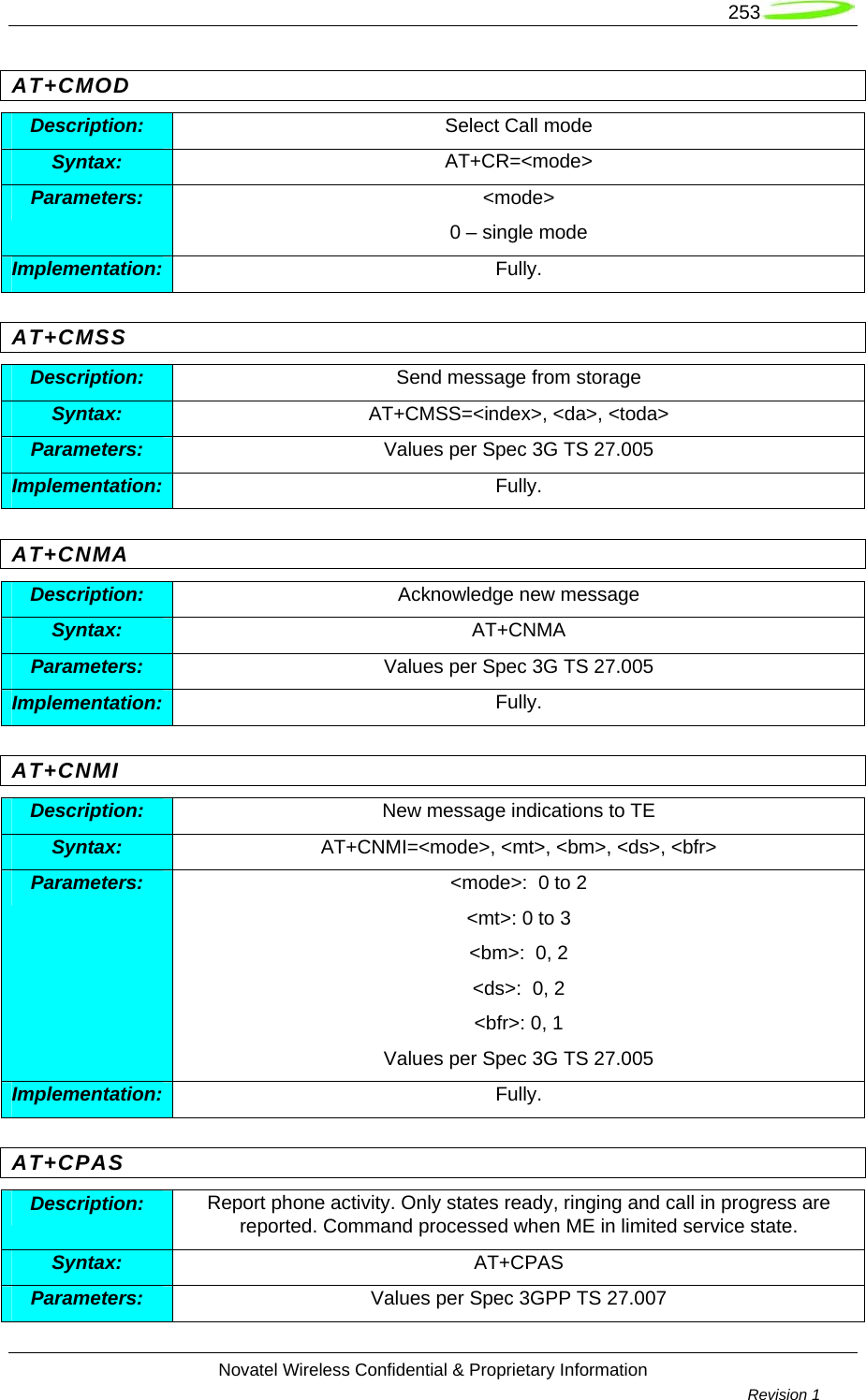
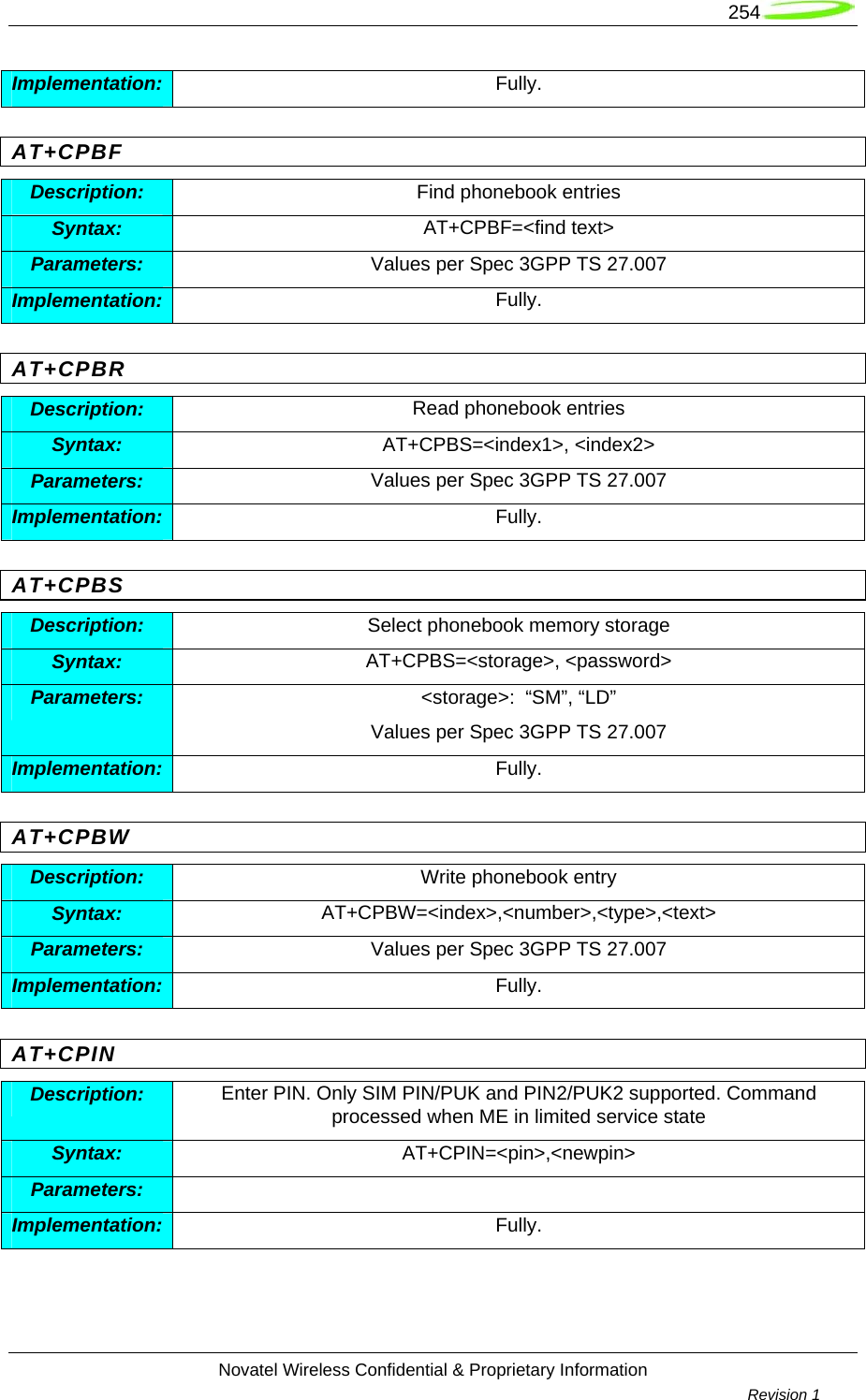
![255 Novatel Wireless Confidential & Proprietary Information Revision 1 AT+CPMS Description: Preferred message storage Syntax: AT+CPMS=<mem1>,<mem2>,<mem3> Parameters: <mem1>: SM, ME. MT, SR <mem2>: ME, MT, SM, SR <mem3>: ME, MT, SM, SR Values per Spec 3G TS 27.005 Implementation: Fully. AT+CPWD Description: Set new password for a facility lock function Syntax: AT+CPWD=<fac>, <oldpwd>, <newpwd> Parameters: <fac>: AB, AC, AG, AI, AO, IR, OI, OX, P2, SC Values per Spec 3GPP TS 27.007 Implementation: Fully. AT+CR Description: Service reporting control Syntax: AT+CR=<mode> Parameters: <mode> Values per Spec 3GPP TS 27.007 Implementation: Fully. AT+CRC Description: Cellular result codes Syntax: AT+CRC=<mode> Parameters: <mode> Values per Spec 3GPP TS 27.007 Implementation: Fully. AT+CREG Description: Presentation of unsolicitated network registration status Syntax: AT+CREG=[<n>] Parameters: <n>: 0, 1](https://usermanual.wiki/Novatel-Wireless/NRM-EU860D.Part-2/User-Guide-754579-Page-135.png)
![256 Novatel Wireless Confidential & Proprietary Information Revision 1 <stat>: 0 to 5 Values per Spec 3GPP TS 27.007 Implementation: Fully. AT+CRLP Description: Alters the RLP parameters used when nontransparent circuit-switched data calls are originated. Syntax: AT+CRLP=<iws>,<mws>, <T1>, <N2> Parameters: <iws> 0 to 61 frames, for Version 0 and 1 0 to 488 frames, for Version 2 <mws> 0 to 61 frames, for Version 0 and 1 0 to 488 frames, for Version 2 <TI> 38 to 255x10ms, for Version 0 and 1 42 to 255x10ms, for Version 2 <N2> 1 to 255 retransmits Implementation: Fully. RLP versions 0, 1, and 2 are supported. GSM only. AT+CSCA Description: Service center address Syntax: AT+CSCA=<sca>, <tosca> Parameters: Values per Spec 3G TS 27.005 Implementation: Fully. AT+CSCB Description: Selects which types of CBM's are to be received by the ME Syntax: AT+CSCB=[<mode>[,<mds>[,<dcs>]]] Parameters: Implementation: Fully. AT+CSCS Description: Select TE character set](https://usermanual.wiki/Novatel-Wireless/NRM-EU860D.Part-2/User-Guide-754579-Page-136.png)
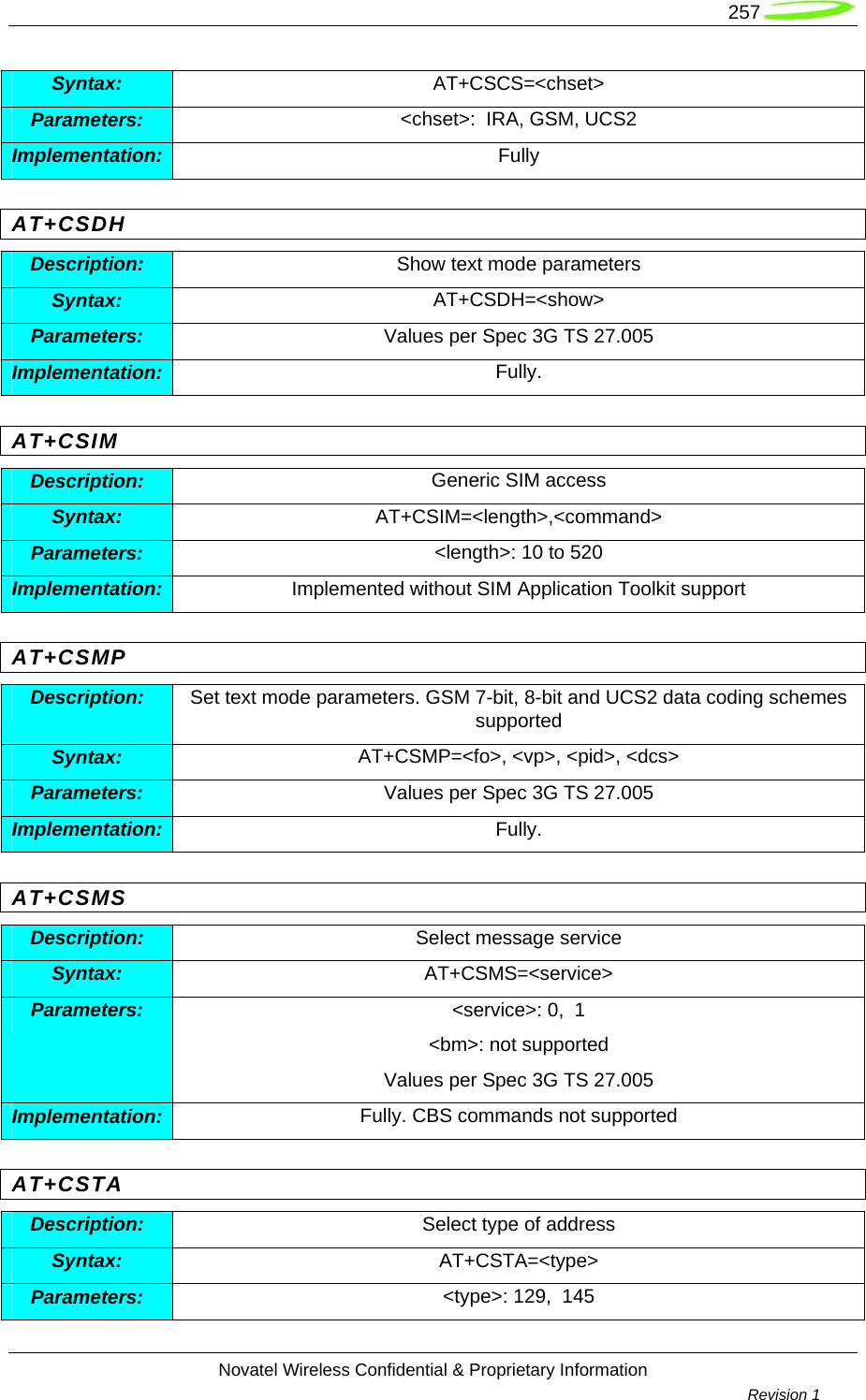
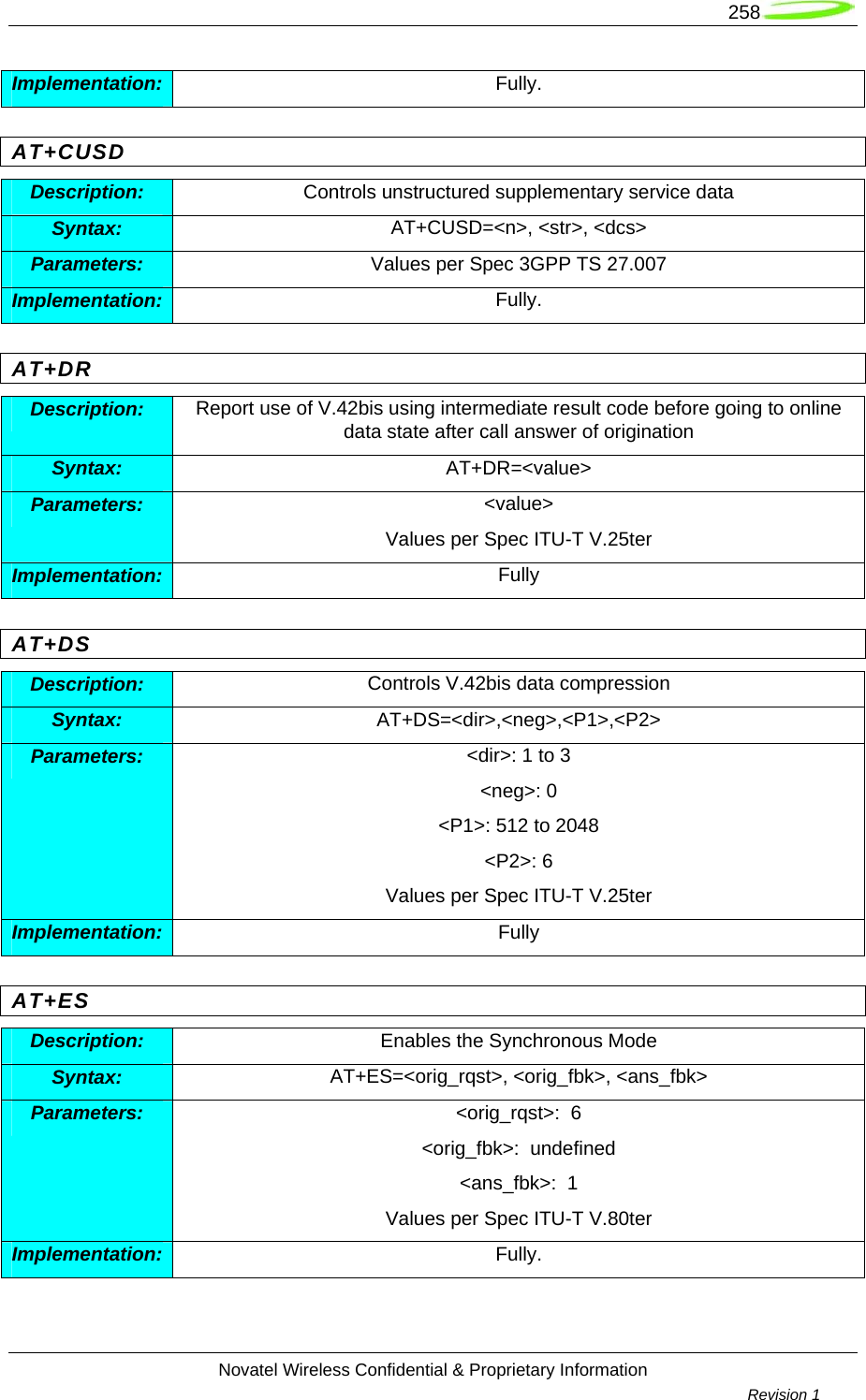
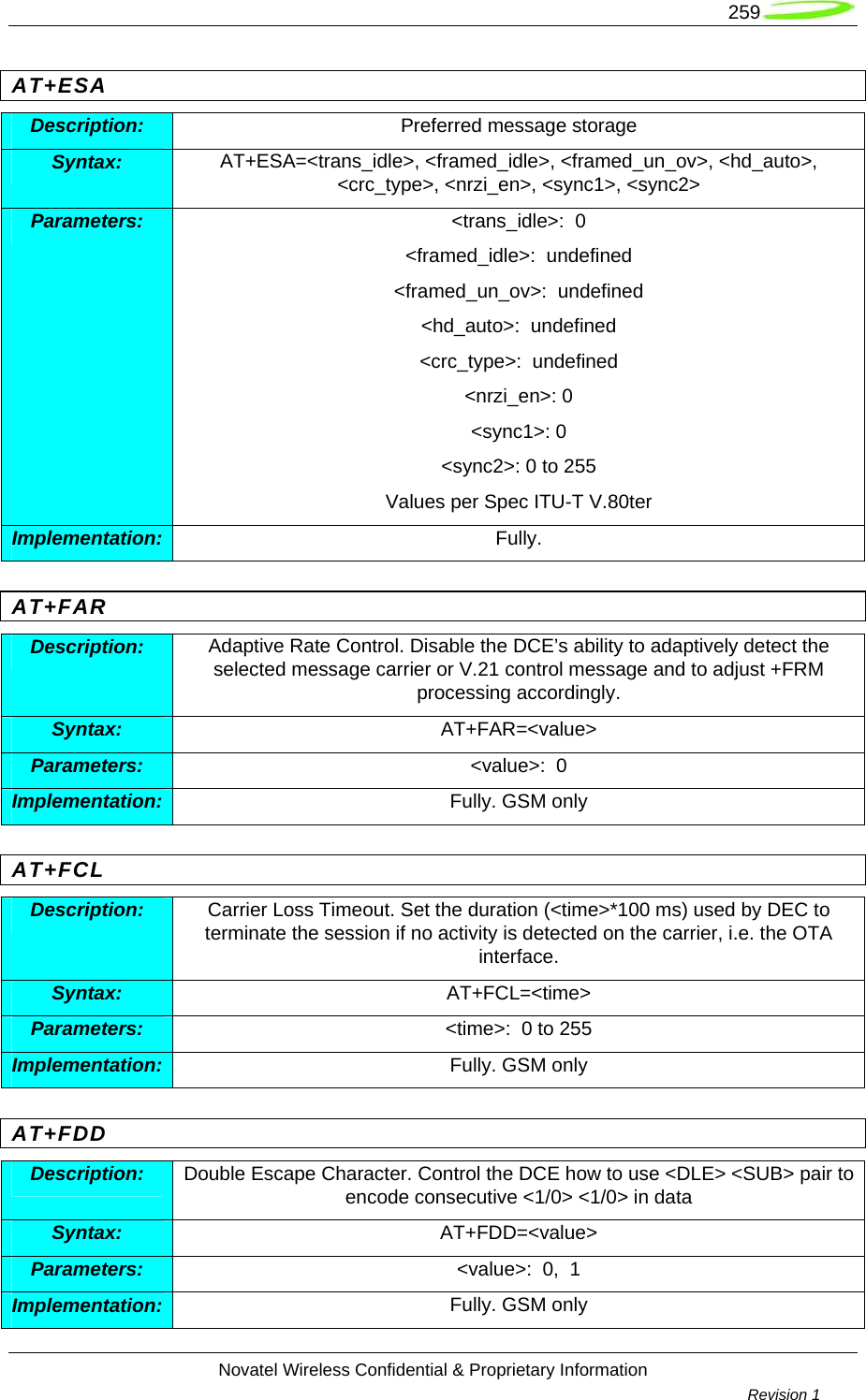
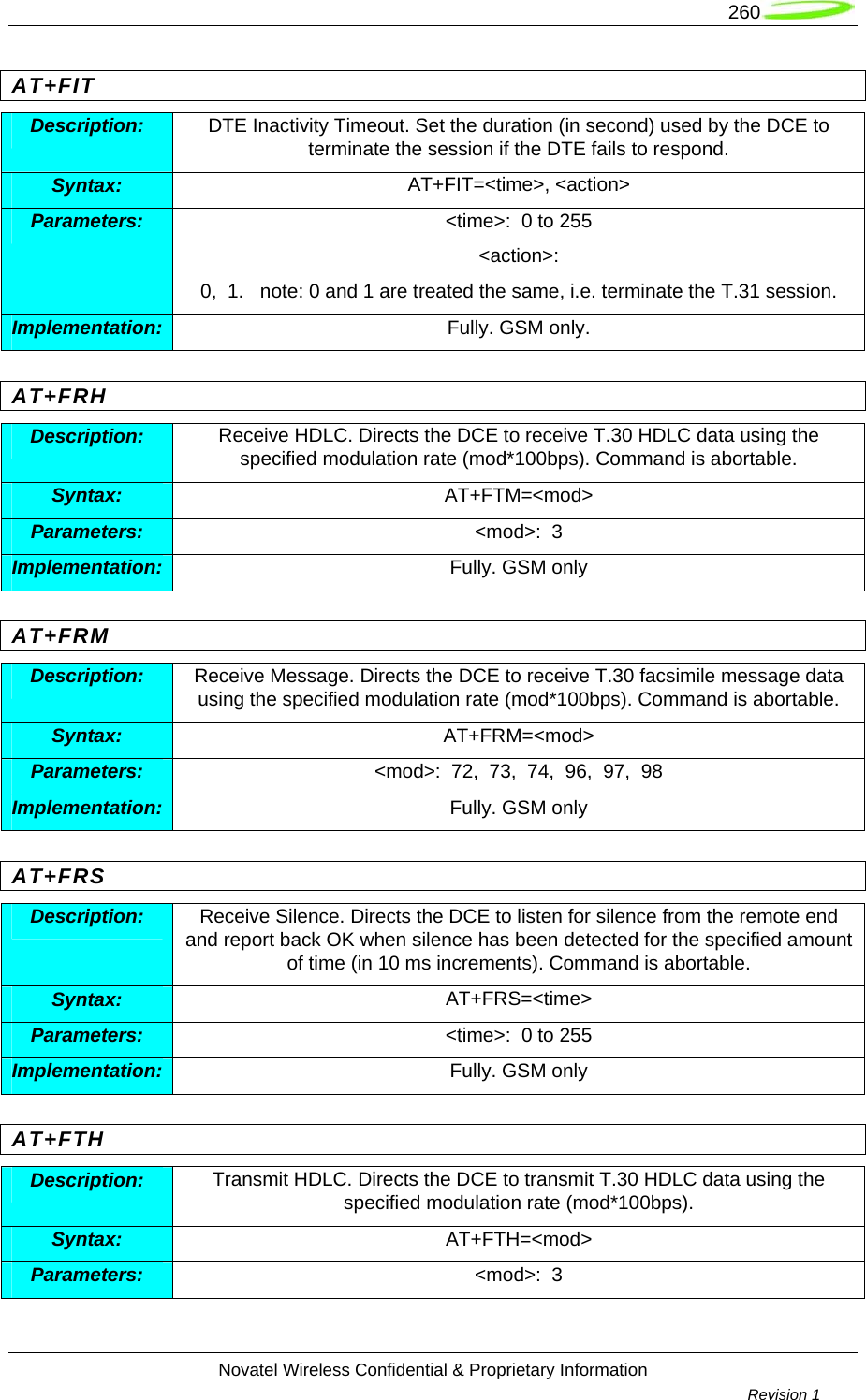
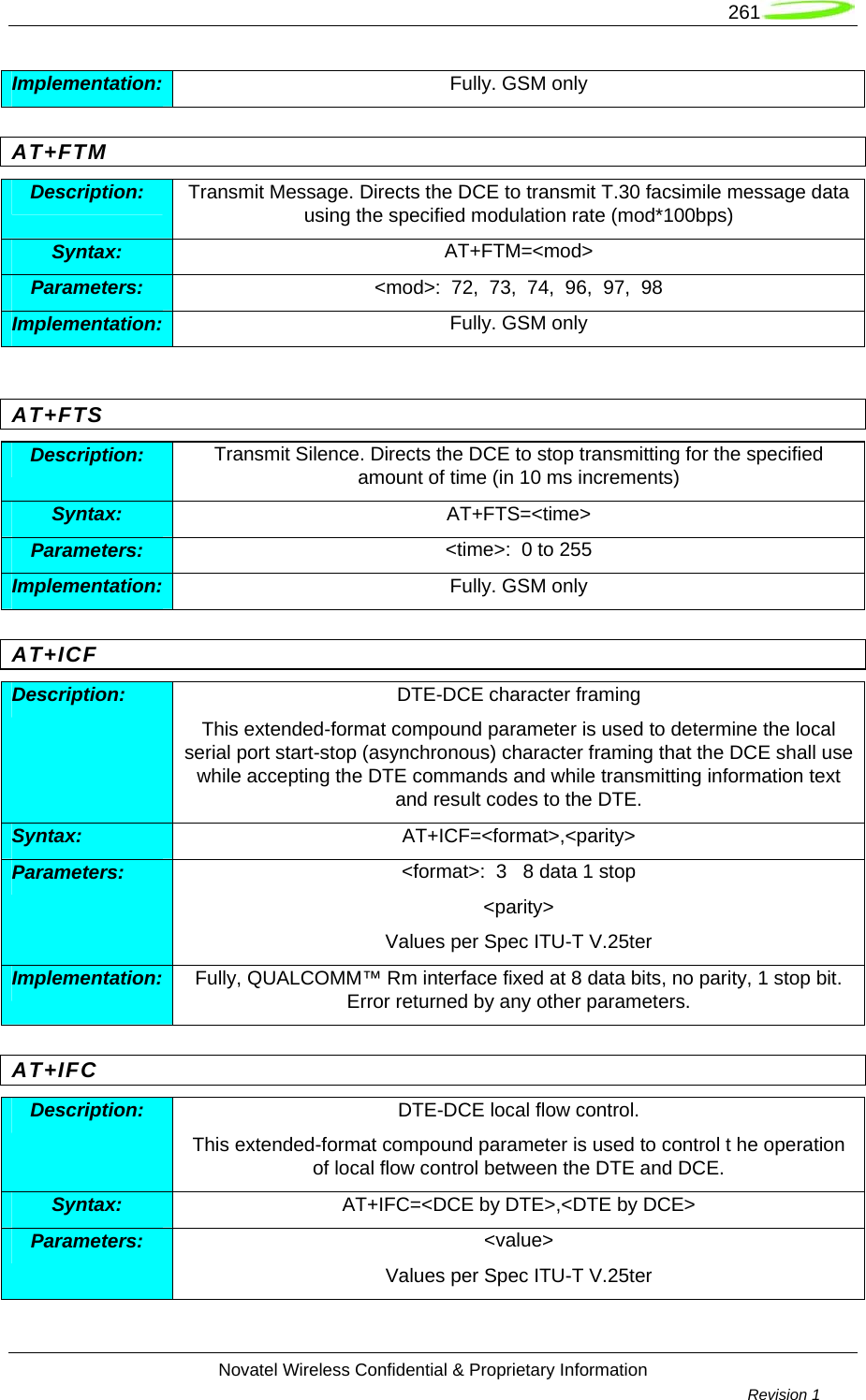
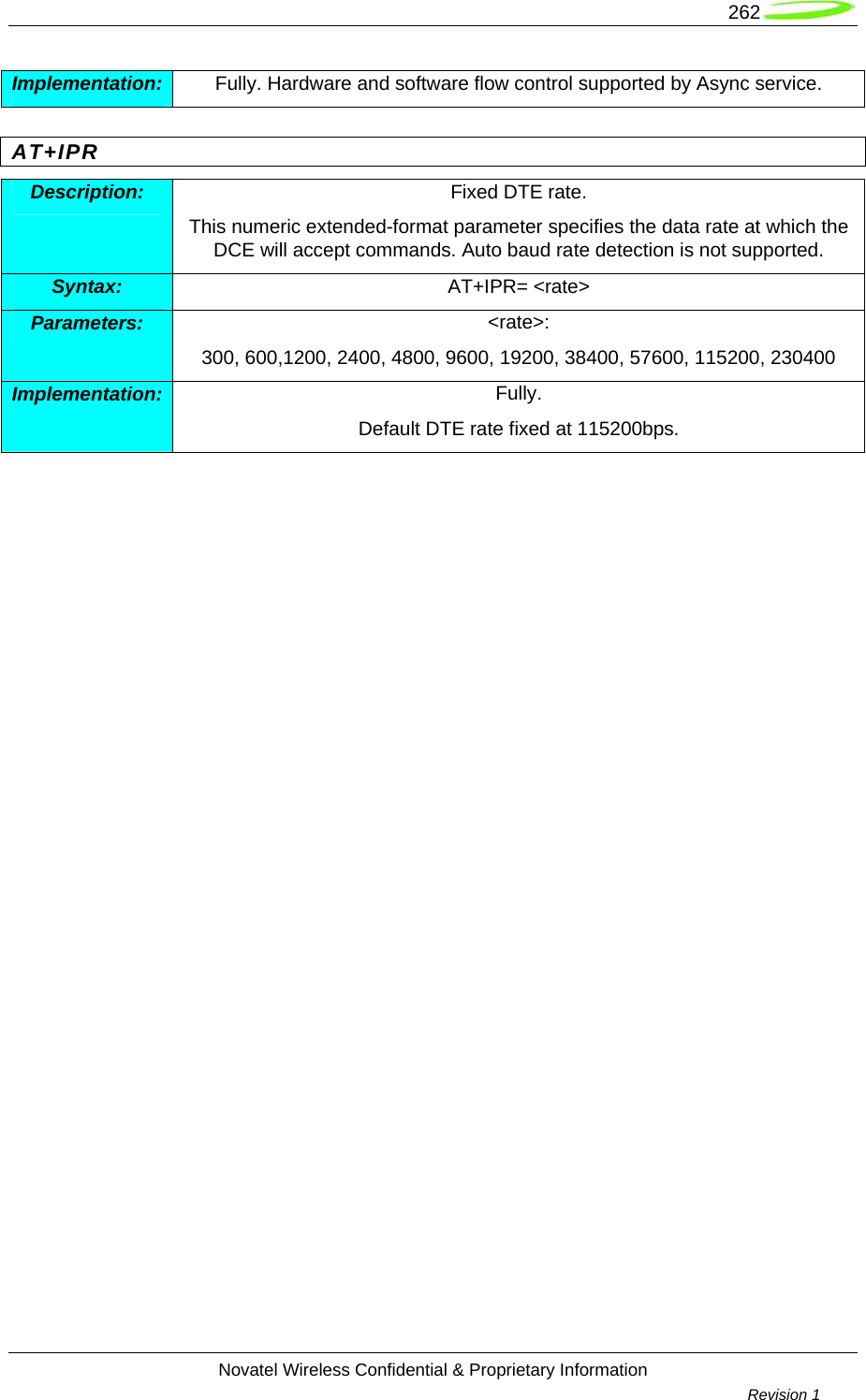
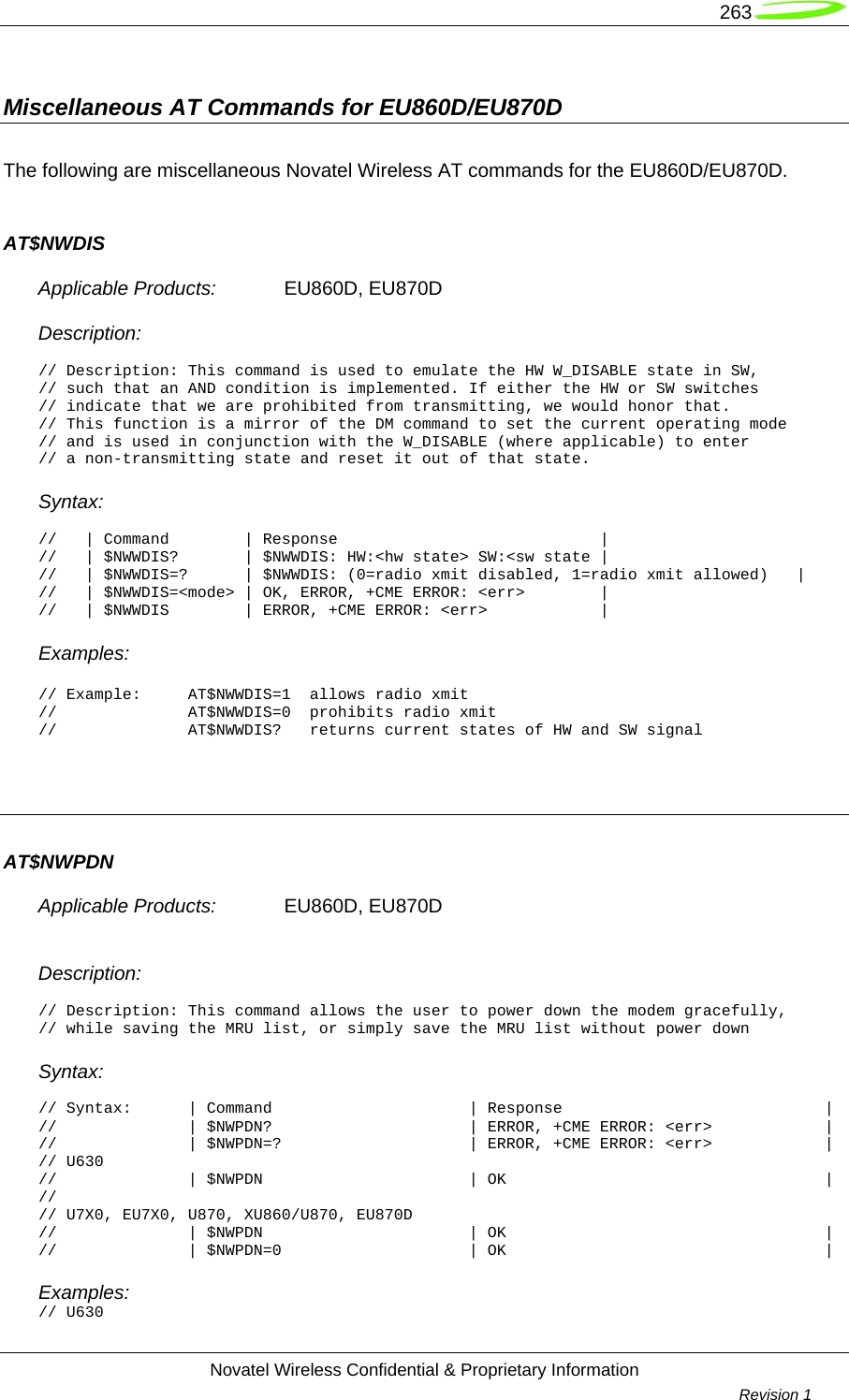
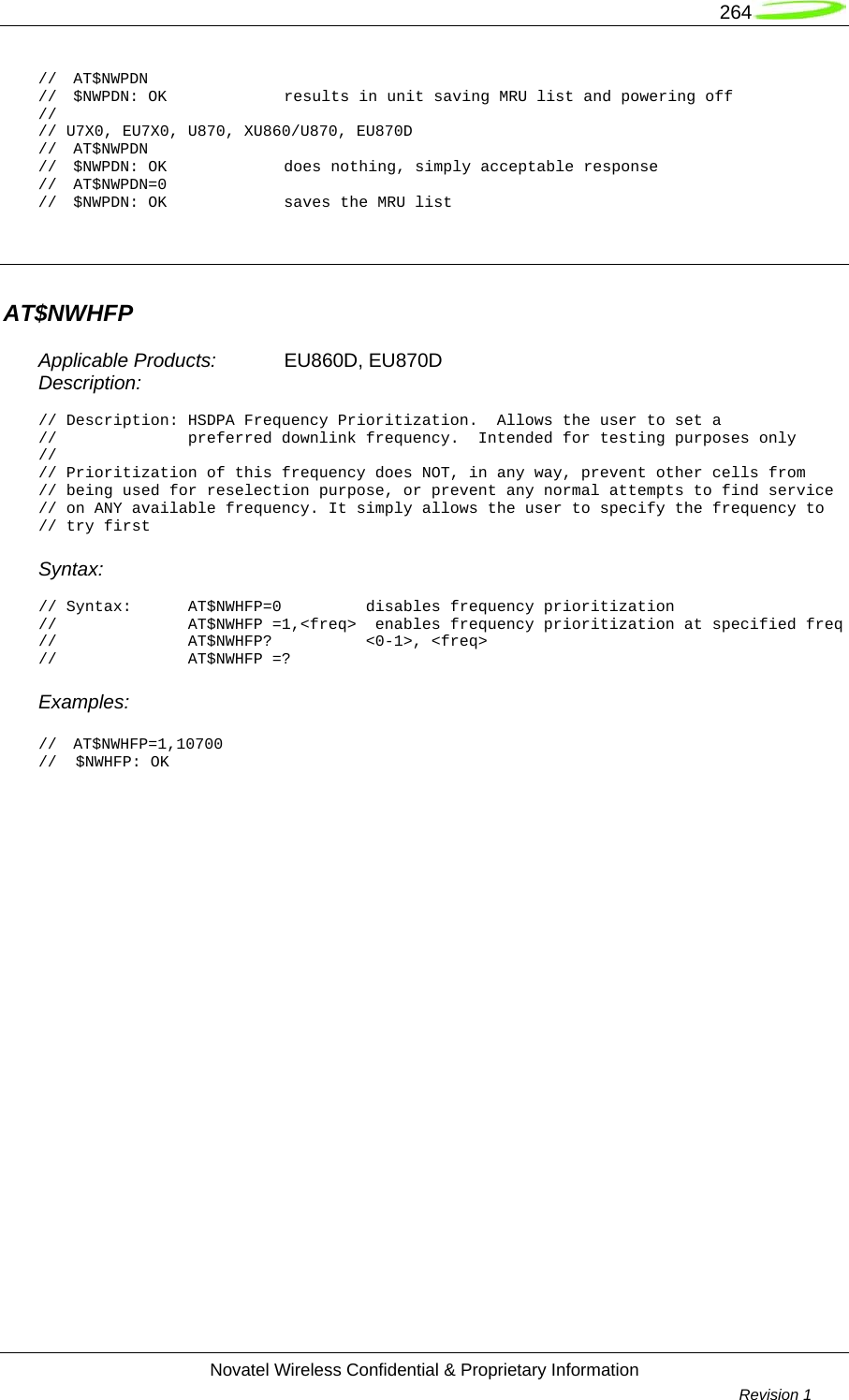
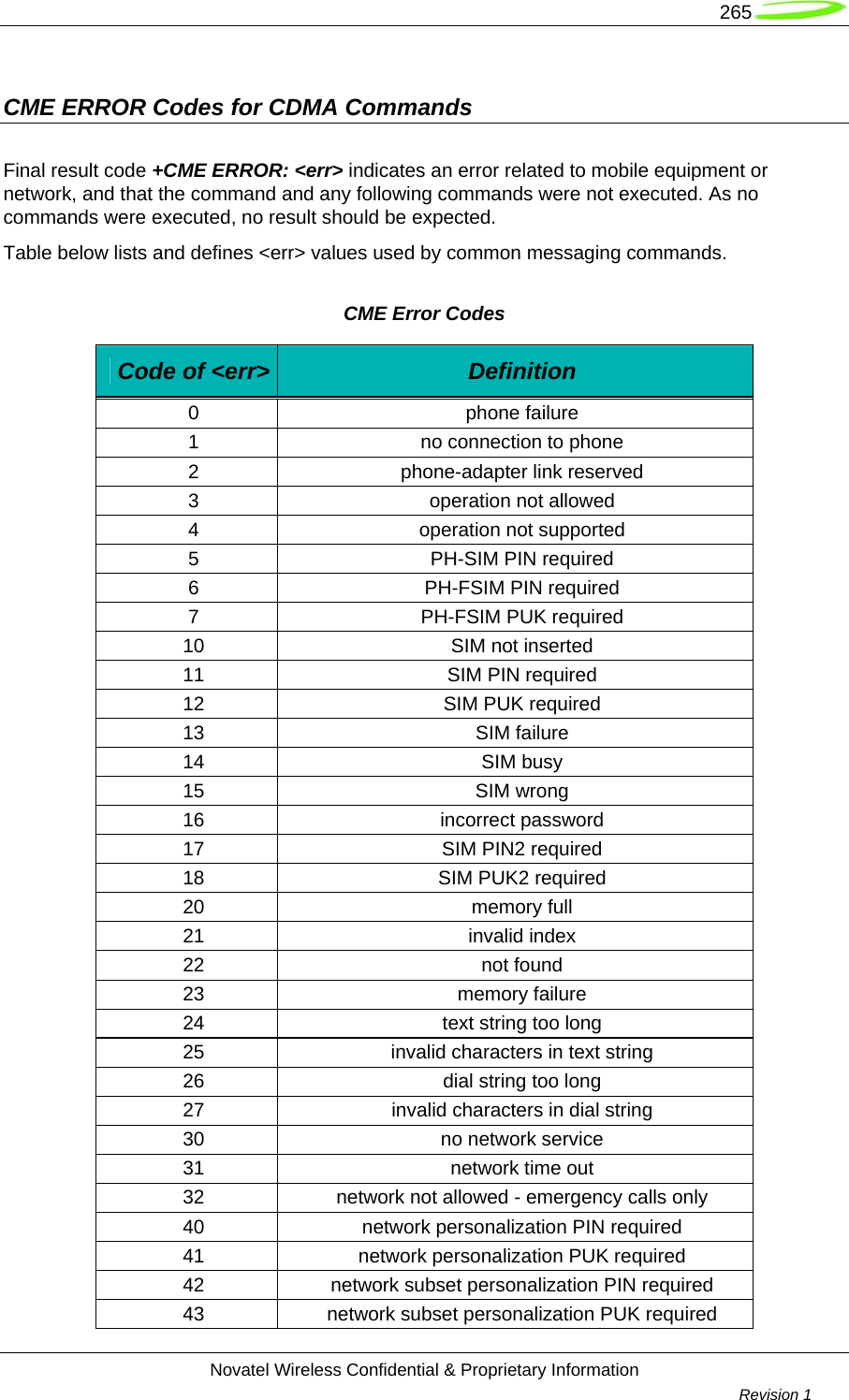
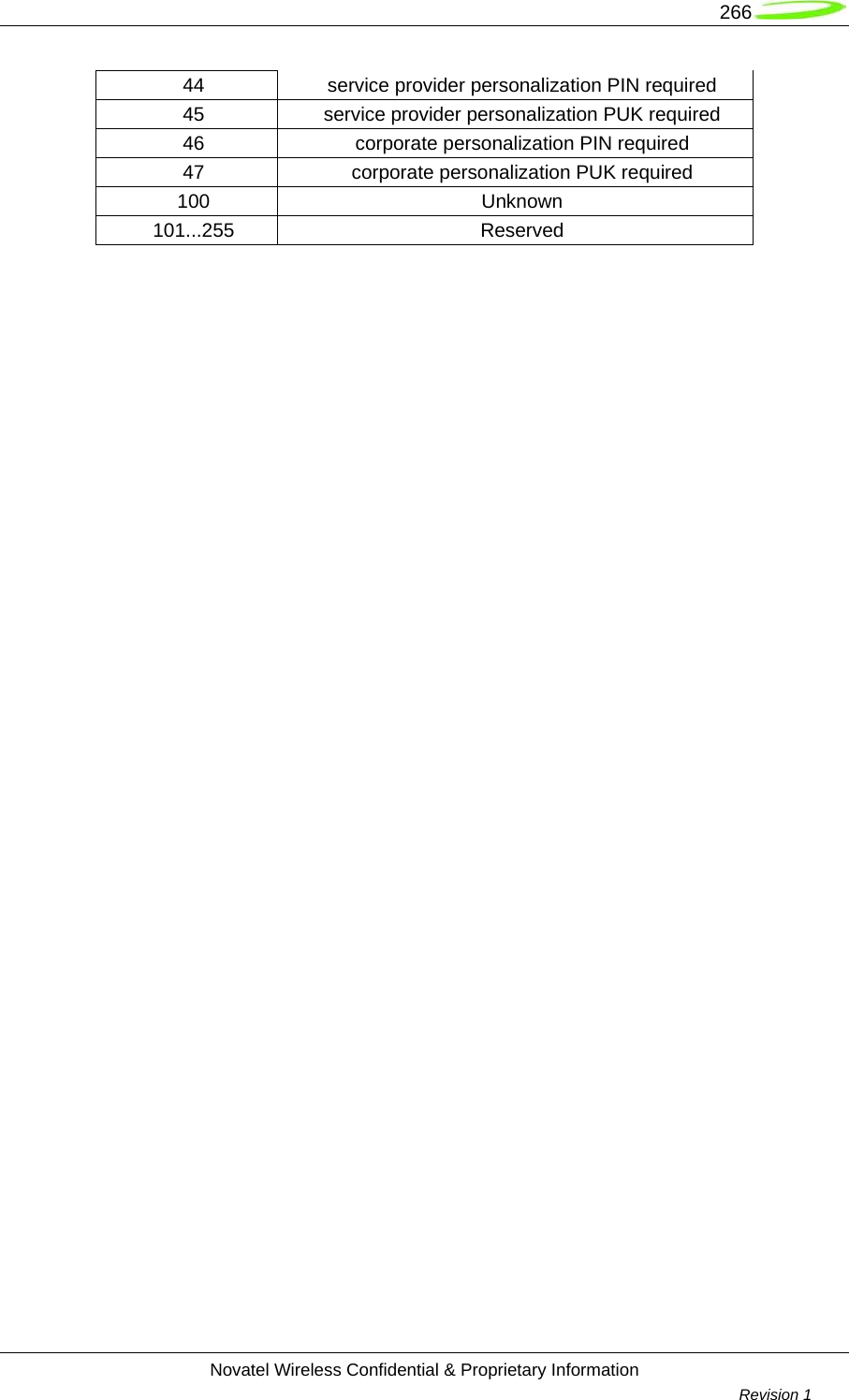
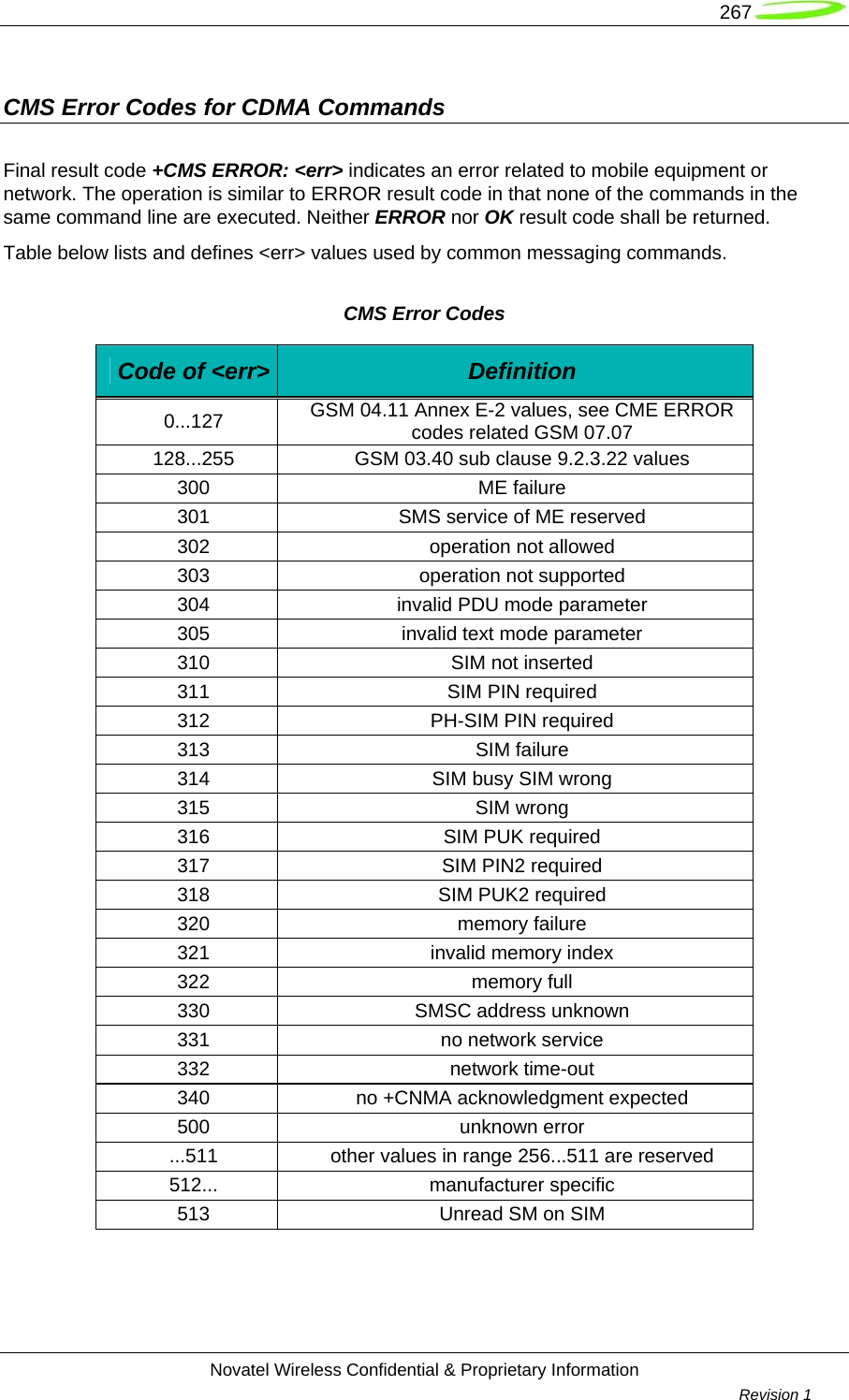
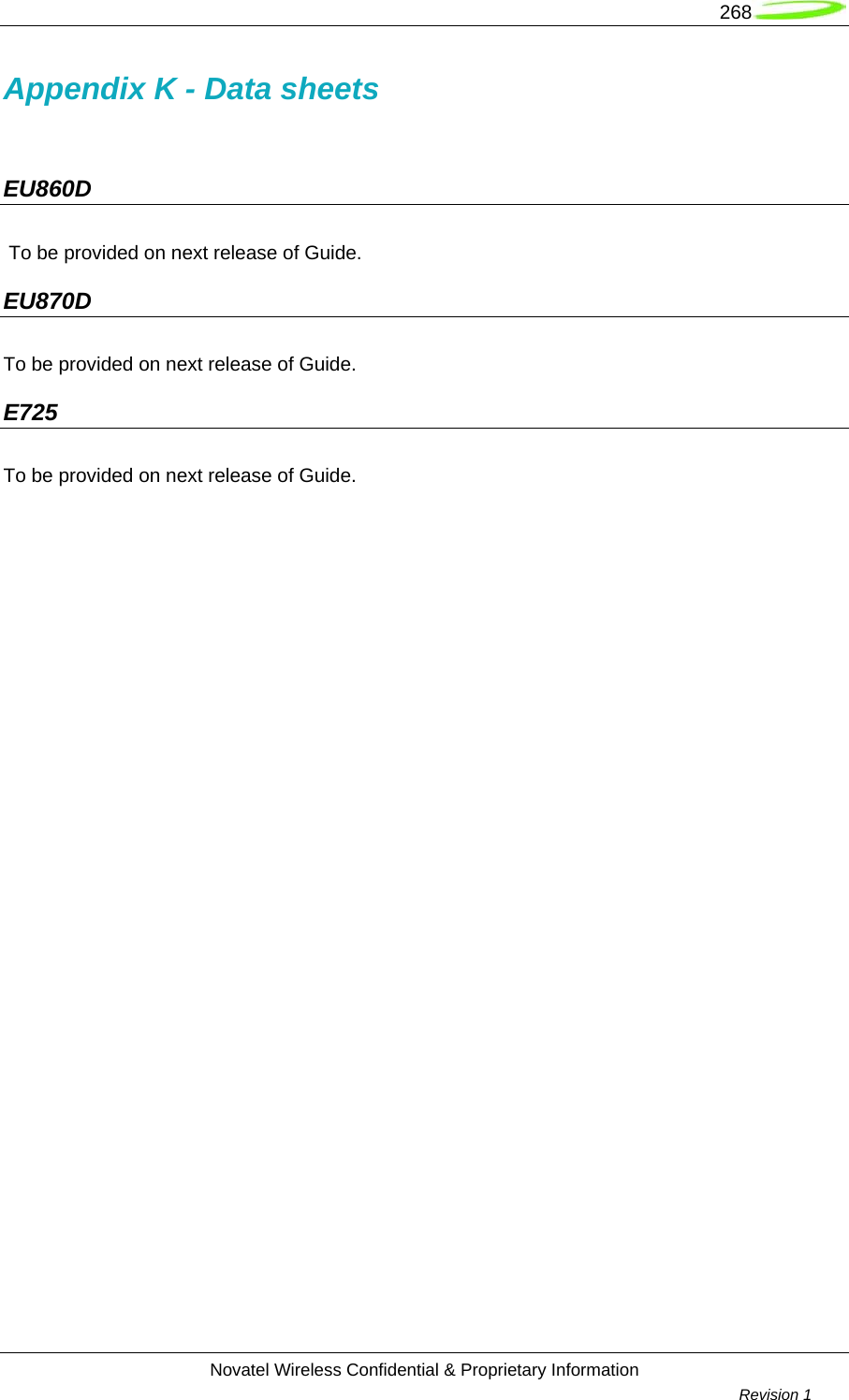
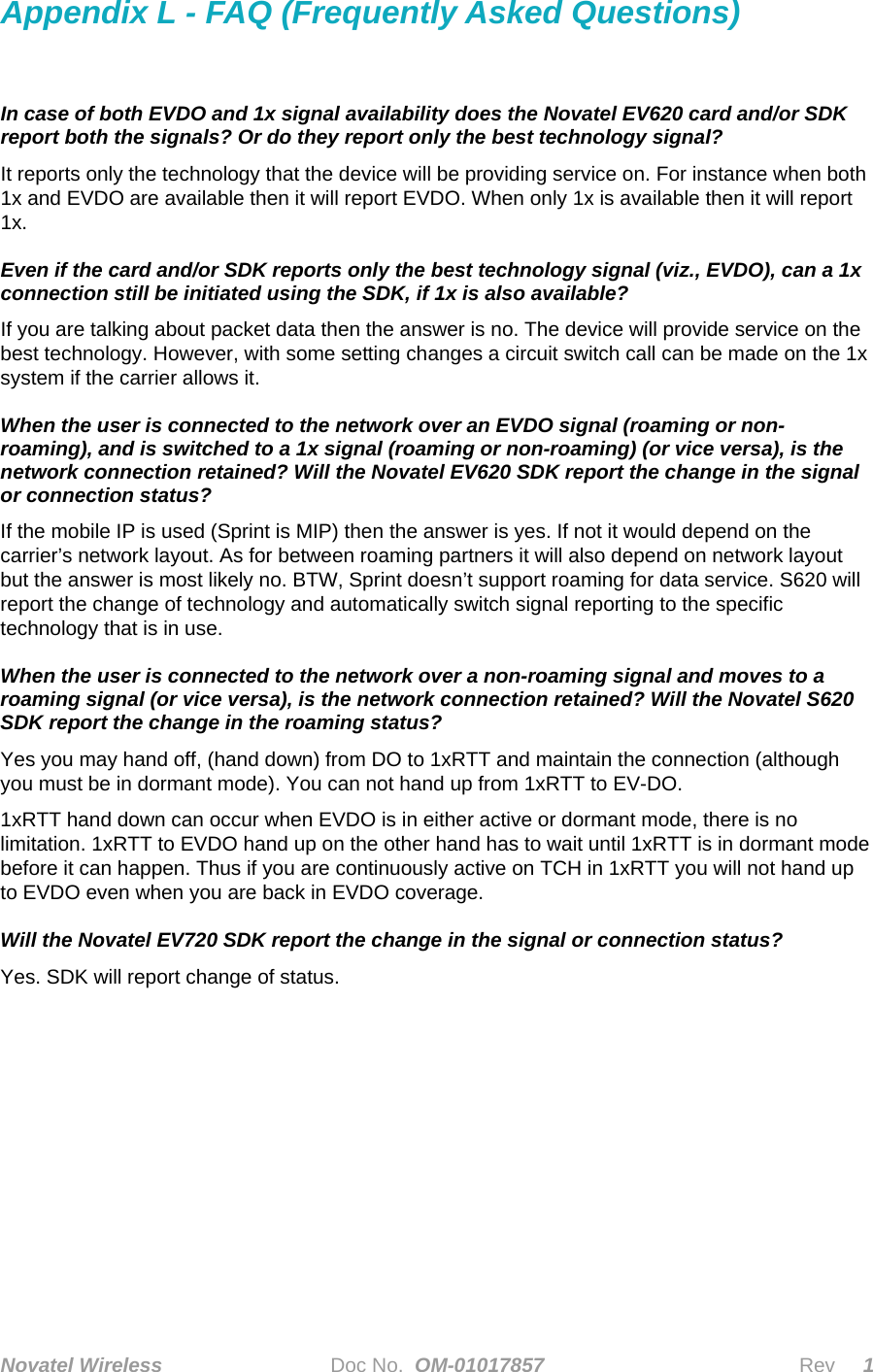
![270 Novatel Wireless Confidential & Proprietary Information Revision 1 Appendix M - Glossary Abbreviations given in 3GPP TR 21.905 [15] and the following] apply. Access Point Name (APN) The IP domain name (i.e. Novatel Wireless.com) of the network device that acts as a gateway by connecting a CDMA wireless radio network to a wired local or wide area network. Active Network Session An active network session allows you to send and receive data across the Internet using point-to-point protocol through your network connection. Anonymous Access (AA) Network does not know the real identity of the mobile. Opposite to non-anonymous. AP Access Point An entry point to an external network. AT Commands AT commands are a language type that enables PC communications software to give the modem directions. The term AT comes from the command terminology which always begins with attention, or AT. Authentication Authorization Accounting (AAA) Used as shared secret passwords during a Mobile IP registration. Baud Rate The actual bit rate, excluding compression and other TX enhancements, on a communication line. Border Gateway (BG) Logical box that connects two (or more) operators together via an Inter-PLMN backbone. BG protects operator’s intra-PLMN network against intruders. Carrier See Service Provider Circuit Switched Data A wireless network connection established, using a single circuit that extends from you, directly through the network to your call’s destination. Opposite to packet switched. CLI Command Line Interface. CLIR Call Line Identification Restriction. Code Division Multiple Access (CDMA) Code Division Multiple Access is a spread spectrum wireless access technology that allows multiple users to share the same physical RF channel (1.25MHz for single carrier direct spread 1X) by use of orthogonal code spreading. Connection Oriented Network Service (CONS) Same as X.25 protocol for packet network transmission and switching.](https://usermanual.wiki/Novatel-Wireless/NRM-EU860D.Part-2/User-Guide-754579-Page-150.png)
